Early Los Angeles City Views (1800s)
Historical Photos of Early Los Angeles |
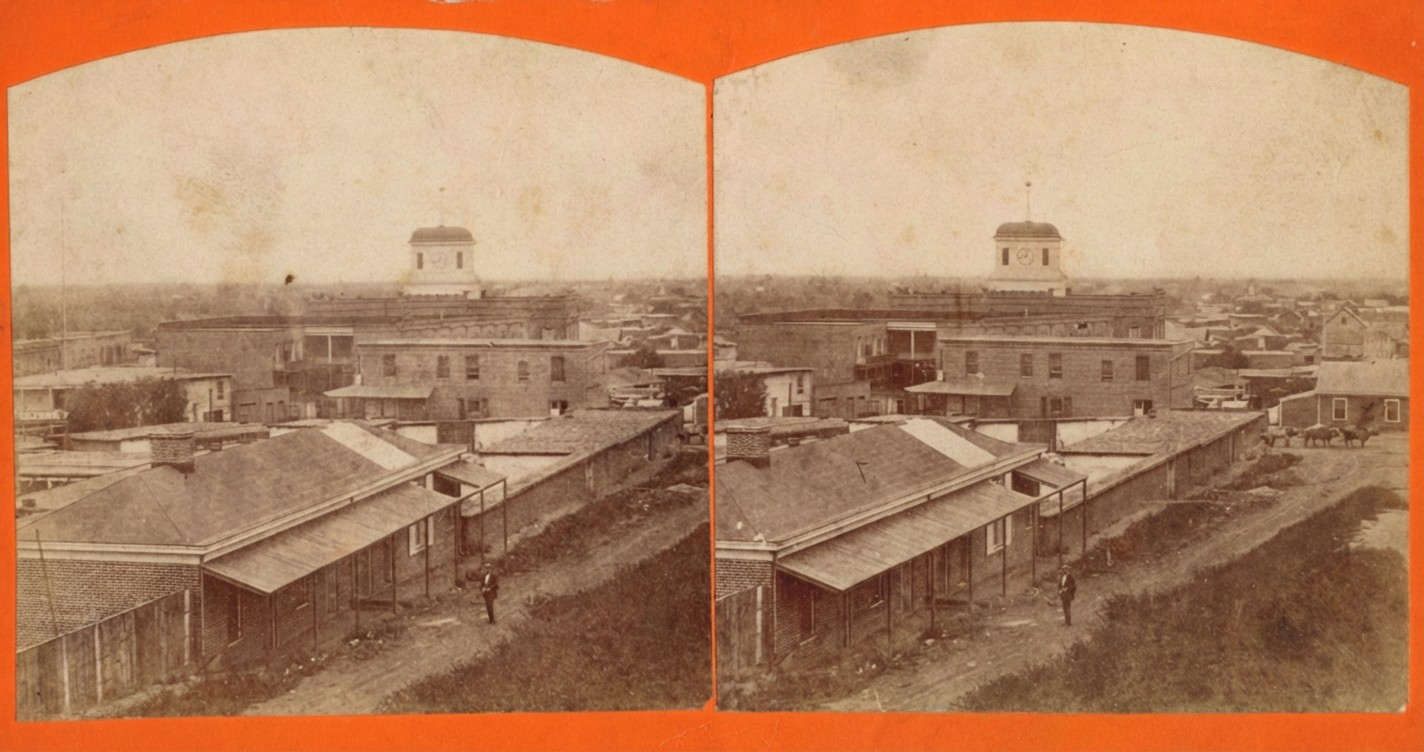 |
|
| (ca. 1869)* - Stereoscopic view looking southeast from the slope of Poundcake Hill showing adobe buildings along New High Street with a rifleman standing in the roadway. An ox team is seen heading west on Temple Street. Temple Block, with its prominent clock tower, is visible in the background. |
Historical Notes In the late 1860s Los Angeles was still a small frontier town with a reputation for disorder and violence. The population was only a few thousand people and the city often made national headlines for its high murder rate. Many residents carried rifles or pistols for personal safety, which is why armed men can sometimes be seen in early street scenes. The unpaved roads, the scattered adobe buildings, and the general openness of the area in the photograph reflect the simple and rugged character of the town. From the slope of Poundcake Hill, the view looks toward New High Street and Temple Street, where both homes and small businesses stood side by side. Ox teams were a common sight on Temple Street, which served as an important east west route for hauling goods and supplies. Life here moved slowly, and most of the activity centered on a few key streets that connected civic, commercial, and residential areas. |
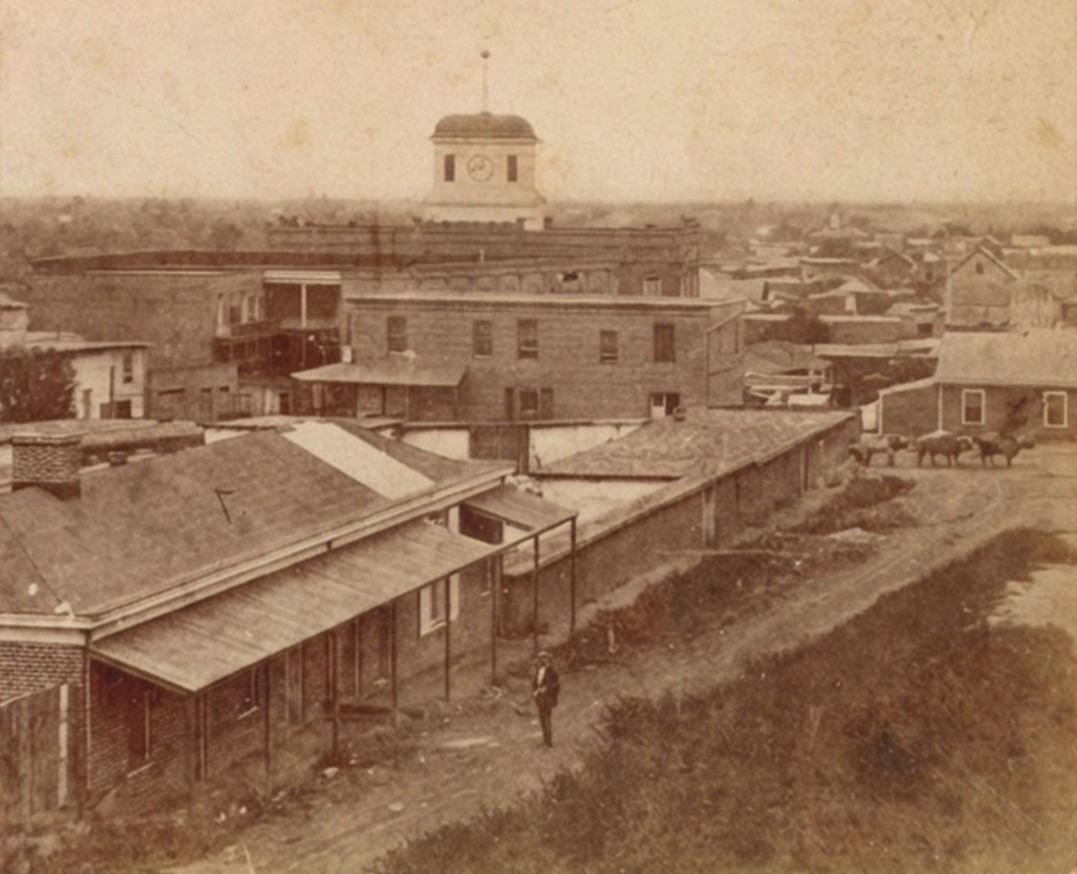 |
|
| (ca. 1869)* – View of New High Street (later incorporated into Spring Street) showing a rifleman in the roadway near the corner of New High and Temple Streets, with the Allen Block in the foreground and the Clocktower Market and Courthouse rising behind it. |
Historical Notes This corner of New High and Temple Streets was one of the earliest centers of public life in Los Angeles. It stood only a short walk from the first city hall and jail, which were simple adobe structures used by city leaders, law officers, and guards. Crime was a frequent challenge for the city, and law enforcement was stretched thin. It was not unusual to see armed men in the streets, especially near government buildings, which were gathering points for court cases and disputes. The Allen Block, visible in the foreground, was one of the first brick commercial buildings in the area. Its construction marked the city’s gradual shift from adobe buildings to more substantial architecture. Behind it stands the Temple Block and its well known clock tower. This cluster of buildings housed lawyers, shopkeepers, and the early county courthouse, making this intersection one of the busiest and most important places in the city. |
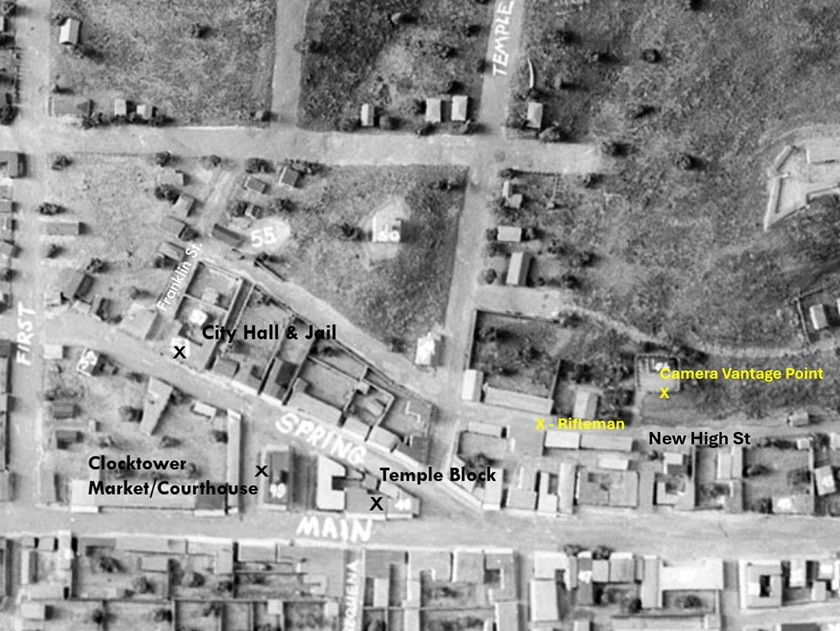 |
|
| (1850s)*- Annotated image of a model of early Los Angeles showing the location of the rifleman on New High Street seen in the earlier photograph, along with the Temple Block, the Clocktower, and the approximate camera vantage point. Photo annotation by Jack Feldman. |
Historical Notes This model helps show how small Los Angeles was in the 1850s and how concentrated public activity was around the Temple Block area. The rifleman seen in the earlier photograph stood near the heart of the young civic center, surrounded by adobe homes, simple stores, and dirt streets. The early courthouse and government offices in the Temple Block handled everything from land disputes to conflicts between ranchers, merchants, and new arrivals seeking opportunity in Southern California. The model also gives a clear sense of how the camera views were positioned. Early photographers often set up their equipment on hillsides, rooftops, or open lots because the town was still lightly developed. These elevated angles allowed them to document the growing city and the everyday life of its residents. |
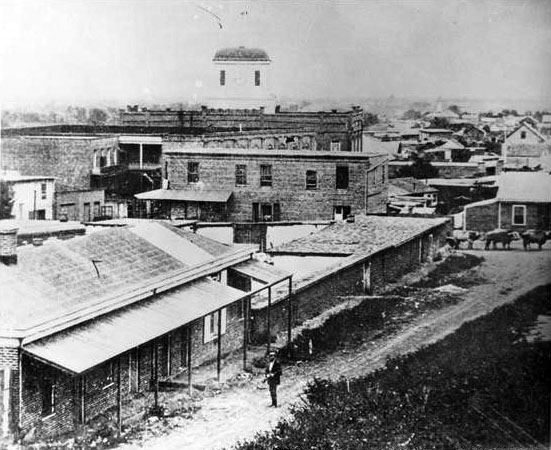 |
|
| (ca. 1869)* – Black-and-white version of the view showing a rifleman standing in the roadway near the corner of New High and Temple Streets, with the Allen Block in the foreground and the Clocktower Market and Courthouse rising behind it. |
Historical Notes This image again shows the daily activity at New High and Temple Streets during a time when Los Angeles was transitioning from a frontier settlement to an organized American city. The presence of a man holding a rifle reflects both the unpredictable nature of the town and the fact that many people felt the need to protect themselves. Law officers worked from nearby offices and the jail, but they often lacked the staff and resources to control every disturbance. The Allen Block and the Clocktower Market and Courthouse continued to anchor this busy intersection. Lawyers, clerks, merchants, and local residents all passed through this area, making it a crossroads where public business and private errands came together. Over time this corner became the foundation of the city’s future civic center, even as the surrounding streets remained rough and undeveloped. |
* * * * * |
Temple Block and the Clocktower Courthouse (1869–1876)
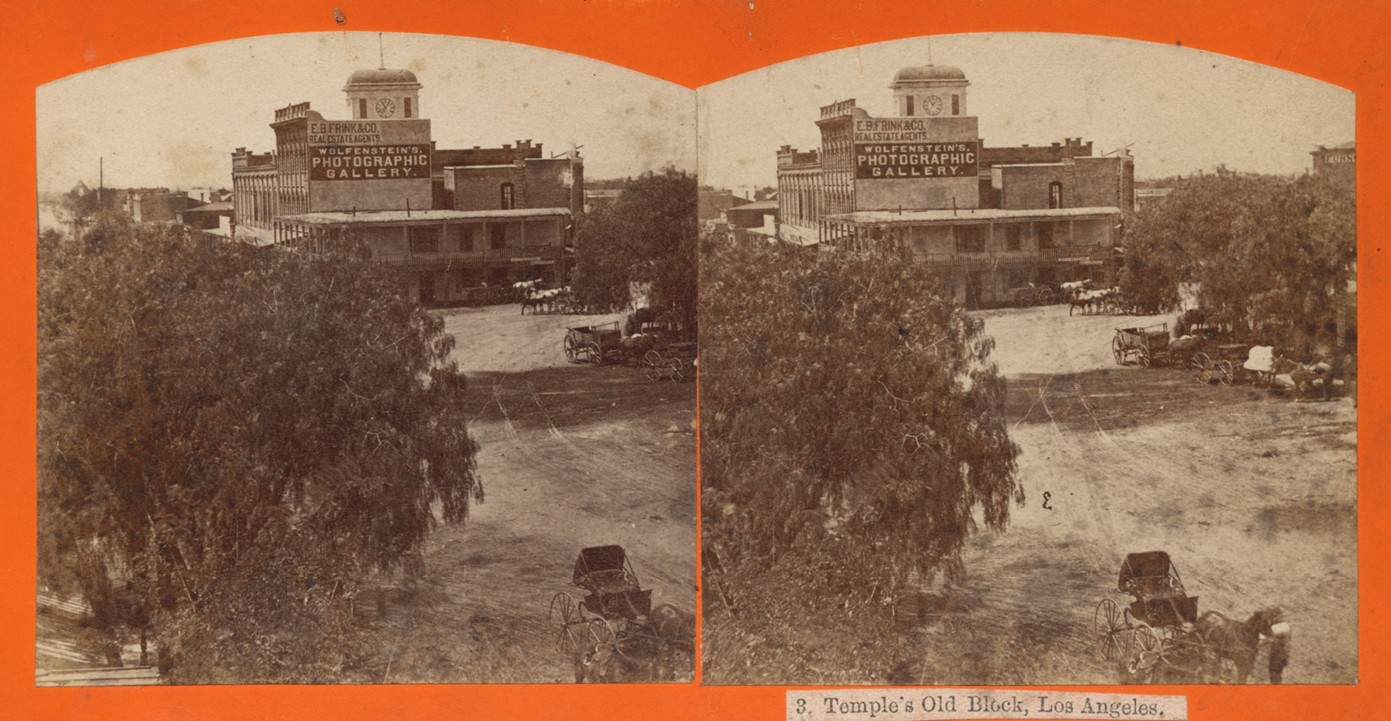 |
|
| (1869)* – Stereoscopic view looking south on North Main Street toward Temple Street and its intersection with Spring Street. At the junction stands the two-story adobe Temple Block, with a four-story brick commercial building rising directly behind it. Signs on the upper building read E. B. Frink and Co. Real Estate Agents and Wolfenstein’s Photographic Gallery. The Clocktower Market and Courthouse can be seen further back. Horses and wagons line the unpaved street. Photo by W. M. Godfrey. |
Historical Notes In 1869 the Temple Block area was the center of government and business activity in early Los Angeles. Most buildings were still made of adobe, but brick structures had begun to appear around Main and Spring Streets. The Clocktower Courthouse seen here was the fifth location used by Los Angeles County since 1850, when California became a state. Before moving into the Temple Block in 1861, the county courthouse had already occupied several temporary homes, including rented rooms in the Bella Union Hotel, the home of attorney Benjamin Hayes, and the Roche or Rocha House on Spring Street. The move into the Temple Market Block marked the start of a more stable period of county government during a time when the city was still rough, dusty, and only lightly settled. |
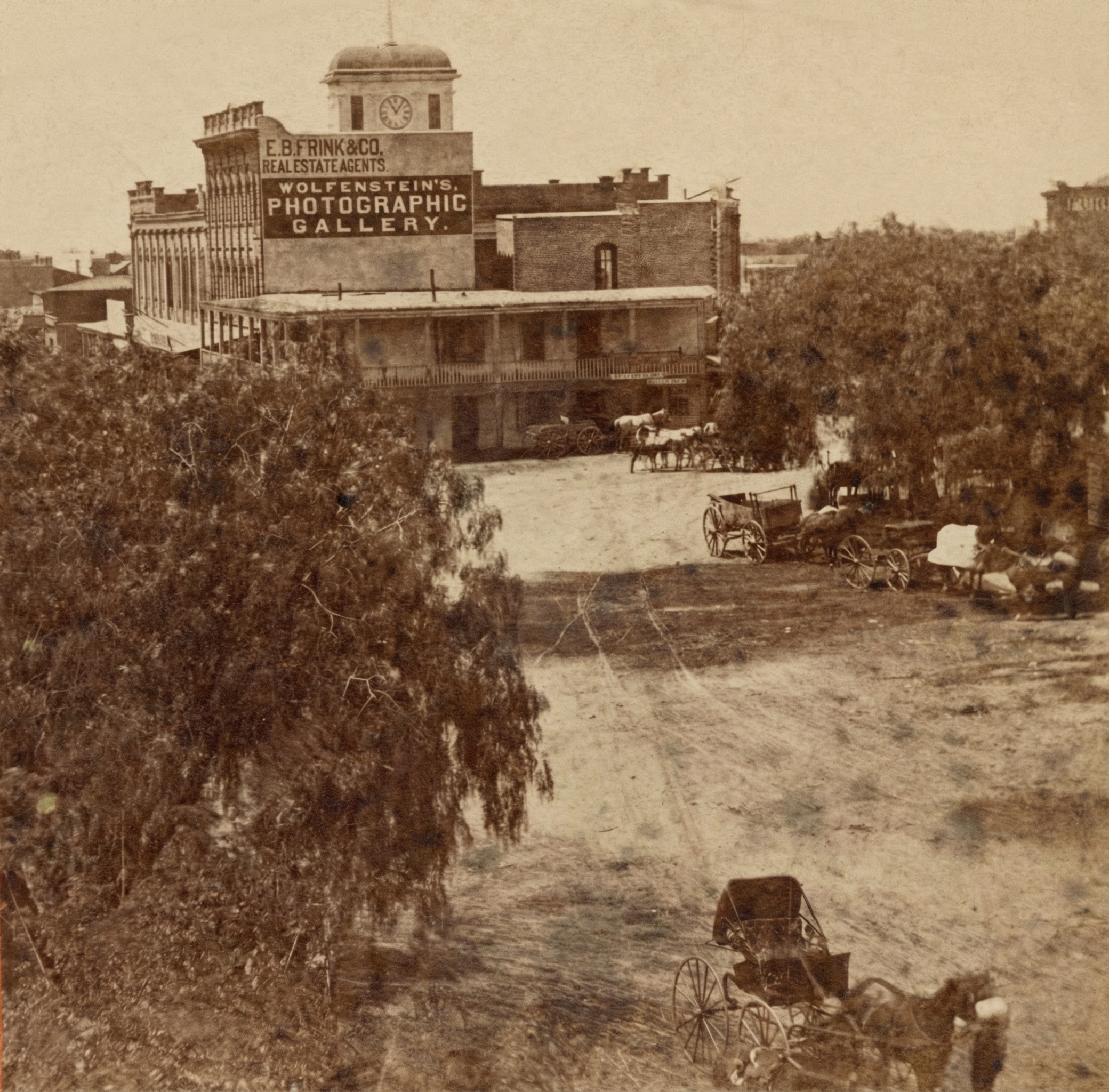 |
|
| (1869)* – Right panel of the previous stereoscopic image showing Main Street looking south toward Temple Street and its intersection with Spring Street. The adobe Temple Block sits at the junction, with a four-story brick commercial building rising behind it. The signs for E. B. Frink and Co. and Wolfenstein’s Photographic Gallery are clearly visible. The Clocktower Market and Courthouse stands farther back. Photo by W. M. Godfrey. |
Historical Notes This view shows the busy activity around the Main and Temple intersection. The simple adobe buildings in front contrast with the larger brick structures that were beginning to define the growing business district. Just beyond the adobe is the Clocktower Courthouse, which served the county from 1861 until 1891. Market Street ran along the north side of the courthouse, and Court Street ran along the south side, giving the building its central role in public life. During these years Los Angeles was slowly shifting from a frontier town into a small American city. The courthouse handled cases involving land claims, disputes among ranchers, and conflicts between newcomers and long-time residents. Horse drawn wagons and unpaved roads were still part of daily life. |
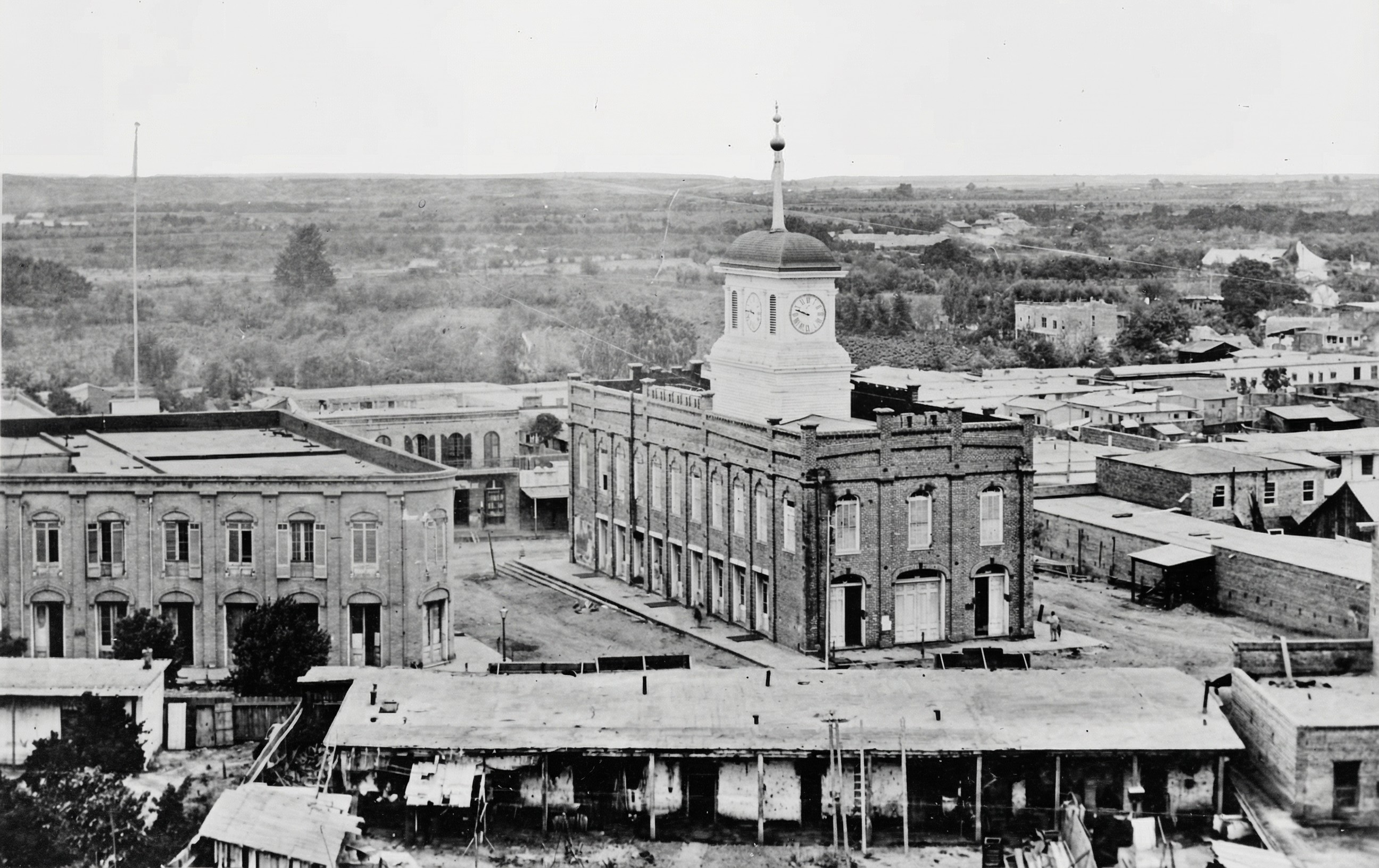 |
|
| (1869)* - View looking east toward the old Los Angeles County Courthouse in the Temple Block. This was the county’s fifth courthouse location. Market Street ran between Main and Spring Streets along the north side of the Clocktower Courthouse, while Court Street ran along its south side. |
Historical Notes Through more than 150 years the county has used at least eight buildings as its county courthouse. All have been situated within a mile of each other in downtown Los Angeles south of the original plaza in what has for the past 80 years been called the Civic Center. ◆ The first county courthouse was in the adobe Bella Union Hotel, where court was held in rented rooms from 1850 to 1852. |
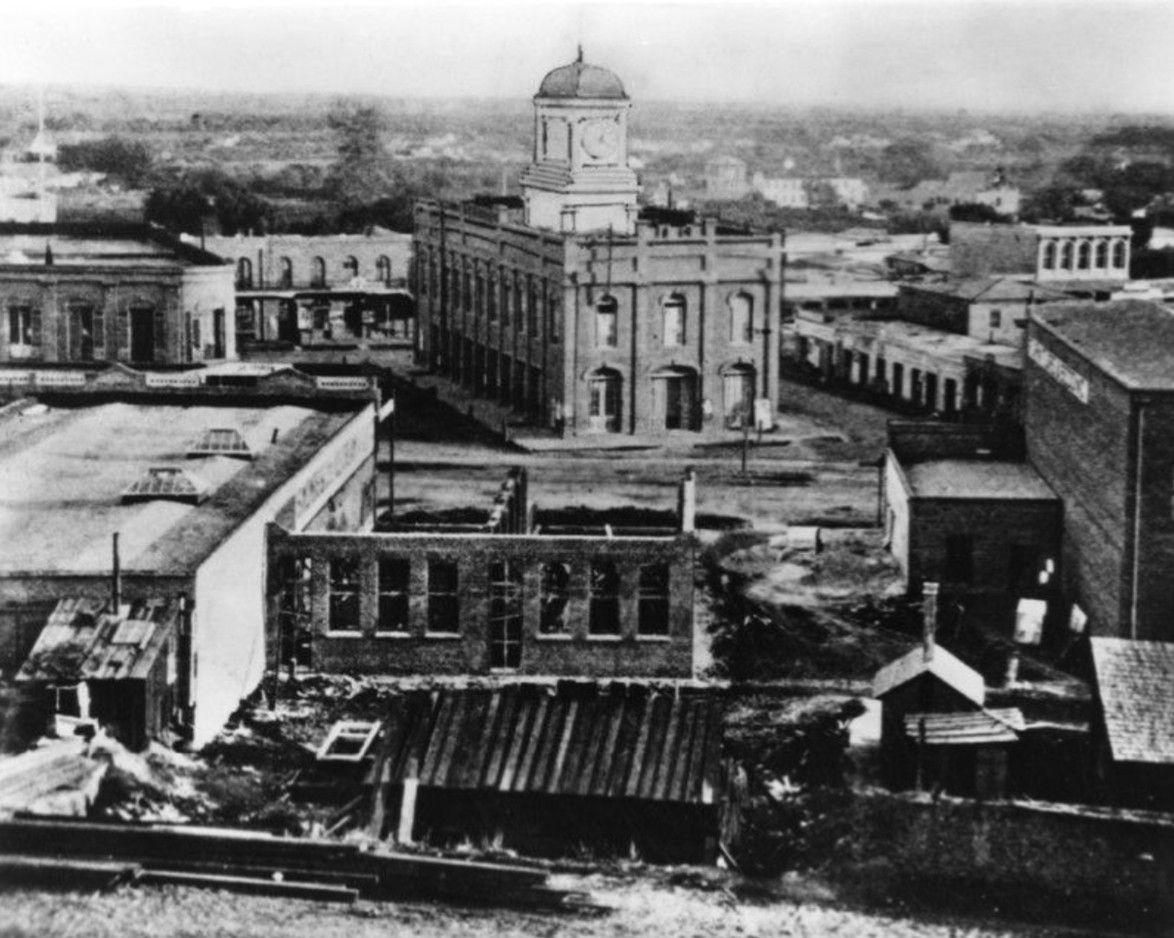 |
|
| (1876)* - Elevated view of the Clocktower Market and Courthouse in the Temple Block, the main county government center located one block east of the first city hall and jail. |
Historical Notes By 1876 the Temple Block had become the heart of public activity in Los Angeles. Jonathan Temple, one of the city’s earliest merchants and civic leaders, had developed the block in the 1850s and 1860s with shops, offices, and the Market House, which later became the courthouse. The tall clock tower was one of the city’s first visible landmarks and appeared in many early photographs. The courthouse continued in use until 1891, when the county moved into the new red sandstone courthouse on Poundcake Hill. After the Long Beach earthquake of 1933, that building was removed, and today the site is occupied by the Foltz Criminal Justice Center. This early view shows the city at a time when most of the surrounding area was still open land. Within a few decades, this district would become the center of the modern Los Angeles Civic Center, home to city hall and other major public buildings. Click HERE to see more early views of the Temple Block. |
* * * * * |
The First City Hall and Jail of Los Angeles (Rocha Adobe)
.jpg) |
|
| (1850s)* - Model of early Los Angeles showing the first city hall and jail at center-left on the northwest corner of Spring and Franklin (formerly Jail) Streets. |
Historical Notes This model represents the heart of Los Angeles as it appeared in the early 1850s. The first city hall and jail stand at the northwest corner of Spring and Franklin Streets. At this time Spring Street was known as New High Street, and Franklin Street was called Jail Street because the jail stood at its eastern end. The hill behind the building is Poundcake Hill, later the site of the 1888 County Courthouse. To the right are Temple Block and the Clocktower Market and Courthouse, which formed the center of civic life in early Los Angeles. The model shows how small and closely packed the young city was during its earliest years. |
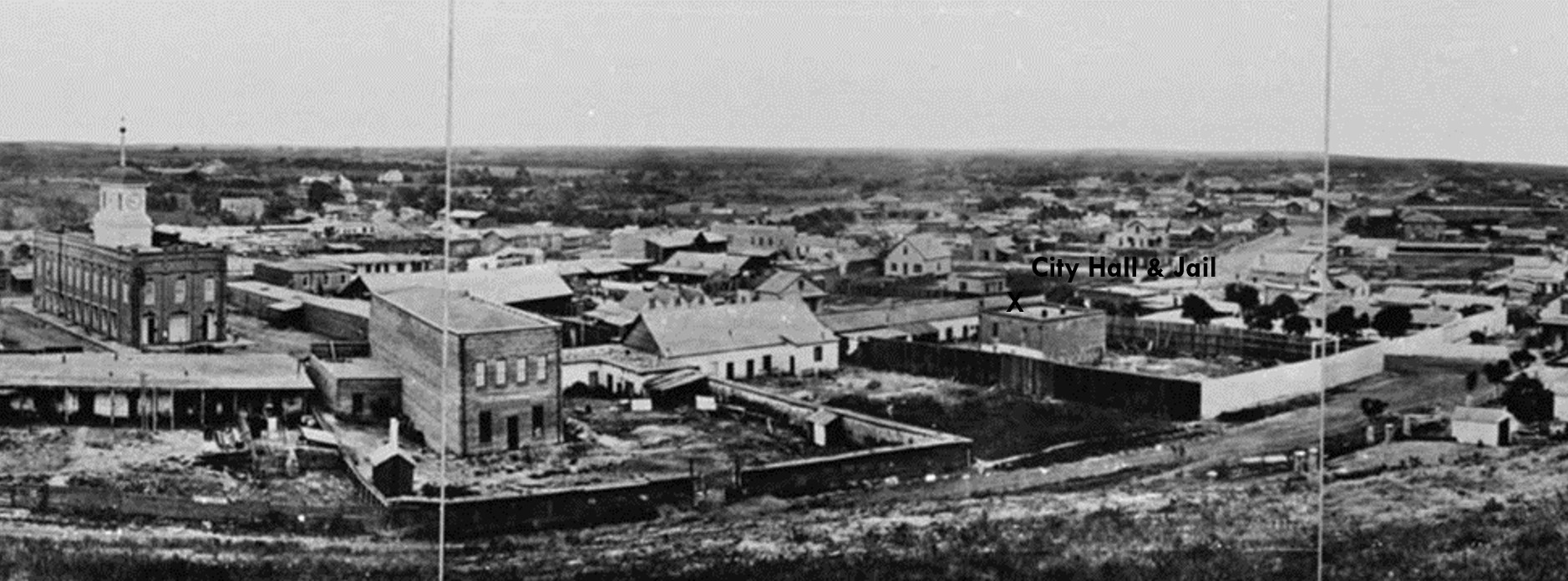 |
|
| (ca. 1869)* - Composite panoramic view showing the first city hall and jail at the corner of Spring and Jail Streets, with the adobe city offices along Spring Street and the brick jail standing in the yard behind it. |
Historical Notes This view shows the full first city hall and jail complex at the northwest corner of Spring and Jail Streets. The adobe fronting Spring Street served as the city offices. Behind it stands the two-story brick jail. The open yard between the buildings held prisoners and was the site of early executions. Because vigilantes sometimes stormed the jail, the tall fence around the yard was built mainly to keep angry crowds out. The Clocktower Market and Courthouse on Temple Block appears at left. Few images capture this important early civic corner as clearly as this one. |
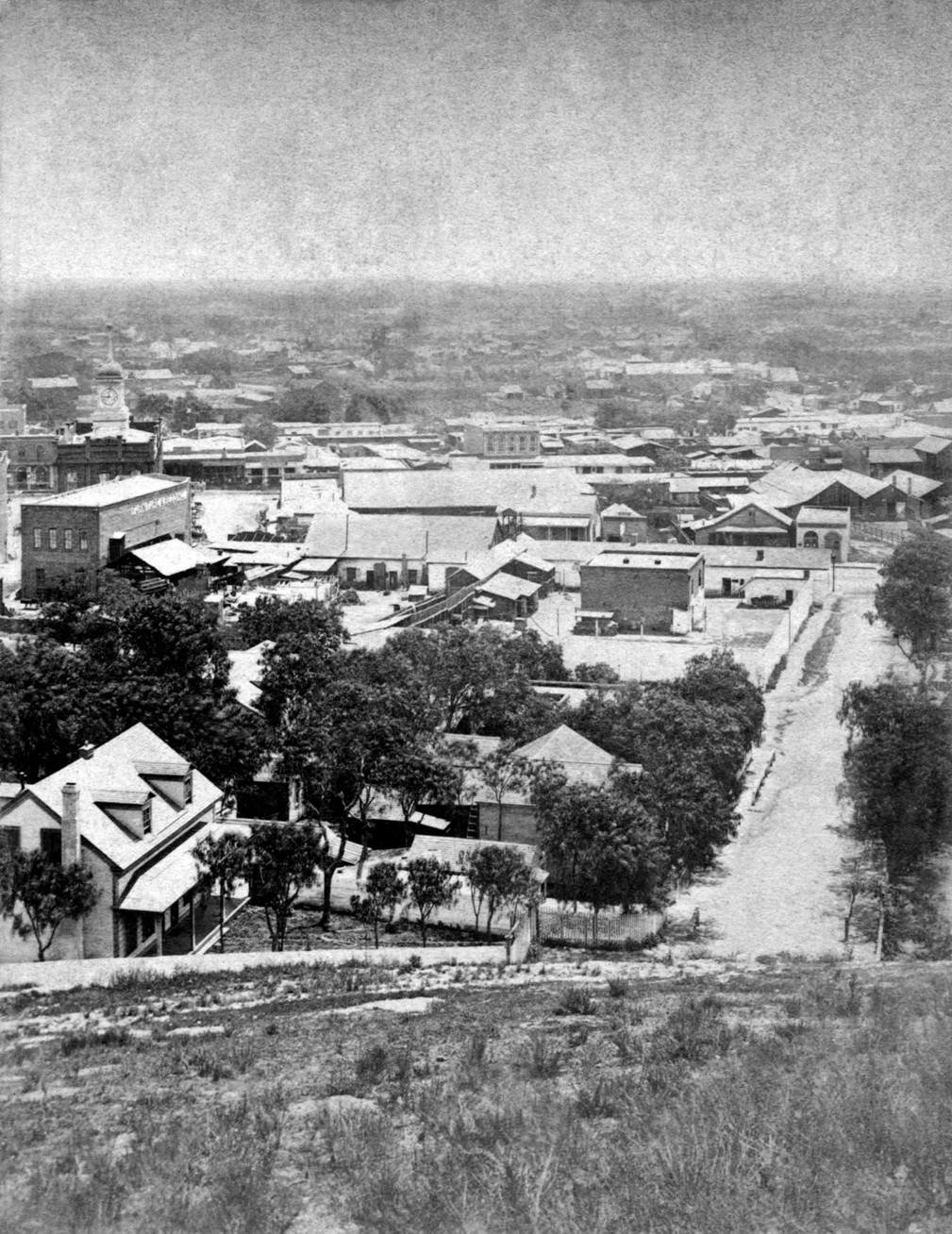 |
|
| (ca. 1875)* - View looking east down from Poundcake Hill showing Franklin Street (originally Jail Street) as it intersects with Spring Street. LA’s first designated Jail (brick building) sits near the northwest corner. The long building it sits behind is the Rocha Adobe on Spring Street which also served as LA’s first City Hall. The Temple Block clock tower is visible at upper left. |
Historical Notes This view shows the first city hall and jail complex from the hillside west of Spring Street. The long adobe on Spring Street originally served as the home of Antonio José Rocha and was used as the city offices in the eighteen fifties and sixties. Behind it stands the two-story jail, with adobe walls on the lower level and brick above. The small white outhouse at the southwest corner of the yard is clearly visible. Executions were carried out in the jail yard, and residents often stood on the hill behind the jail to watch the proceedings. This photograph highlights the compact layout of the early civic center. |
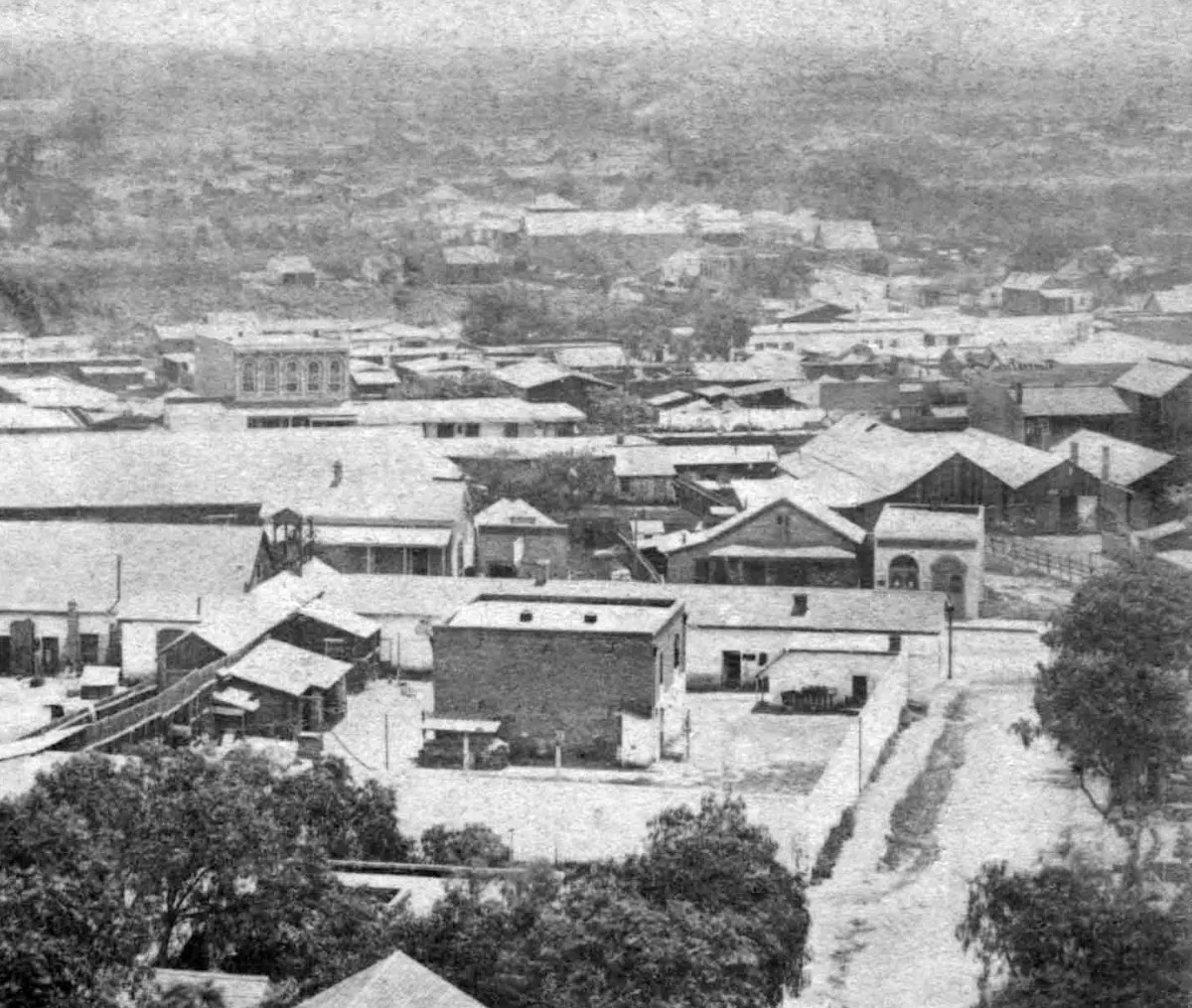 |
|
| (ca. 1875)* - Henry T. Payne stereoscopic view from the hillside west of Spring Street showing the Rocha Adobe with the brick jail building in the yard behind it. |
Historical Notes This stereoscopic view by photographer Henry T. Payne shows the first city hall and jail complex from the hillside west of Spring Street. The long adobe on Spring Street originally served as the home of Antonio José Rocha and was used as the city offices in the eighteen fifties and sixties. Behind it stands the two-story jail, with adobe walls on the lower level and brick above. The small white outhouse at the southwest corner of the yard is clearly visible. Executions were carried out in the jail yard, and residents often stood on the hill behind the jail to watch the proceedings. Payne’s view, with its stronger stereoscopic depth, underscores the compactness of this early civic center. |
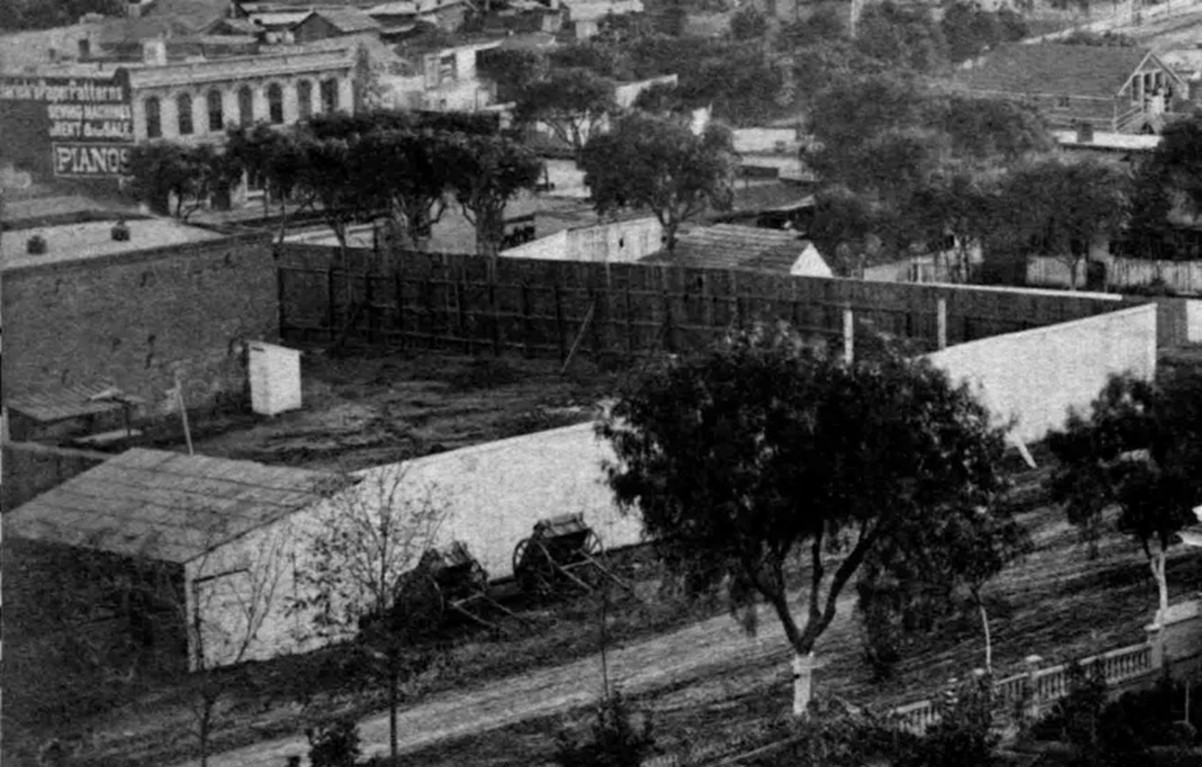 |
|
| (ca. 1875)*- Detail view of the fenced jail yard behind the former Rocha Adobe, showing the white outhouse and the two-story city and county jail building. |
Historical Notes This closer look at Spring Street captures the jail yard behind the adobe city offices. The tall fence surrounding the yard was built to protect the jail from intruders rather than to prevent escapes. The two-story jail building, adobe below and brick above, stands directly behind the yard. A commercial building on the east side of Spring Street is visible at upper left, displaying painted signs for clothing patterns, sewing machines, and pianos. The scene reflects the mix of civic and commercial activity that filled this small area of the city. |
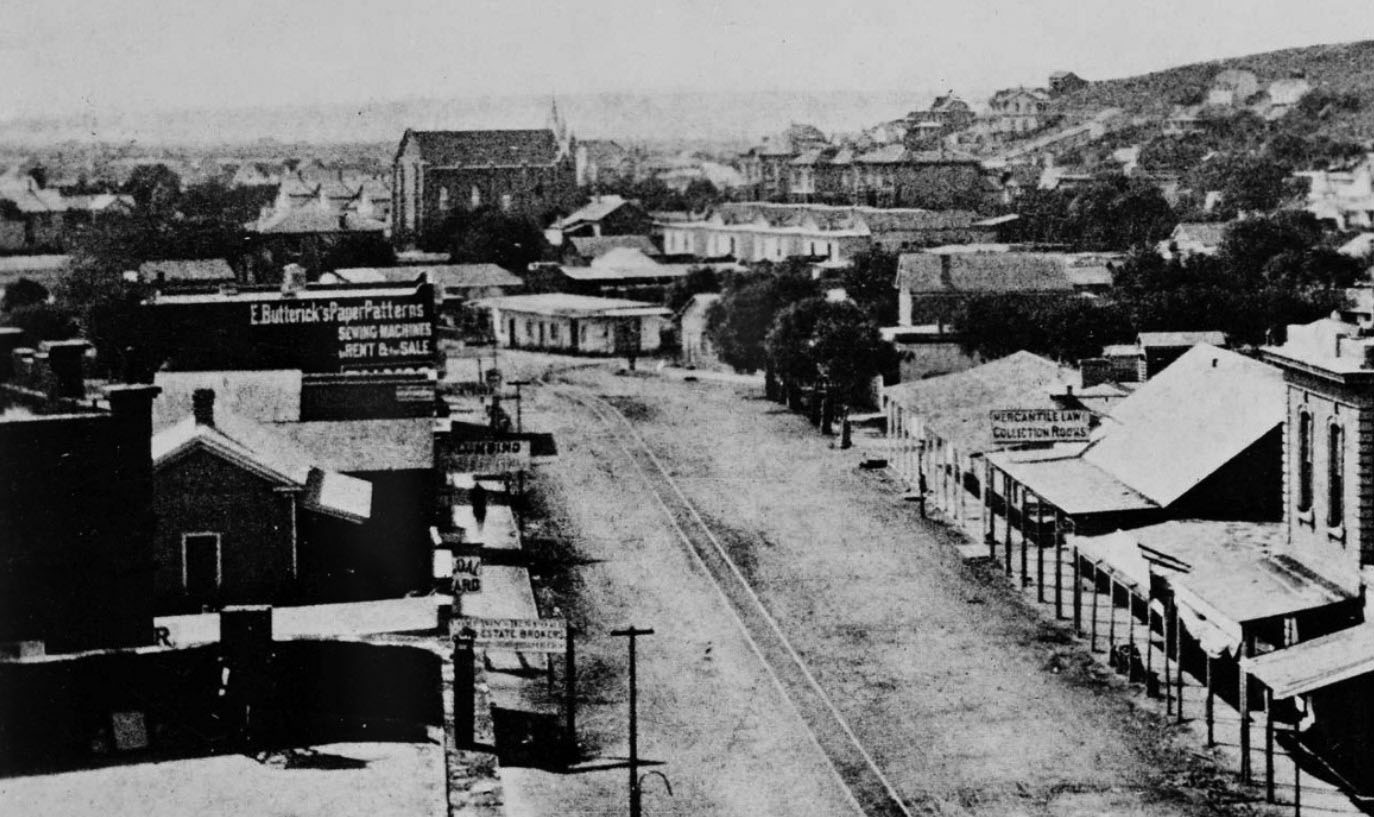 |
|
| (1874)* – View looking south on Spring Street as seen from the top of the Clocktower Market/Courthouse building. To the right of center is a building with a steep roof and a sign that says “Mercantile Law Collection Books.” The building immediately south of that, on the northwest corner of Spring and Franklin Streets, is the first Los Angeles City Hall and jail, a building the city and county shared. The taller building in the distance, near the top center of the photo, is the City's 1st Synagogue, built in 1873. |
Historical Notes In August 1853, an adobe home that had been built in the 1820s at the northwest corner of Spring and Franklin Streets – a site now under the current city hall – was sold by John Temple to the city and to Los Angeles County for a city hall and courthouse. The city owned a one-quarter interest in the property, and the county owned a three-quarters interest. A brick jail used by both the city and county was constructed behind the adobe in 1853-54, the first (non-adobe) brick building built in Los Angeles. |
Rocha Adobe
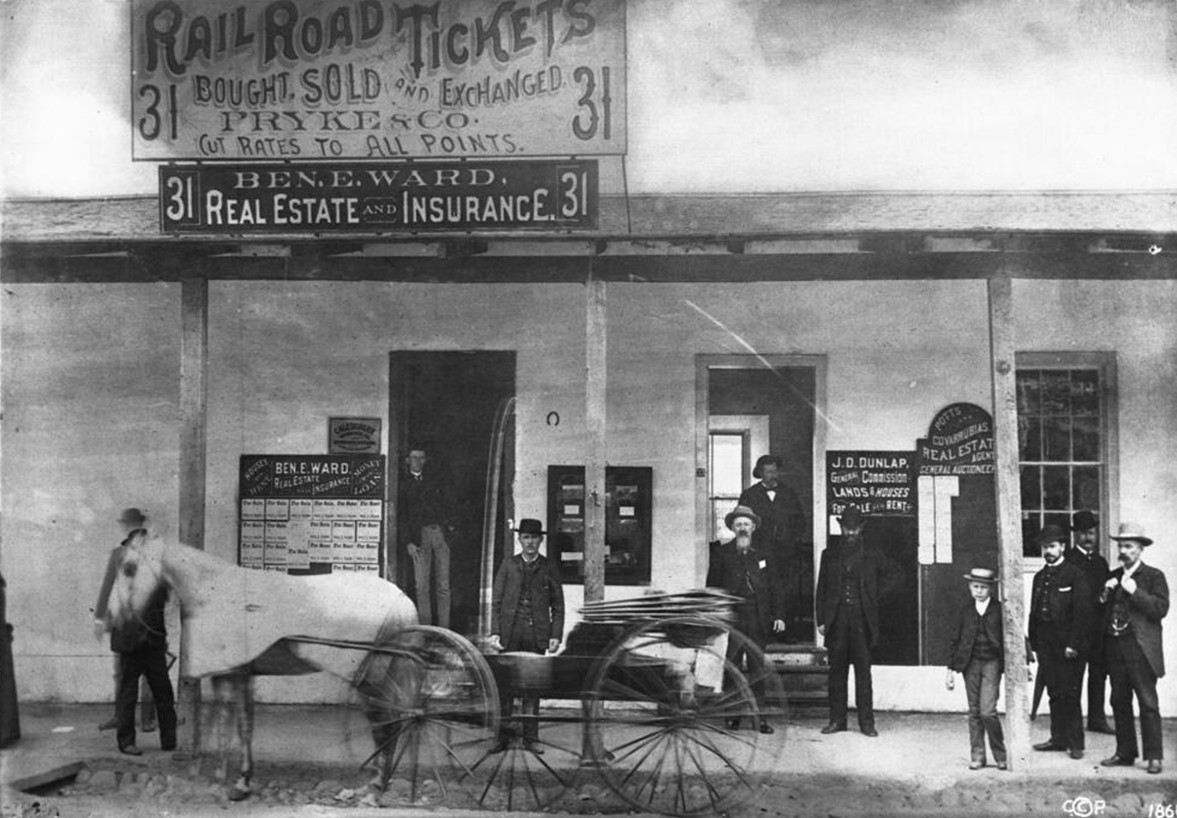 |
|
| (ca. 1880)* - View showing the first Los Angeles jail and city hall, west side of Spring Street on the corner of Franklin Street. A group of men and a boy stand in and around the doors under the roof overhang of the 1-story building. A horse-drawn wagon moves by going to the left. The address above is 31 and 33 Spring Street. |
Historical Notes By the 1880s the original city hall and jail had been converted into storefronts. The adobe stood on the northwest corner of Spring and Franklin Streets and was originally built as a residence by Antonio José Rocha. Signs advertise real estate, insurance, railroad tickets, and auction services. Several men and a boy stand beneath the porch roof while a wagon passes by. Although no longer serving its original purpose, the building remained a familiar landmark until it was demolished as downtown Los Angeles expanded. Originally built in the 1820s as a residence by Antonio Jose Rocha and deeded to the city in 1855 by Rocha, Buenaventura Lopez, his wife, Jose Jorge Rocha, Guadalupe Valez, and his wife. Later used as a railroad ticket office and real estate office. The businesses advertised are "Ben. E. Ward, real estate and insurance", "Pryke & Co., railroad tickets bought, sold and exchanged, cut rates to all points", "Potts and Covarrubias, real estate agent, general auctioneer" and "J. D. Dunlap, general commission, lands & houses for sale or rent". Mr. Dunlap was also a Deputy Marshall. The following historical timeline lists the buildings used by City Council, also known as City Hall, since 1850, when Los Angeles was incorporated as a municipality: ◆ 1850 - 1853 - used rented hotel and other buildings for City meetings ◆ 1853 - rented adobe house (aka Rocha Adobe) on Spring Street - across from current City Hall (now parking lot for Clara Shortridge Foltz Criminal Justice Center). The buliding was shared with the County who used it as a Court House. ◆ 1861 - moved into John Temple's Clocktower Market Building, but only stayed for less than a year before the County Court House moved-in ◆ 1861 - 1884 - relocated back to the Rocha Adobe and stayed for over 20 years ◆ 1884 - 1888 - moved to new City Hall Building at South Spring Street and West 2nd Street (site of current Los Angeles Times Building) ◆ 1888 - 1928 - moved to new Romanesque Revival Building on 226-238 South Broadway between 2nd Street and 3rd Street; demolished in 1928 and now site of parking lot between LA Times Parking structure and 240 Broadway. ◆ 1928 - moved to current City Hall Building |
* * * * * |
McDonald Block
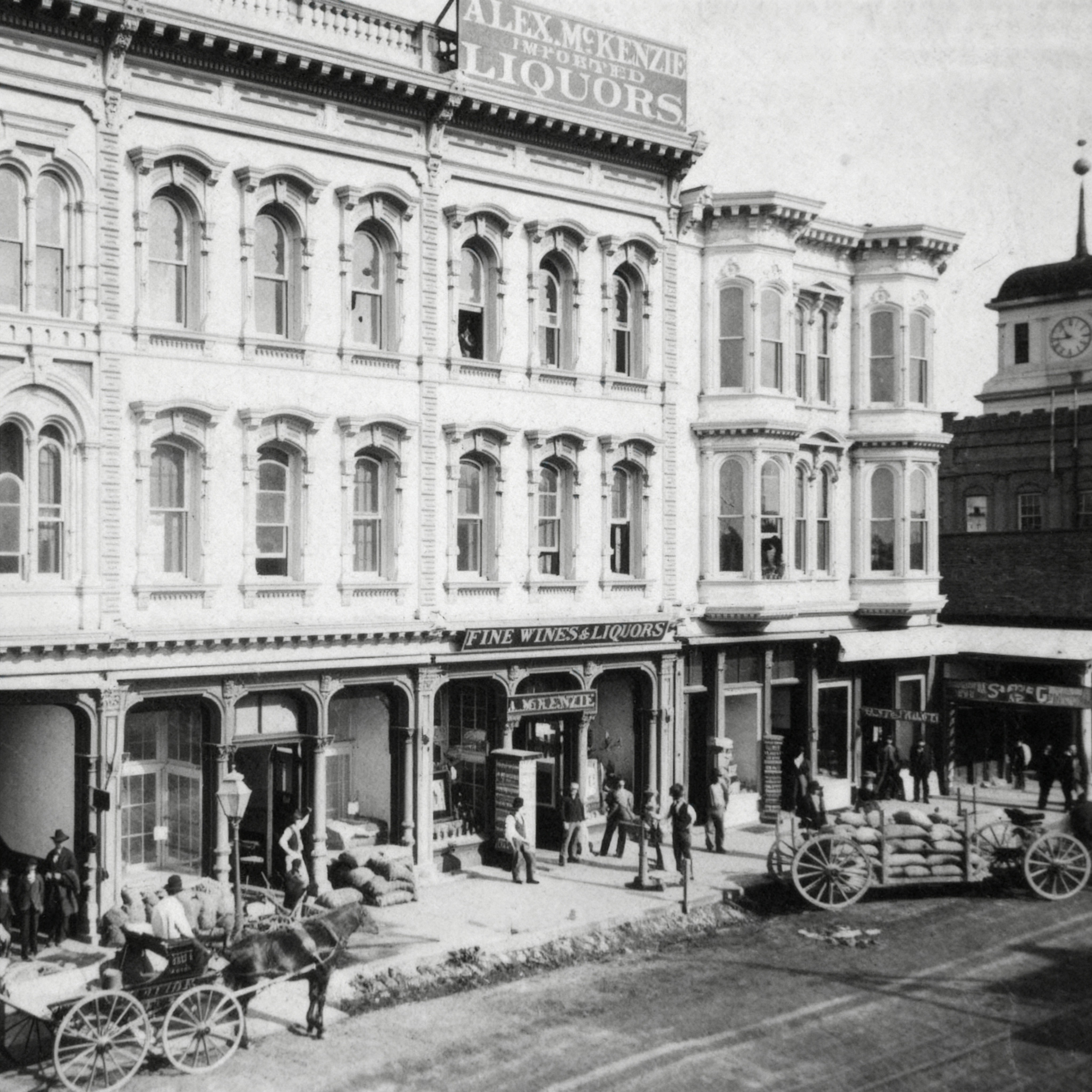 |
|
| (1876)* - View of the Old McDonald Block at 127 North Main Street between First and Court Streets. Temple’s old courthouse building with its clock tower appears in the background. |
Historical Notes The McDonald Block stood at 127 North Main Street, on one of the busiest stretches of Los Angeles during the 1870s and 1880s. Built in the mid 1870s and attributed to architect Ezra Kysor, it was an early brick commercial block with an Italianate facade, tall arched windows, and a cast iron storefront. It marked the city’s transition from a frontier town of adobe buildings into a more modern business district. The ground floor contained a number of retail businesses typical of the era, including Alex McKenzie’s Wines and Liquors, the Grange Store, and Park Millinery Goods. The second floor housed the offices of Judson, Gillette and Gibson, well known for their work in real estate and title examination, as well as the offices of Kysor and Hennessey. The third floor, known as McDonald Hall, served as a meeting and assembly room used by civic groups and, for a time, a Masonic lodge. In 1880 the first meetings of the Los Angeles Athletic Club were held in the law offices on the second floor, with James B. Lankershim among those present. Although long since demolished during the development of the Civic Center, surviving images of the McDonald Block provide a valuable record of early Main Street and the architectural and commercial growth of nineteenth century Los Angeles. |
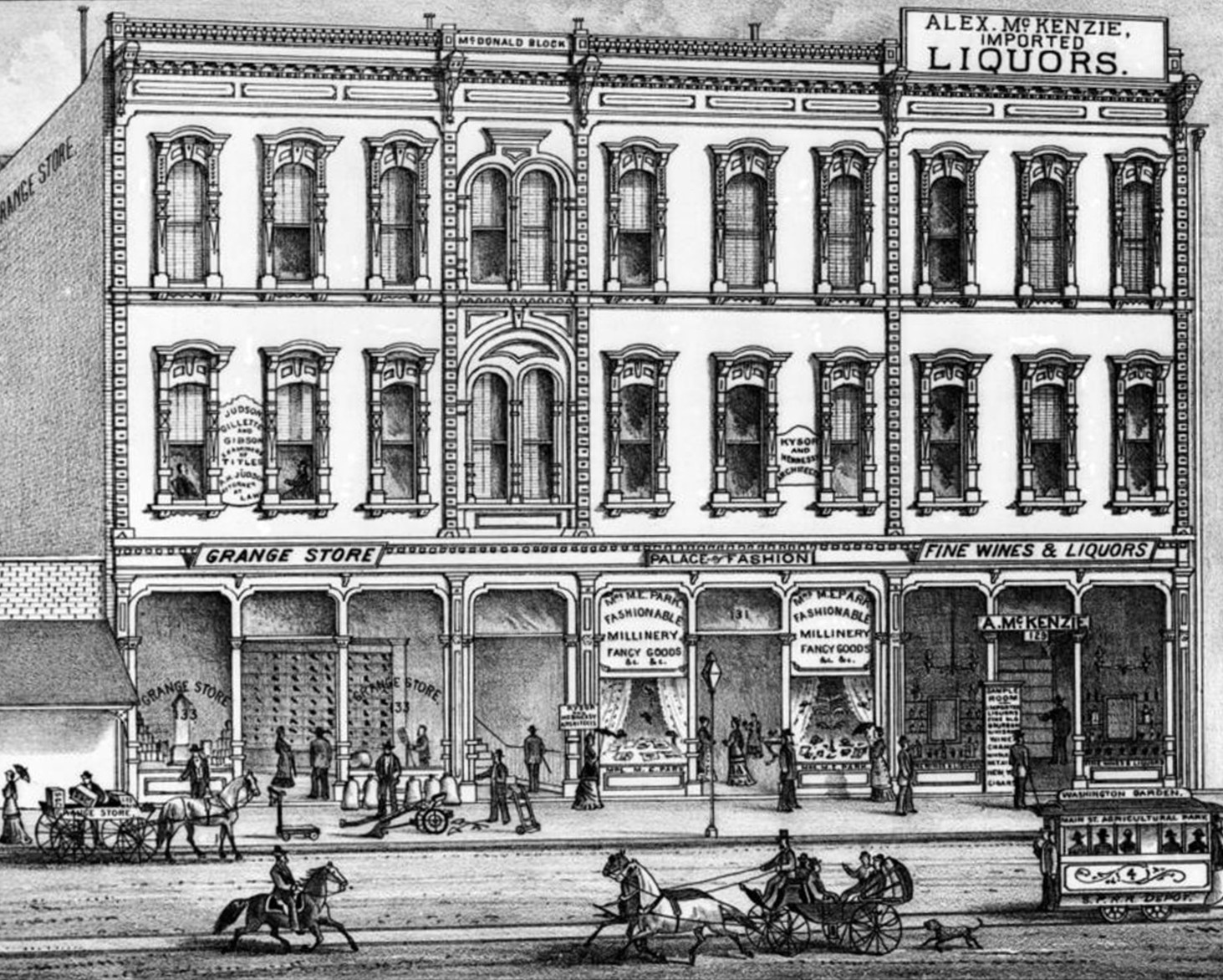 |
|
| (1880s)* - Lithograph of the McDonald Block at 127 North Main Street between First and Court Streets. |
Historical Notes The McDonald Block was one of the more substantial commercial buildings on Main Street in the late 1870s and 1880s. Built in the mid 1870s and attributed to architect Ezra Kysor, it featured a three story Italianate facade with tall arched windows, bracketed cornices, and a cast iron storefront. Its appearance marked an early move toward brick and iron construction as Los Angeles began to shift away from its earlier adobe character. The lithograph shows the building in its prime, with the full Main Street frontage visible. The ground floor housed several shops, including McKenzie’s liquor business, the Grange Store, and Park Millinery Goods. Upper floors contained professional offices, such as the law firm of Judson, Gillette and Gibson and the architectural offices of Kysor and Hennessey. The top floor, known as McDonald Hall, served as a meeting space for civic groups and fraternal organizations. The building also holds a place in the early social history of Los Angeles. In 1880 the first organizational meetings of the Los Angeles Athletic Club were held in the second floor offices, with James B. Lankershim among the founders. The McDonald Block remained an important address into the 1890s before changes to the Civic Center resulted in its removal. Today only images like this lithograph preserve the appearance of this early commercial landmark on Main Street. |
* * * * * |
Signoret Block
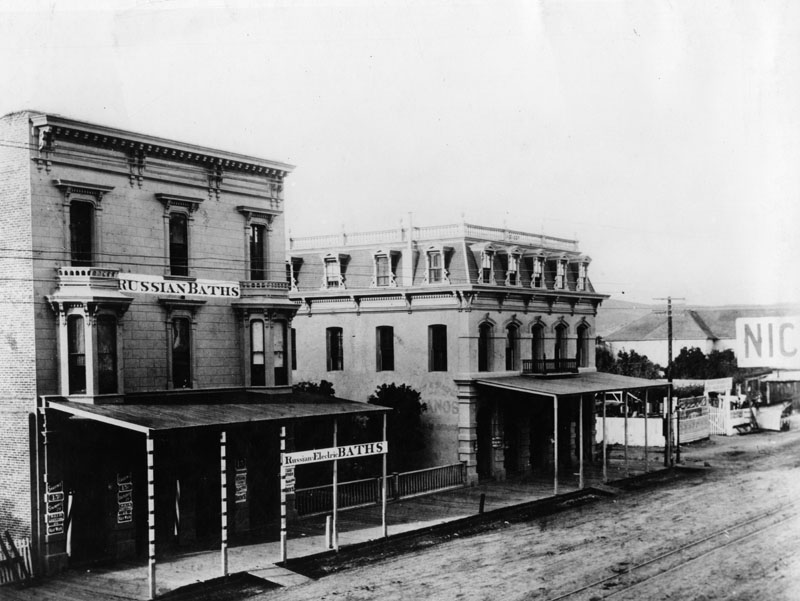 |
|
| (ca. 1881)* - Photograph of a view looking north along Main Street near the Los Angeles Plaza showing the Signoret Block. A three-story brick building stands in the left foreground along the unpaved street advertising "Russian Electric Baths" and features bay windows on the second floor as well as an overhang that shades the sidewalk in front of it. A second, similarly-constructed building stands farther in the background down the road and features gingerbread trim. Hills can be seen in the distance. Legible signs include: "Shaving 15¢", "Shampooing 25¢", "Hair Cutting 25¢", "Hair Work", "15 Russian Steam and Electric Baths", "Other Medicated Baths", and "Mrs. Huck's Dressmaker / Modes de Paris". |
Historical Notes Felix Signoret was born in France on June 9, 1825, living in Marseilles before he came to the United States. By trade he was a barber, later an apartment owner. He bought a parcel of land at 125 Aliso Street in 1871 and built a "substantial brick house" about thirty feet wide with an area of nearly 1,800 square feet; the roof was "hipped on all four sides in mimicry of the fashionable Mansard shape. . . . By 1888 the Signorets . . . were long gone, and their genteel house was used as a brothel." Signoret was elected to the Los Angeles Common Council, the governing body of the city, serving from May 9, 1863, to May 5, 1864. He was also a member of the Los Angeles County Board of Supervisors in 1866. He is also known for having led a lynch mob that hanged five people in Los Angeles in 1869–70 in the aftermath of a murder resulting from 'offensive remarks (made) about the newly organized French Benevolent Society.' In 1874, Signoret built a new hotel at Main and Turner streets, north of Arcadia Street and "opposite the Pico House," also with a Mansard pitch, which the Los Angeles Star said would be the first such roof in the city. |
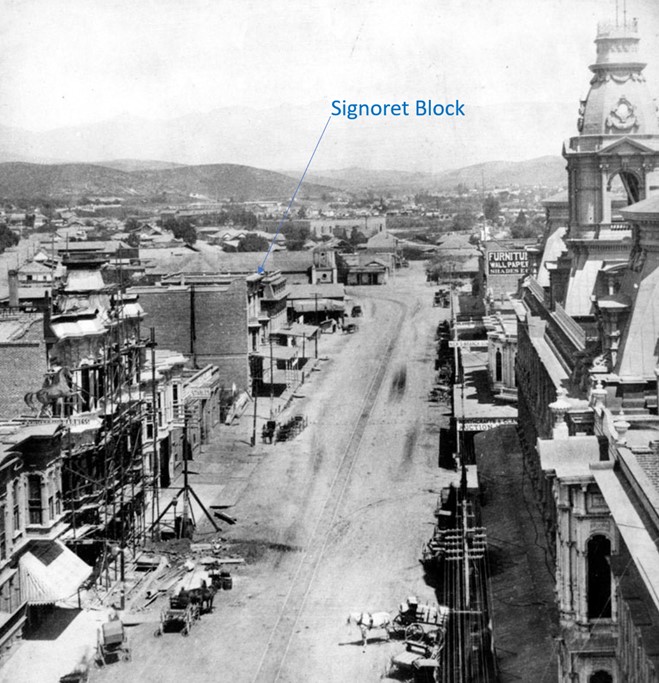 |
|
| (ca. 1880)* - Looking north on Main Street from top of the Downey Building located just south of the Baker Block showing the location of the Signoret Block, across the street fromthe Pico House. |
* * * * * |
Spring Street (1870s)
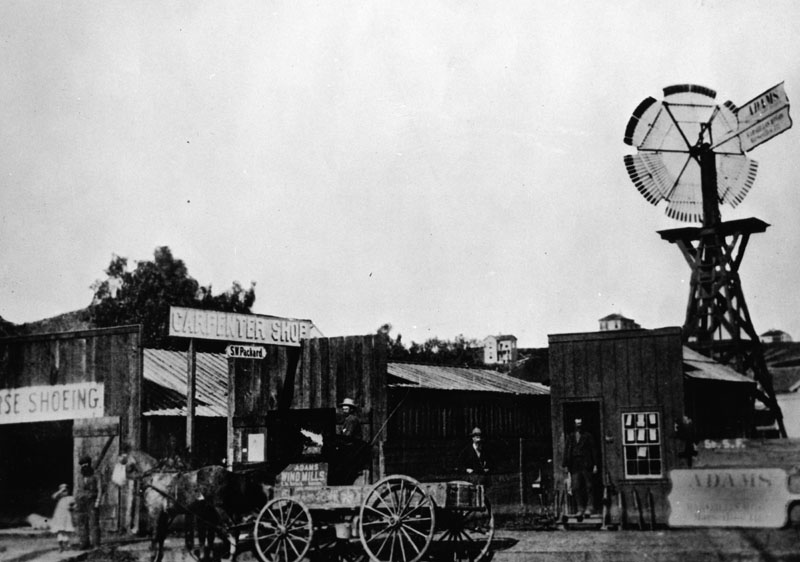 |
|
| (1876)^ - On Spring near First Street. Stage depot/livery stable at left offering horse shoeing had once served as headquarters for the Butterfield Overland Stage, which arrived in Los Angeles for the first time in 1858. |
Historical Notes In 1876, the year this picture was taken, a land boom developed in Santa Monica. Stagecoaches to the beach were abandoned in favor of the Los Angeles & Independence Railroad , which carried passengers for $1 a round trip, arranging their schedules to allow time for riders to swim, picnic or buy lots in the growing community. The Butterfield Overland Stage headquarters site has been designated as California Historical Landmark No. 744. Click HERE to see more of the California Historical Landmarks in LA. |
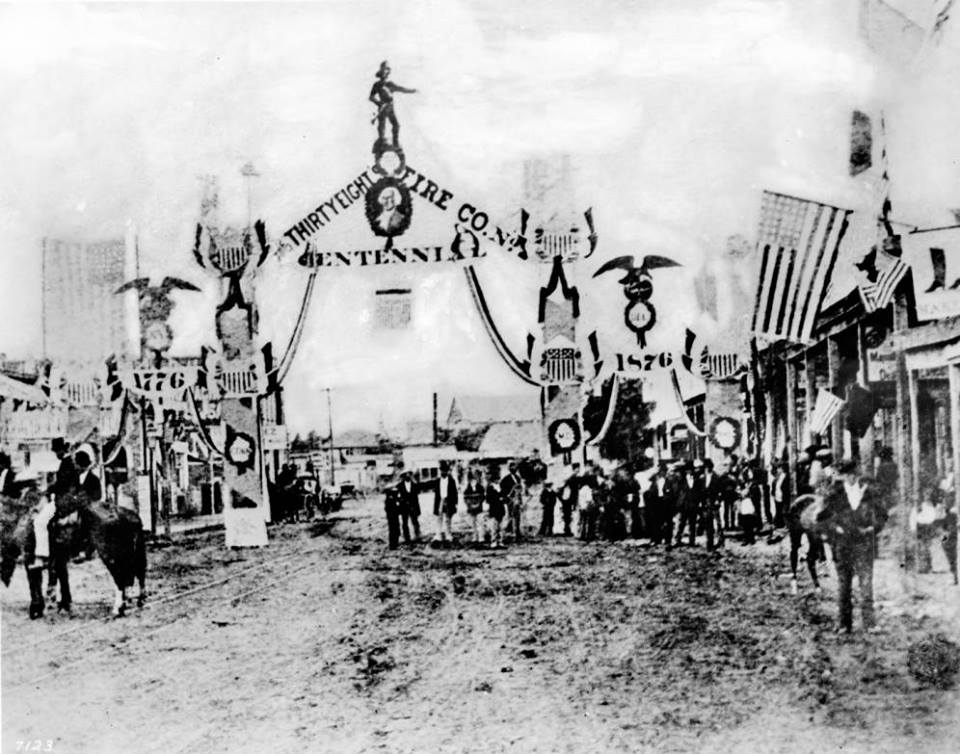 |
|
| (1876)^^ - Fourth of July, 1876: Los Angeles celebrates the centennial of American independence with a parade down a dusty Spring Street. |
* * * * * |
Main, Spring, and Temple Streets
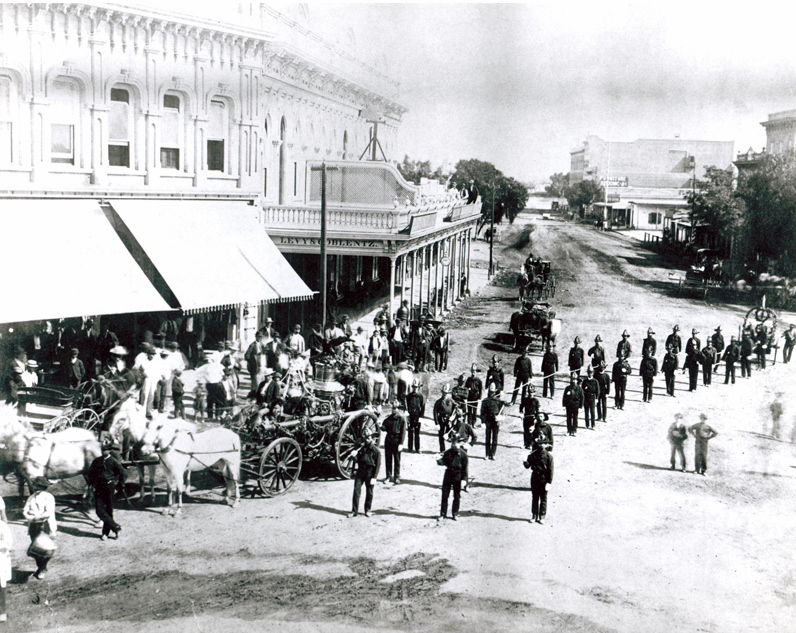 |
|
| (ca. 1870s)^^* - This is the earliest known photo of the Los Angeles Volunteer Fire Department. A horse-drawn fire engine followed by uniformed firemen (volunteers) parade at the corner of Main and Spring Streets with the Downey Block on the left. |
Historical Notes Below are two different captions related to this photo: "The first Fire Company was organized on September 30, 1871. The boys are out celebrating the First Anniversary of the occasion with a parade. This is the first known picture taken of the Fire Company. The camera was pointing North from Main and Spring Streets. The Pico House can be seen in the background. The buildings back of the fire engine are on the present site of the Federal Building." - The Firemen’s Grapevine (1961) "The Los Angeles Volunteer Fire Department celebrated its first anniversary, September 30, 1872, with a parade through downtown streets. They paused at Main and Temple Streets, where Photographer V. Wolfenstein captured the scene for posterity in a picture which was to become one of the fire department's most famous through frequent reproductions of it." - A Century of Service (1886-1986) by Paul Ditzel |
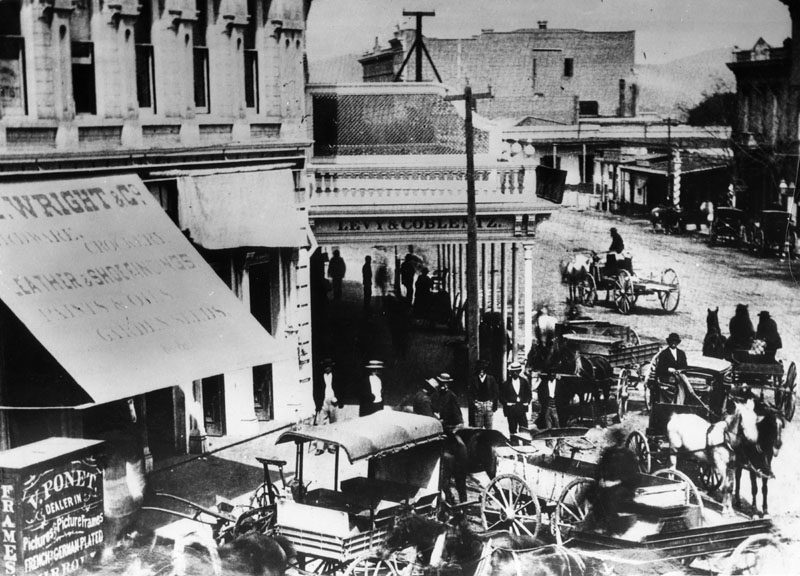 |
|
| (ca. 1871)^ - Another view of the corner of Main and Spring Streets, looking north from Temple Street showing the Downey Block. Several horse-drawn vehicles are on the street as well as pedestrians milling around. A sign on the edge of the balcony reads Levy & Coblentz. |
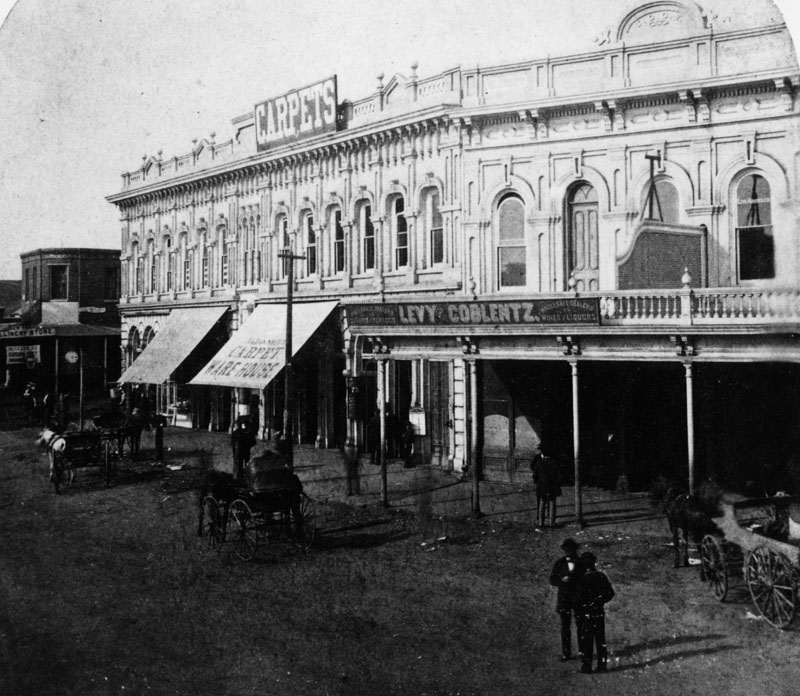 |
|
| (1875)^ - View showing the North Main Street side of the Downey Block. Two well-dressed men are standing on the dirt road in front of the building. |
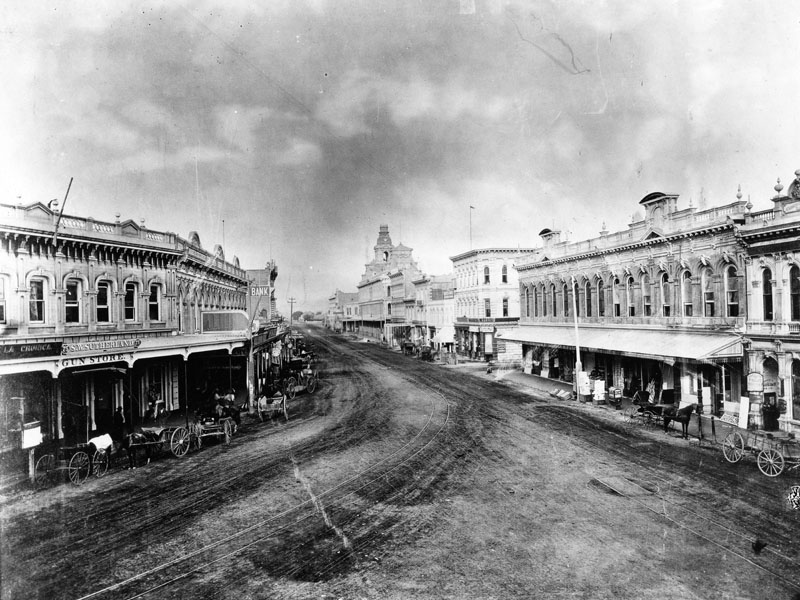 |
|
| (ca. 1878)^ - View of Main Street north from Temple Block, about 1878. The photograph was taken before the Farmers and Merchants Bank moved to Main and Commercial Streets in the fall of 1883. On the far right is Commercial Bank, which changed to First National Bank in 1880. A gun store is visible to the left located in the Downey Block. In the distance can be seen the cupola of the Baker Block. |
* * * * * |
Main Street
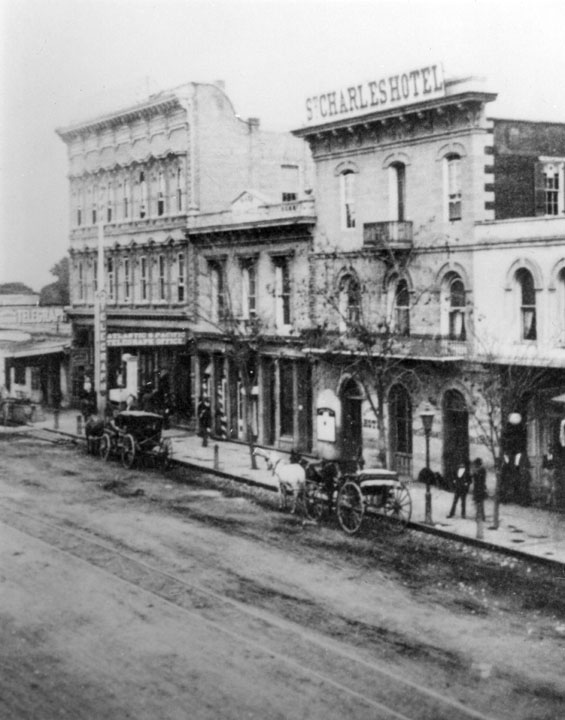 |
|
| (1880)^ - St. Charles Hotel, originally the Bella Union Hotel. The Bella Union became the Clarenden in 1873 and the St. Charles in 1875. Pico's building to the left was the original home of the Farmers and Merchants Bank, which later merged into the Security Pacific Bank. Also shown is the Atlantic & Pacific Telegraph Office, in the lower floor of the Backman House. |
Historical Notes The telegraph, invented in 1832 by Pavel Schilling and Samuel Morse, didn't get to Los Angeles until 1860.*^ Phineas Banning helped to bring telegraph lines to Los Angeles. In 1860, telegraph lines were slowly making their way toward Los Angeles from San Francisco. When progress lagged, Banning ordered wire and began building from his end. Starting in Wilmington, of course, the link was completed on October 8, 1860, and Los Angeles was no longer an isolated outpost. Click HERE to see more on Phineas Banning and Wilmington in Early Views of San Pedro and Wilmington. |
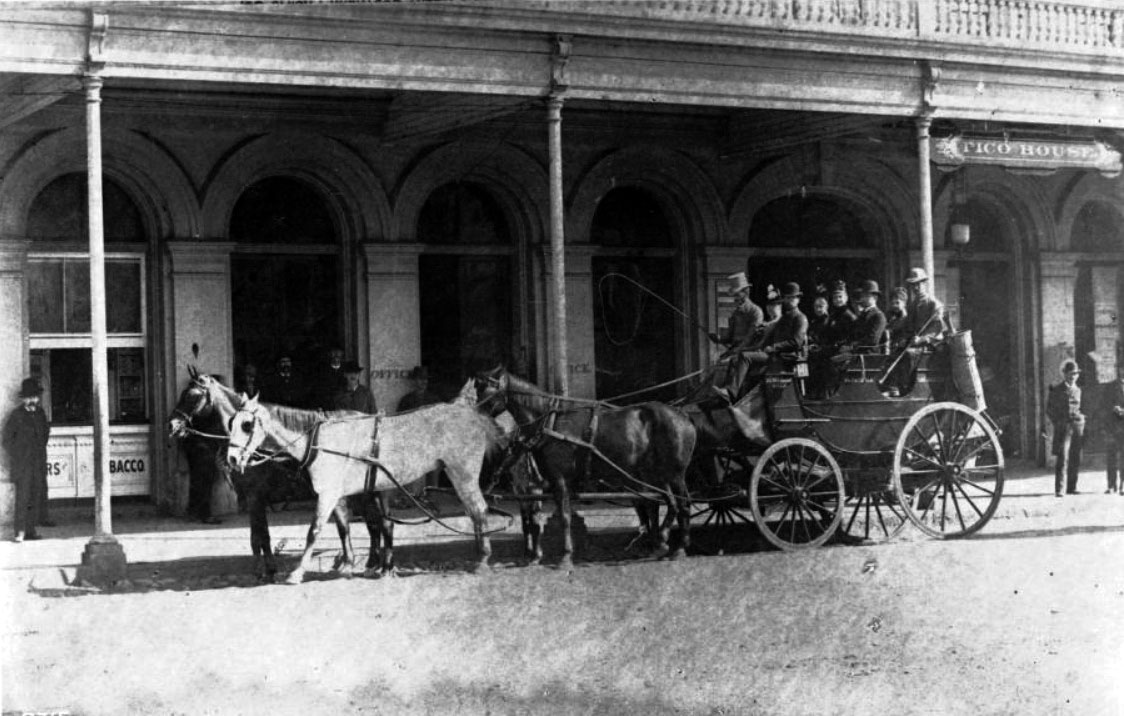 |
|
| (1880s)* - View showing a stagecoach (or Tally-ho) parked in front of the Pico House. Nine people sit in the uncovered stagecoach. The driver holds a whip over the hitched team of 4 horses. Nine other people stand on the boardwalk in front of Pico House looking on. |
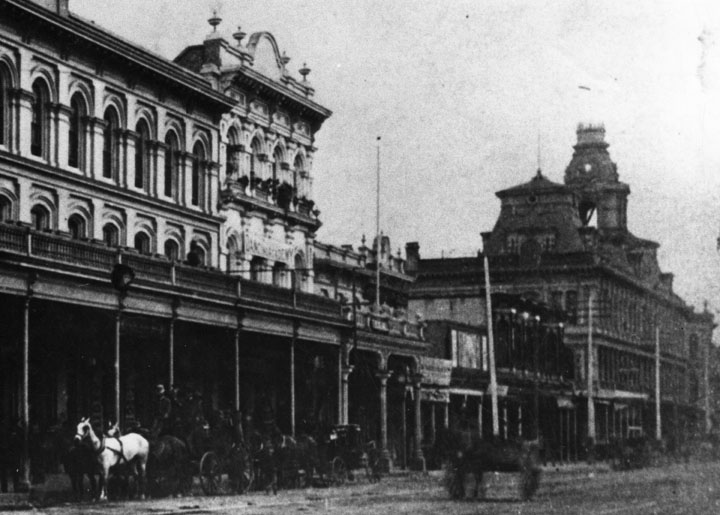 |
|
| (ca. 1880)^ - The Pico House, sometimes called "Old Pico House", built by Pio Pico in 1869-70. Standing by the Pico House on the left, horses and carriages are waiting. You can look down the block and see the Merced Theatre next to it, 2 more buildings, and then the towers of the Baker Block. |
Historical Notes Ezra F. Kysor designed the Italianate Merced Theatre, built in 1870 by William Abbott and named for his wife. It opened on January 30, 1871 and is the oldest surviving theater in Los Angeles. Baker Block was completed in 1878 by Colonel Robert S. Baker. |
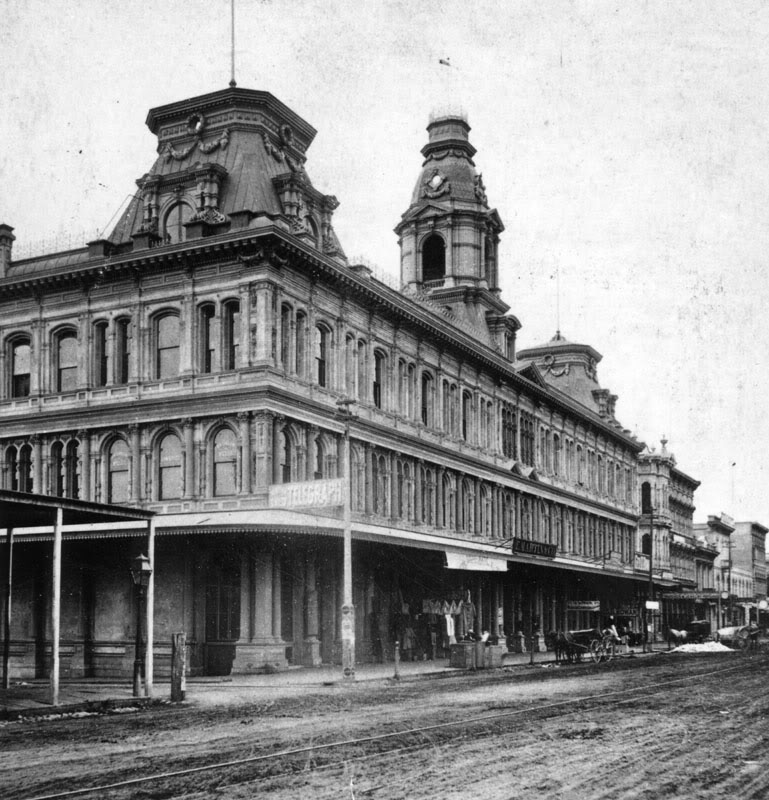 |
|
| (1880)^ - Southeast corner of Arcadia and Main Streets. The building with the three distinct towers is Baker Block. |
Historical Notes The ornate three-story Baker Block was constructed by Colonel Robert S. Baker on the corner of Arcadia and Main streets in 1878. It was built on the former site of the residence of Abel Stearns. Arcadia Street was dedicated in 1872. Arcadia Bandini, born in 1823, was the daughter of prominent ranchero Juan Bandini. She came to be regarded as one of the most beautiful belles of Los Angeles and was just 14 when she married 44-year-old Abel Stearns, who had come west from Massachusetts and acquired Southern California's largest land-cattle empire. Stearns built a home for his bride one block south of the Plaza--the community's central gathering area--and the house, called El Palacio, became the social hot spot. In 1858, Stearns constructed a two-story business block on Los Angeles Street nearby and called it Arcadia Block. The street was officially dedicated one year after Stearns' death in 1871. In 1874 Arcadia married Colonel Robert S. Baker (1826–1894), owner of Rancho San Vicente y Santa Monica, and they settled in Santa Monica. The famous Arcadia Hotel in old Santa Monica was also named after her. Click HERE to see the Arcadia Hotel in Early Views of Santa Monica. |
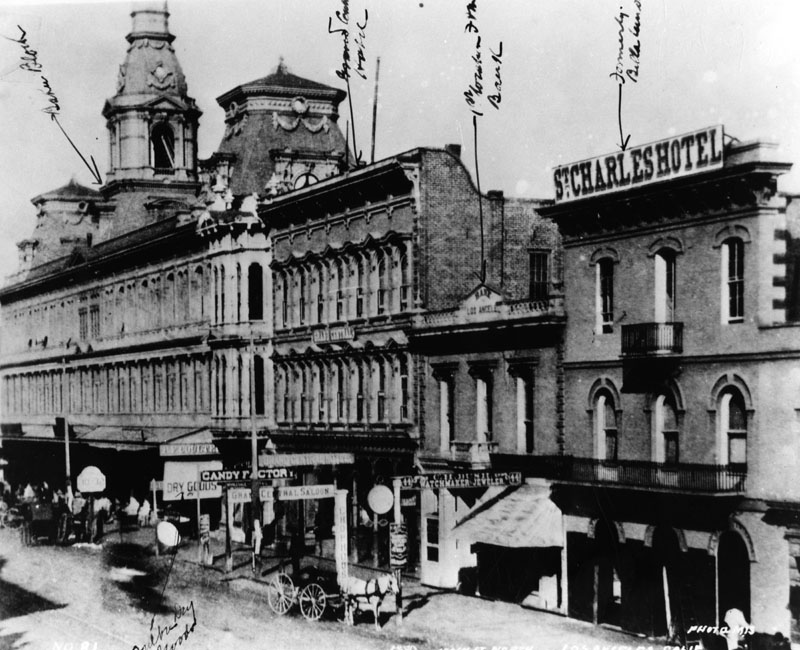 |
|
| (ca. 1880)^ - View of North Main Street. Baker Block is on the left and the St. Charles Hotel, formerly the Bella Union Hotel, is on the right. |
Historical Notes Constructed in 1835, the Bella Union Hotel (seen above after it became the St. Charles Hotel) has a long, rich history. It served as the County Courthouse until October 1851, and in 1860 was the location of a champagne fete celebrating the connection of San Francisco and Los Angeles by telegraph. |
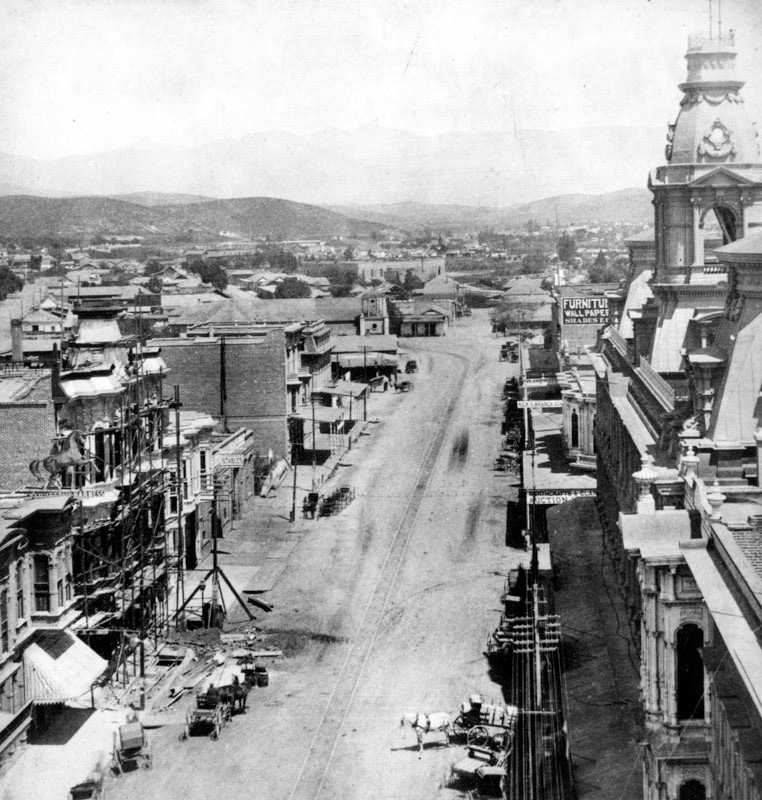 |
|
| (ca. 1880)^ - View looking north on Main Street from the Downey Building located just south of the Baker Block on the 300 block of N. Main Street. In the distance can be seen the Old Plaza Church where Main Street veers to the left. Telephone/telgraph lines can be seen on both sides of the street. |
Historical Notes Alexander Graham Bell invented the telephone in the late 1870's and it didn't take long for Los Angeles to adopt the new technology. In 1879, the Los Angeles Telephone Company was formed and it began offering telephone service in the area of what is now Downtown Los Angeles. This was just one year after the very first North America telephone exchange was installed in New Haven, Connecticut (January, 1878). The Los Angeles Telephone Company originally started with only seven subscribers. |
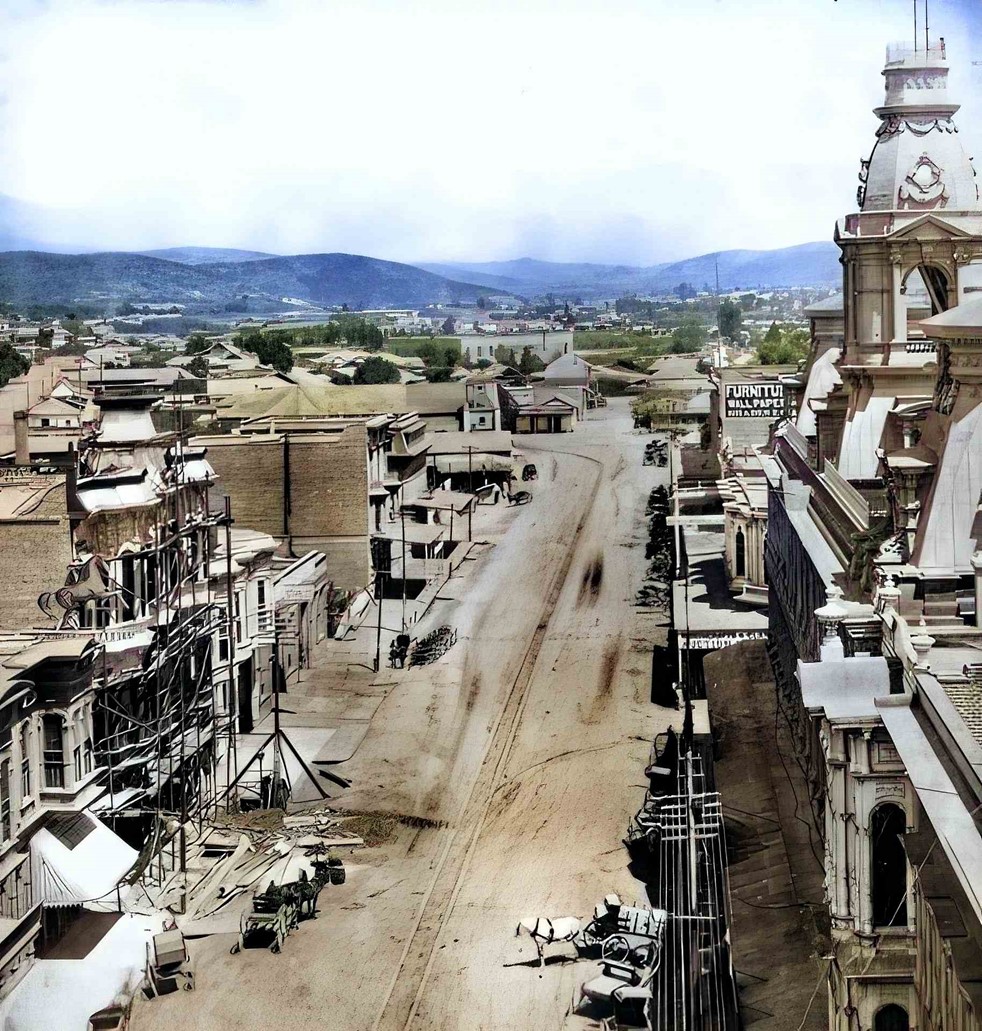 |
|
| (ca. 1880)^ - View looking north on Main Street from the Downey Building located just south of the Baker Block on the 300 block of N. Main Street. In the distance can be seen the Old Plaza Church where Main Street veers to the left. Telephone/telgraph lines can be seen on both sides of the street. (AI image enhancement and colorization by Richard Holoff) |
Then and Now
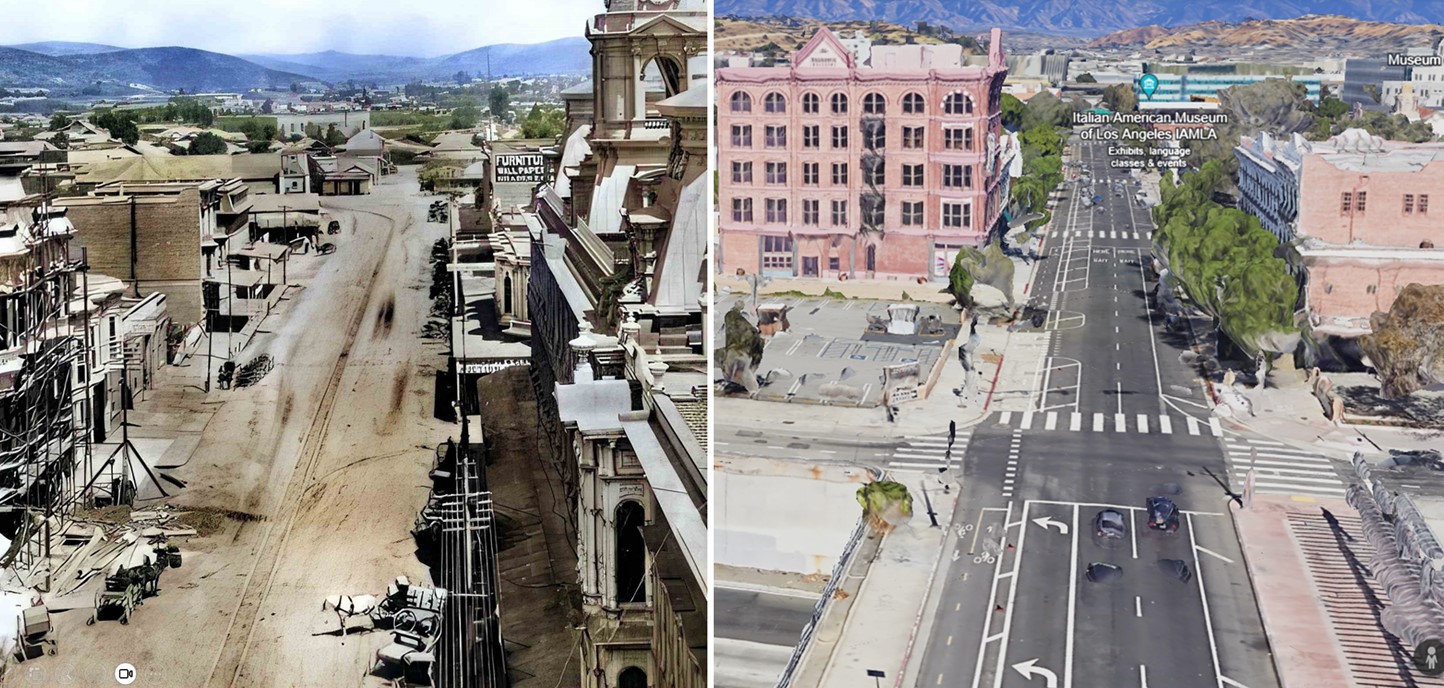 |
|
| (1880 vs 2022)* - Looking north on the 300 Block of Main Street. Photo comparison by Jack Feldman. |
 |
|
| (ca. 1881)* - Photograph of a view looking north along Main Street near the Los Angeles Plaza showing the Signoret Block. A three-story brick building stands in the left foreground along the unpaved street advertising "Russian Electric Baths" and features bay windows on the second floor as well as an overhang that shades the sidewalk in front of it. A second, similarly-constructed building stands farther in the background down the road and features gingerbread trim. Hills can be seen in the distance. Legible signs include: "Shaving 15¢", "Shampooing 25¢", "Hair Cutting 25¢", "Hair Work", "15 Russian Steam and Electric Baths", "Other Medicated Baths", and "Mrs. Huck's Dressmaker / Modes de Paris". |
Historical Notes Felix Signoret was born in France on June 9, 1825, living in Marseilles before he came to the United States. By trade he was a barber, later an apartment owner. He bought a parcel of land at 125 Aliso Street in 1871 and built a "substantial brick house" about thirty feet wide with an area of nearly 1,800 square feet; the roof was "hipped on all four sides in mimicry of the fashionable Mansard shape. . . . By 1888 the Signorets . . . were long gone, and their genteel house was used as a brothel." Signoret was elected to the Los Angeles Common Council, the governing body of the city, serving from May 9, 1863, to May 5, 1864. He was also a member of the Los Angeles County Board of Supervisors in 1866. He is also known for having led a lynch mob that hanged five people in Los Angeles in 1869–70 in the aftermath of a murder resulting from 'offensive remarks (made) about the newly organized French Benevolent Society.' In 1874, Signoret built a new hotel at Main and Turner streets, north of Arcadia Street and "opposite the Pico House," also with a Mansard pitch, which the Los Angeles Star said would be the first such roof in the city. |
 |
|
| (ca. 1880)* - Looking north on Main Street from top of the Downey Building located just south of the Baker Block showing the location of the Signoret Block, across the street fromthe Pico House. |
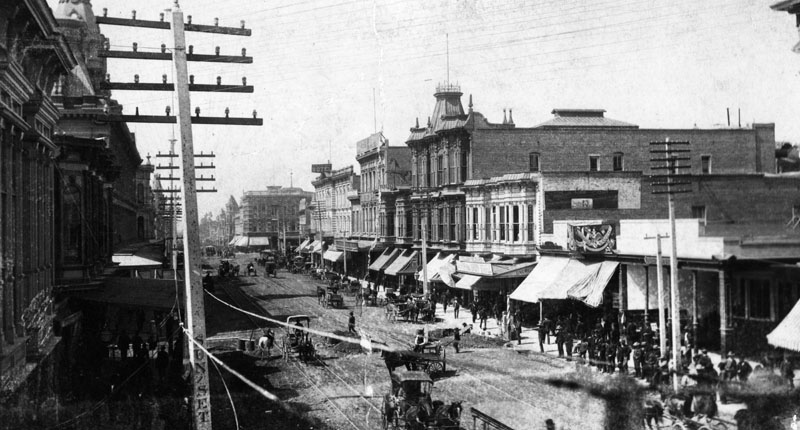 |
|
| (1880s)^ - View looking south on Main Street from near the Pico House. Temple Block can be seen in the distance. A large number of people are on the sidewalks and quite a few horse-drawn vehichles are on the street. The population in Los Angeles had grown to 11, 200 by now. Telegraph/Telephone poles and wires are seen on both sides of the street. The wording 'SUNSET' can be read on one side of the pole to the left. |
Historical Notes In 1883, The Los Angeles Telephone Company merged with another local telephone company based in Northern California, Sunset Telephone Company. In 1906, the Sunset Telephone Company was acquired by Pacific Telephone and Telegraph, later known as Pacific Bell. |
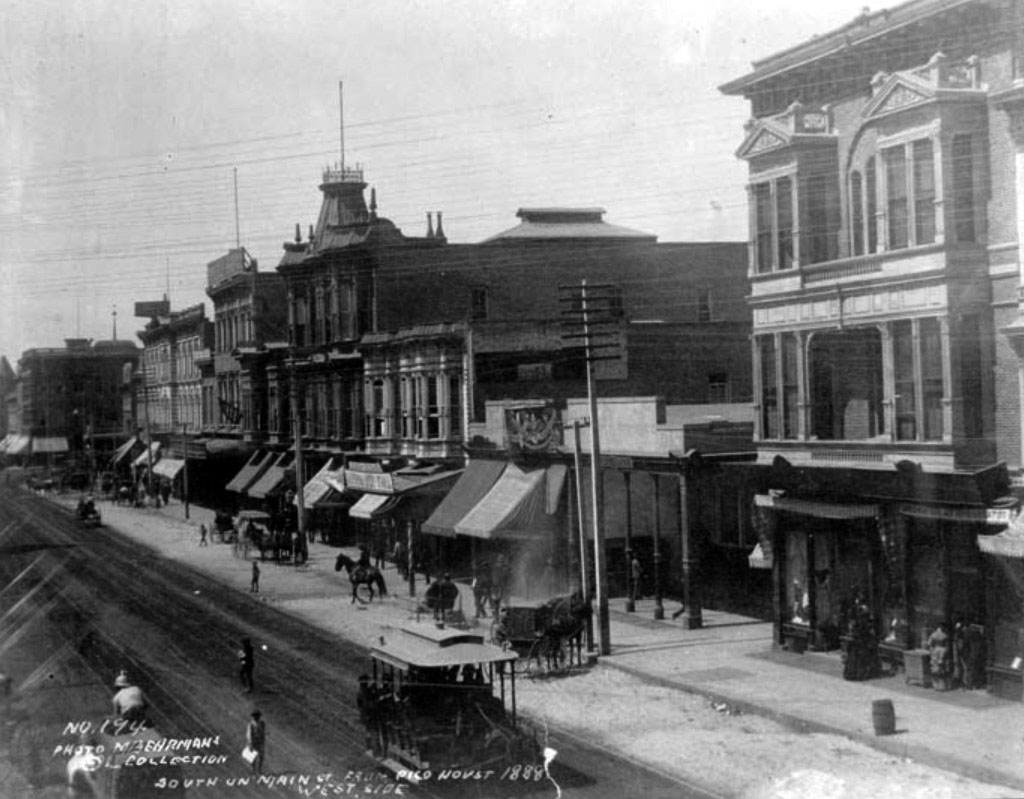 |
|
| (1888)* – View looking south, showing the west side of the 300 block of Main Street as seen from the Pico House. A horse-drawn streetcar shares the street with pedestrians, horse-drawn wagons, and a man on horseback (center-left). |
Historical Notes In the 1940s and 1950s, the historic buildings on the 300 block of North Main were demolished to extend Aliso Street from Los Angeles Street to Broadway. Several years later the Hollywood Freeway (Route 101) would be constructed over this new Aliso Street extension. Click HERE to see more in Early Views of the Historic 300 Block of N. Main Street. |
* * * * * |
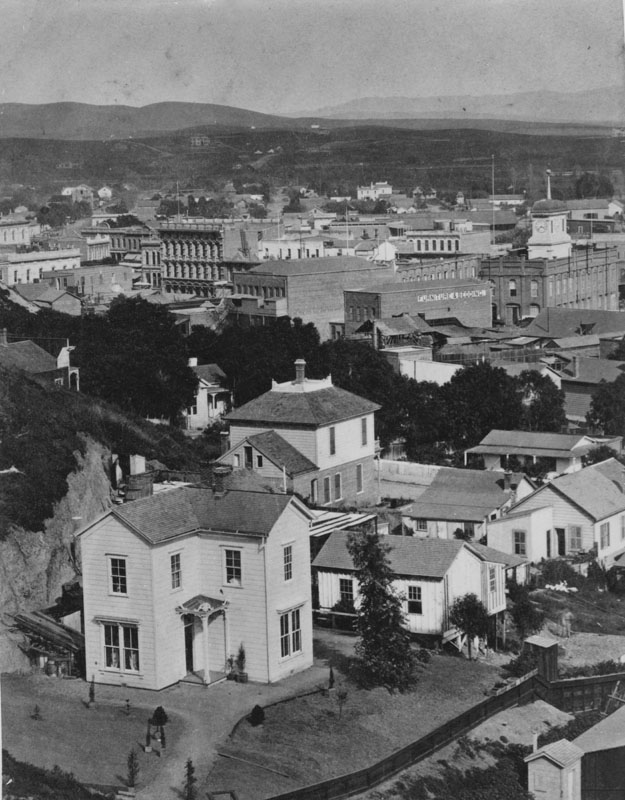 |
|
| (1880)^ - View of Los Angeles looking northeast from First Street. The old county courthouse with its distinctive clock tower can be seen at the upper right of photo. |
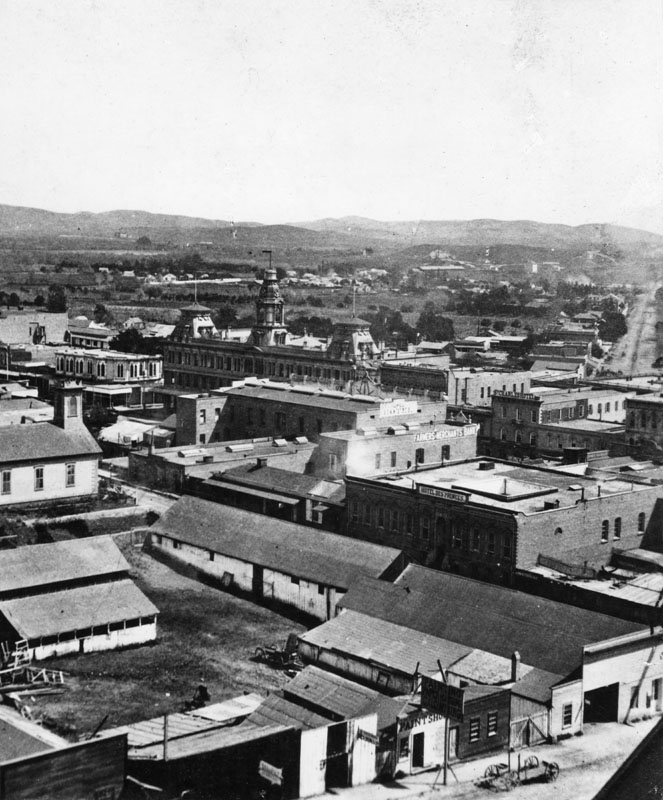 |
|
| (ca. 1880)^ - View looking NE as seen from Bunker Hill. Some of the identifiable buildings are the Hotel Des Princes, Farmers and Merchants Bank, the St. Charles Hotel (formerly the Bella Union Hotel), and the magnificent Baker Block, marked by towers and located along Main Street. Aliso Street can be seen running diagonally away from the camera at upper-right. |
Historical Notes The ornate three-story Baker Block was completed around 1877 by Colonel Robert S. Baker. For a number of years, the building housed offices, shops, and apartments. Goodwill Industries of Southern California purchased it in 1919. Despite plans to relocate the structure for another purpose, the city purchased the Baker Block from Goodwill in 1941 and demolished the building a year later. U.S. Route 101 now runs beneath where these buildings once stood.^ |
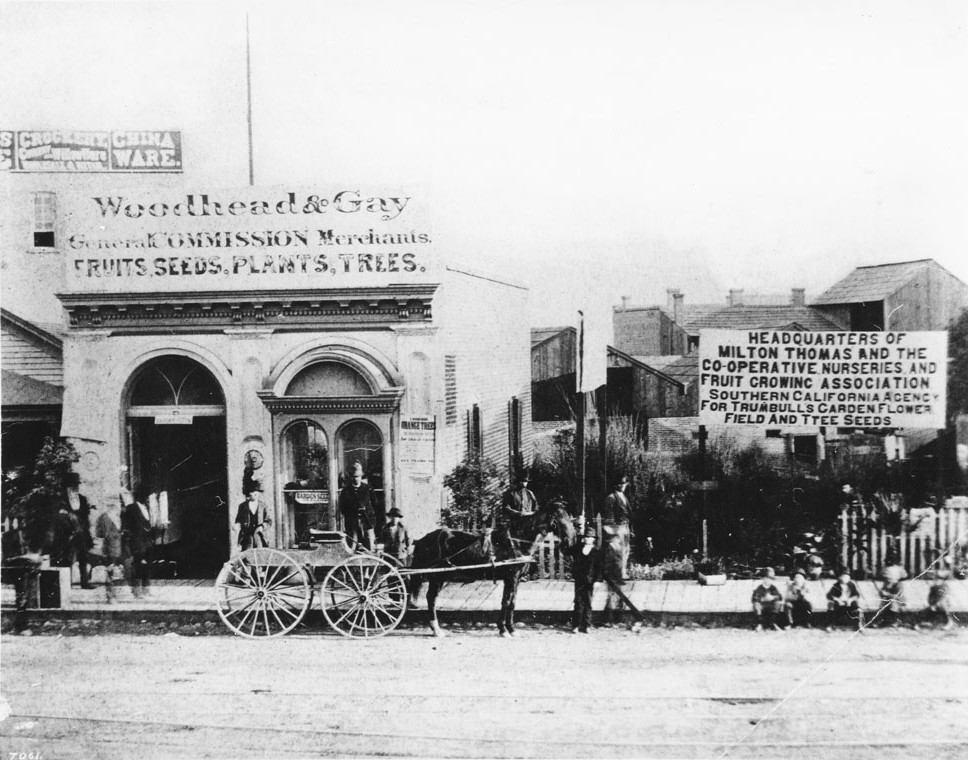 |
|
| (ca. 1880)^^ - View of people standing outside the Woodhead & Gay general store, headquarters for Milton Thomas Nurseries, Los Angeles. At center, a man tends a horse-drawn wagon while five children sit to his right on the wooden sidewalk. An overgrown lot to the right of Woodhead & Gay contains the sign for Milton Thomas which reads "Headquarters of Milton Thomas and the Co-operative Nurseries and Fruit Growing Association Southern California Agency for Trumbull's Garden Flower Field and Tree Seeds." |
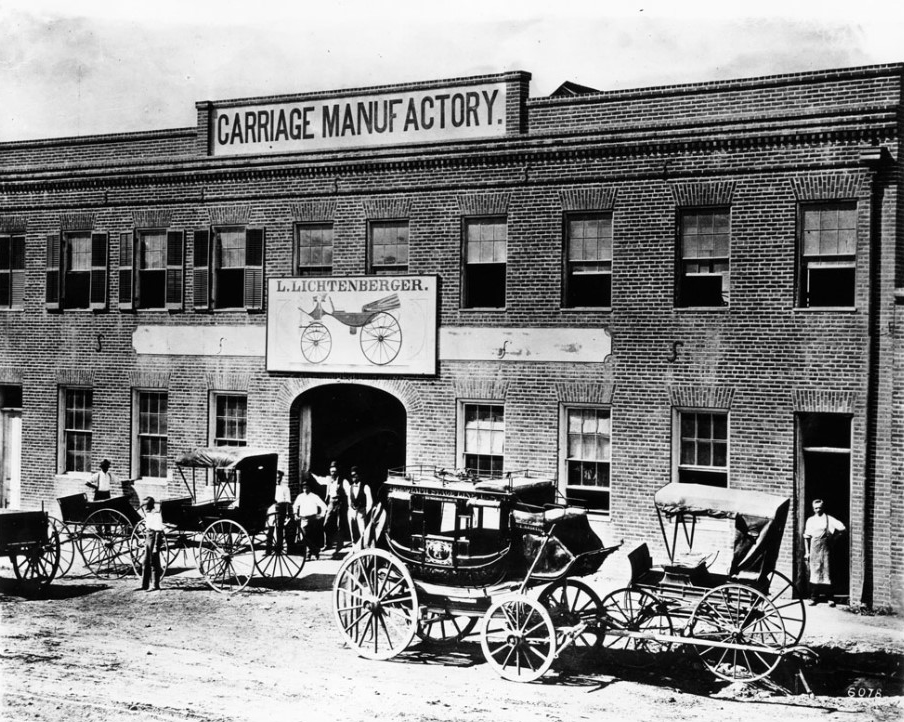 |
|
| (1880)^^ - Exterior view of L. Lichtenberger's carriage factory, Los Angeles, 1880. A picture of a carriage and the name L. Lichtenberger is displayed on a billboard-like sign centered in front the building between the first and second floors. At the roof, another displayed sign reads: "Carriage Manufactory". Several carriages are parked out front as a handful of workers pose nonchalantly in front of the building. |
Historical Notes As of 1880 the city of Los Angeles had one large carriage and wagon factory, owned by L. Lichtenberger, that had been in operation since 1864, producing up to 300 vehicles a year. There were also seven other smaller carriage/wagon producers. |
* * * * * |
Spring Street (1880s)
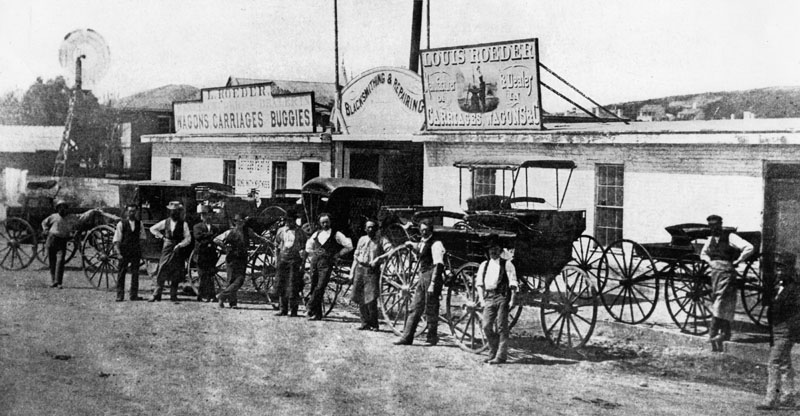 |
|
| (1880)* - Men and carriages in front of Louis Roeder’s wagon and carriage dealership near Spring and 2nd Street. The business was located at approximately 85 South Spring Street, just north of 2nd Street. |
Historical Notes By 1880, Spring Street was becoming one of the city’s main commercial corridors. Businesses like Louis Roeder’s wagon and carriage dealership supplied transportation for farmers, merchants, and families at a time when horses and wagons were still the primary way to move people and goods around Los Angeles. Shops like this helped connect the growing downtown with outlying ranches and settlements. |
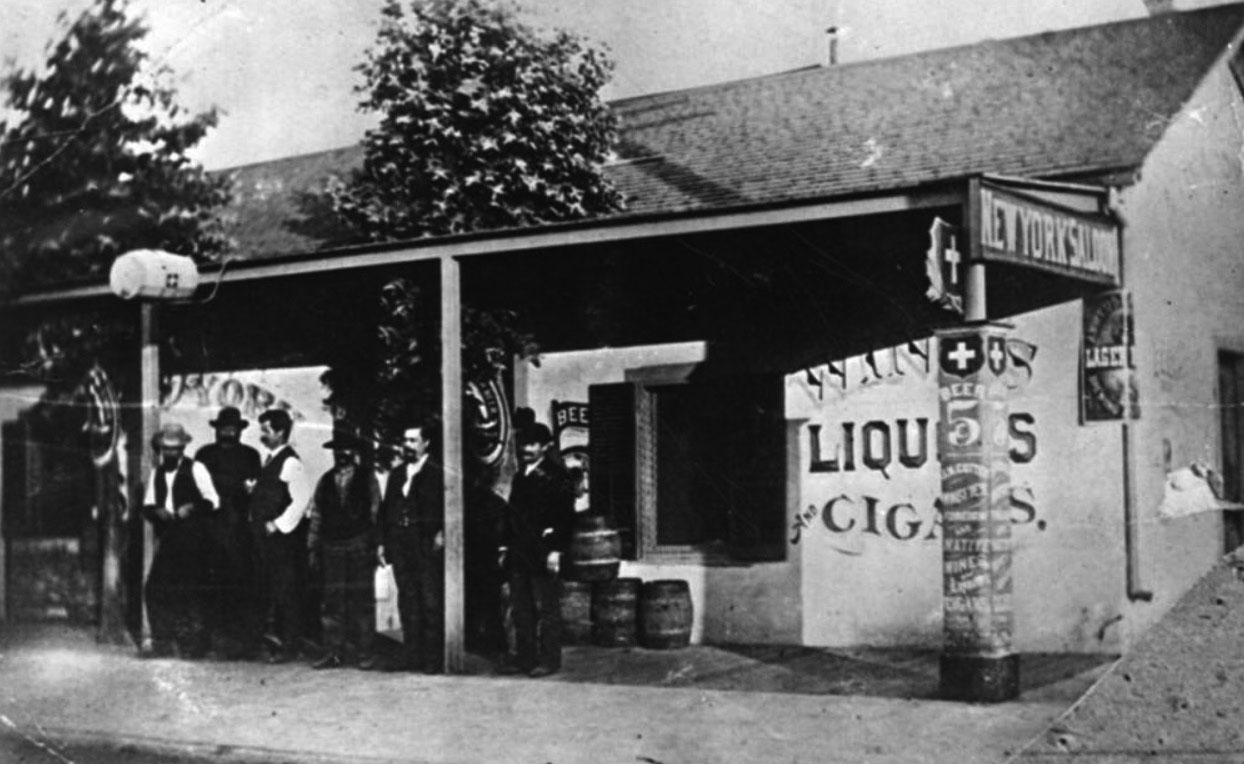 |
|
| (1881)* - View of the New York Saloon on the northeast corner of 3rd and Spring Streets, then addressed as 156 South Spring Street. A group of men stands out front while barrels are stacked along the wall. |
Historical Notes Saloons like the New York Saloon were everyday gathering places in early Los Angeles. They offered beer, wine, and spirits, but they also served as informal social hubs where men discussed business, politics, and neighborhood news. The New York Saloon was operated by Gustavus C. Perret, a Swiss immigrant, and ran from about 1881 to 1890. It stood directly across from the New York Brewery, which supplied its beer and operated from the mid-1870s into the 1890s. With nickel beer and simple food, this corner became one of downtown’s liveliest working-class hangouts. |
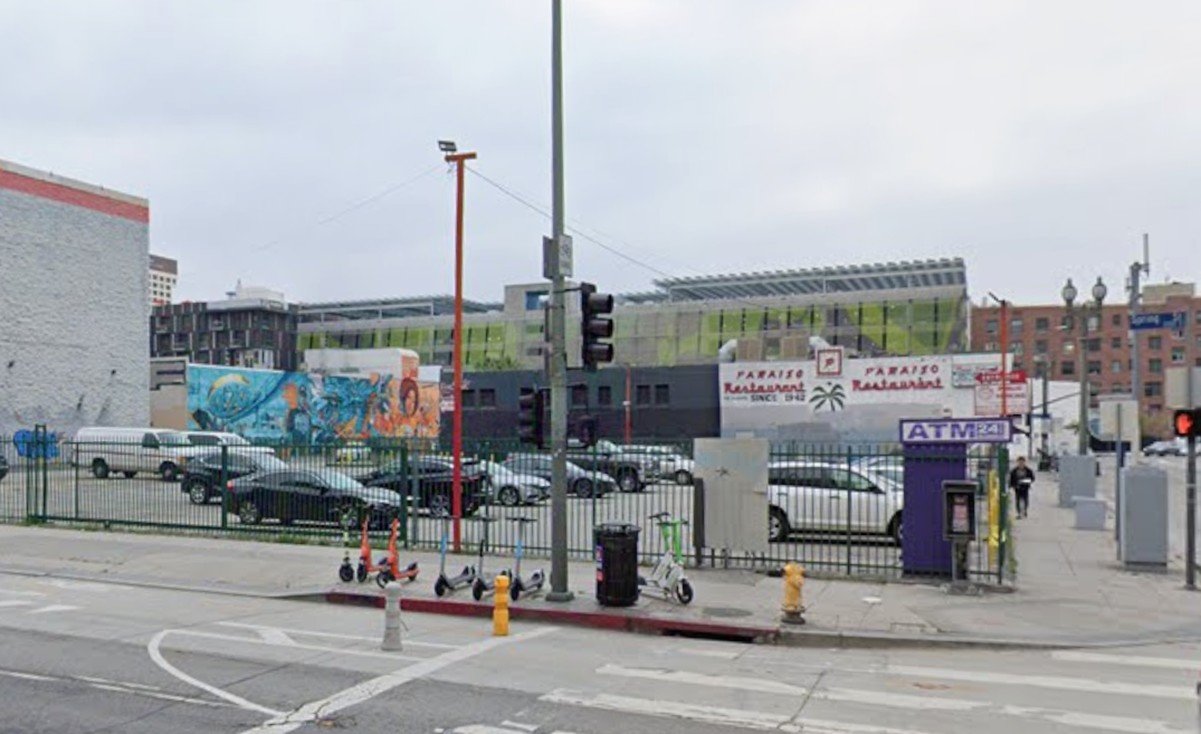 |
|
| (2024)* - Looking at the northeast corner of Spring and 3rd Streets, once the home of the New York Saloon, today the site of a parking lot and ATM machine. |
Historical Notes Before 1889, Los Angeles used an earlier street-numbering system, so addresses like 156 S. Spring Street do not match today’s numbers. The corner itself, however, is unchanged — the New York Saloon stood on this same northeast corner during the 1880s, even though the address was later renumbered. |
Then and Now
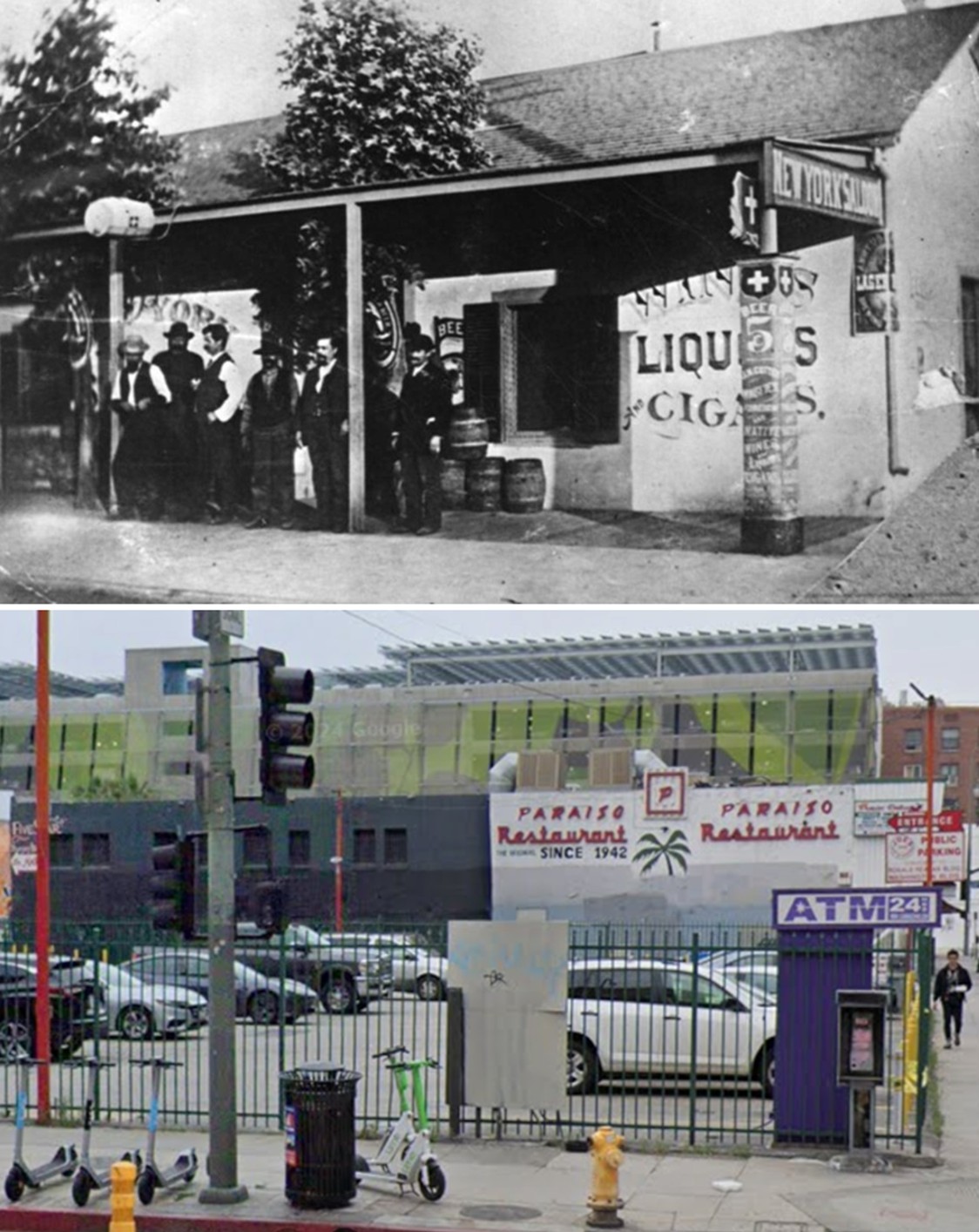 |
|
| (1881 vs. 2024)* - The northeast corner of Spring and 3rd Streets, once the site of the New York Saloon, today a parking lot. |
Historical Notes Although Los Angeles renumbered its streets in 1889, the physical location did not change. The New York Saloon occupied this very corner in the 1880s, when Spring Street was becoming one of the city’s busiest commercial and social corridors. |
 |
|
| (1880)* - Exterior view of Moody’s Variety Store on Spring Street between 1st and 2nd Streets. The shop served nearby hotels, boarding houses, and offices in the growing downtown district. |
Historical Notes Variety stores carried an assortment of goods that did not fit neatly into a single specialty. A customer might find stationery, small hardware, household items, toys, and personal accessories under one roof. Shops like Moody’s served nearby boarding houses and offices and helped make Spring Street a convenient place for downtown residents and workers to pick up everyday necessities. |
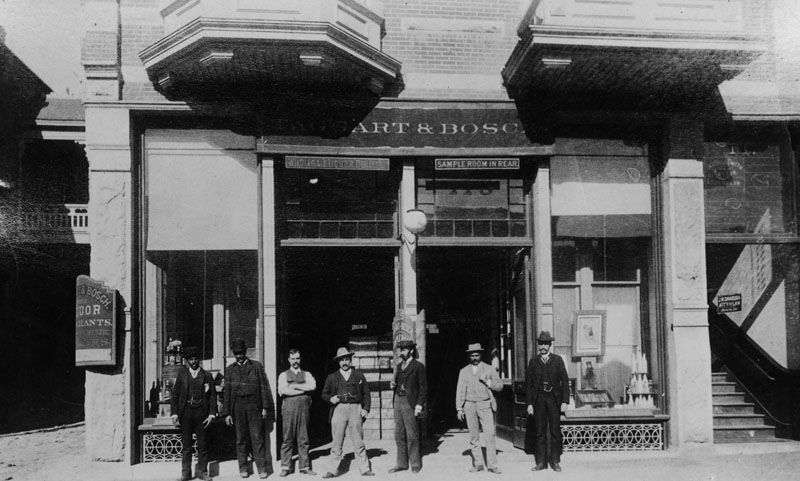 |
|
| (ca. 1880s)* - Exterior view of Laggart & Bosch, wholesale liquor dealers on New High Street between Temple and Franklin Streets. This stretch later became part of the north end of Spring Street. A sign advertises a sample room in the rear, next to the law office of J. M. Davidson. |
Historical Notes Wholesale liquor firms like Laggart & Bosch supplied saloons, hotels, and restaurants throughout the growing city. A sample room in the rear allowed buyers to taste products before placing orders. Businesses such as these, along with nearby law offices and other services, show how this part of Spring Street evolved into a mixed commercial district serving both the public and the trade. |
* * * * * |
New High Street (later Spring Street), north of Temple
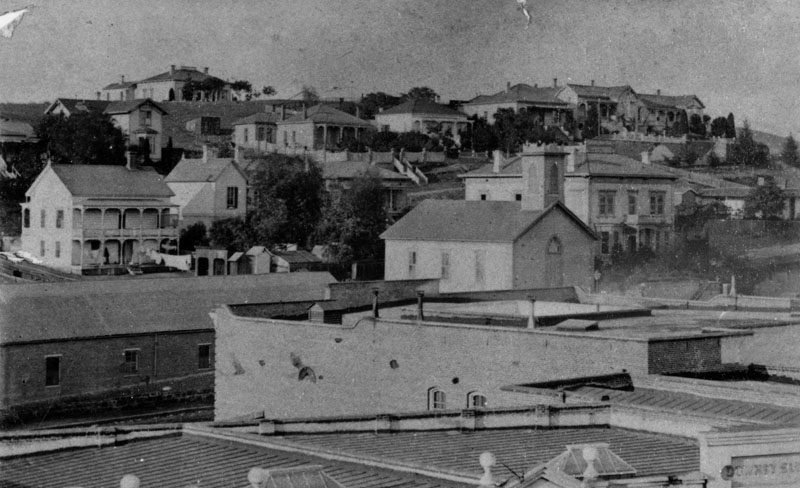 |
|
| (1880)* - New High Street (later Spring Street), north of Temple Street, with First Congregational Church and Kimball Mansion, where Helen Hunt Jackson stayed. |
Historical Notes Helen Maria Hunt Jackson (1830 – 1885) was a poet and writer who became an activist on behalf of improved treatment of Native Americans by the U.S. government. She detailed the adverse effects of government actions in her history A Century of Dishonor (1881). Her novel Ramona dramatized the federal government's mistreatment of Native Americans in Southern California and attracted considerable attention to her cause, although its popularity was based on its romantic and picturesque qualities rather than its political content. It was estimated to have been reprinted 300 times, and contributed to the growth of tourism in Southern California. |
.jpg) |
|
| (1880)^ - Another view of the First Congregational Church and Kimball Mansion on New High Street near Temple Street. Wagons and horses can be seen in the foreground next to a barn. |
Historical Notes The First Congregational Church building was dedicated on June 26, 1868 by the Rev. Alexander Parker and was used until 1883, when a new building was constructed at Third & Hill streets. Click HERE to see more early Views of the First Congregational Church (Oldest Continuous Protestant Church in Los Angeles). |
* * * * * |
Hill and 3rd Streets
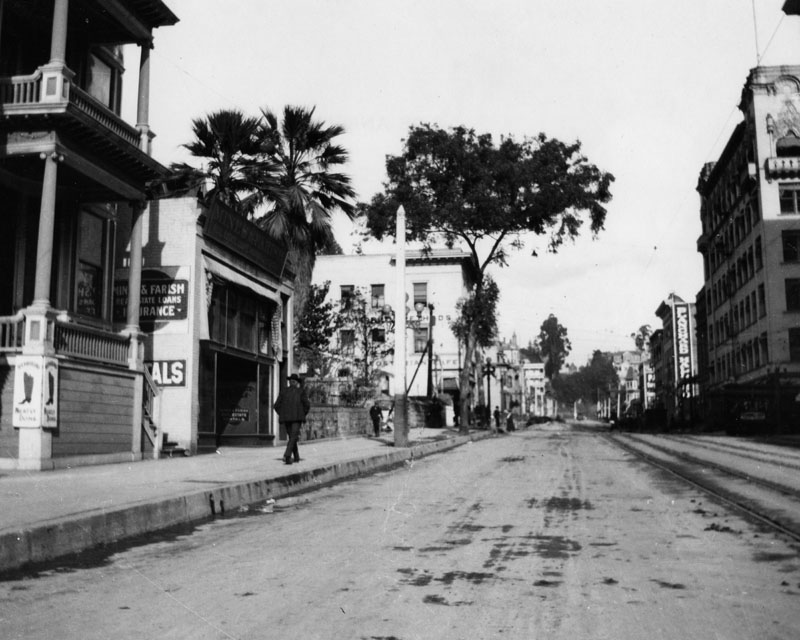 |
|
| (ca. 1880)* - View of Hill Street, looking north from 3rd. A man walks by the Mines & Farish real estate and insurance office. Palm trees at the side shade a bit of the office building. Although the street has electric railroad lines it is still unpaved |
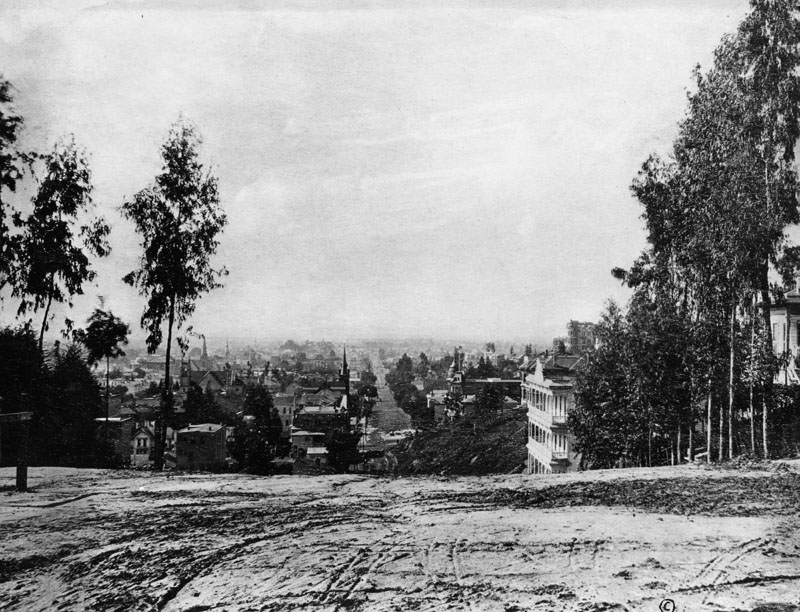 |
|
| (ca. 1880)^ - Hill Street looking south towards 3rd Street from Bunker Hill. In the middle of the photo is the First Congregational Church at 3rd and Hill streets. The spire to the left of the Congregational Church belongs to the German Methodist Church on 4th Street. |
Historical Notes Hill Street was originally laid out in 1849 by Edward Ord. At that time, the street's northern end was near 4th Street, the roadway being obstructed by its namesake, Bunker Hill. The northern section of the street was originally named Castelar Street, and several institutions along this end of the street still bear that name. |
* * * * * |
Hill and 2nd Streets
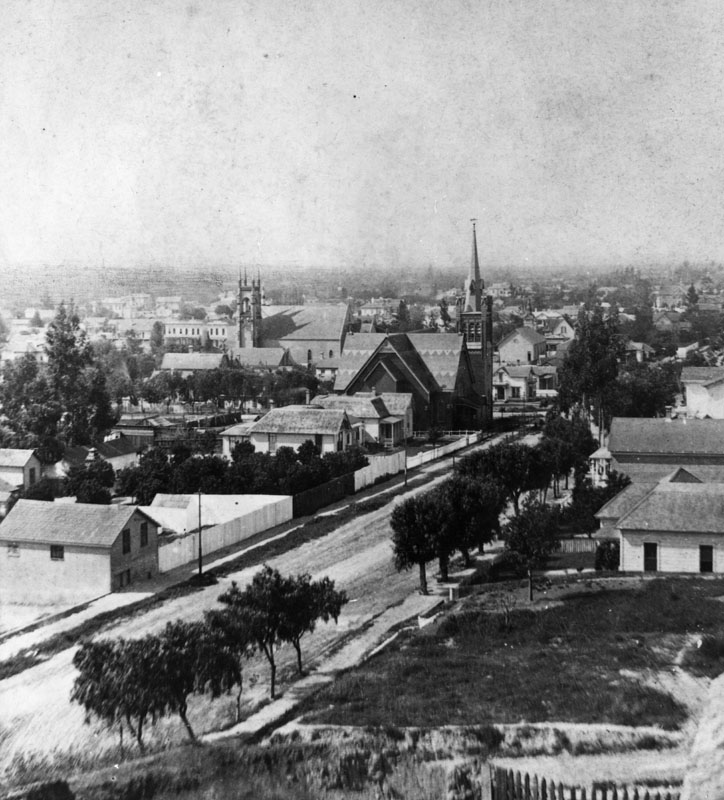 |
|
| (ca. 1880)^ - Hill Street looking south from 2nd in the early 1880s. Residential buildings are interspersed with churches and vacant lots. |
Historical Notes In the middle of the photo is the First Congregational Church at 3rd and Hill. It was built in 1883. Reverend A.J. Wells, the pastor at that time, sold it to Central Baptist Church for $40,000 in 1889. Unable to pay the full amount, $30,000 was eventually settled on. It was later sold to the Unitarian Church. To the left of the Congregational Church is the German Methodist Church on 4th St. |
* * * * * |
Broadway (Fort Street) and Temple
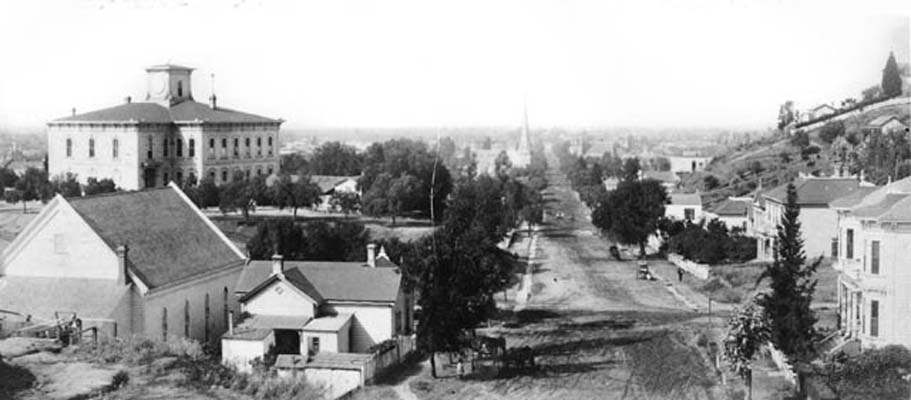 |
|
| (ca. 1881)* - Panoramic view looking south on Fort Street (later Broadway) near Temple Street. Los Angeles High School stands on Poundcake Hill, with the First Presbyterian Church visible in the distance. |
Historical Notes Construction of the school began in 1872 on the former site of Central School, the city’s first public elementary institution. When the new four-room building opened in 1873, it housed both the elementary program and the newly created Los Angeles High School. Two classrooms served Central School, and two were set aside for high school students. This shared arrangement led to later confusion about the name of the building, but the high school quickly became the dominant identity of the campus. The hilltop location on Poundcake Hill made the school one of the most prominent landmarks in early Los Angeles. The surrounding area was still lightly developed, with scattered houses, open land, and a few churches such as the First Presbyterian Church at Fort and 2nd Streets. This photograph captures a moment when Los Angeles was just beginning to expand north and west into today’s downtown. |
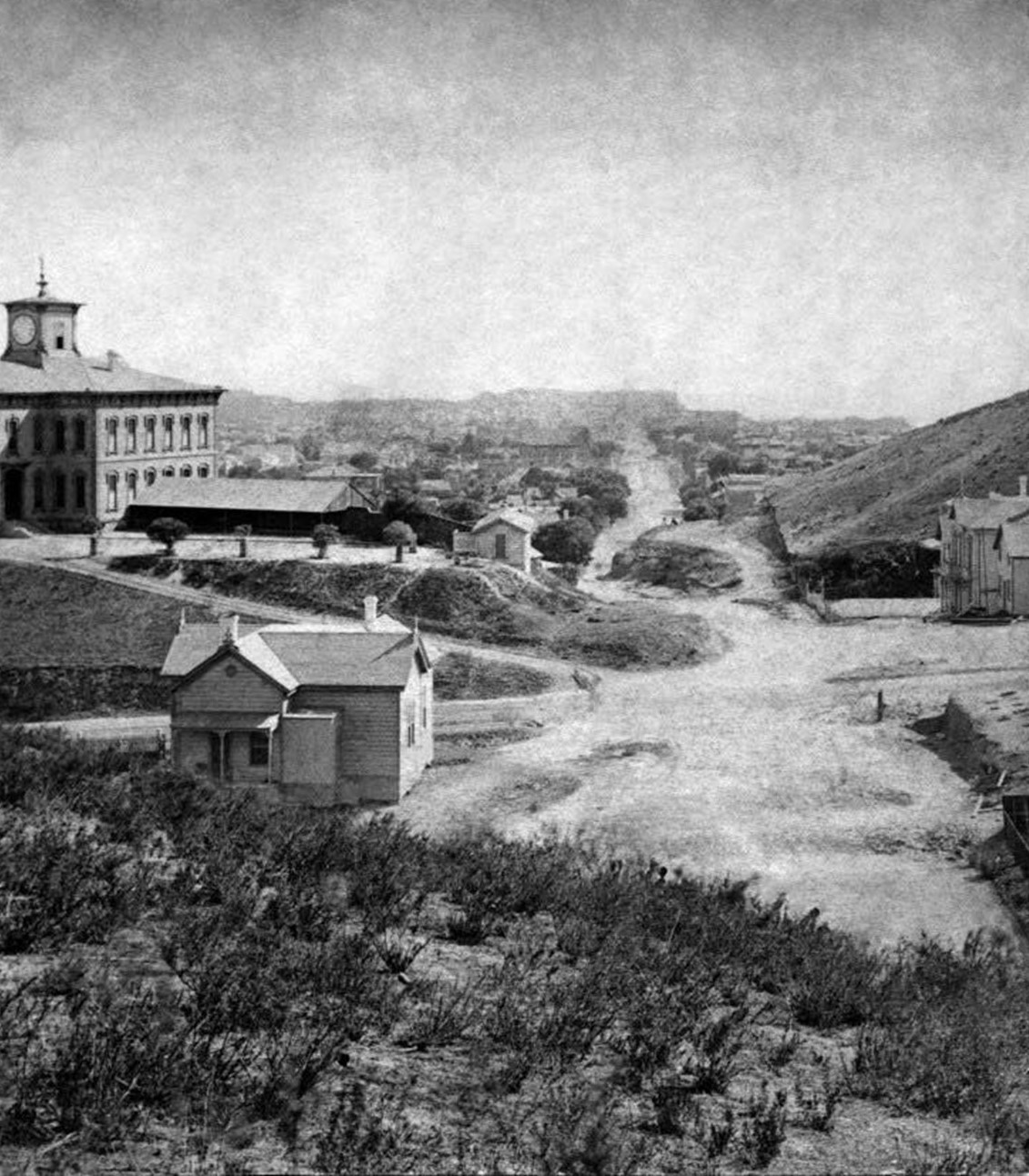 |
|
| (ca. 1875)* - Looking south on Fort Street (now Broadway) from Fort Moore Hill. Los Angeles High School stands at the crest of Poundcake Hill at Temple Street. (Henry T. Payne stereographic photograph.) |
Historical Notes When this image was taken, the new school building was only two years old. It sat at the southeast corner of Fort and Temple Streets on the site formerly occupied by Central School. Because the structure served both elementary and high school students, people often referred to it by either name. Over time, Los Angeles High School became the familiar title, especially as the city placed more emphasis on secondary education. Fort Street remained mostly rural in 1875, with few structures beyond the school building itself. Within ten years, downtown’s rapid growth led the city to choose Poundcake Hill as the site for the new county courthouse. The entire school building was then moved off the hill in 1886, ending its short but important role as the city’s first dedicated high school site. |
Before and After
 |
|
| (1875 vs. 1881)* – Looking south on Fort Street (renamed Broadway in 1890) toward Temple Street from Fort Moore Hill. The 1881 view shows the spire of the First Presbyterian Church at Fort and 2nd Streets. Photo comparison by Jack Feldman. |
Historical Notes These two views show how quickly the area changed during the late 1800s. In 1875, Los Angeles High School, originally built for both elementary and secondary grades, stood largely alone at the top of Poundcake Hill. Only a few homes and businesses occupied the surrounding blocks. By 1881, more homes, trees, and churches had begun to fill the landscape, signaling the shift from a small town to an emerging city. Fort Street would soon be renamed Broadway and developed into one of Los Angeles’s main commercial corridors. The First Presbyterian Church, visible in the later view, reflects the spread of civic and religious institutions as the population grew. |
Click HERE to see more Early Views of Los Angeles High School |
* * * * * |
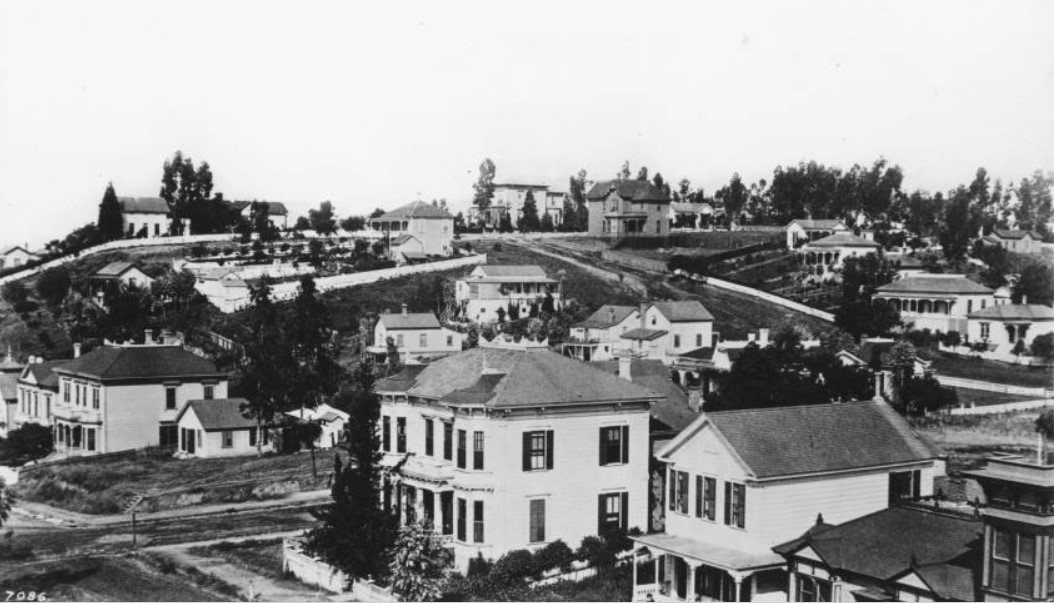 |
|
| (ca. 1880)^^ - Panoramic view looking southwest of the residential area surrounding Broadway, Temple Street and Hill Street. Two-story victorian-style houses fill the frame, situated on top of or at the foot of the hill in the background on which several of the roads converge. The houses are interspersed with trees. |
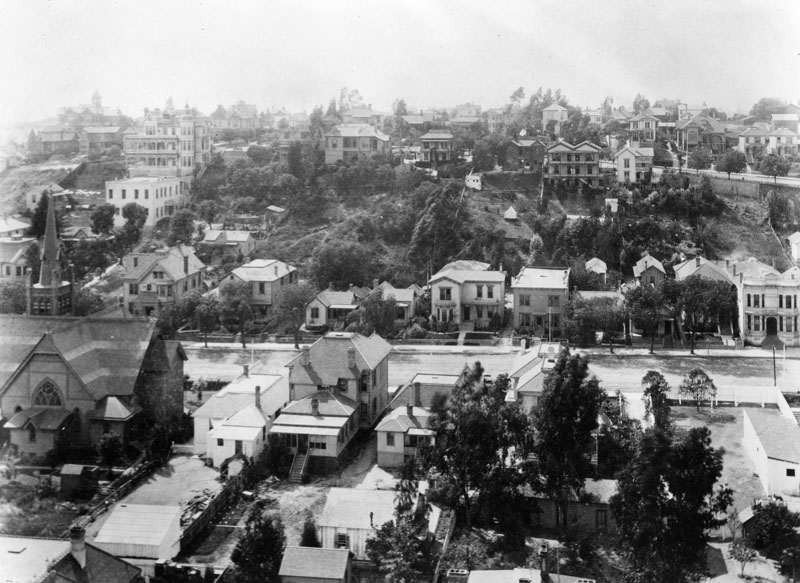 |
|
| (1885)^ - Looking west towards Bunker Hill as it appeared in 1885. Hill Street runs through the center, with 3rd Street (not shown) to the left of the First Congregational Church (left) which later became the Central Baptist Church and then the Unitarian Church. |
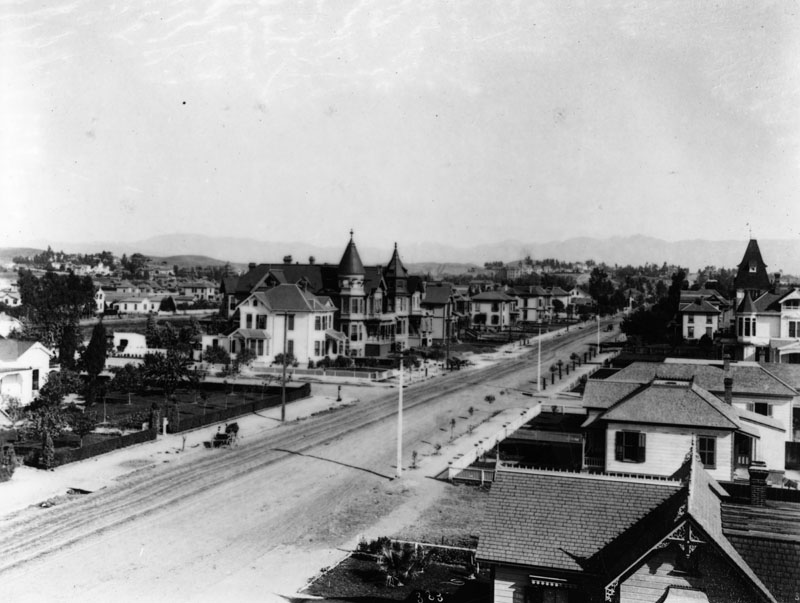 |
|
| (1880s)^ - An unpaved Olive Street, looking north from approximately 7th or 8th Street in a time when it was a residential area. Bunker Hill and the San Gabriel Mountains can be seen in the distance. Horse-drawn vehicles are also visible. |
.jpg) |
|
| (ca. 1881)^^ - Photograph of a lithograph by E.S. Glover depicting the left panel of a panoramic view of Los Angeles, looking southeast. |
.jpg) |
|
| (ca. 1881)^^ - Photograph of a lithograph by E.S. Glover depicting the right panel of a panoramic view of Los Angeles, looking southwest. |
Historical Notes A sweeping view of the city is shown above, with more hilly, rural land visible in the foreground. At the center foreground, a windmill is pictured, just to the left of a circle of trees. Farther right, the silhouettes of two purveyors can be seen atop the swell of one of the hills. Major streets such as Temple Street, Alameda Street and Main Street are labeled. An earlier record reads "Panoramic view of Los Angeles from hill back of Sisters Hospital on Sunset Boulevard”. |
* * * * * |
From La Plaza Abaja to Pershing Square
Early Views of L.A.’s Oldest Public Park
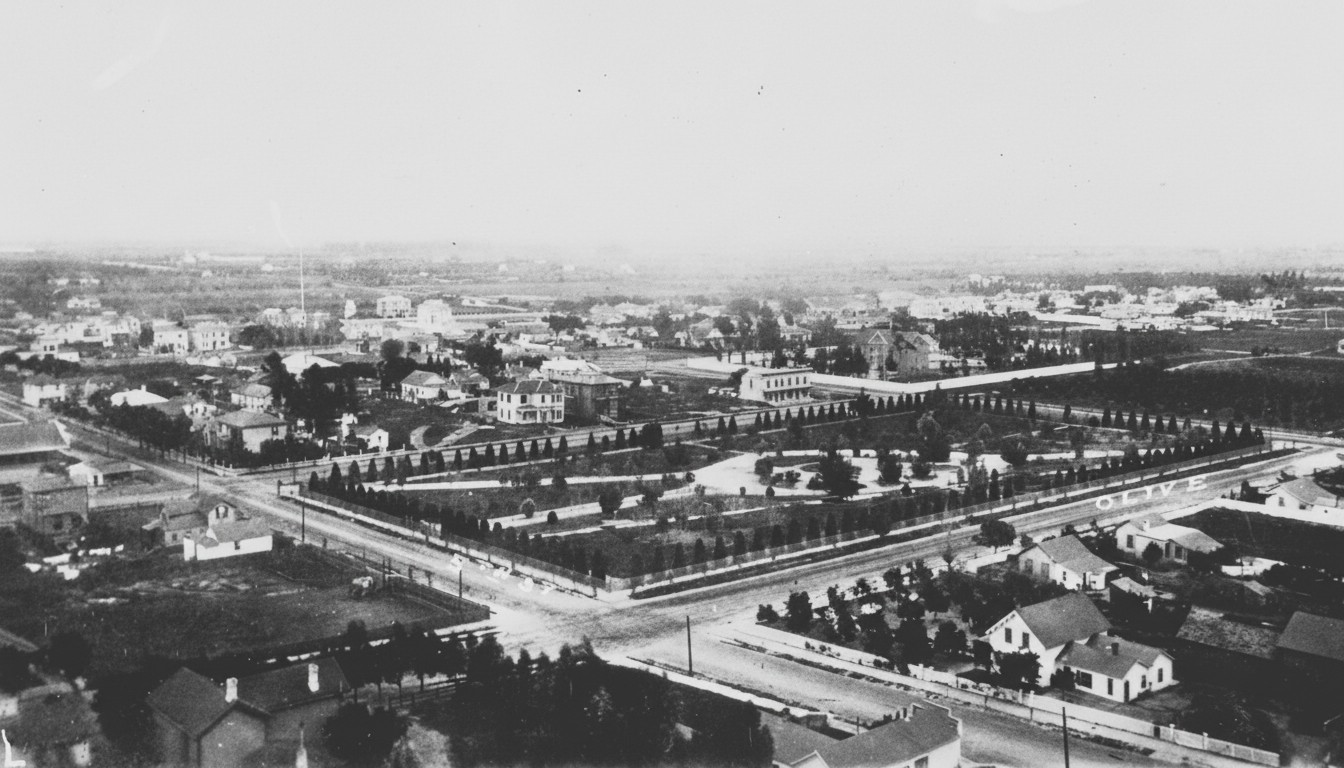 |
|
| (ca. 1880)* - Panoramic view showing Los Angeles City Park (later Pershing Square) from Fifth Street and Olive Street, downtown Los Angeles. A rectangular-shaped park can be seen at center surrounded with trees. Pathways can be seen in the park amongst grass lawns. Dirt roads line each side of the park, while one- to two-story residential buildings are visible around the park. Most of the buildings have yards and trees nearby. The flat land in the background is mostly devoid of buildings. |
Historical Notes The land that became Pershing Square was part of the original pueblo grant from Spain in 1781. In the 1850s it was still on the edge of town and was used as a camp by settlers who were living outside the older Plaza area around the church and Olvera Street. Surveyors drew it as ten separate lots, but in practice it functioned as a single five acre open space, with a small watercourse called Arroyo de los Reyes and canals from the Zanja Madre running nearby. In 1866, Mayor Cristobal Aguilar formally dedicated the block as a public square called La Plaza Abaja, or “The Lower Plaza.” A nearby beer garden owner, George “Roundhouse” Lehman, planted cypress, fruit trees, and flowering shrubs here and cared for them for many years, helping turn the dusty block into a green refuge in what was still a small, semi-rural town. |
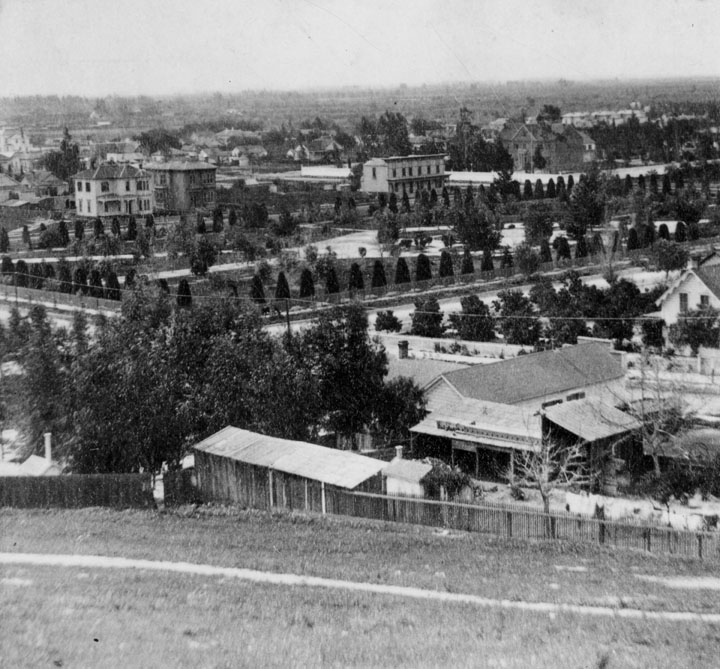 |
|
| (ca. 1880)^ - Close-up view of City Park (now Pershing Square) taken from Bunker Hill, looking southeast. |
Historical Notes By the early 1880s the former La Plaza Abaja was more commonly known as Los Angeles City Park. The paths, lawns, and young trees visible in this view show how the block had begun to function as a true town square, providing shade, open space, and a social gathering place for nearby residents. The park sat a short walk from the original business district along Main and Spring Streets, so it quickly became a favorite spot for leisurely walks and informal meetings. Its location between the older Plaza area to the northeast and the new commercial growth to the south made it a bridge between different phases of the city’s development. |
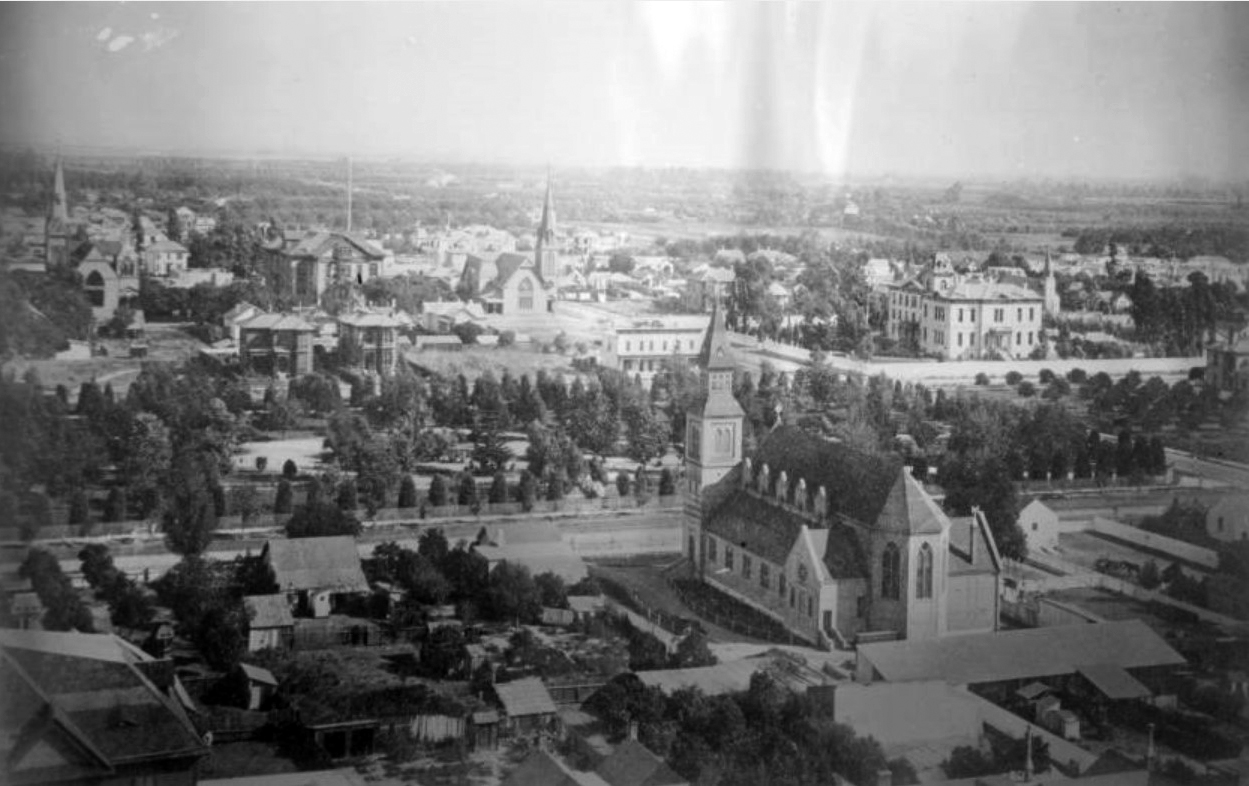 |
|
| (ca. 1883)* - View looking southeast from the State Normal School (current location of Central Library) showing St. Paul's Pro-Cathedral (lower-right) with Los Angeles Park (now Pershing Square) across the street. |
Historical Notes By 1883, the block had been officially renamed Los Angeles Park, but it was already acquiring several informal names tied to nearby institutions. The State Normal School opened in the early 1880s to train teachers for California’s growing public school system. At the same time, St. Paul’s, a new Episcopal church on Olive Street, gave the southeast corner a strong religious presence. Together, the park, the Normal School, and the nearby churches helped make this part of town a cultural and educational center. The park served not only as a place for recreation, but also as a front yard for lectures, religious events, and public ceremonies that reflected the city’s ambitions to be more than a frontier outpost. |
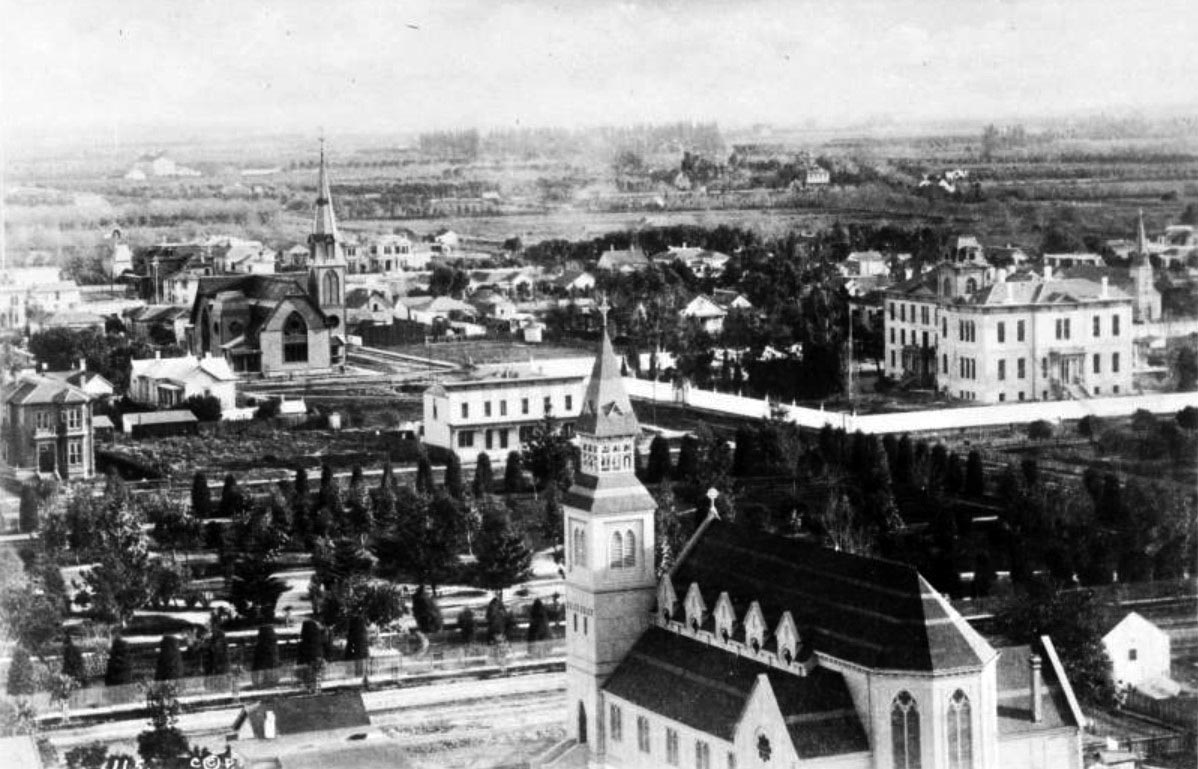 |
|
| (ca. 1883)* - Closer view of Los Angeles City Park (now Pershing Square) looking southeast as seen from the State Normal School showing the newly built St. Paul's Pro-Cathedral (lower-right) at the present site of the Biltmore Hotel. The multi-story building on the right is St. Vincent's College located on Hill Street between 6th and 7th Streets. |
Historical Notes In this closer view, Los Angeles Park is framed by two important educational and religious institutions. St. Paul’s Pro-Cathedral, completed in 1883 on Olive Street, soon became a leading Episcopal church and later the pro-cathedral for the diocese. Across the way, St. Vincent’s College, founded by the Vincentian Fathers in the 1860s, was the first college in Southern California. Because of St. Vincent’s presence, the park was often called St. Vincent’s Park in everyday speech. The mix of a college, a major church, and a central green space gave this block an importance out of proportion to its size. It became a place where students, clergy, professionals, and families all crossed paths, reflecting the growing social diversity of downtown Los Angeles. |
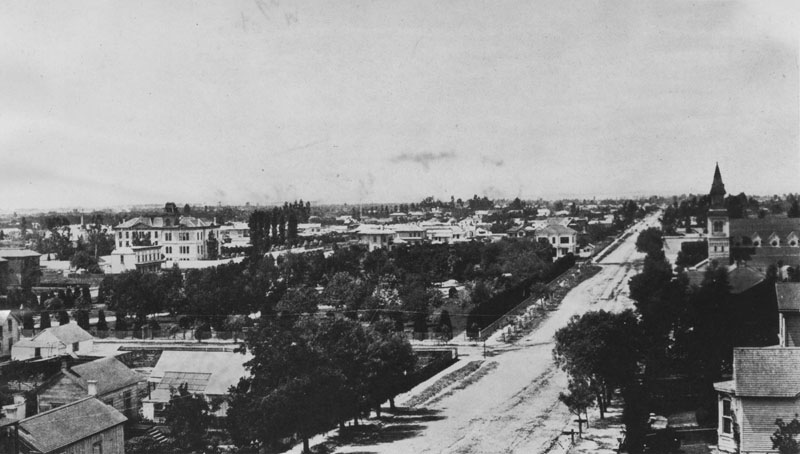 |
|
| (ca. 1880s)^ -View looking south on Olive from between 4th and 5th Streets, with St. Paul’s Pro-Cathedral, St. Vincent’s College, and Central Park. |
Historical Notes By the mid 1880s, this stretch of Olive Street had become one of the city’s best known cultural corridors. St. Paul’s Pro-Cathedral on the right offered regular services, special events, and diocesan functions. On the left, the older St. Vincent’s College building still stood, later serving as temporary quarters for the YMCA. Between them lay the evolving city park, which would soon be renamed Central Park. The unpaved street, horse drawn vehicles, and modest two and three story buildings show how early the city still was in its development. Yet the presence of churches, schools, and a central green square pointed toward the more dense and urban downtown that would emerge in the next few decades. |
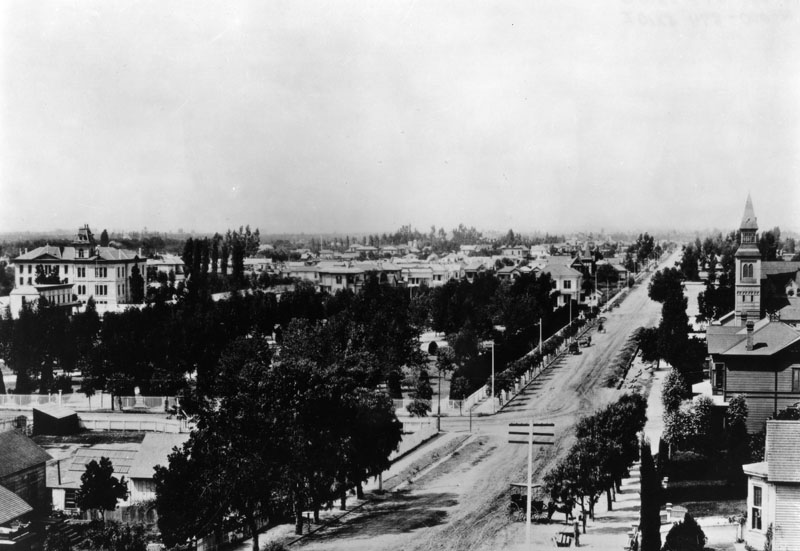 |
|
| (ca. 1885)^ - Panoramic view of 5th and Olive Streets, looking south in the early 1880s. Central Park (later Pershing Square) is seen with St. Paul’s Pro-Cathedral and St. Vincent’s College. Same view as previous photo but a couple of years later (note the addition of telephone poles along Olive Street). |
Historical Notes In this view, Central Park is beginning to take on the character that made it one of the city’s favorite gathering places in the late nineteenth century. Frederick Eaton, who later became mayor, created one of the first formal landscape plans for the park in the 1880s. The result was a more structured layout with paths, plantings, and shaded areas that invited longer visits and regular use. The dirt streets and horse drawn traffic still recall an older, slower Los Angeles, but telephone poles are now visible along Olive Street, hinting at new technologies and a city increasingly tied into regional and national networks. The combination of a refined park, nearby schools and churches, and emerging infrastructure made this corner an early symbol of the city’s modernization. |
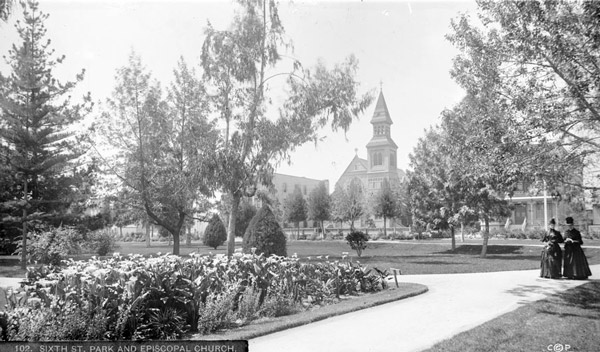 |
|
| (ca. 1888)^^ - View of two women walking along a walkway in Sixth Street Park (formerly St. Vincent’s Park). Today, this is the site of Pershing Square. |
Historical Notes By the late 1880s the park had been renamed Sixth Street Park, reflecting its location between 5th and 6th Streets. The lawns, flower beds, and well kept paths made it a popular place for quiet walks, especially for residents who lived in the surrounding houses and boarding hotels. Women, children, and older residents often used the park during the day, while bands, public speakers, and social groups sometimes gathered there in the evenings. This scene of two women strolling along a path gives a sense of how the park functioned as a safe public space in the heart of a growing downtown, long before the arrival of skyscrapers, cars, and concrete paving. |
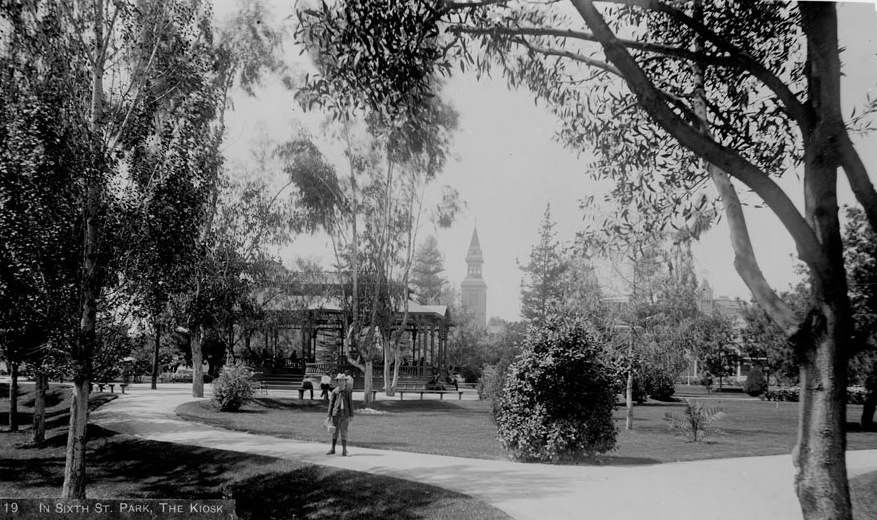 |
|
| (ca. 1890)^^ - View of Pershing Square, then called Sixth Street Park. Later it would be called Central Park and then Pershing Square (post World War I). |
Historical Notes Around 1890, the park was still officially called Sixth Street Park, but it was already on its way to being known as Central Park. New landscaping during this period added more lush, almost subtropical plantings, and a bandstand pavilion was introduced to host concerts, speeches, and civic events. As Los Angeles expanded, the park became a kind of outdoor living room for downtown, a place where people could hear music, meet friends, listen to orators, or simply escape the dust and heat of nearby streets. This role as a public stage would continue well into the twentieth century, even after the park’s name was officially changed to Pershing Square in 1918 in honor of General John J. Pershing. The following is a chronology of name changes the park has seen before becoming Pershing Square: ◆ 1866 – La Plaza Abaja or "The Lower Plaza" ◆ 1867 – St. Vincent Park ◆ 1870 – Los Angeles Park ◆ 1886 – 6th Street Park ◆ 1890s- Central Park ◆ 1918 – Pershing Square |
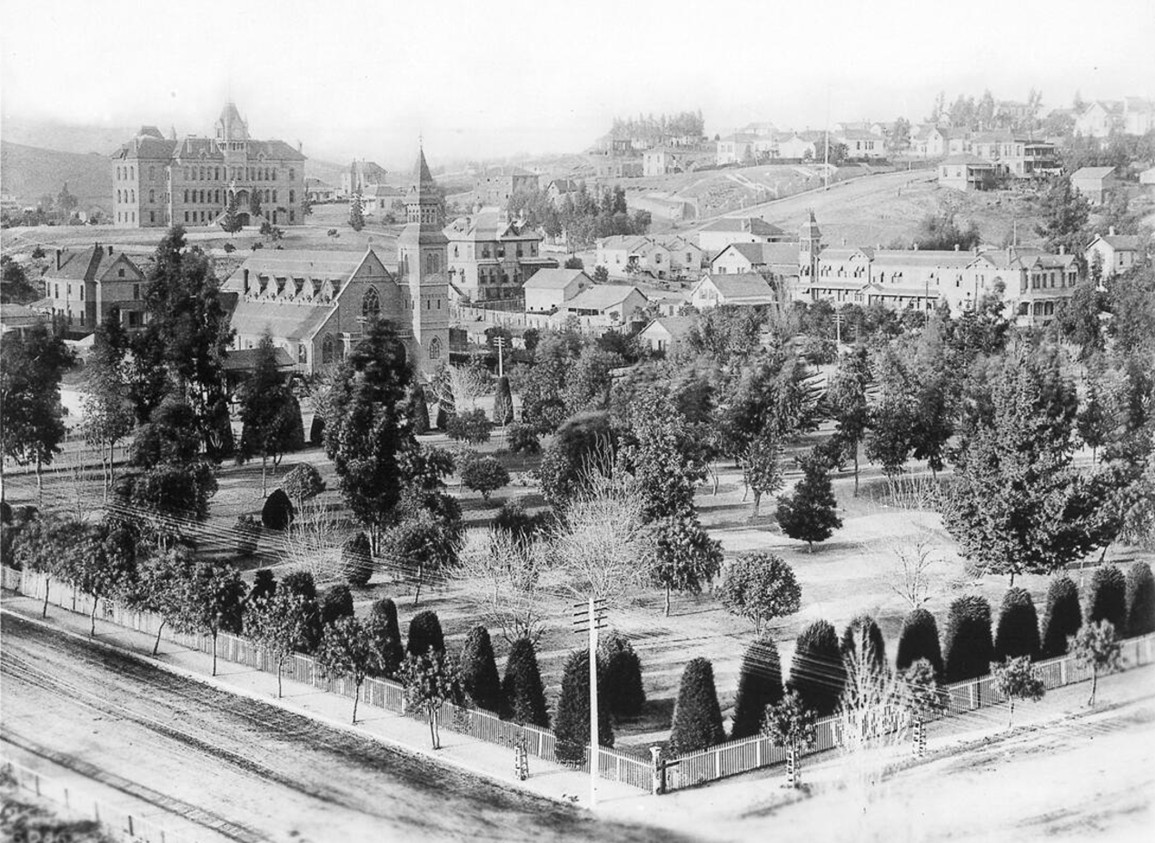 |
|
| (ca. 1885)* - View of Sixth Street Park, looking northwest from 6th Street and Hill Street toward St. Paul's Pro-Cathedral on Olive Street. The State Normal School can be seen on a hill in the distance, located on the southwest corner of Grand and 5th Street. The slopes of Bunker Hill are on the right. |
Historical Notes This photograph captures Sixth Street Park at a moment when the surrounding district was becoming one of the city’s main educational and cultural hubs. The State Normal School at 5th and Grand trained teachers for public schools across Southern California, while St. Paul’s Pro-Cathedral hosted diocesan functions and large religious gatherings. The park itself offered open space for students, churchgoers, and nearby residents. The rough slopes of Bunker Hill in the background had not yet been fully built up, but would soon be lined with the Victorian houses and apartment buildings that later became famous in photographs of old Los Angeles. |
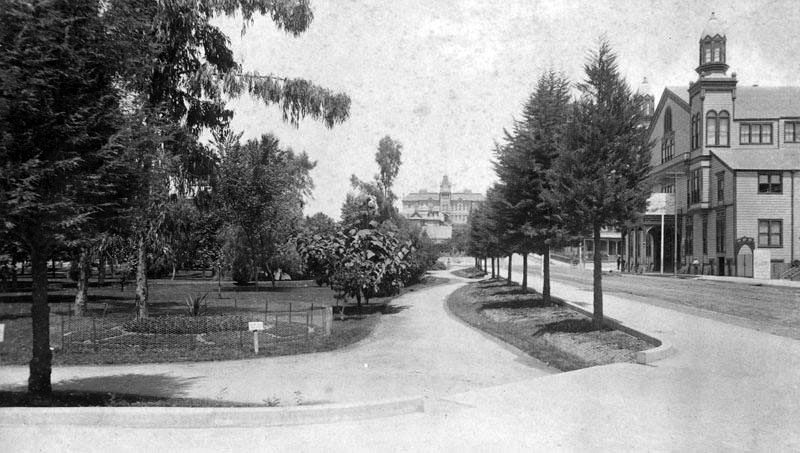 |
|
| (ca. 1890)* – Looking west on 5th Street at Hill Street. On the left is 6th Street Park (now Pershing Square). In the distance is the State Normal School. On the right is Hazard’s Pavilion. |
Historical Notes By about 1890, this corner brought together three important pieces of the city’s life: Sixth Street Park for recreation, the State Normal School for education, and Hazard’s Pavilion for entertainment and public events. Hazard’s Pavilion, built in 1887 at 5th and Olive, could seat several thousand people and hosted everything from opera and concerts to political rallies, boxing matches, and religious revival meetings. The State Normal School, opened a few years earlier, later evolved into part of the University of California system and is considered an early ancestor of UCLA. The presence of these institutions around the park anchored this part of downtown as a center for culture, learning, and civic activity long before the rise of high rise office towers and the Central Library. |
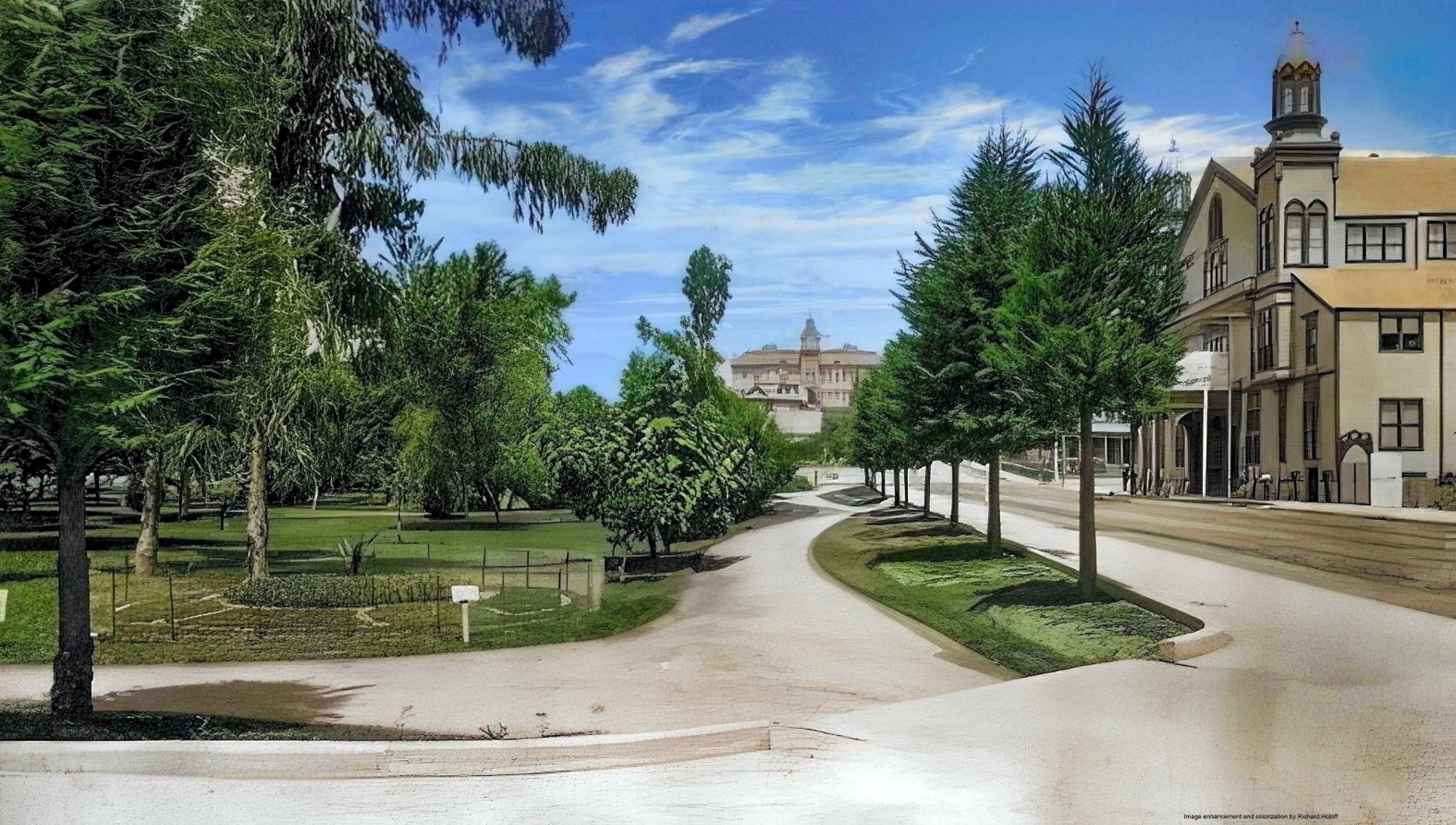 |
|
| (ca. 1890)^ – View looking west on 5th Street from Hill Street showing Hazard’s Pavilion at the northeast corner of 5th and Olive, 6th Street Park on the left, and the State Normal School in the distance. Image enhancement and colorization by Richard Holoff. |
Historical Notes This view shows how closely tied the park and surrounding institutions were to everyday life in late nineteenth century Los Angeles. Residents could attend a lecture, concert, or rally at Hazard’s Pavilion, stroll through the shaded paths of Sixth Street Park, and look up at the imposing mass of the State Normal School on the hill at Grand Avenue. Within a few decades the scene would change dramatically. Hazard’s Pavilion was demolished in 1905 to make way for the Philharmonic Auditorium, and in the 1920s the Normal School was torn down so that 5th Street could be extended and the new Central Library could be built on the site. This photograph preserves an earlier phase when the park, pavilion, and school defined the western edge of the downtown core. |
Then and Now
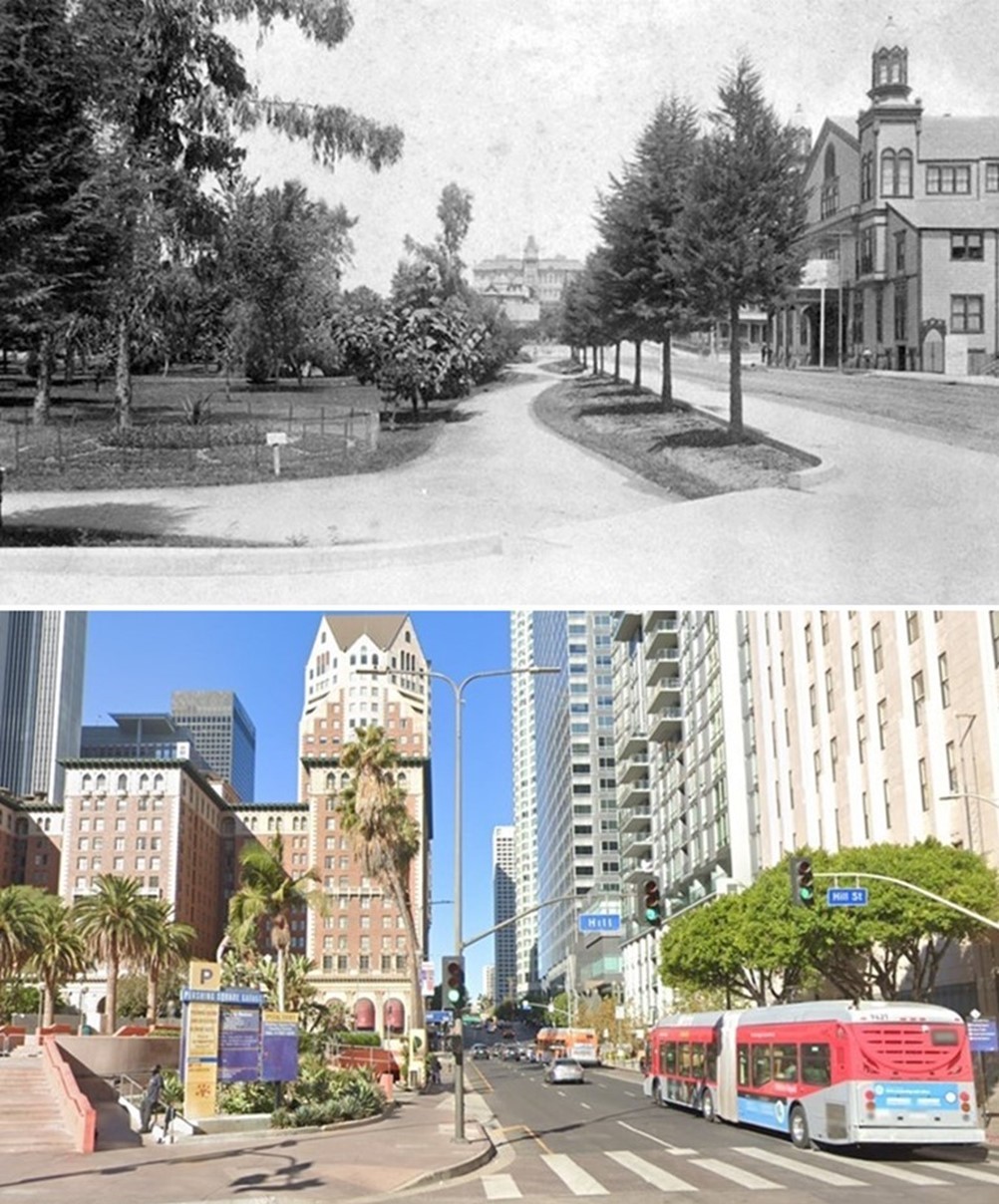 |
|
| (1890 vs. 2021)* – Looking west on 5th Street at Hill Street. In the early image, Sixth Street Park (now Pershing Square) is on the left and the State Normal School rises on the hill at Grand Avenue, where 5th Street originally dead-ended. On the right is Hazard’s Pavilion, built in 1887 and later replaced by the Philharmonic Auditorium. After the State Normal School was demolished in 1924, 5th Street was extended and the L.A. Central Library was constructed on the old school site. Photo comparison by Jack Feldman. |
Historical Notes In the late 1800s, Sixth Street Park was one of the earliest green spaces in downtown Los Angeles. With its lawns, paths, and shaded seating areas, the park served nearby residents, churchgoers, and students from St. Vincent’s College. Over a few decades it carried several names—Los Angeles Park, St. Vincent’s Park, Sixth Street Park, and finally Pershing Square in 1918—reflecting the city’s rapid growth and changing identity. To the right in the early view stood Hazard’s Pavilion, a 4,000-seat hall that hosted concerts, political rallies, expositions, and religious events. It was one of the largest indoor gathering spaces in Southern California until its demolition in 1905 to make way for the Philharmonic Auditorium. The State Normal School, visible on the hill at Grand Avenue, trained teachers for Southern California’s expanding public school system. The school was removed in the 1920s so that 5th Street could be extended and the new Los Angeles Central Library could be built on the site. The modern scene shows how dramatically this corner of downtown transformed in the 20th century. The Biltmore Hotel, completed in 1923, anchors the western side of Pershing Square, and the skyline has risen around the park. Despite redesigns, demolitions, and changing surroundings, Pershing Square remains the city’s oldest dedicated public square and continues to occupy the same 5-acre block set aside in 1866. |
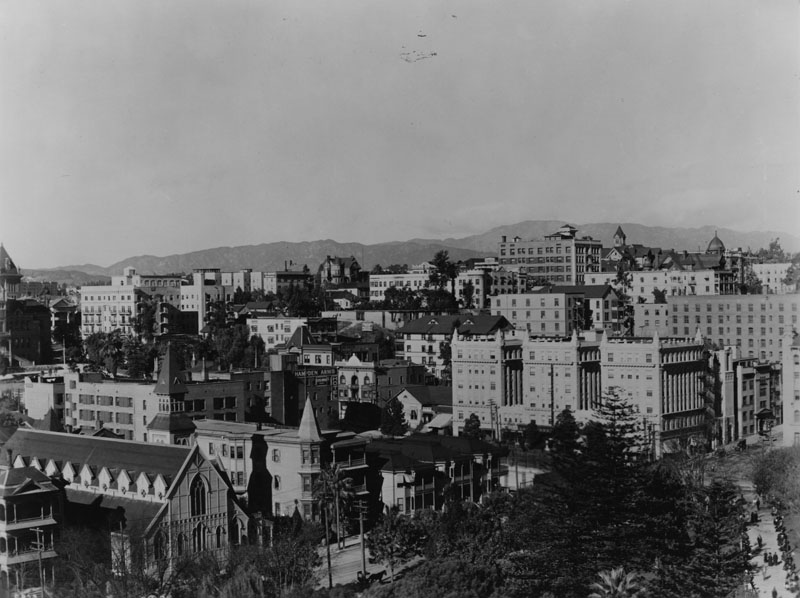 |
|
| (ca. 1900)^ - View of the central city looking northwest over Pershing Square toward Bunker Hill and the Hollywood Hills |
Historical Notes Around 1900, the park was generally known as Central Park and had become a lush, shaded oasis surrounded by hotels, boarding houses, churches, and small office buildings. In the foreground, St. Paul’s Episcopal Church and nearby residences show how closely religious and residential life bordered the park. Beyond the square, Bunker Hill rises with its growing collection of Victorian houses and flats, while the low Hollywood Hills are visible in the far distance. This view illustrates how Central Park functioned as a visual and social center of the city. It tied together downtown’s commercial streets, the dense residential district on Bunker Hill, and the broader landscape that stretched toward the Cahuenga Pass and the Hollywood area that would later become famous. |
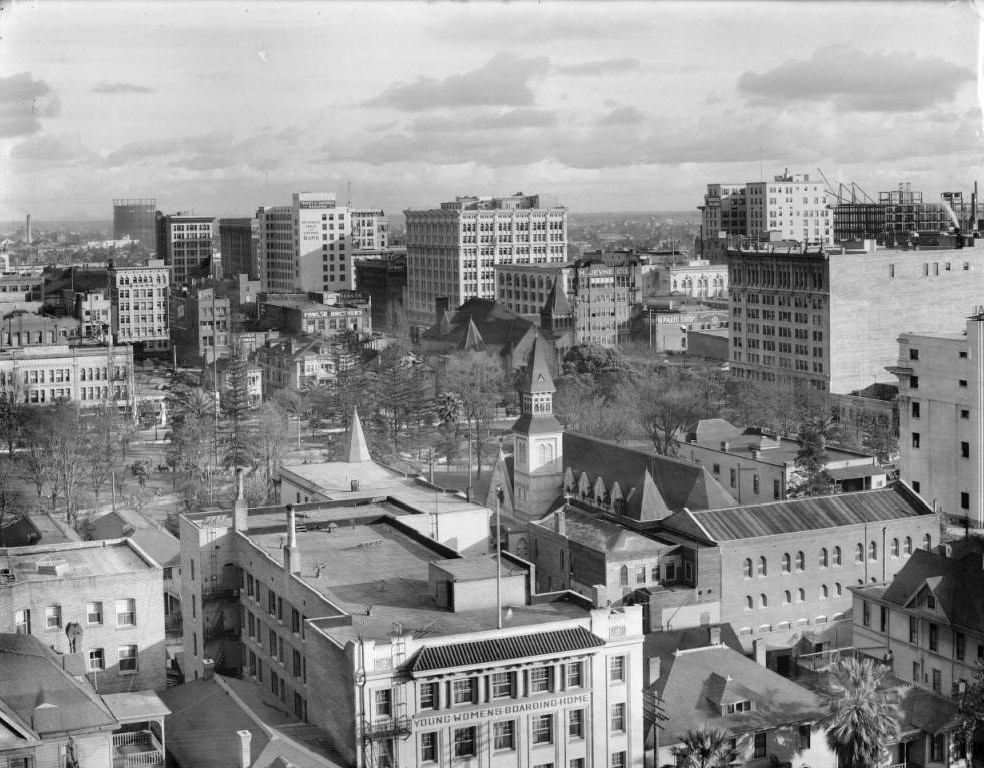 |
|
| (ca. 1913)* - View looking southeast showing St. Paul’s Episcopal Church in the foreground, Pershing Square, and part of the city skyline. |
Historical Notes By 1913, the park had gone through several name changes and redesigns and was now often referred to as Central Park. The surrounding skyline had begun to rise with taller commercial buildings, signaling downtown’s rapid growth in the early twentieth century. St. Paul’s still stood facing the park, but within a decade its Olive Street site would be sold and the church replaced by the Biltmore Hotel. In 1918, shortly after the end of World War I, the city officially renamed the park Pershing Square in honor of General John J. Pershing. This change reflected Los Angeles’ desire to associate its central public space with national pride and modern civic identity, even as many of the park’s nineteenth century surroundings were being replaced by larger hotels, office buildings, and later, underground parking and redesigns. |
Before and After
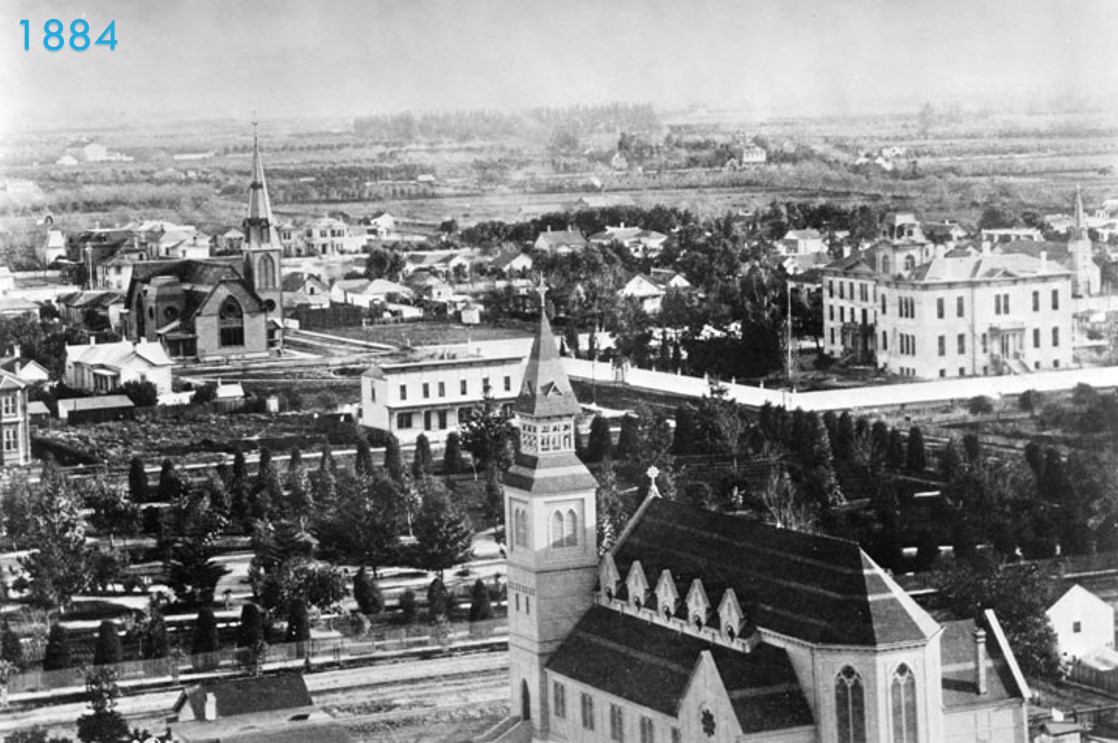 |
|
.jpg) |
Historical Notes The 1884 view shows the park in one of its earliest landscaped forms, bordered by two of the most important cultural institutions of the era. St. Paul’s Pro Cathedral stood on the east side of the park until the early 1920s, while the State Normal School on the hill at Grand Avenue trained teachers for the fast growing public school system. At this time the park was still known simply as Los Angeles Park. By 1913, the block was officially called Central Park and had been redesigned with new walkways, planting schemes, and public gathering areas. The skyline around it had changed significantly, with early multi story commercial buildings rising along Hill, Broadway, and 6th Street. These new structures signaled downtown’s rapid transformation from a low rise town to a modern business center. Within a few years after the 1913 view, the landscape would change even more. St. Paul’s would be demolished to make way for the Biltmore Hotel, the State Normal School would be removed so that 5th Street could be extended, and in 1918 the park would receive its permanent name: Pershing Square, honoring General John J. Pershing at the end of World War I. |
Click HERE to see more Early Views of Pershing Square |
* * * * * |
Spring and 6th Street
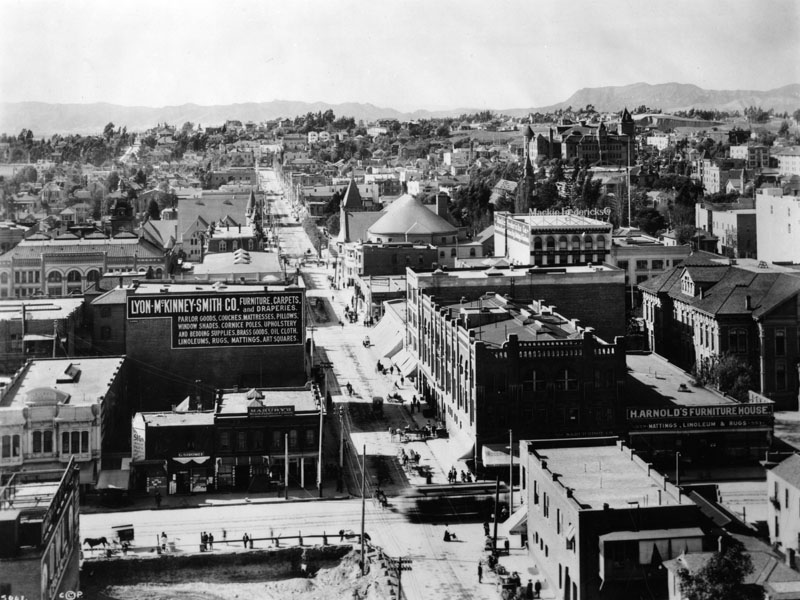 |
|
| (ca. 1882)* - A view of 6th St. looking west with Spring St. crossing in the foreground. The Spring Street School is in the right foreground. This would later be the site of the Arcade Building. |
Main Street
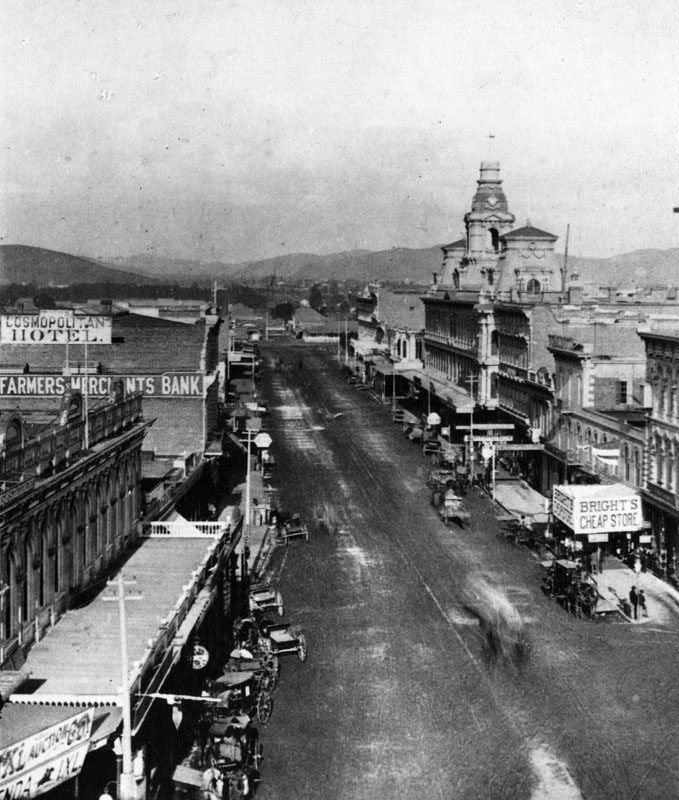 |
|
| (1882)^ - View looing north on Main Street, with the Downey Block on the left, followed by the second location of the Farmers and Merchants Bank from June 15, 1874, to October 29, 1883, followed by the Cosmopolitan Hotel (previously Lafayette Hotel). On the right is the Ducommun Building, Bella Union-Clarendon-St. Charles Hotel, Pico Building (the first home of Farmer's and Merchants Bank), the Grand Central Hotel, and the Baker Block (with towers). |
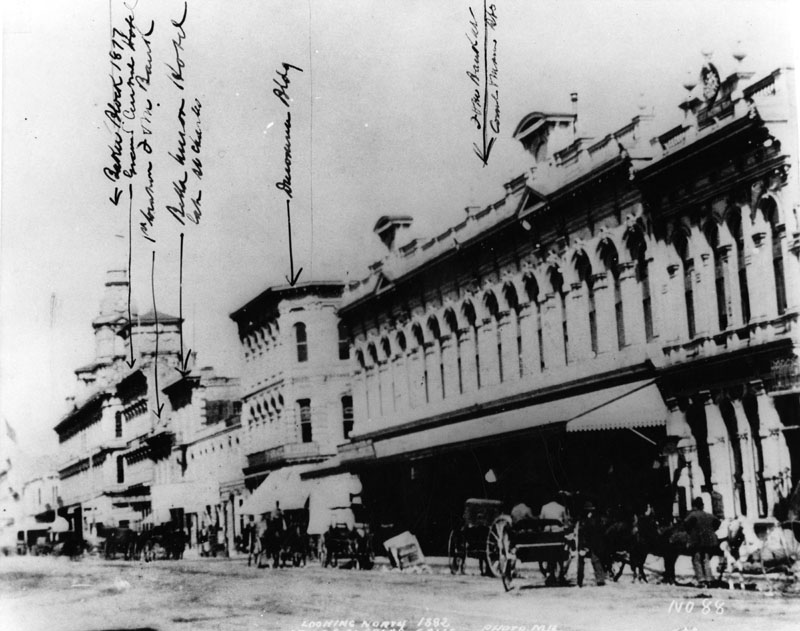 |
|
| (1882)^ - View looking north on Main Street with buildings annotated. The Farmers and Merchants Bank opened October 29, 1882 in the Hellman Building. First National Bank, formerly Commercial Bank, was in the building on the right. The Duccommon building can be seen at center-left of photo. |
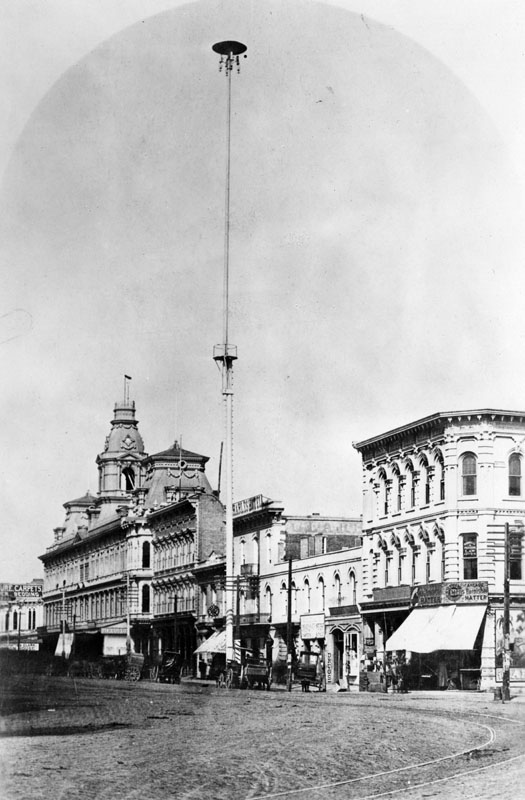 |
|
| (ca. 1882)**- One of the first of seven electric street lights installed in the City of Los Angeles at Main Street and Commercial Street in 1882. It stood 150 feet tall. Baker Block is on the left and the Ducommun Building on the right. |
Historical Notes Each of the 150-foot-high masts carried three carbon-arc lamps of three thousand candle-power. All seven lamps and a small power plant to provide the electricity were installed by C. L. Howland in 1882. In 1883, Howland and others formed the Los Angeles Electric Company.** Click HERE to see more in Early Los Angeles Street Lights. |
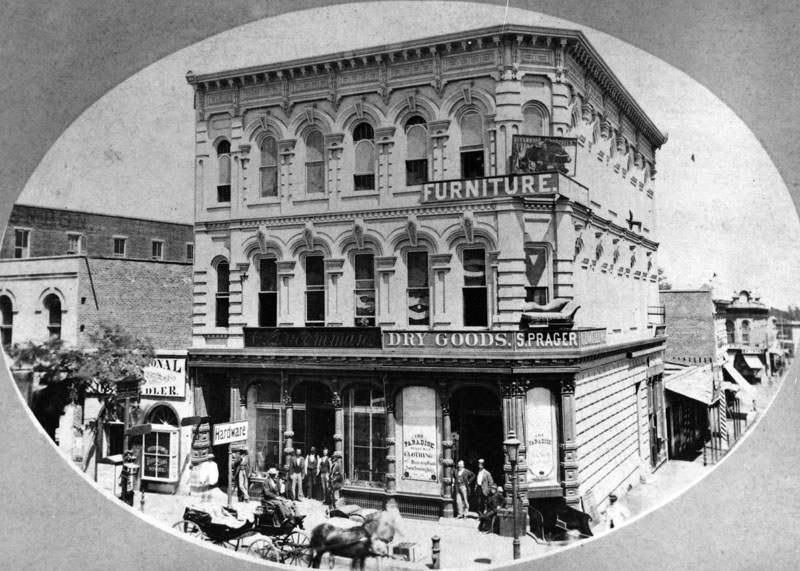 |
|
| (ca. 1882)^ - Hardware Store of C. Ducommun, dry goods store of S. Prager and a furniture store at 204 N. Main Street (after 1890 at 304 N. Main Street) are shown. |
Historical Notes Charles Louis Ducommun, a watchmaker by training, emigrated to the US from Switzerland in the early 1840s. He started a general store, providing supplies (and credit) to gold prospectors and other pioneers who had settled in the burgeoning pueblo of Los Angeles. Ducommun Street was named for Charles Louis.^* |
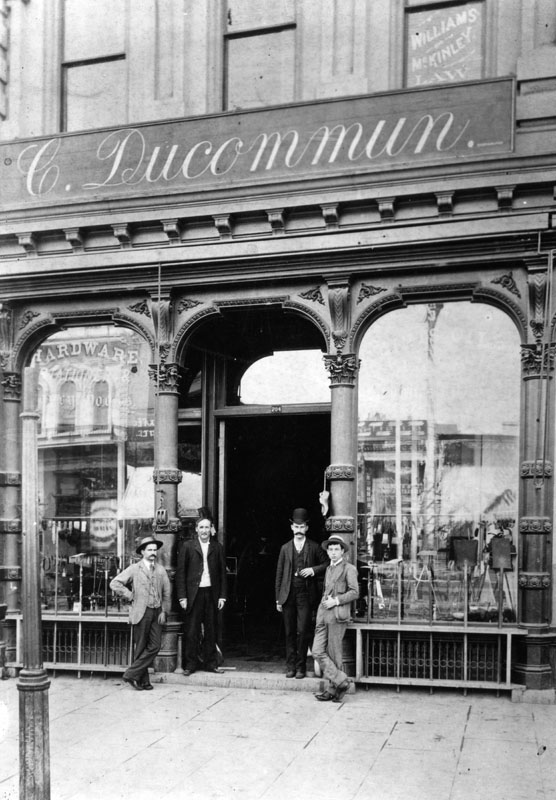 |
|
| (1886)^ - Facade of the hardware store of C. Ducommun at 204 N. Main Street (after 1890 at 304 N. Main Street). |
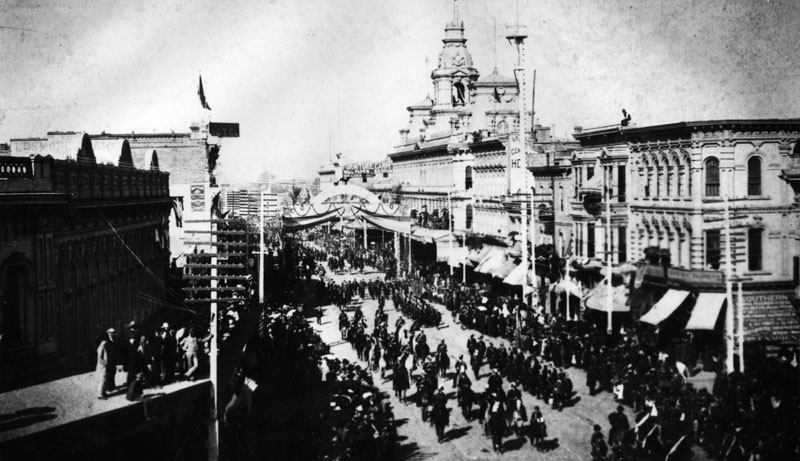 |
|
| (1882)^ - View of a parade on Main Street, looking north. Later on the right corner would be the Civic Center Plaza, at the left City Hall. |
Click HERE to see more Early Views of the Historic 300 Block of N. Main Street |
* * * * * |
Cahuenga Pass
 |
|
| (1882)^ - Before roads and rail lines were built traveling through the Cahuenga Pass was by wagons and horses or on foot. This picture was taken at the summit. There is a saloon concealed among the trees. |
Historical Notes The Cahuenga Pass connects the Los Angeles Basin to the San Fernando Valley and is the lowest pass through the mountains. It was the site of two major battles, the Battle of Cahuenga Pass in 1831 (a fight between local settlers and the Mexican-appointed governor and his men, two deaths), and the Battle of Providencia or Second Battle of Cahuenga Pass in 1845 (between locals over whether to secede from Mexico. One horse and one mule killed) both on the San Fernando Valley side near present-day Studio City, and cannonballs are still occasionally found during excavations in the area. Along the route of the historic El Camino Real, the historic significance of the pass is also marked by a marker along Cahuenga Blvd. which names the area as Paseo de Cahuenga.^ Click HERE to see more in Early Views of the San Fernando Valley. |
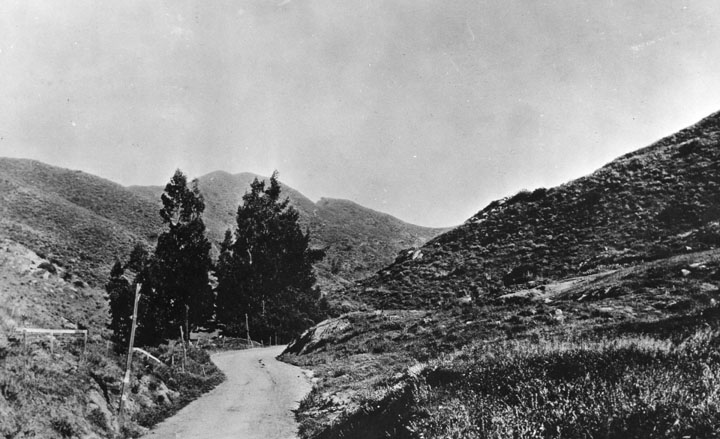 |
|
| (1882)^ - View of the summit of Cahuenga Pass with a saloon, Cahuenga Tavern, situated between the tall eucalyptus trees. |
Historical Notes Cahuenga is the Spanish name for the Tongva village of Kawengna, meaning place of the mountain.*^ |
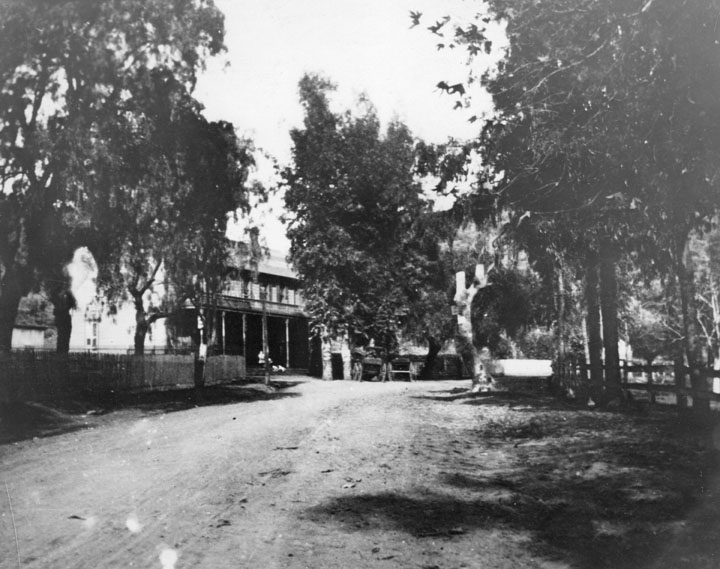 |
|
| (n.d.)^ - View of Cahuenga Tavern, also known as Eight Mile House, situated between eucalyptus near the summit of Cahuenga Pass. |
Historical Notes In the 1870s, a primitive hotel -- named the Eight Mile House because Los Angeles was eight miles down the road -- rose among a stand of eucalyptus trees inside the canyon. |
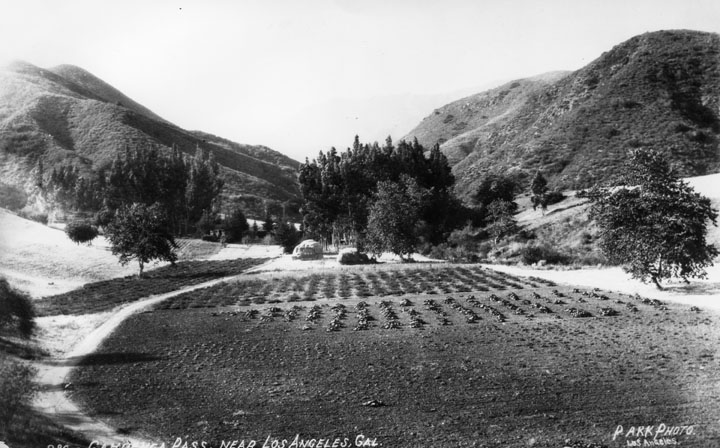 |
|
| (n.d.)^ - View of early Cahuenga Pass. The road runs around and through a cultivated area. |
Historical Notes As late as 1914, filmmaker Cecil B. DeMille rented a wooden cabin in the pass as his home. He rode daily into his studio on horseback -- with a revolver on his hip. Click HERE to see more Early Views of Cahuenga Pass. |
* * * * * |
Broadway and 2nd Street
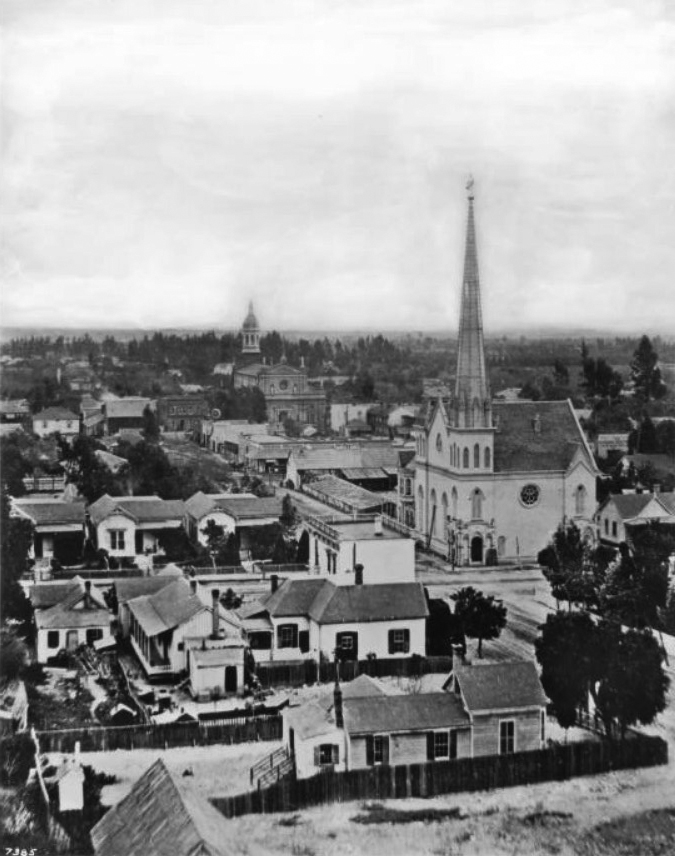 |
|
| (ca. 1878)* - View looking east showing the intersection of Second Street and Fort Street (later Broadway) where the First Presbyterian Church, with its impressively tall spire, can be clearly seen on the southeast corner. In the distance, on the east side of Main Street just south of Second Street, stands St. Vibiana's Cathedral. |
Historical Notes This early view captures the quiet intersection of Second and Fort Street (renamed Broadway in 1890), a crossroads still in its formative stage. Dominating the southeast corner is the First Presbyterian Church, with its remarkably tall Gothic spire—a prominent Los Angeles landmark of the era. In the background, just beyond Main Street, the twin towers of St. Vibiana's Cathedral rise—then still a relatively new addition, completed in 1876. At this time, Fort Street was little more than a dirt road winding through a semi-rural downtown. Los Angeles had yet to embrace the architectural and transportation transformations that would define the next two decades. |
.jpg) |
|
| (ca. 1880)* – Street view looking at the southeast corner of Second Street and Fort Street (later Broadway). A horse-drawn coach stands parked in the street to the right of the Gothic-style First Presbyterian Church and its impressively tall spire. A man stands in the unpaved street farther to the right. A wrought-iron fence enclosed a garden of topiary across the street to the left. The city's first Jewish Synagogue, B'nai B'rith Temple, can be seen behind the church to the right. To the right of the synagogue is the future home of LA's 3rd City Hall (1888-1928). |
Historical Notes This view looks toward the southeast corner of Second and Fort Street (Broadway) around 1880. The First Presbyterian Church, built in 1873 in the Gothic Revival style, towers over the scene with its landmark spire. A lone coach stands along the dusty street while a man poses off to the right. Just behind the church rises the B’nai B’rith Temple, Los Angeles’s first synagogue, completed in 1872—reflecting the city’s early religious and cultural diversity. Also visible is the future site of L.A.’s third City Hall (1888–1928), offering a fascinating glimpse of the neighborhood just before the arrival of civic expansion and cable car tracks. |
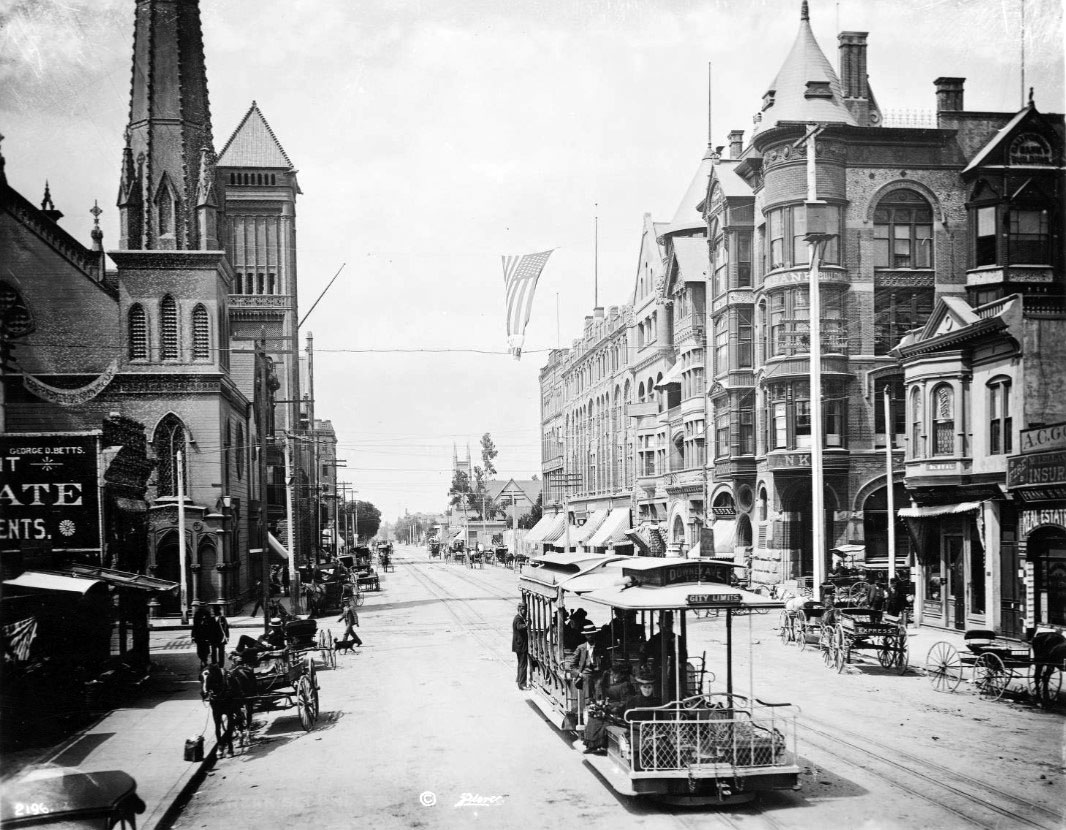 |
|
| (ca. 1894)* – View looking south toward the intersection of Broadway and 2nd Street showing a cable car full of passengers in the foreground. Horse-drawn vehicles are parked along the curb on both sides of the street. On the southeast corner (left) stands the First Presbyterian Church, with the 1888-built City Hall visible farther down at 226 S. Broadway. On the southwest corner (right) is the California Bank Building. In the distance, the newly completed Bradbury Building stands at the southeast corner of Broadway and 3rd Street. |
Historical Notes Although long attributed to 1889, the presence of the Bradbury Building—completed in 1893—confirms this photo was taken closer to 1894. The scene captures the transitional years of downtown Los Angeles, when cable cars shared the road with horse-drawn carriages and commercial buildings were rising along Broadway, formerly Fort Street (renamed in 1890). The photo also showcases early civic architecture: the spired First Presbyterian Church, the turreted California Bank Building, and the recently completed City Hall, which served until 1928. This particular cable car operated on the Downey Avenue line of the Los Angeles Cable Railway, which began service in 1889 and connected areas from 9th Street to what is now Lincoln Heights. Three main cable car companies operated in Los Angeles between 1885 and 1902: a) Second Street Cable Railroad (1885-1889): It ran along Second Street, up Bunker Hill, to Second and Texas (now Belmont) Street. b) Temple Street Cable Railway (1886-1902): This line extended 8,725 feet between Spring Street and Belmont Avenue. c) Los Angeles Cable Railway (1889-1902): The most ambitious system, it operated about 25 miles of routes, connecting downtown Los Angeles to areas now known as Lincoln Heights, Echo Park/Filipinotown, and the Pico-Union district. The cable car seen in the above image belonged to the Los Angeles cable Railway. The Downey Avenue line, now known as North Broadway, was a key route that connected various parts of Los Angeles. It extended from Ninth and Grand View, through Ninth, Figueroa, Sixth, Hill, Fourth, Broadway, First, Spring, Marchessault, Main, San Fernando, Olympia, Downey (N. Broadway), Chestnut (now Avenue 20), Pasadena, Daily, to Avenue 33. |
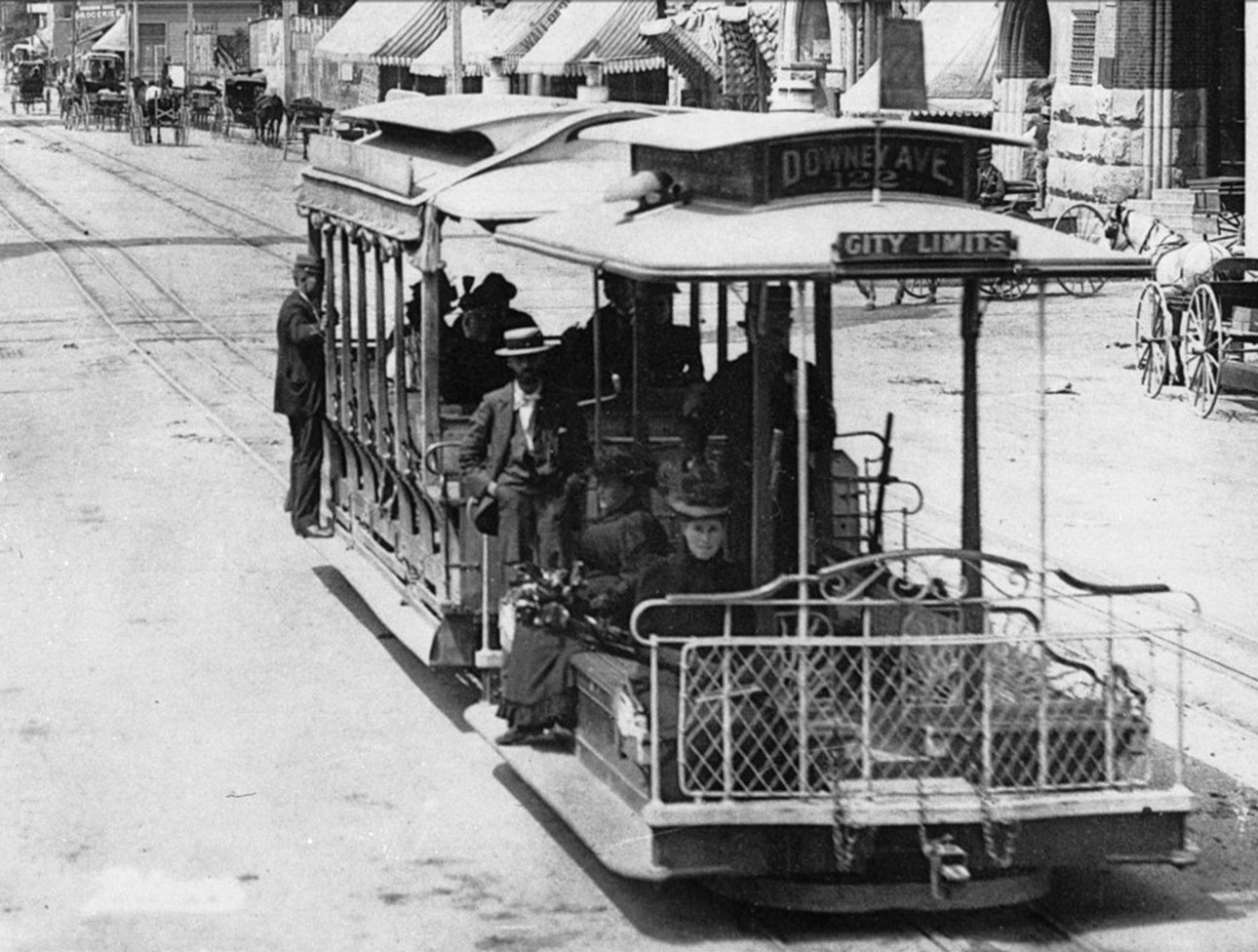 |
|
| (ca. 1894)* – Close-up view of previous photo showing a cable car heading north on Broadway at 2nd Street. |
Historical Notes Cable cars soon became obsolete after engineers perfected an newer streetcar technology: the electric railway. Whereas cable railways constantly ran their engines at full power—regardless of how many cars were active on the line—to pull the heavy steel cables, the newer railways delivered electricity directly to motors located on the streetcars themselves. Cables lasted only a few years before needing replacement and were costly to bury; overhead catenary wires were inexpensive by comparison. By 1896, much of the city's cable car trackage had been converted to electricity and incorporated into a growing electric railway network. In 1902, a mere 16 years after the city hailed its first cable railway as a technological wonder, the last of L.A.'s cable cars rolled down Temple Street and into obscurity. |
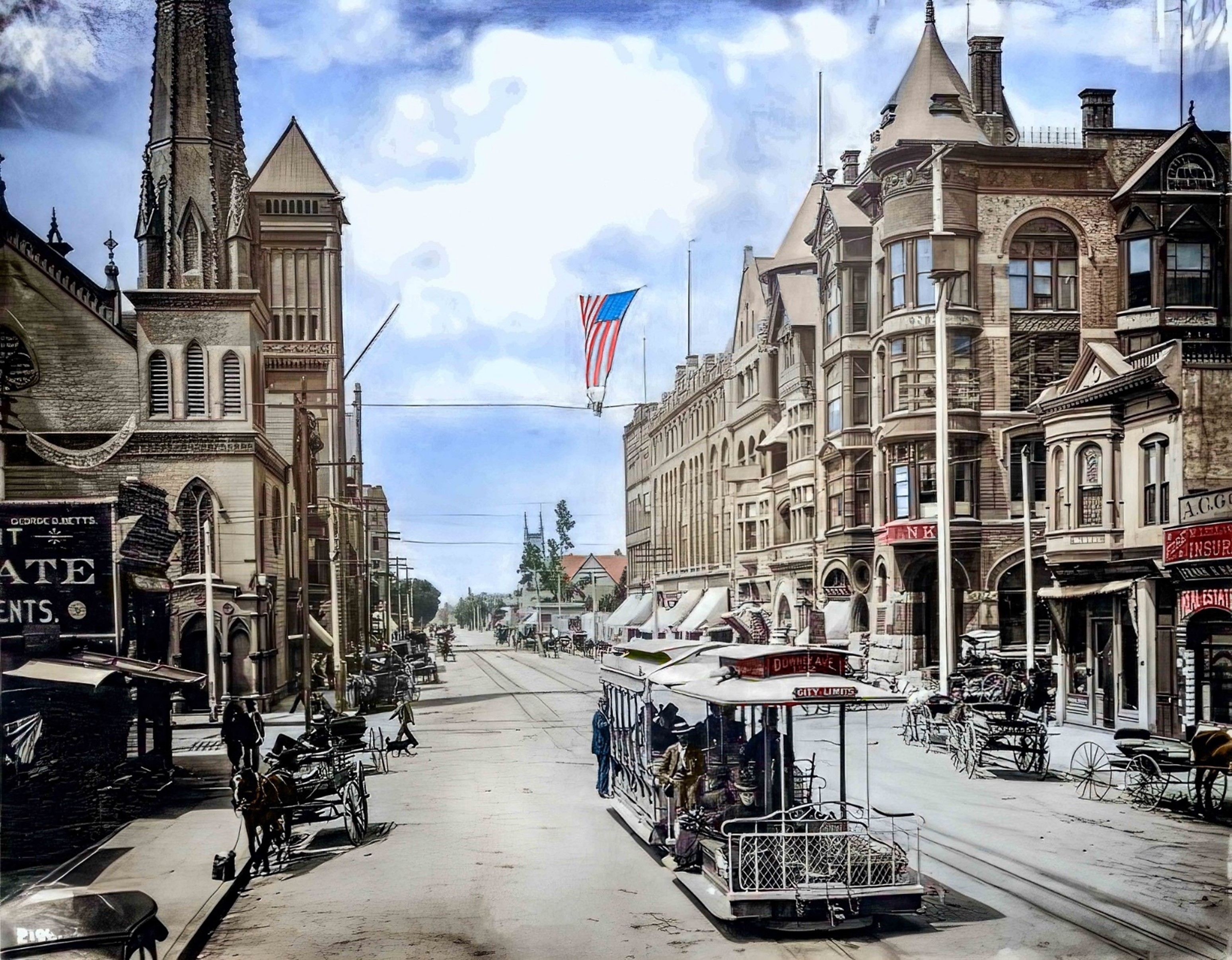 |
|
| (ca. 1894)* – View looking south toward the intersection of Broadway and 2nd Street showing a cable car full of passengers in the foreground. Horse-drawn vehicles are parked along the curb on both sides of the street. On the SE corner (left) stands the First Presbyterian Church with the 1888-built City Hall situated further south at 226 S. Broadway. To the right, on the SW corner, is the California Bank Building. In the distance can be seen Fort Street Methodist Episcopal Church, located on the west side of Broadway between 3rd and 4th streets. Note: Broadway was known as 'Fort Street' until 1890. Photo by Charles C. Pierce; Image enhancement and colorization by Richard Holoff. |
Historical Notes Although long attributed to 1889, the presence of the Bradbury Building—completed in 1893—confirms this photo was taken closer to 1894. The scene captures the transitional years of downtown Los Angeles, when cable cars shared the road with horse-drawn carriages and commercial buildings were rising along Broadway, formerly Fort Street (renamed in 1890). Color breathes new life into this classic 1894 C.C. Pierce photograph, masterfully enhanced by Richard Holoff. Broadway, still in its first year under that name, is alive with movement: a cable car packed with passengers, horse-drawn carriages lining both sides, and the spire of the First Presbyterian Church reaching skyward. To the right, the distinctive turret of the California Bank Building rises, while farther down, the 1888 City Hall anchors the civic core of a rapidly modernizing Los Angeles. The Fort Street Methodist Episcopal Church can be seen in the distance. Together, these elements capture the energetic yet transitional character of the late 19th-century city. |
 |
|
| (2022)* - Contemporary view looking south down Broadway from 2nd Street—the same vantage point once filled with cable cars, horse-drawn carriages, and church spires. Today, it’s framed by office towers, concrete, and traffic signals—but the footprint of the past still shapes the streetscape. |
Historical Notes This present-day view of Broadway at 2nd Street shows a dramatically transformed cityscape. Gone are the cable cars, gas lamps, and spired churches that once defined the area. In their place stand commercial high-rises, traffic lights, and the infrastructure of a modern metropolis. Yet the street grid remains intact, echoing decisions made in the 19th century. Broadway continues to serve as a key artery in downtown Los Angeles, still tracing the path laid out when the street was known as Fort Street prior to 1890. |
Then and Now
 |
|
| (1894 vs 2022)* - A 'Then and Now' view looking south on Broadway at 2nd Street. Photo comparison by Jack Feldman. |
Historical Notes This 'Then and Now' photo comparison bridges nearly a 130 years of change at the intersection of Broadway and 2nd Street. In the 1894 image, Los Angeles is caught in the act of becoming—a city where cable cars share the street with carriages and pedestrians, where Gothic and Romanesque facades dominate the skyline, and where civic ambition is embodied by the newly completed City Hall. In the 2022 image, little remains of that early world. The First Presbyterian Church, B’nai B’rith Temple, and the California Bank Building have vanished, replaced by the geometry of modern development. Still, the orientation of the street, the flow of traffic, and even the sunlit perspective remind us that history is never truly erased—only built upon. |
Then and Now
.jpg) |
|
| (1894 vs 2022)* - Looking south on Broadway at 2nd Street. Photo comparison by Jack Feldman. |
Historical Notes This “Then and Now” juxtaposition bridges more than 130 years of change at the intersection of Broadway and 2nd Street. The 1894 image reveals a city on the rise—marked by ornate spires, the hum of cable cars, and architectural ambition. In the modern 2022 view, only the street grid remains recognizable; all else has been transformed. Missing are the churches, the cable lines, the horses—and in their place, high-rises, traffic lights, and a vertical downtown skyline. The spire of First Presbyterian and the arc of the cable car tracks have long vanished, but this image reminds us how the past remains embedded beneath our feet. Click HERE to see more Early Views of the intersection of Broadway and 2nd Street in the 1880s. |
* * * * * |
Main and 3rd Streets
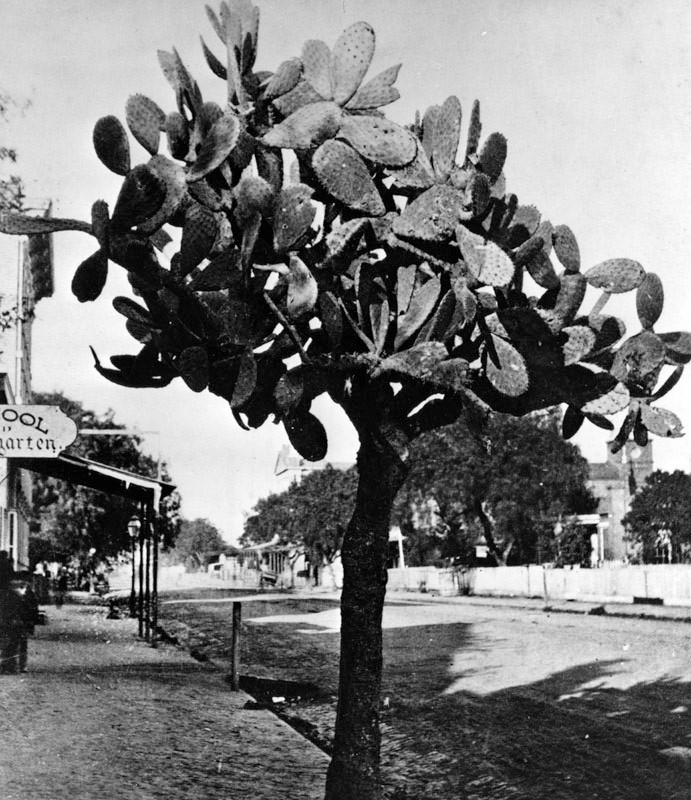 |
|
| (1880s)^ - View looking north on Main Street near 3rd Street showing a large Cactus tree in front of the "Round House", with a kindergarten sign seen on the left. In the distance, on the right, can be seen St. Vibiana's Cathedral. |
Historical Notes The Round House was once a popular beer garden and later became LA's first kindergarten |
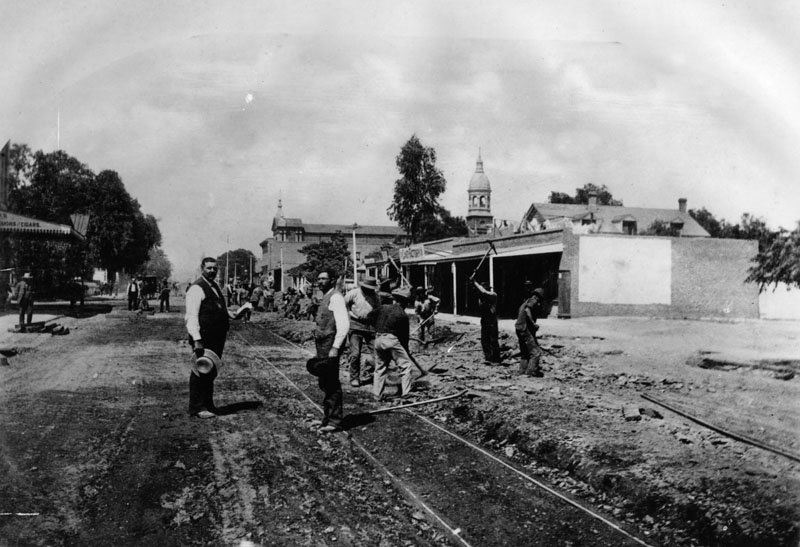 |
|
| (ca. 1884)^ - Main Street near 3rd, looking north. Workers are laying double tracks down for the horse-drawn street car line. St. Vibiana's Cathedral is seen in the distance. |
* * * * * |
Main and 2nd Streets
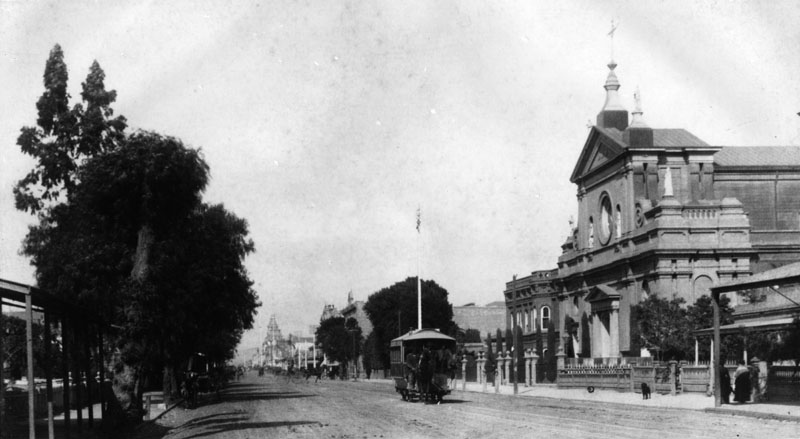 |
|
| (1884)^ - Main Street looking north toward 2nd Street, showing the Cathedral of St. Vibiana on the right side. Horse-drawn streetcar can be seen heading South on Main Street. |
Historical Notes The Cathedral of Saint Vibiana, often called St. Vibiana's, opened in 1876 as the cathedral for what was then known as the Diocese of Monterey-Los Angeles, and remained the official cathedral of the Los Angeles for over 100 years.*^ |
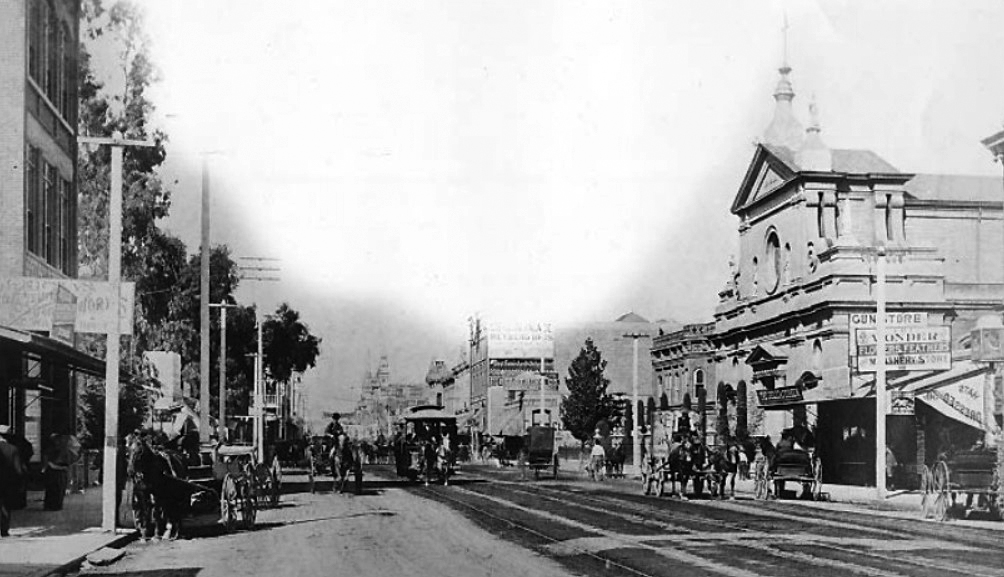 |
|
| (ca. 1887)+# – View looking north on Main Street toward 2nd Street showing numerous horse-drawn wagons and including a horse-drawn streetcar in front of St. Vibiana's Cathedral. |
Historical Notes Electric-powered streetcars did not begin operating until 1887.*##^ |
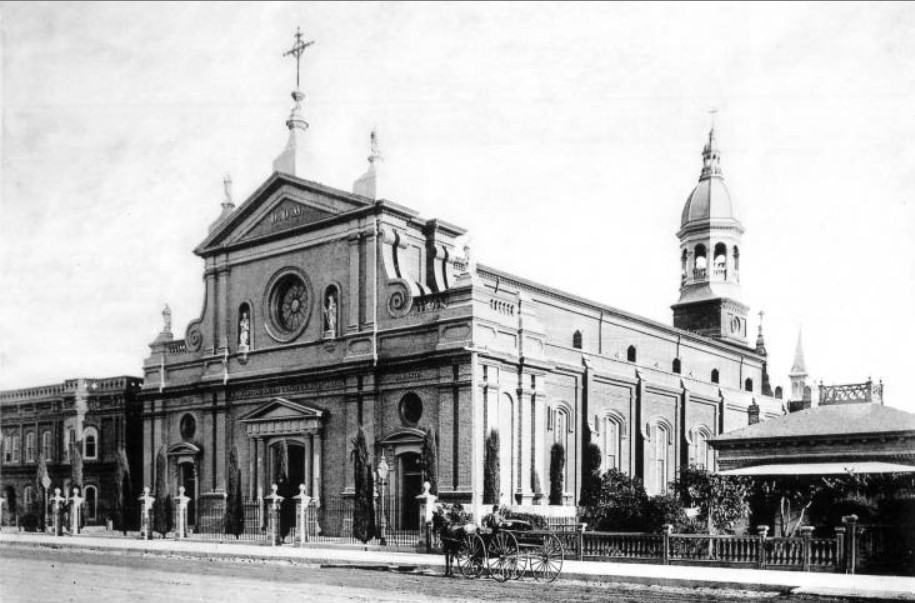 |
|
| (1885)^^ - Exterior view of St. Vibiana's Cathedral located at 200-248 S. Main Street. A man stands near a horse-drawn carriage that is parked on the dirt road in front of the church. |
Historical Notes In 1963, St. Vibiana's Cathedral was dedicated as Los Angeles Historic Cultural Monument No. 17 (Click HERE to see complete listing). Click HERE to see more Early Views of St. Vibiana's Cathedral. |
Then and Now
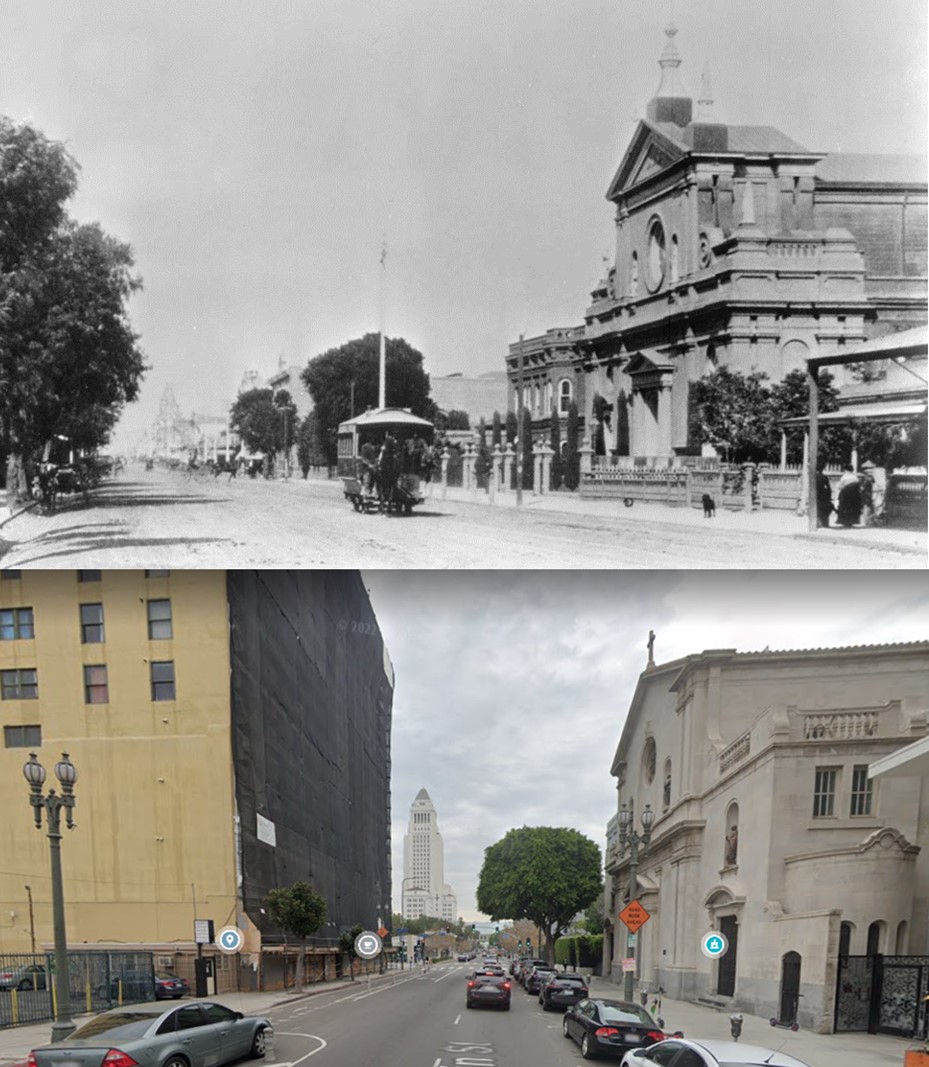 |
|
| (1884 vs. 2021)* – Looking north on Main Street toward 2nd Street showing the Cathedral of St. Vibiana building on the right. Photo comparison by Jack Feldman. |
* * * * * |
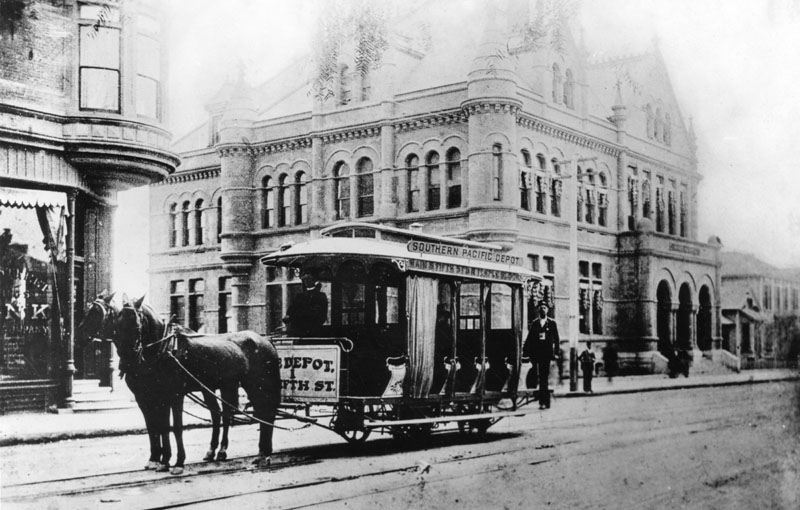 |
|
| (ca. 1880s)^ - A horse-drawn street car stands near the corner of Main and Winston Streets with the Post Office and Federal Building (aka Government Building) in the background. Its route is between the Southern Pacific Depot, Main and 5th Streets, and Temple Block. |
Historical Notes Winston Street is located between 4th and 5th Streets. Click HERE to see more Early Views of Main and Winston Streets. |
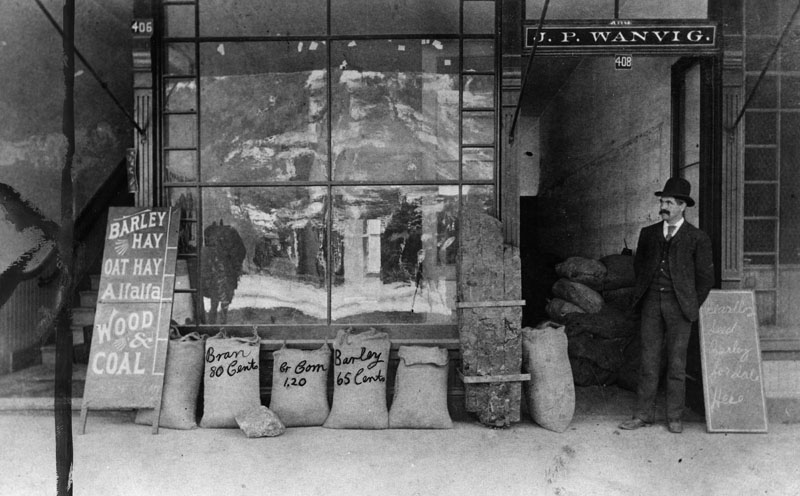 |
|
| (ca. 1880)^ - J.P. Wanvig stands outside his feed store located at 408 Main Street. The signs on the sidewalk advertise barley, hay, oat hay, alfalfa, wood, coal and bran are for sale within the establishment. |
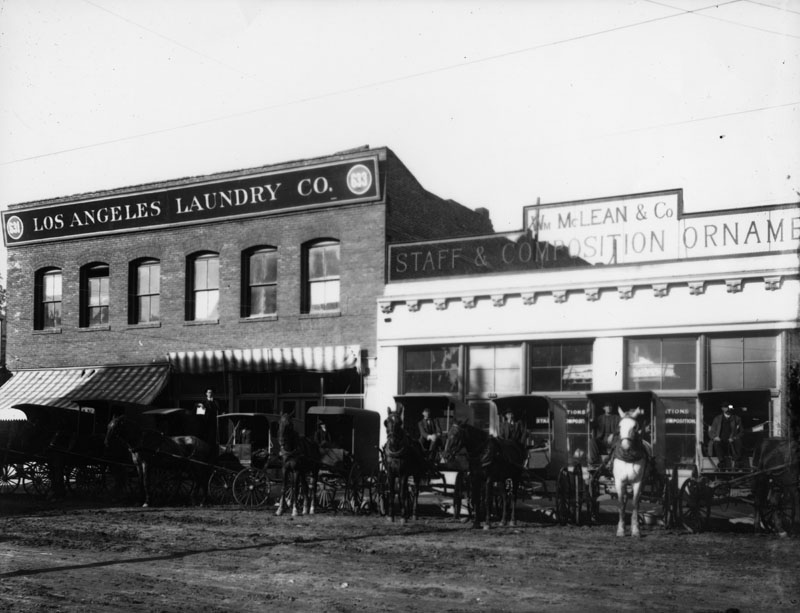 |
|
| (ca. 1880s)^ - Exterior view of Los Angeles Laundry Co. located at 633 San Fernando Street, near Bellevue Avenue. To the right is the William McLean & Co., "Staff and Composition Ornamentations", at 635 San Fernando. Numerous horse-drawn carriages are parked on the unpaved street. |
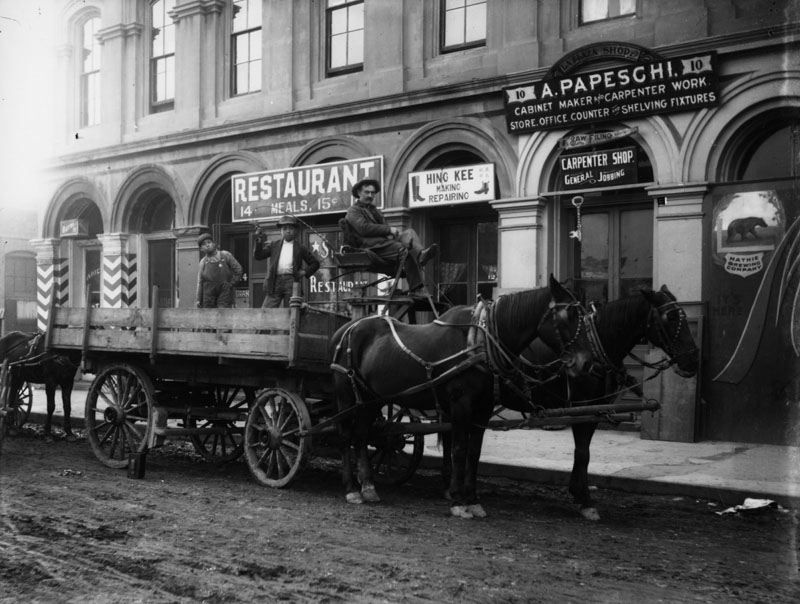 |
|
| (ca. 1880s)^ - A team of horses and a wagon with men on it stand on an unpaved street in front of the general jobbing carpenter shop of A. Papesghi at #10 of an unidentified street, probably in the Plaza area. He is a cabinet maker, does carpenter work, and makes store and office counters and shelving fixtures. A sign above the door reads, "La Plaza Shop." Next door to the left is Hing Kee shoe making and repairing, and beyond that a restaurant selling meals for 15 cents, and a barber shop. To the right is Mathis Brewing Company. |
* * * * * |
Spring and 1st Street
.jpg) |
|
| (ca. 1883)* - Spring Street looking north as seen from the from 1st Street. H. Jevne, wholesale grocer, is seen at 40 North Spring at upper-right. The tall copula in the distance is part of the Baker Block. The copula of Temple Block can also be seen at upper-right. The tall pole in the distance is actually LA's 1st Electric Streetlights (installed in 1882). It was 150 feet tall. |
Historical Notes Spring Street north of 1st in the early 1880s still had the look of a frontier town, even as Los Angeles was beginning to push toward a more modern identity. Dirt roads, open lots, and small wooden shops lined the block. One of the most striking features is the tall electric light tower rising above the street. Installed in 1882, it was part of the city’s first attempt at electric streetlighting, long before the neighborhood had paved roads or structured sidewalks. The cupola of the Baker Block can be seen in the distance, marking the direction of Main Street and serving as one of the city’s best-known landmarks. This early view captures Los Angeles at a turning point, with old and new elements blending together. Horse-drawn wagons still dominated the street, but the electric light tower signaled the direction the city was heading. |
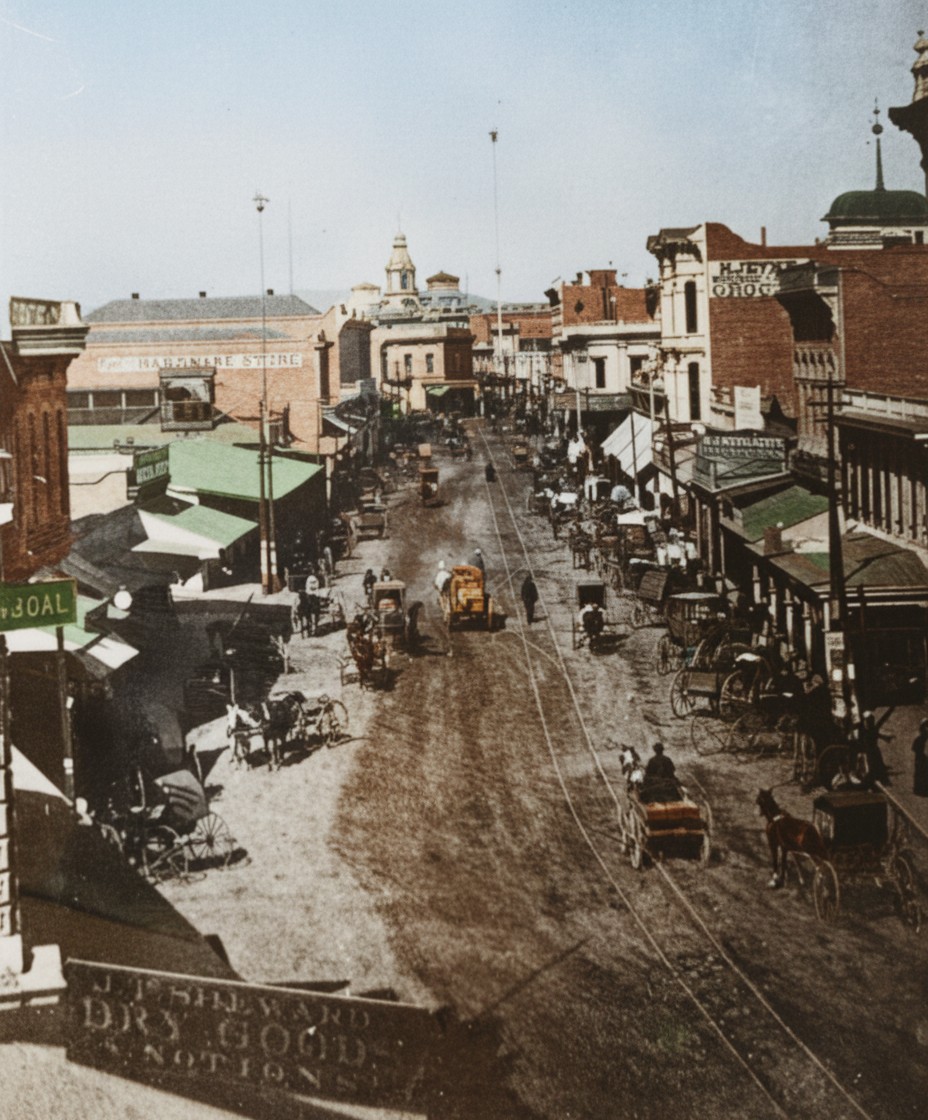 |
|
| (ca. 1883)* - Spring Street brought to life — the same 1883 scene, now colorized, showing just how raw and open early downtown Los Angeles really was. |
Historical Notes The colorized version brings out details that are easy to miss in the original image. The warm tones of brick and wood, the dusty street surface, and the bright signage all help show how active the block was in 1883. On the right stands Hans Jevne’s grocery, one of the most successful food businesses in early Los Angeles. Jevne first operated out of a single storefront here, eventually expanding into both floors of the building as his wholesale and home-delivery operations grew. The color also highlights how close together the businesses were packed along Spring Street, creating a lively commercial corridor despite the rugged surroundings. Even in this early stage, you can see the beginnings of the busy district Spring Street would become. |
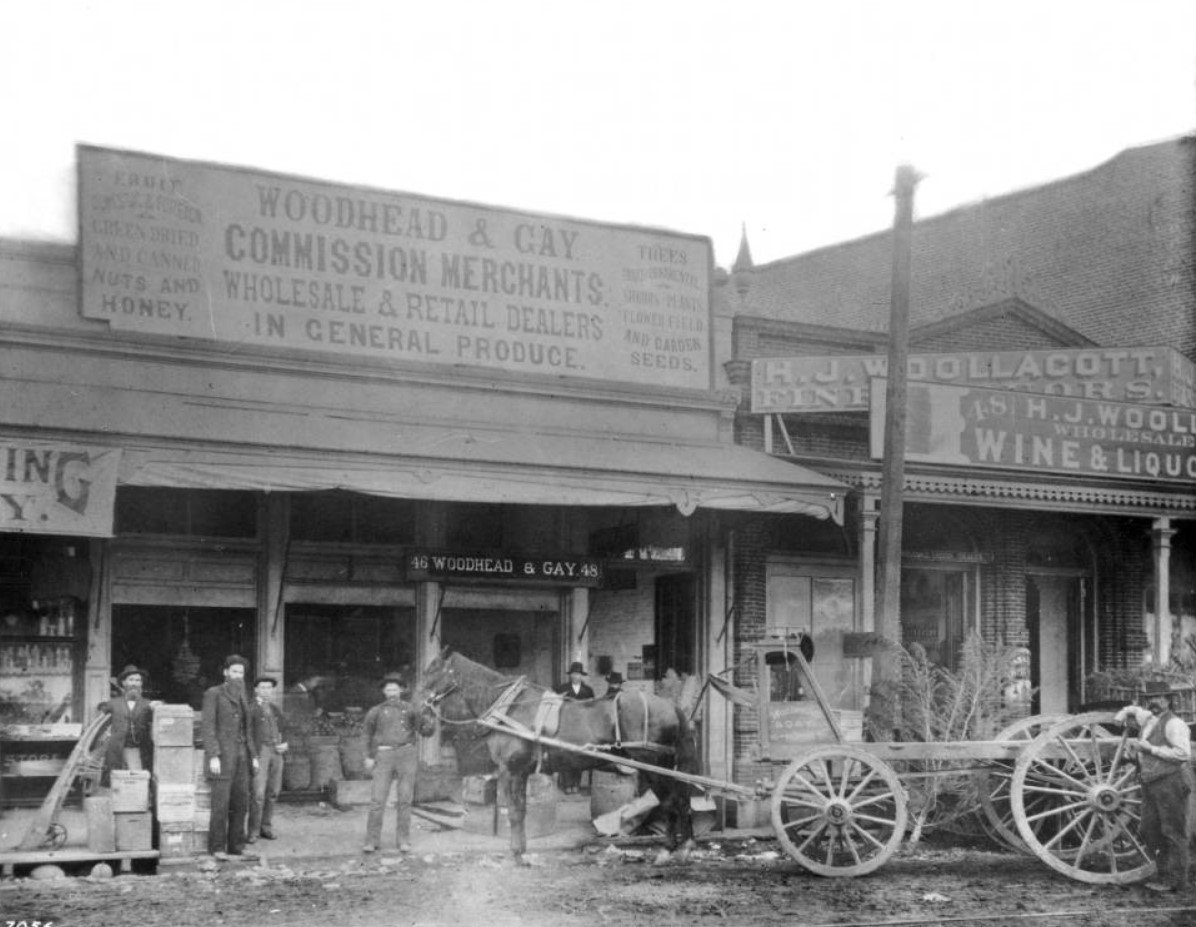 |
|
| (ca. 1880)* – View showing several people posing for the camera as they stand next to a horse-drawn wagon and in front of the Woodhead and Gay Store at 46 and 48 N. Spring Street. The tall wall in the background is the side of the 3-story building occupied by H. Jevne Grocery (see previous photo). The H.J. Woollacott liquor store is also visible to the right.; Signs include: "Fruit Domestic & Foreign / Green Dried and Canned Nuts and Honey", "Woodhead & Gay Commission Merchants. Wholesale & Retail Dealers in General Produce.", "Trees Fruit and Ornamental / Shrubs, Plants, Flower, Field and Garden Seeds.", and "H.J. Woollacott, Fine Liquors / Wholesale Wine & Liquor". Photo: C.C. Pierce |
Historical Notes This view captures everyday life on North Spring Street at a time when the street was lined with small shops serving a growing town. The Woodhead and Gay store sold fruit, produce, seeds, and plants, supplying both local families and farmers coming in from the countryside. Signs on the building advertised fresh and dried fruit, nuts, honey, and seeds of every kind. The photo also shows part of the tall wall of the H. Jevne grocery building next door, evidence that this block was becoming a cluster of food and produce businesses. The men standing near the wagon represent the small staff typical of these early stores. According to notes kept with the photograph, Mr. Bell was the bookkeeper and L. E. Myers was the head clerk. Their work would have involved long hours, direct contact with customers, and handling goods brought in by horse drawn wagons from the surrounding ranches and orchards at a time when Los Angeles was still closely tied to agriculture. |
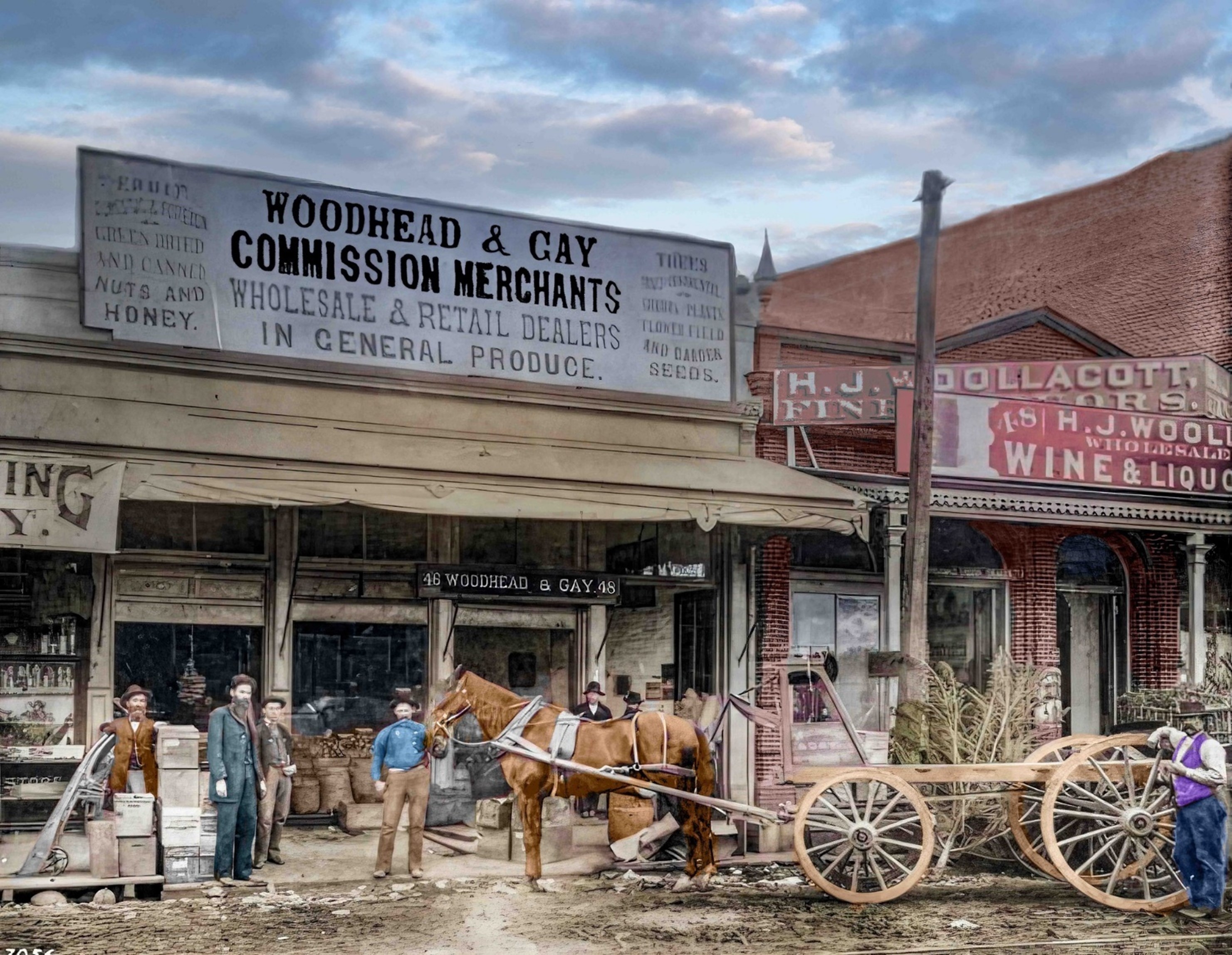 |
|
| (ca. 1880)* – View showing several people posing for the camera as they stand next to a horse-drawn wagon and in front of the Woodhead and Gay Store at 46 and 48 N. Spring Street. The tall wall in the background is the side of the 3-story building occupied by H. Jevne Grocery (see previous photo). The H.J. Woollacott liquor store is also visible to the right.; Signs include: "Fruit Domestic & Foreign / Green Dried and Canned Nuts and Honey", "Woodhead & Gay Commission Merchants. Wholesale & Retail Dealers in General Produce.", "Trees Fruit and Ornamental / Shrubs, Plants, Flower, Field and Garden Seeds.", and "H.J. Woollacott, Fine Liquors / Wholesale Wine & Liquor". Photo: C.C. Pierce; Image enhancement and colorization by Richard Holoff |
Historical Notes The colorized version brings out details in the storefronts and signage that are easy to miss in the original image. Trees, shrubs, flowers, and garden seeds were major parts of the business, showing how important home gardening and small scale agriculture were to residents. To the right, the H. J. Woollacott liquor store advertised fine wines and spirits. Stores like Woollacott’s catered to hotels, restaurants, and saloons throughout early Los Angeles. Together, these buildings show how varied commerce was along this block of Spring Street. Produce merchants, grocers, and liquor dealers operated side by side, and many shops had both wholesale and retail customers. This mixture of businesses helped Spring Street grow from a dusty road into one of the earliest commercial centers of the young city. |
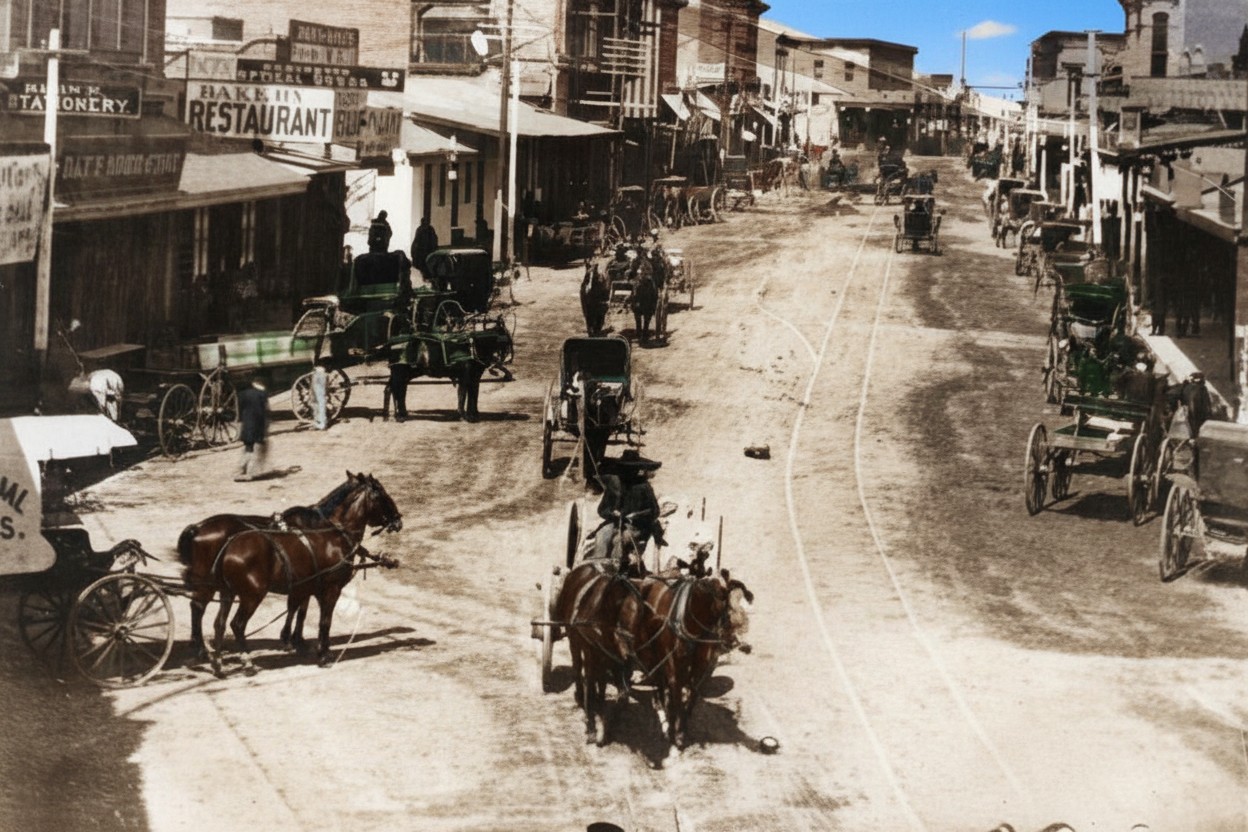 |
|
| (1885)* - Spring Street near First looking north. Horse-drawn wagons are seen throughout the commercial area on Spring Street. Large sign in the upper left reads: BAKERY - RESTAURANT |
Historical Notes By 1885 Spring Street was busier but still unpaved, with horse drawn wagons parked along the curbs and moving in every direction. The businesses seen here served a growing downtown population that depended on fresh bread, prepared food, and daily supplies. A prominent sign for a bakery and restaurant reflects the simple eating places that travelers, workers, and residents relied on before the city had more formal dining establishments. Although it has a frontier appearance, Los Angeles was already expanding quickly. Buildings were becoming larger, streetcar lines were being extended, and new banks and offices were opening. This view captures the moment just before major development reshaped the area. |
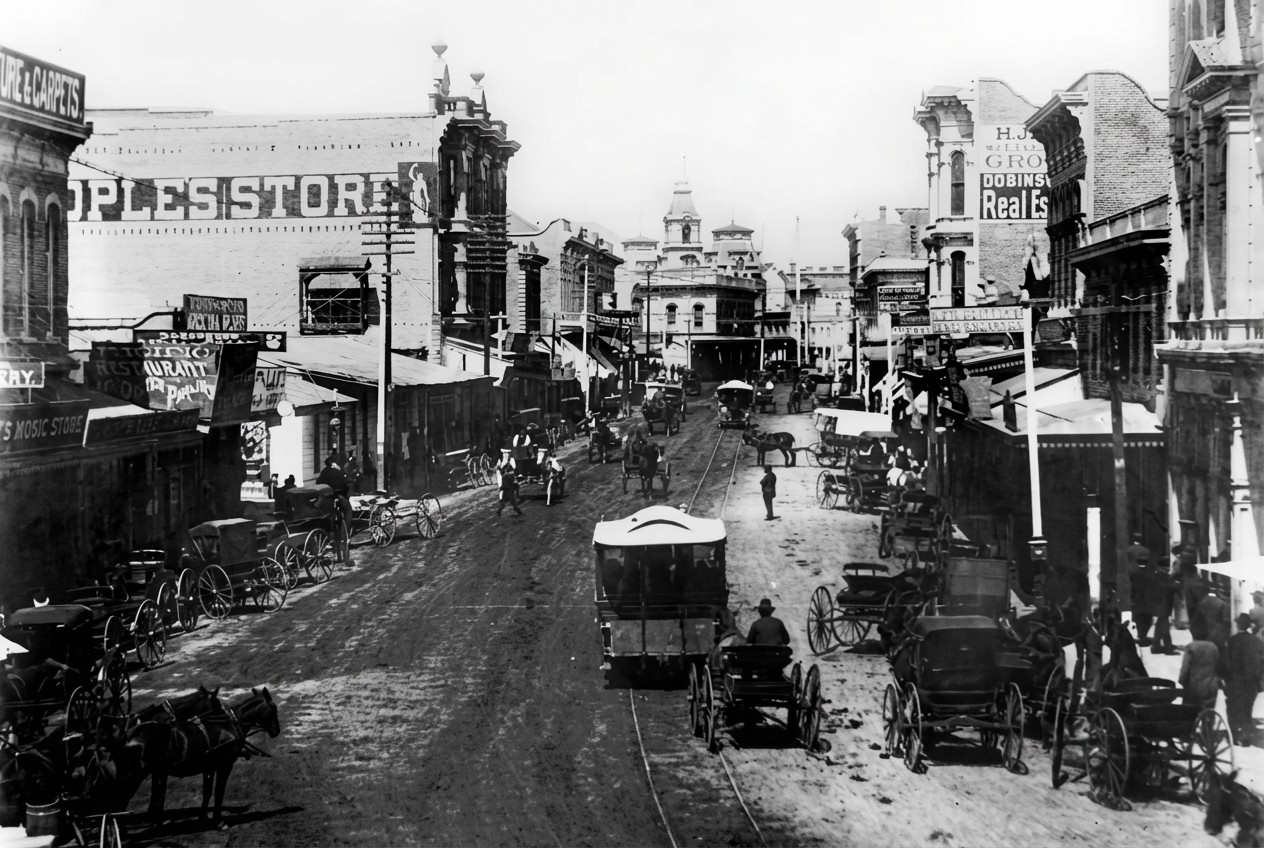 |
|
| (ca. 1885)* - View of Spring Street looking north from 1st Street. Horse-drawn carriages occupy most of the parking spots along the curbs while several horse-drawn street cars travel down the street. The A. Hamburger and Son's People's Store is seen on the left. The tall copula seen in the distance is part of the Baker Block. |
Historical Notes A. Hamburger and Sons was one of the first department stores to operate in Los Angeles. Originally known as A. Hamburger & Son's People's Store, the name later changed to Hamburger's Store. In 1908 the company relocated their store from Spring Street to a newer building located at Broadway and Eighth Street. May Department Stores acquired Hamburger's in 1923 and renamed it the May Company. |
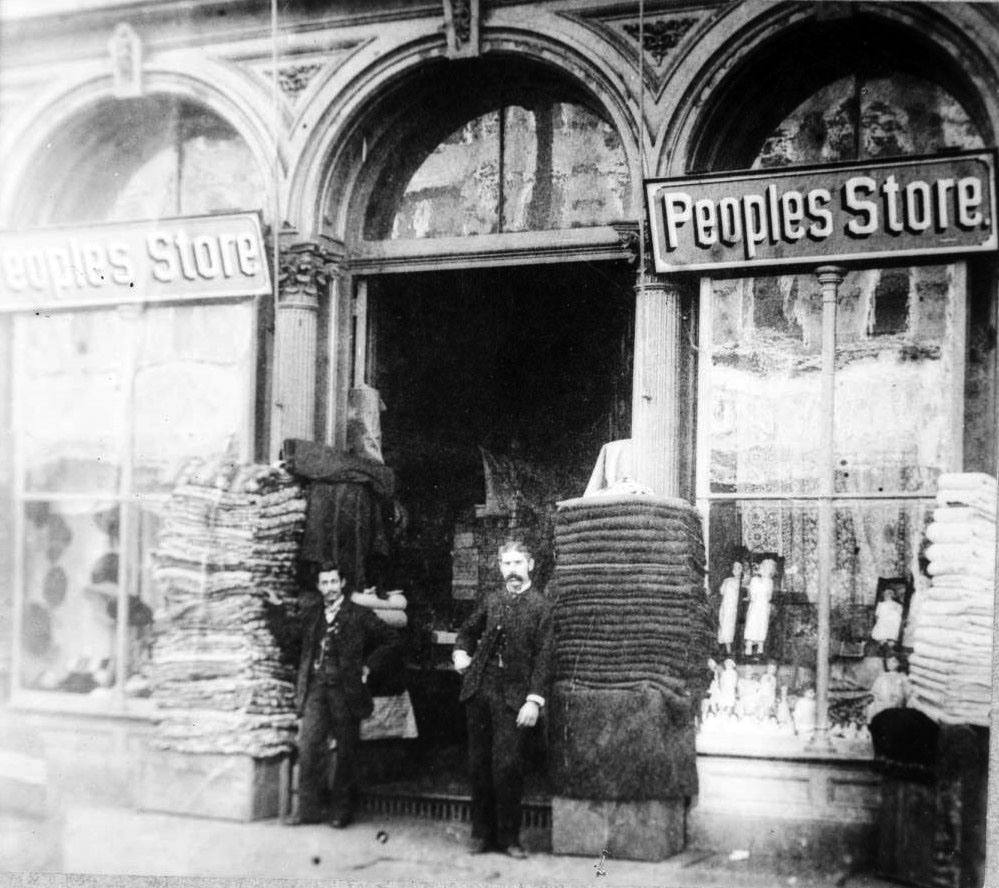 |
|
| (ca. 1880s)* – Two men pose for the camera in front of the People’s Store. |
Historical Notes People's Store (later Hamburger's Department Store) was located in the Phillips Block until 1903. It then relocated to a new, larger building located on the SW corner of Broadway and 8th Street.. At the time it was the largest department store building west of Chicago. The store was acquired from A. Hamburger & Sons Co. by David May in 1923 and renamed the May Company. |
.jpg) |
|
| (1885)* - Spring Street near First looking north. Schumacher Block is visible in left foreground. The copula of the Baker Block (built in 1878) can be seen in the distance. Horse-Drawn Streetcars and wagons are seen throughout. |
Historical Notes This view shows the Schumacher Block in the left foreground. John Schumacher was an early Los Angeles resident who bought the land for this block with a gold nugget he found during the gold rush. His building became one of the early landmarks of Spring Street, marking the area as a developing business district. Horse drawn streetcars and wagons fill the street, showing how transportation in the city was still dependent on animal power. The cupola of the Baker Block can be seen in the distance, rising above the older and more modest structures. Within just a few years, taller and more elaborate buildings would replace much of this early streetscape as Los Angeles entered a period of rapid growth. |
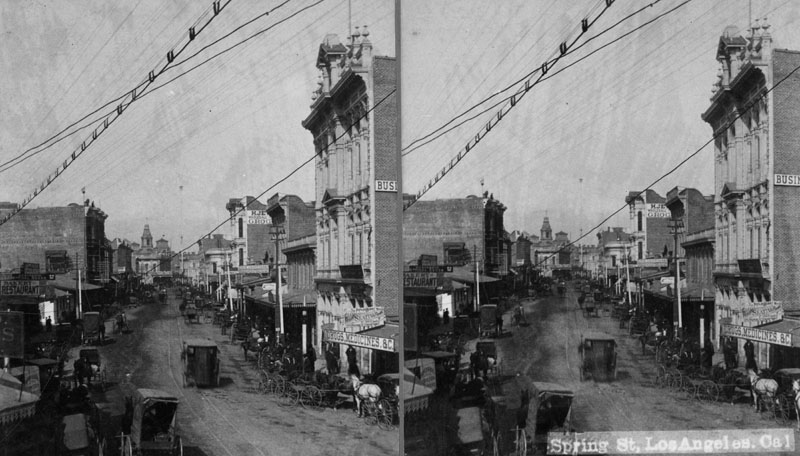 |
|
| (ca. 1884)^ - Stereoscopic view of Spring Street looking north. Horse and buggy transportation is seen on the unpaved road. |
Historical Notes This stereoscopic image captures Spring Street when it was still unpaved and lined with small shops. The view shows an active mix of wagons, riders, and pedestrians. Despite its rough appearance, this stretch of Spring Street was already becoming one of the main routes through downtown Los Angeles. The mix of frame buildings and newer brick structures shows a city in transition. Residents depended on horses for transportation, and streets were often dusty in summer and muddy in winter. Scenes like this changed quickly as street grading, paving, and electric lighting began to spread through the district. |
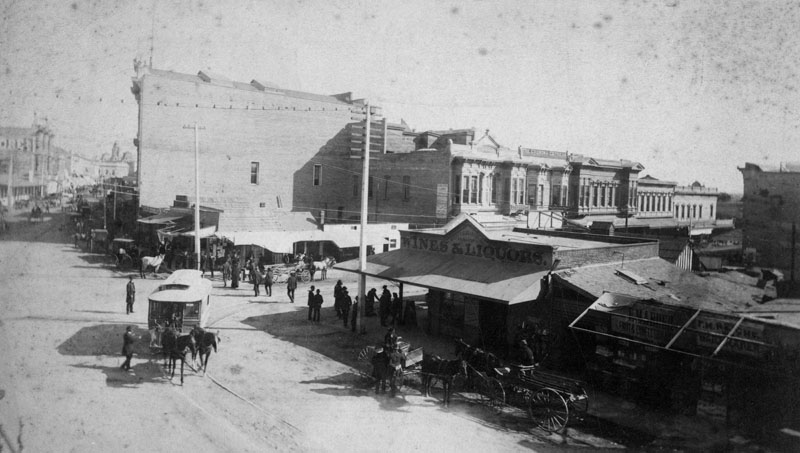 |
|
| (1884)^ - Looking north on Spring and east on First Streets in 1884. Horse-drawn streetcar can be seen turning onto Spring Street. The sign on the building (right-center) reads: WINES & LIQUORS. The short-lived Los Angeles National Bank Building was constructed on the NE corner in 1887. In 1906, it was replaced with the 7-story Equitable Savings Bank Building. |
Historical Notes This view looks north on Spring Street and east on First Street. A horse drawn streetcar is seen turning the corner, serving riders who needed a dependable way to travel between the growing residential neighborhoods and the business district. The building on the right bears a simple Wines and Liquors sign. Such establishments were common on the edges of commercial centers and catered to both travelers and workers. The empty corner at the northeast would soon become the site of the Los Angeles National Bank Building in 1887. That bank building, later replaced by the Equitable Savings Bank, marked the beginning of a more formal financial district along Spring Street, which would eventually become known as the Wall Street of the West. |
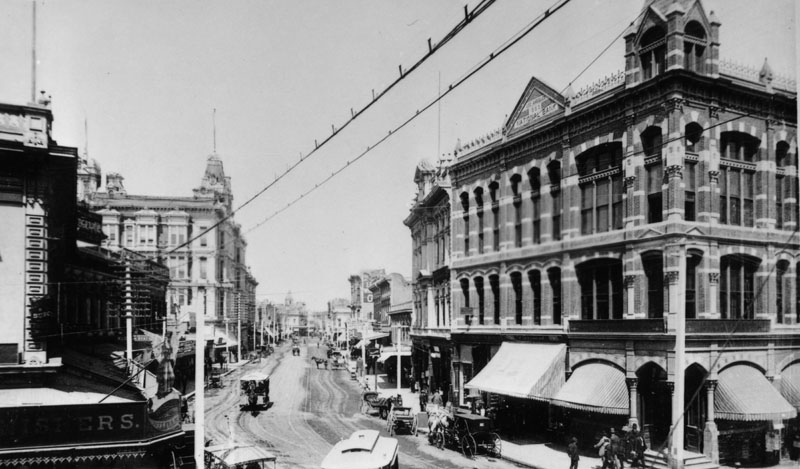 |
|
| (1887)^ - Spring St. looking north from Nadeau Hotel located on the southwest corner of 1st and Spring. Los Angeles National Bank is on the northeast corner (on the right), near where City Hall is today. The ornate 4-story building at center-left is the Phillips Block, built in 1887. Horse-drawn streetcars and carriages can be seen throughout. |
Historical Notes The 1887-built, 4-story Phillips Building replaced another large building at the same location (seen in previous photos) that housed Hamburger & Son's People's Store, at the time, LA's largest Department Store. The People's Store would remain in the new ornate Phillips Block building until 1908, when the store moved into its newly constructed building on the SW corner Broadway and 8th Street. May Department Stores would acquire Hamburger's in 1923 and rename it the May Company. |
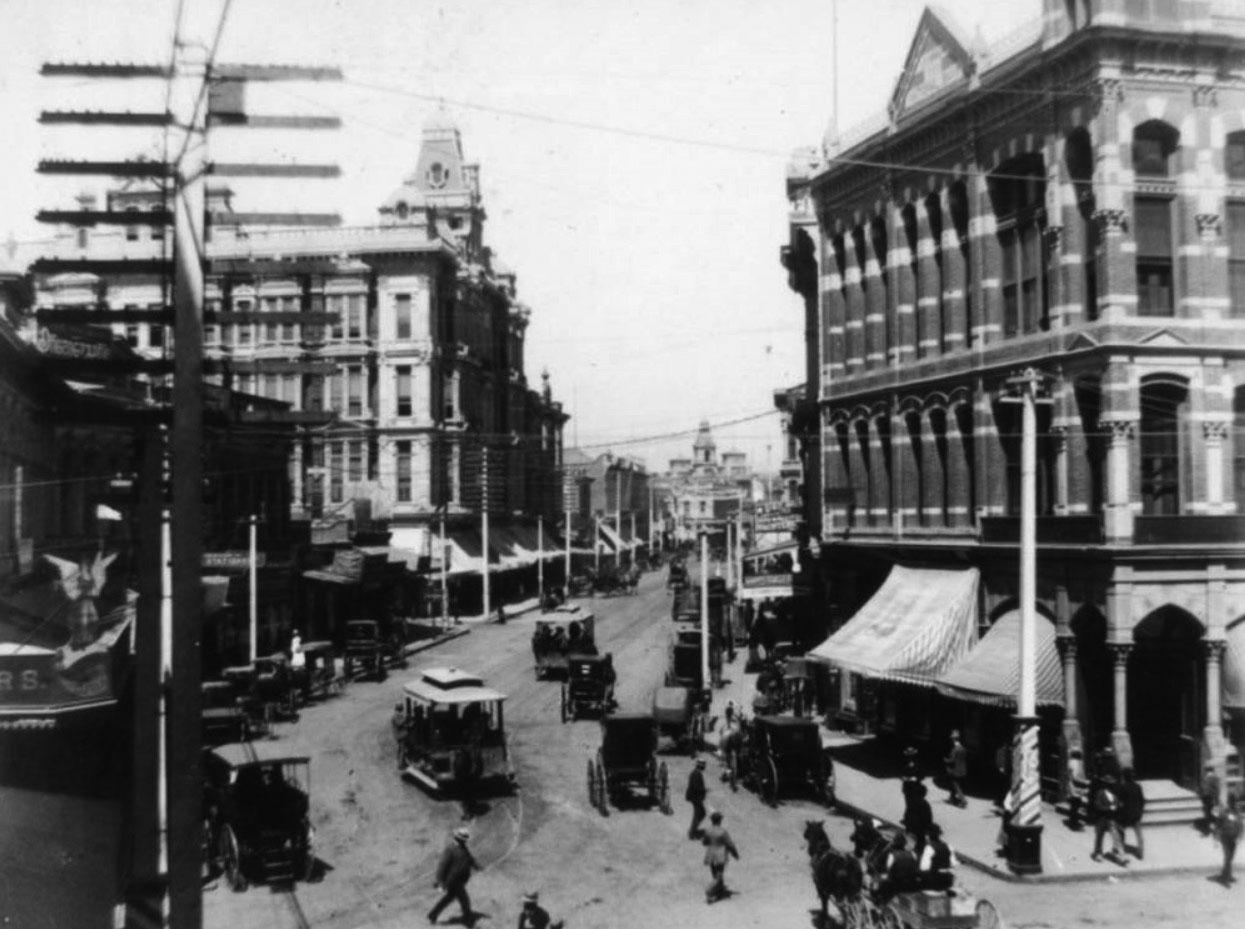 |
|
| (ca. 1888)^ - View looking down Spring Street from 1st Street. Los Angeles National Bank Building is on the northeast corner on the right. Down the block (center-left) is the 1887-built French Renaissance-style Phillips Block who's main tenant was the Hamburger & Son's People's Store. In the far distance can be seen the main cupola of Baker Block located on Main Street. |
Historical Notes Completed in 1887, the Los Angeles National Bank Building was designed by Kysor & Morgan in the "Modern Gothic" style, included a basement and cost $65,000 to build. The building materials were granite, iron and pressed brick. The bank was organized in 1883 and later merged, along with Southwestern National Bank, with First National in 1905. The Equitable Savings Bank then occupied the premises and replaced the building with a seven-story structure (Equitable Building).
|
Then and Now
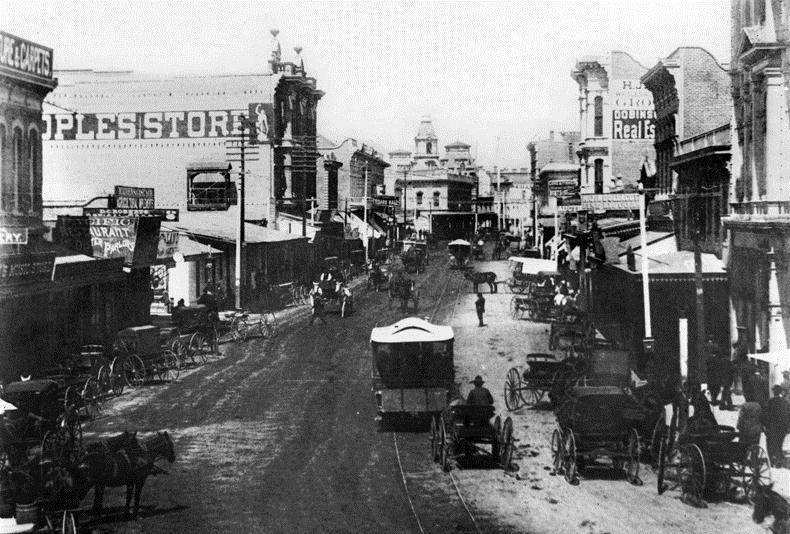 |
|
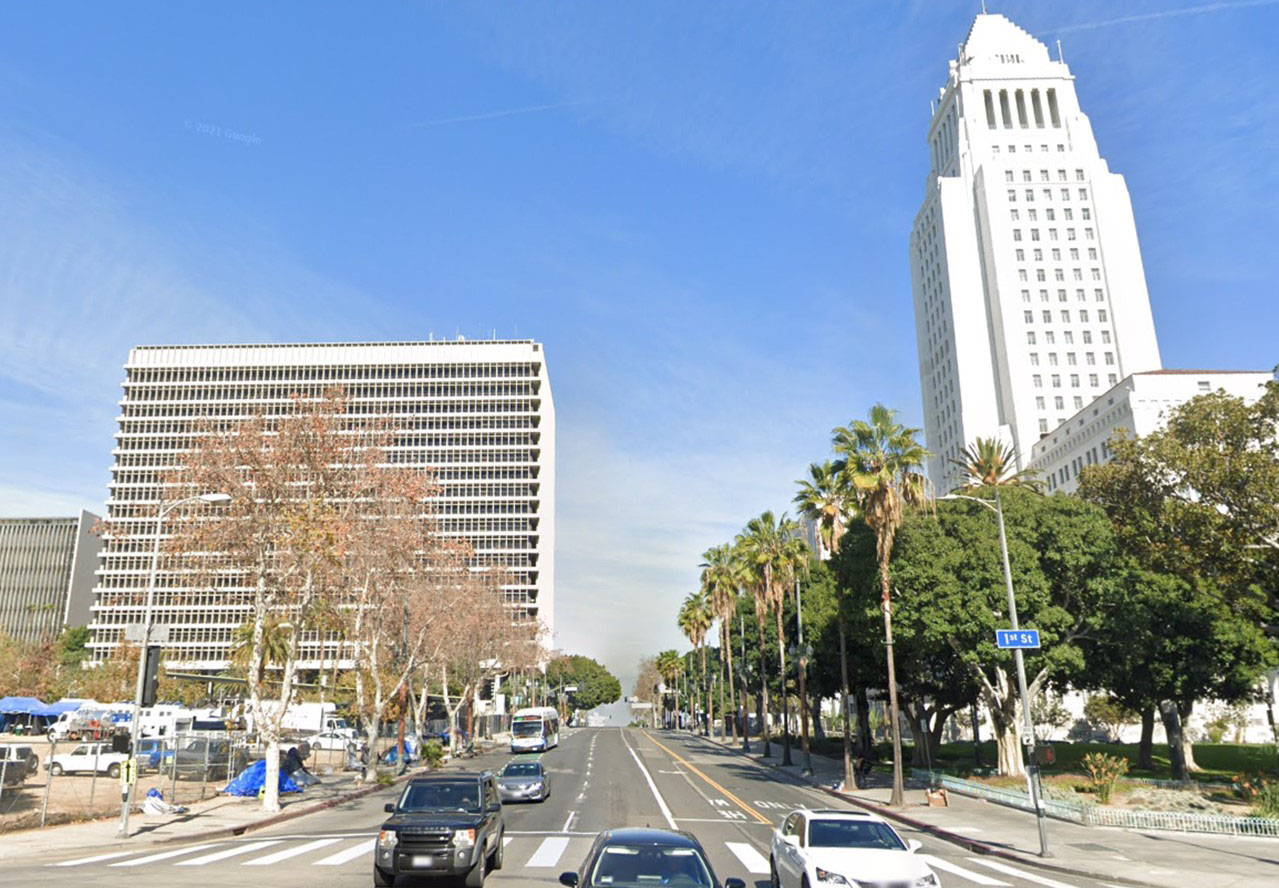 |
|
| (1885 vs. 2021) - Spring Street looking North from 1st Street. Photo comparison by Jack Feldman. |
Historical Notes The 1885 view of Spring Street shows a young Los Angeles that still felt close to its frontier beginnings. The street was unpaved and filled with wagons, horses, and early streetcars. Small shops, produce dealers, and simple brick buildings lined both sides of the block. In the distance the tall cupola of the Baker Block rose above the older structures, serving as a landmark for people traveling through the city. Spring Street at this time was only beginning to develop into a commercial corridor, but the growing presence of banks, grocery houses, and department stores showed that change was on the way. The modern view tells a very different story. Spring Street has long since been paved, widened, and rebuilt with taller buildings that reflect the growth of Los Angeles from a town of a few thousand residents into a major metropolitan center. Little remains of the early streetscape. The skyline is filled with office buildings, and City Hall now stands just beyond the point where the early bank buildings once sat. What was once a dusty road lined with wagons has become a fully developed urban street, yet the angle of the view still follows the same alignment that early residents knew well. |
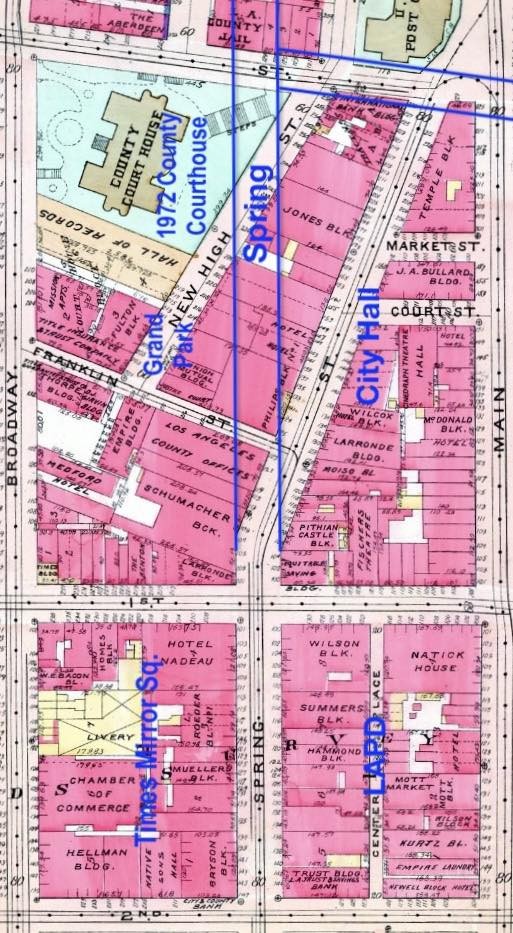 |
|
| (1927)* - Map comparing Spring Street’s original alignment with the new route created to clear space for Los Angeles City Hall. |
Historical Notes Spring Street was realigned in 1927 to accommodate construction of the new City Hall. By 1931, the street would also be extended north of Temple Street all the way to Sunset Boulevard, removing most of the buildings in its path—including the Los Angeles County Jail. Click HERE to see more. |
* * * * * |
First Street (looking East from Hill Street)
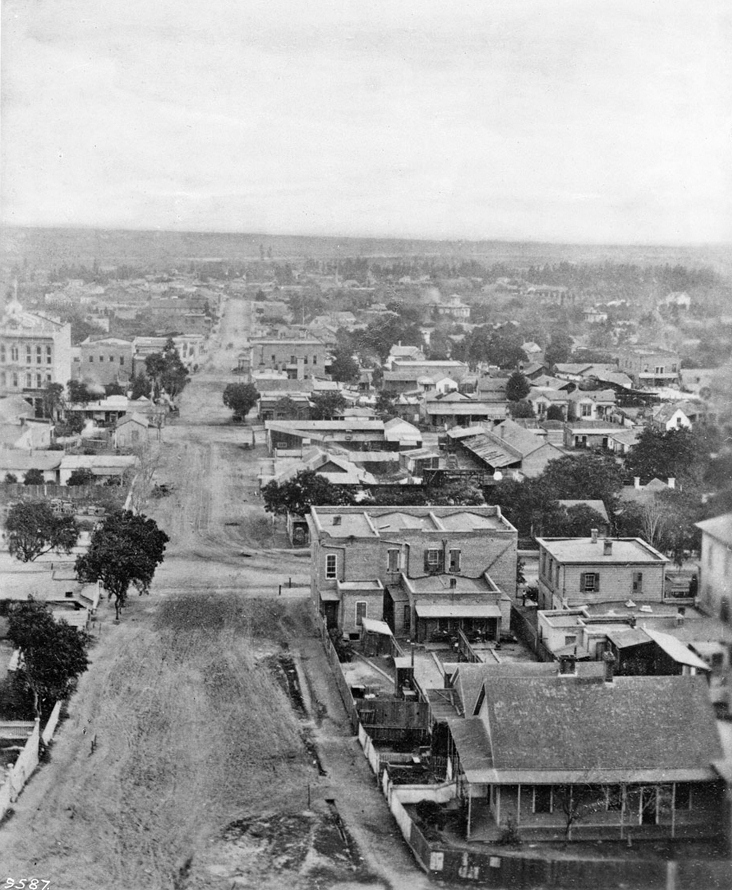 |
|
| (ca. 1870)^ - Looking east on First Street toward Broadway. |
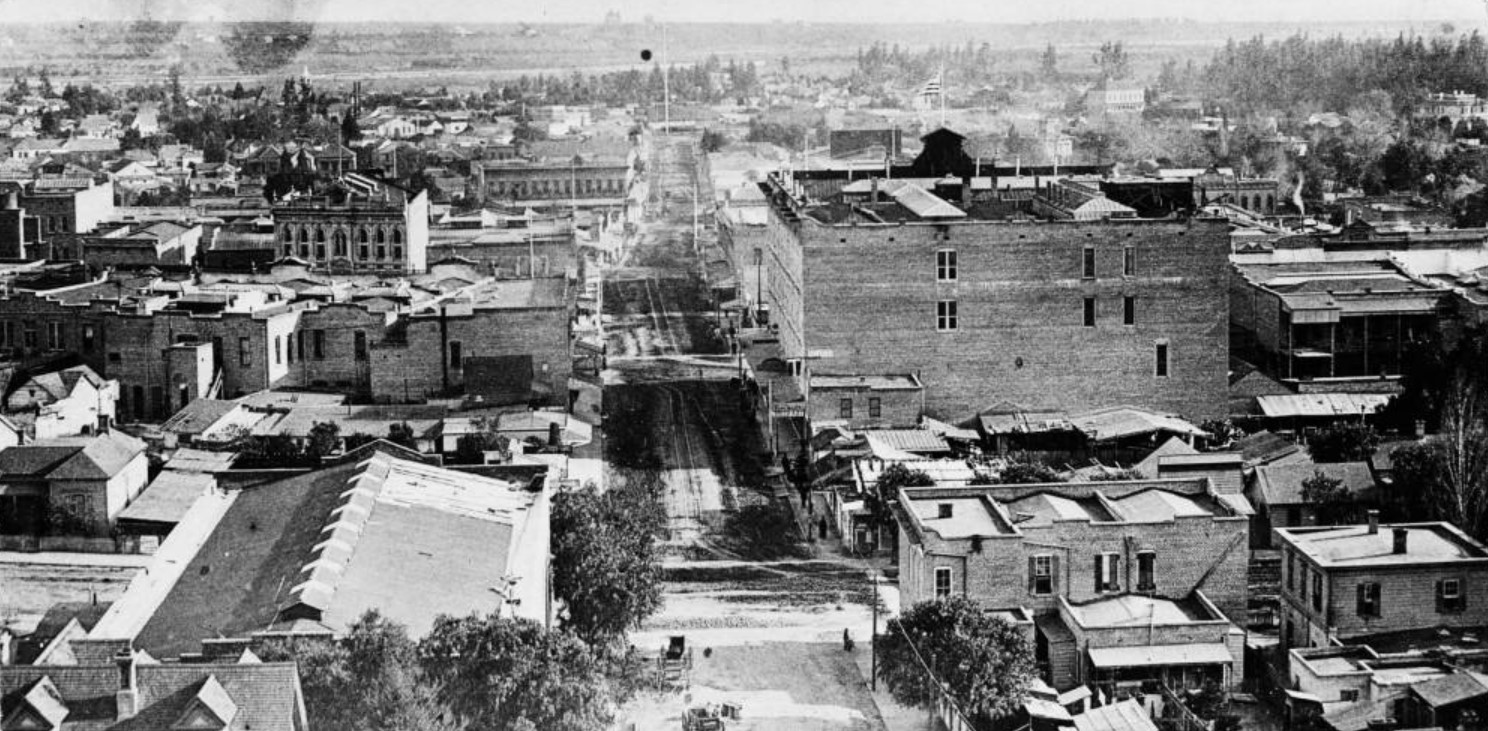 |
|
| (1884)^^ - Panoramic view looking east on First Street from Hill Street, showing the 4-story Nadeau Hotel located on the southwest corner of First and Spring streets. |
Historical Notes The photograph's dominant structure is the Hotel Nadeau, while the Natick House can be seen further east on First and Main Streets. The photograph features the following buildings: De Turk's Livery, Feed & Sale Stable (built before 1880), it's a larger building at lower left, on the north-west corner of First Street and Broadway; Hotel Nadeau (1882-1931), a large building in right center, located at the southwest corner of First & Spring Streets; Larronde Block (built in 1883), located across First Street from Nadeau Hotel, on the north-west corner with Spring Street. Schumacher Block (1880 - ca.1931), to the left of the Larronde Block, on Spring Street. Natick House (built in 1883), to the left of Nadeau, on the southwest corner of First and Main Streets; Pithian Castle Block (built in 1877) can be seen directly above Schumacher Block, with tall, narrow windows, located on Spring Street just north of First Street.^^ |
Spring and 1st Street
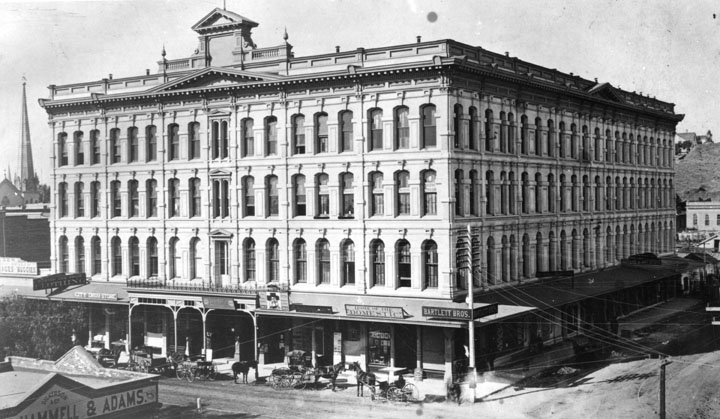 |
|
| (1886)^ - View of the Nadeau Hotel on the southwest corner of Spring and 1st streets. A row of horses & carriages is lined up on the street in front. A tall narrow church spire can be seen in the background on the far left. |
Historical Notes Remi Nadeau was a French Canadian pioneer who arrived in Los Angeles in 1861 driving a team of oxen. During the silver-mining excitement in the Cerro Gordo region of Inyo County his teamster operation brought tons of silver to Southern California and hauled back food and supplies to the miners. By 1873 he operated 80 such teams. In 1882, Remi Nadeau built the Nadeau Hotel, Los Angeles's first four-story structure and the first building with an elevator. The hotel was designed by Morgan & Walls. |
Spring and 2nd Street
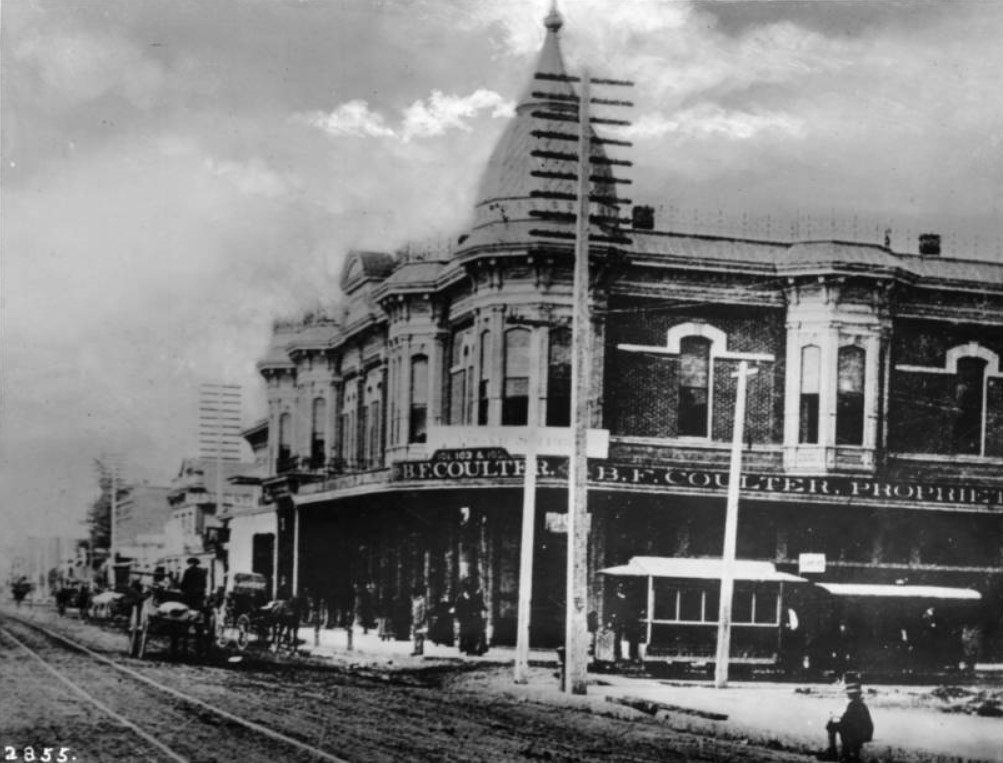 |
|
| (1886)* - View of the southwest corner of Spring and Second streets showing the B.F. Coulters store on the ground floor of the Hollenbeck Hotel. A streetcar is stopped along Second Street. A series of utility poles are visible looking up Spring Street in front of the store. Horse-drawn wagons, carriages, and pedestrians are on the dirt street and sidewalk. Legible signs include: "101, 103 & 105, B.F. Coulter, proprieter"; "Coulters Store in the Baker Block is to be closed Feb. 1 and all business of the firm will hereafter be done in the Hollenbeck block, corner Spring & Second Streets" -- 10 January 1886. |
Historical Notes B. F. Coulter was one of the earliest merchants in Los Angeles. The Coulter's Dry Goods business dates from 1878 and later was called Coulter's. Coulter was an ordained minister and founded the Broadway Christian Church. The business was continued by B.F. Coulter's son-in-law, R. P. McReynolds, and his son, James McReynolds. |
Main Street
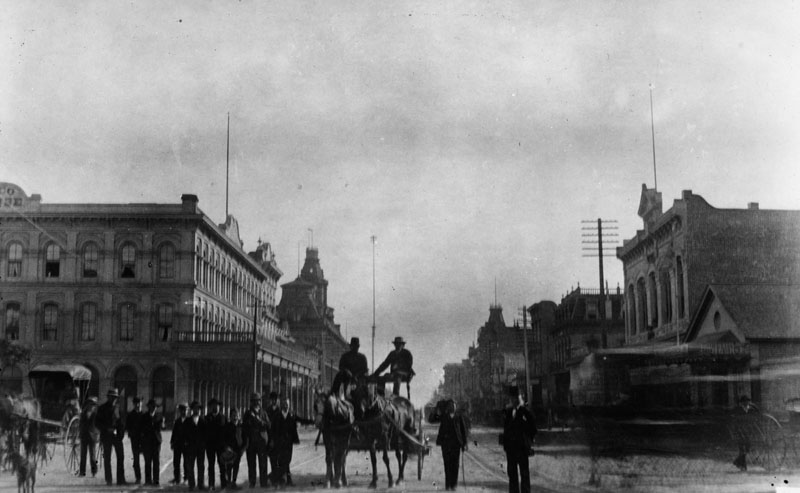 |
|
| (1883)^ - A group of men are seen posing for the camera in the middle of Main Street. The view is looking south on Main Street with the Pico House on the left. The tower of the Baker Block can be seen in the background. |
Historical Notes The tall pole seen between the two men sitting on the wagon is not a flagpole. It is a 150-foot electric street light mast that was one of the first to be installed in the City of Los Angeles. Click HERE to read more about it in Early Los Angeles Street Lights. |
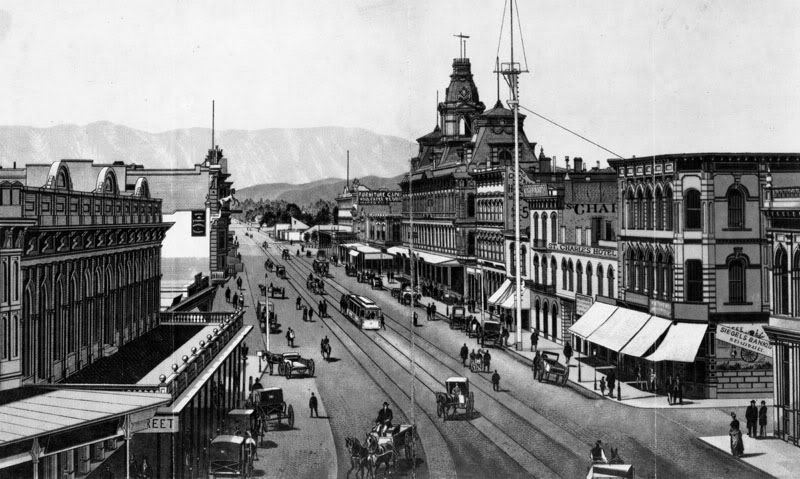 |
|
| (ca. 1880s)^ - Main Street looking north from atop the Temple Block. Baker Block is just right of center. This vantage point is now occupied by City Hall. The tall poll (center right) is one of the first of seven electric light poles installed in the City of Los Angeles. They were 150 feet tall! |
Historical Notes Each of the 150-foot-high masts carried three electric lights of three thousand candle-power. All seven lamps and a small power plant to provide the electricity were installed by C. L. Howland who later formed the Los Angeles Electric Company. By 1883, Los Angeles became the first city in the USA to entirely abandon gas for street lighting and replace it with electricity. The Los Angeles Electric Company later became the Los Angeles Gas and Electric Corporation and survived until it was bought out by the DWP in 1936. |
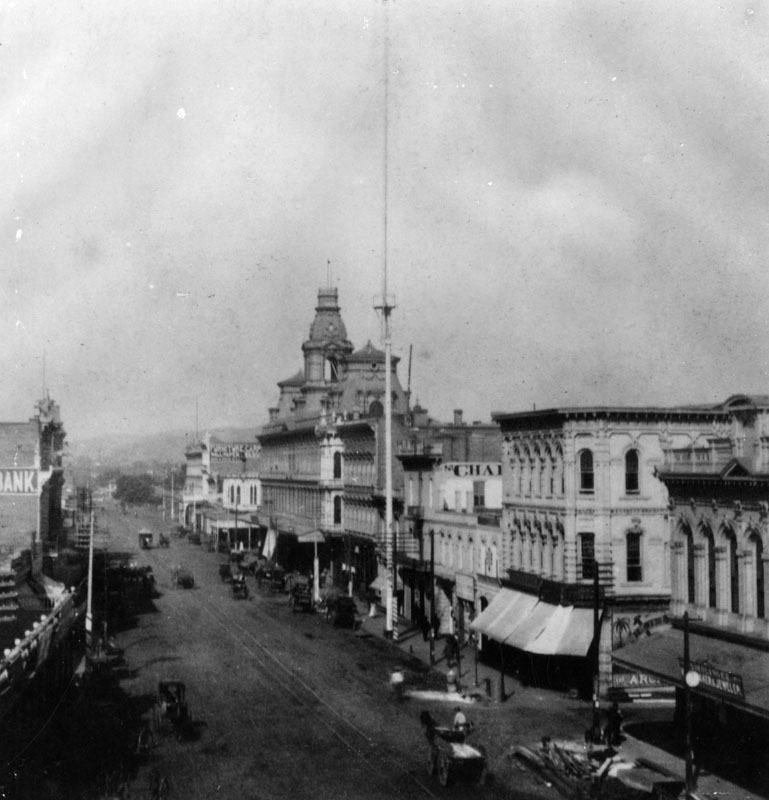 |
|
| (ca. 1882)^ - Main Street looking north from Commercial Street. A number of horse-drawn vehicles are in the street as well as parked at the curb. The St. Charles Hotel is on the right.The City's new 150-ft. tall streetlight pole can be seen in center of photo. |
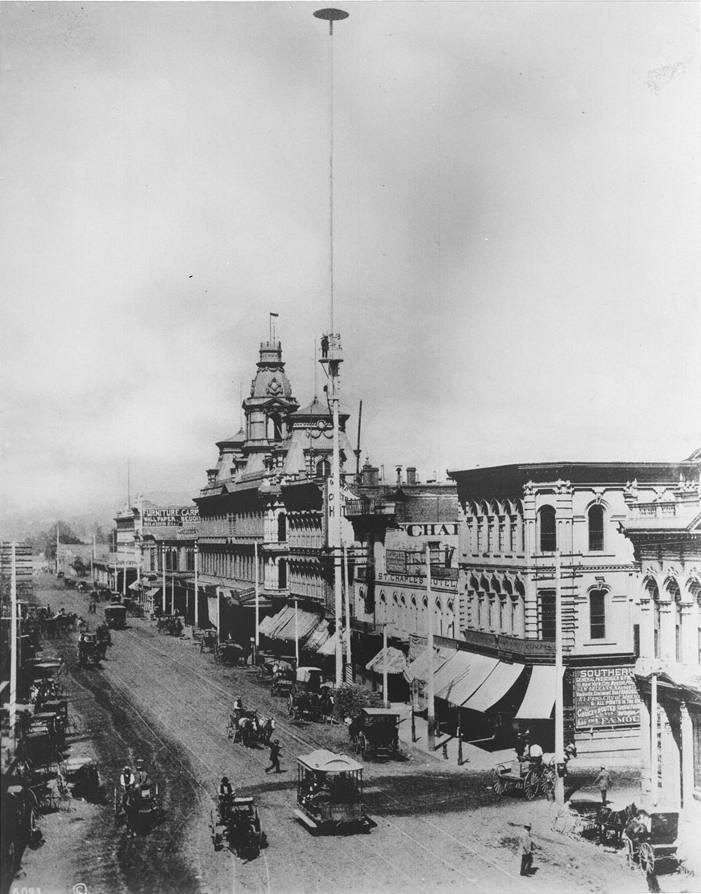 |
|
| (1882)* - One of the first of seven electric street lights installed in the City of Los Angeles at Main and Commercial in 1882. A man can be seen standing on a platform half-way up the pole. |
Click HERE to see more in Early Los Angeles Street Lights |
* * * * * |
Spring and Temple Streets (looking West)
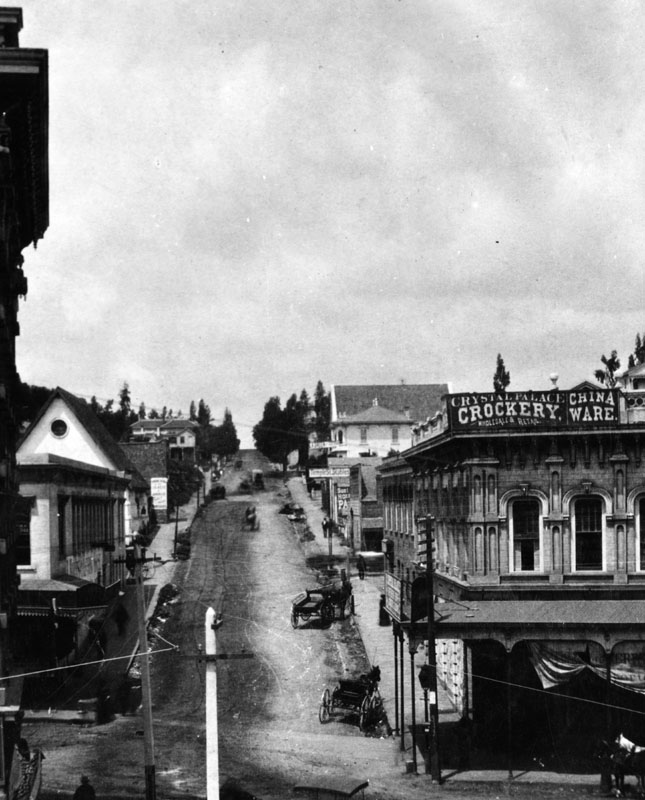 |
|
| (ca. 1884)* - View of an unpaved Temple Street, looking west from the second floor of the Temple Block on Spring Street. Horse-drawn carriages and wagons are parked along the street. In the right foreground is the Downey Block on the northwest corner, housing the Crystal Palace, wholesale and retail sellers of crockery and china ware. Behind it is the Temple Street Stables. Poles strung with electric wires are seen in the foreground. |
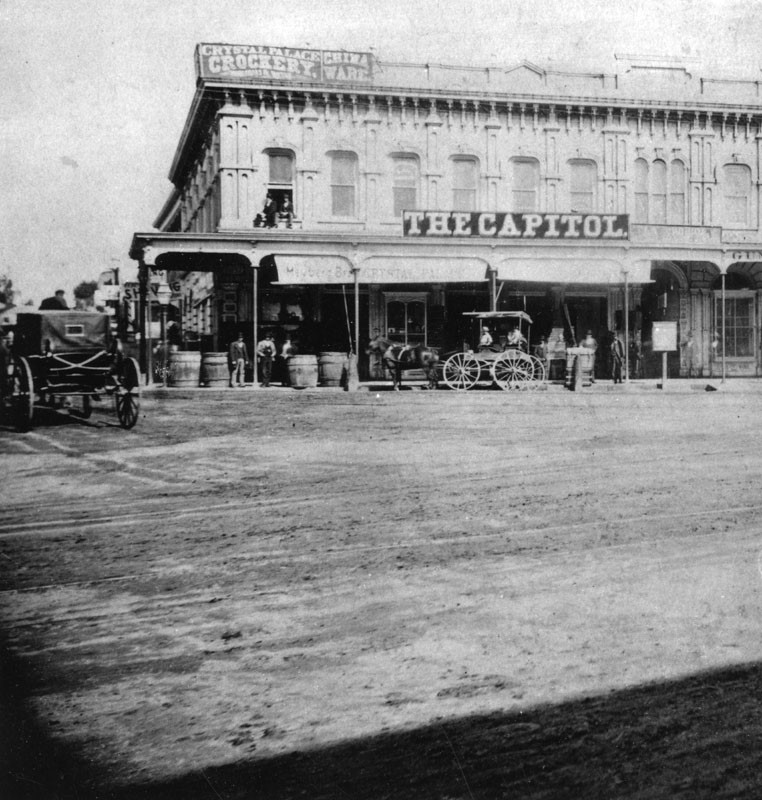 |
|
| (1880s)^ – View of the Crystal Palace Crockery store located on the northwest corner of Temple and Main streets as seen from the front of Temple Block. The building, also known as Downey Block, is two stories with a large sign over the portico that reads: THE CAPITOL. Two men are sitting on the window ledge at upper left-center. A horse and buggy is parked in front of the building while another appears to be moving west on Temple. |
* * * * * |
Main, Temple, and Spring Street Junction
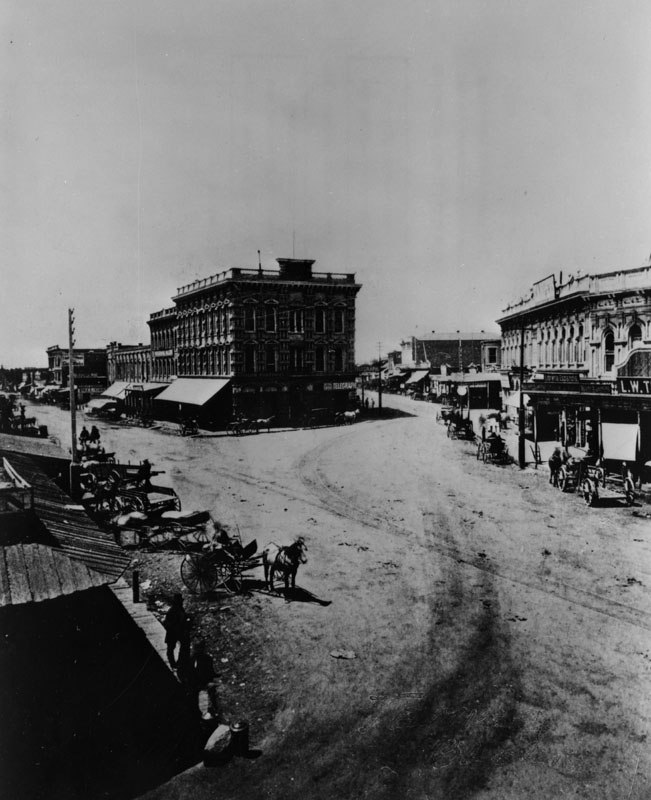 |
|
| (1870s)* - A view of Temple Block at the junction of Main, Temple and Spring streets in 1870. Horse-drawn wagons and carriages can be seen on both sides of the street. The Downey Block is at the right of photo. |
Historical Notes Main Street was dedicated in 1849. The community's first Calle Principal connected the San Gabriel Mission with the San Fernando Valley and many established ranchos. One section near the Plaza was known as Bath Street after, legend has it, the facilities featuring "scarlet women." Spring Street was dedicated in 1849. As legend has it, it was named Calle Primavera by Lt. Ord to honor his sweetheart in Santa Barbara, Trinidad Ortega, whom he called "Primavera," Spanish for "Springtime." He never married Ortega, the granddaughter of Jose Francisco Ortega, the Spanish explorer who "discovered" San Francisco Bay. Temple Street was named after John Temple in 1859, who opened the first store in Los Angeles. He built a block of shops, lawyers' offices and a saloon at Main and Temple streets, where Los Angeles City Hall stands today. |
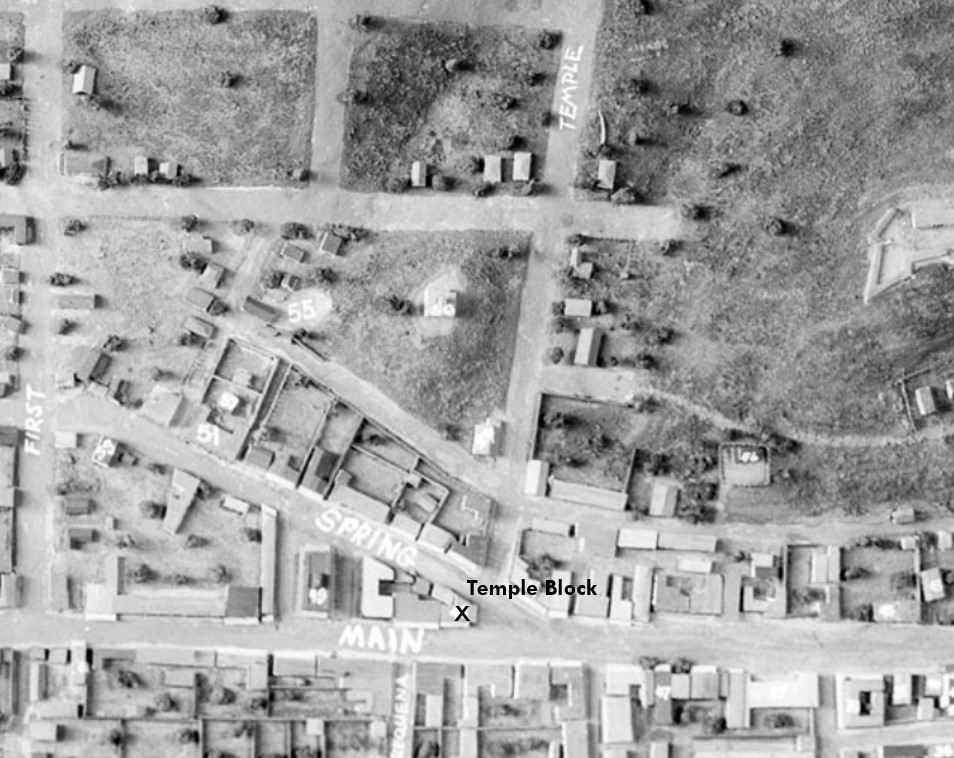 |
|
| (n.d.)* - Temple Square (Temple Block) appears at the bottom-center of this photograph of a model of old Los Angeles. This would become the future site of the current City Hall. |
Historical Notes Spring Street was realigned when construction of the new City Hall began in early 1927. Spring now runs parallel to Main, and intersects with Temple where the current 28-story City Hall building is now located. |
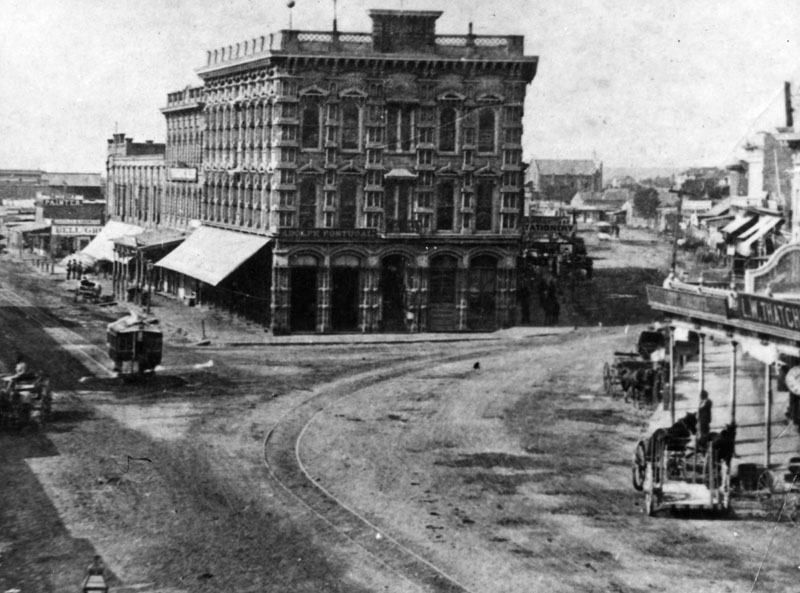 |
|
| (ca. 1876)* - Spring Street at junction of Main Street, circa 1876. A sign on the three story building (Temple Block) at the head of the junction reads "Adolph Portugal". A few horse-drawn vehicles can be seen. |
Historical Notes The Italianate Temple block was built in 1871 by Francis Pliny Fisk Temple on the site of the old Temple Block, inherited from his older brother John in 1866. It was commonly known as the Lawyer's Block as so many attorneys had offices there. The old Clocktower Couthouse, at that time, was situated immediately to the south. As there was very little waiting room at the courthouse, attorneys went back to their offices until their cases came up. They were summoned by a court clerk hollering their names out the second-story windows of the court. |
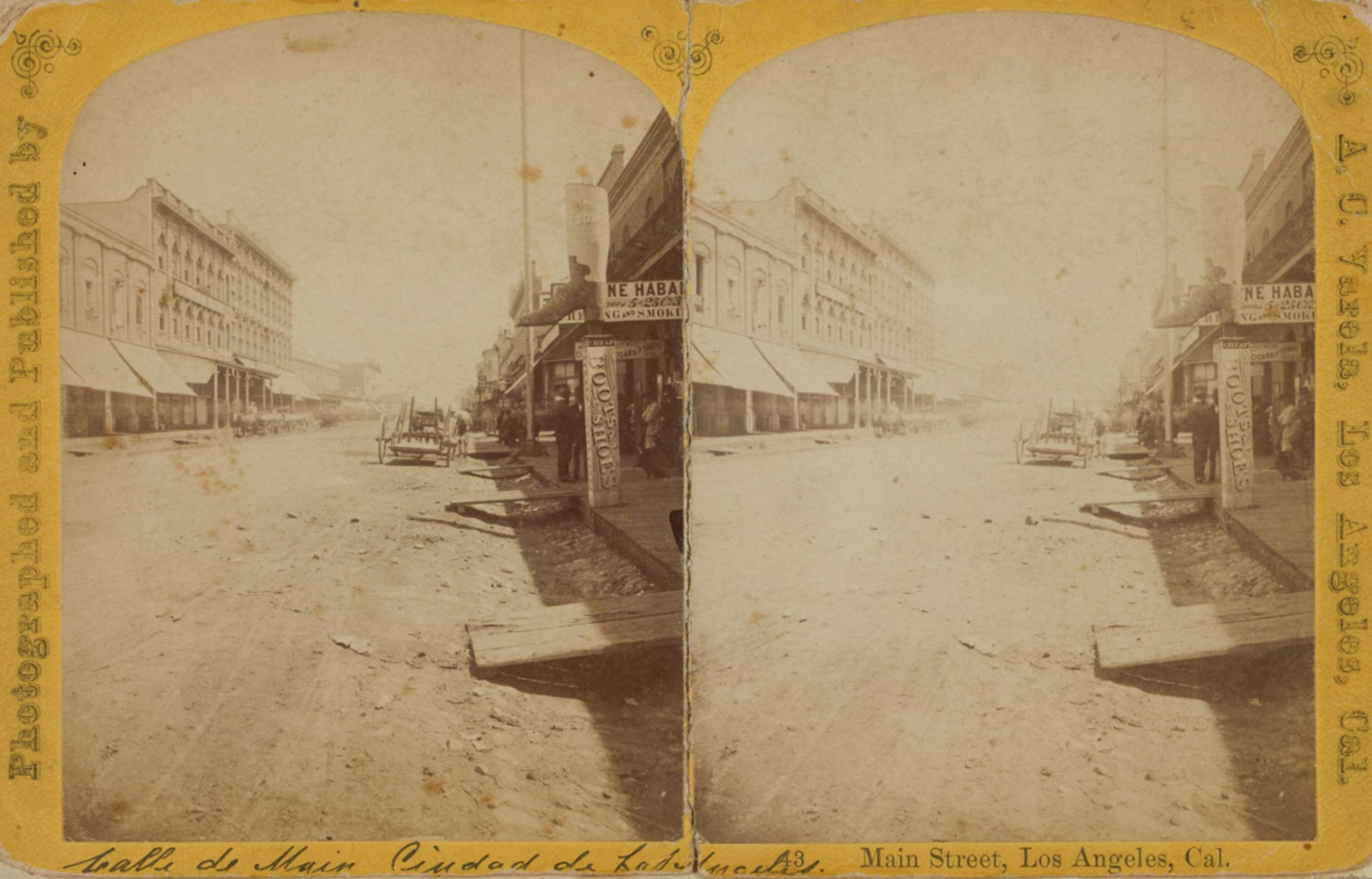 |
|
| (ca. 1878)* – Stereoscopic image looking north on Main Street in downtown Los Angeles, just south of Requena Street (later Market Street). At center left stands the northernmost three-story Italianate section of the Temple Block, with two adjacent buildings of decreasing height that also formed part of the Temple Block complex. The nearest two-story structure housed the Wells Fargo & Co. Express office at the time. At right, notable storefront signage includes a sculpted boot above a “Boots & Shoes” sign, and a partially visible tobacco advertisement reading “Fine Habanas – King of Smokers.” A horse-drawn wagon, wooden plank sidewalks, and a rutted dirt street complete the scene. Photograph by Alexander C. Varela, from the Ernest Marquez Collection. |
Historical Notes Main at Requena in the 1870s was a center of activity—hosting hotels, saloons, shops, and services that catered to residents, travelers, and laborers. The area was beginning to see more substantial construction, moving away from adobe to brick, signaling Los Angeles’ ambitions as a growing city. |
 |
|
| (ca. 1878)* – View looking north on Main Street, just south of Requena Street (later Market Street). At center left stands the northernmost three-story Italianate section of the Temple Block at the Main, Temple, and Spring Street Junction. |
Historical Notes In the 1870s, the intersection of Main Street and Requena Street (later renamed Market Street) in downtown Los Angeles was a bustling hub reflecting the city’s early urban development. The U.S. Hotel, built in the early 1860s on the southeast corner, was a prominent landmark serving mainly working-class patrons and was known for its Italianate architecture and affordable meals. Requena Street, named after an early local mayor, was an important east-west thoroughfare near the original Plaza, surrounded by a mix of adobe and brick buildings with dirt roads and horse-drawn vehicles typical of the era. This area captured the city’s transition from a frontier settlement to a growing commercial center. |
 |
|
| (n.d.)* - Model of Early Los Angeles with annotation showing the location and direction of the previous photo. The blue arrow indicates the photographer’s vantage point, looking north up Main Street, just south of Requena Street (later Market Street). |
Historical Notes North is to the right in this view. Today, this spot would place you between Los Angeles City Hall (to the left) and City Hall East (to the right). |
Then and Now
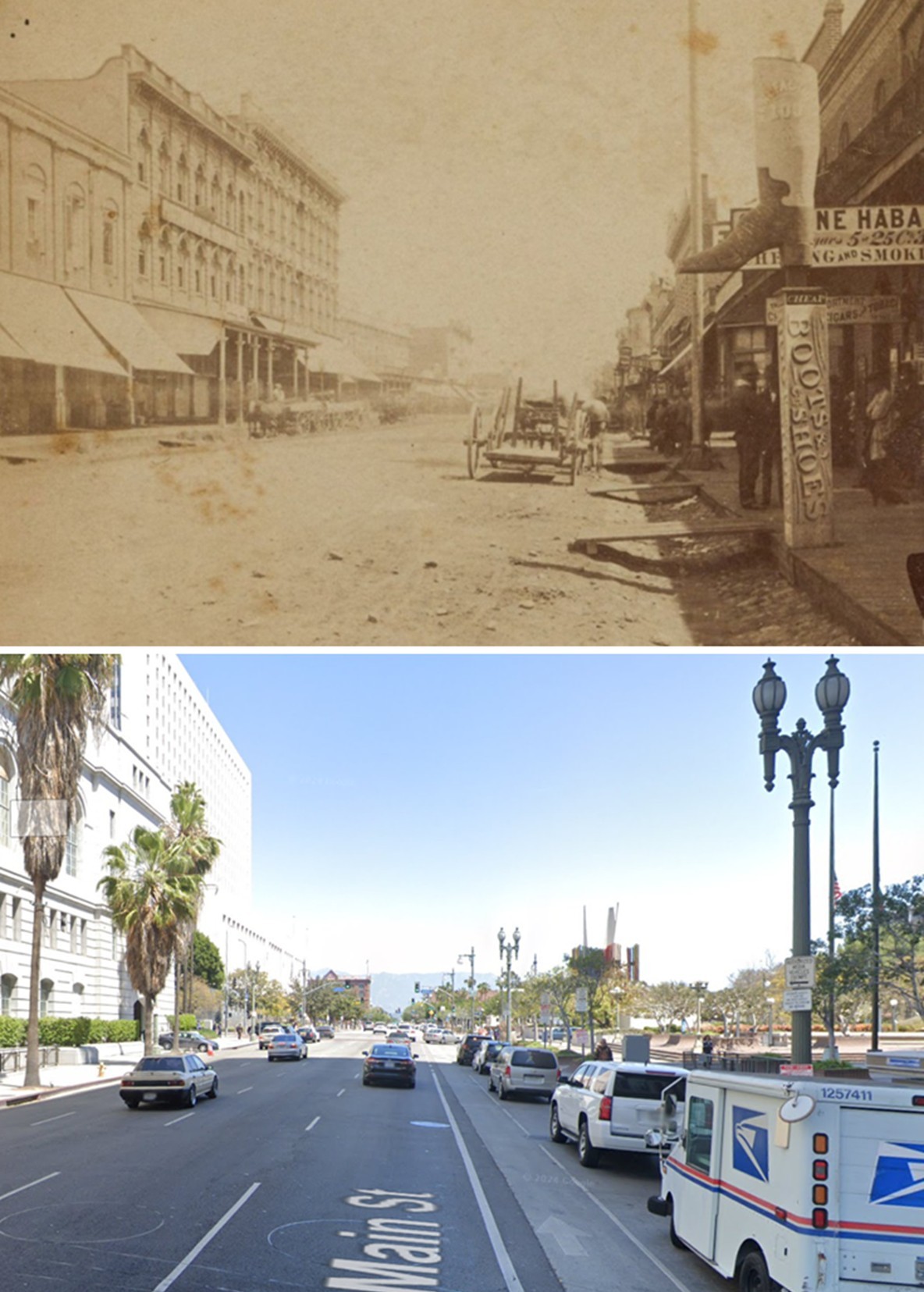 |
|
| (1878 vs 2018)* - Then and Now – Main Street Looking North Toward Temple Street. The 1878 view looks north up Main Street from just south of Requena Street (later renamed Market Street), with the Temple Block visible at center left. In the modern 2018 view, Market Street has vanished—its former path now occupied by the broad expanse of City Hall East. On the left stands the main Los Angeles City Hall, a landmark of the Civic Center since 1928. Photo comparison by Jack Feldman. |
Historical Notes The intersection of Market (originally Requena) Street and Main Street was once a vibrant part of old Los Angeles, anchored by the U.S. Hotel and Amestoy Building. Today, the site is part of the Los Angeles Civic Center, with City Hall East occupying the former locations of these historic structures. Market Street itself has disappeared from the map at this location, a casualty of mid-20th-century urban renewal. |
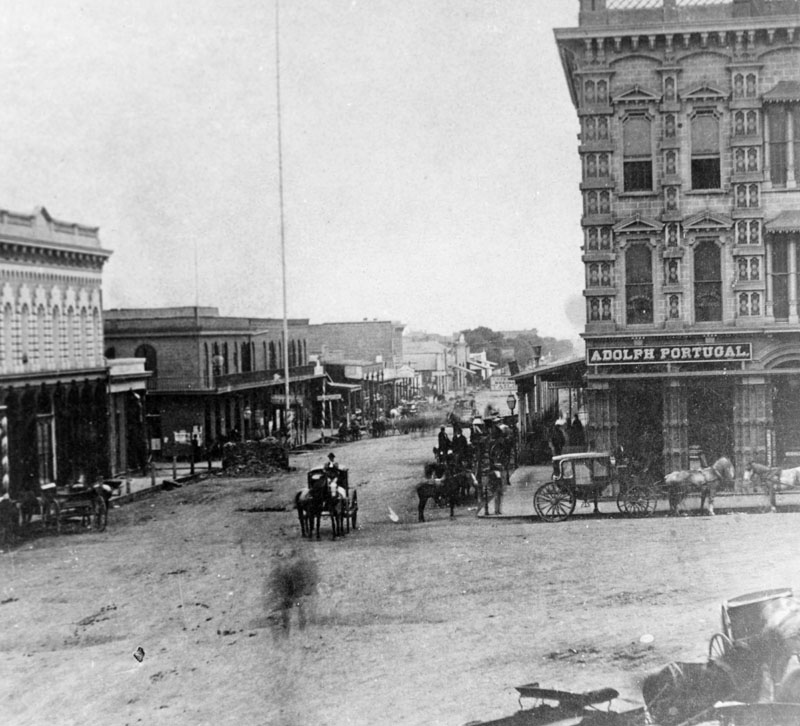 |
|
| (1880s)* - View looking south on Main Street at Temple Street, with the Temple Block and Adolph Portugal’s store visible at right. Requena Street can be seen intersecting Main Street near the tall pole in front of the U.S. Hotel. |
Historical Notes Main Street was one of the primary thoroughfares in early Los Angeles, running through the heart of the city and connecting various important locations, including the Plaza. It was a central axis for commerce and transportation, playing a crucial role in the city's expansion. |
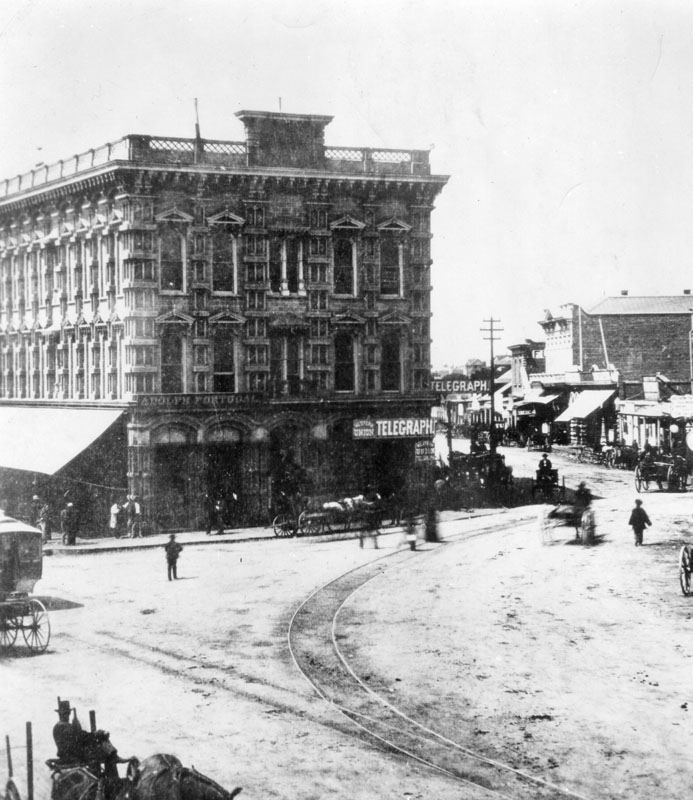 |
|
| (ca. 1880s)* - View of Temple Block at the junction of three streets; Temple, Spring and Main streets. A telegraph office is now in view at the southeast corner of Temple Block. |
Historical Notes Temple Block would become the site today's Los Angeles City Hall, built in 1928. |
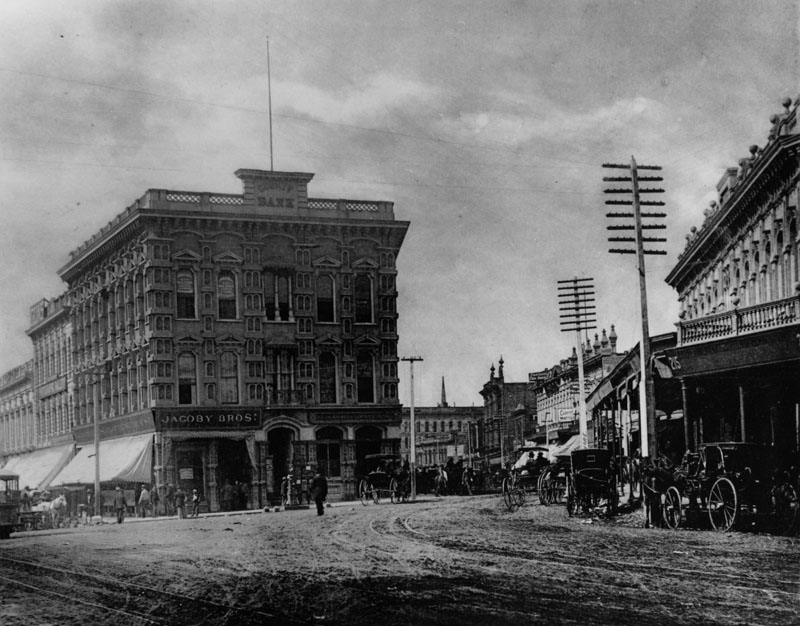 |
|
| (ca. 1885)* - The junction of Main, Spring and Temple Streets, showing Jacoby Brothers clothing store and the Los Angeles County Bank in the Temple Block. The Downey Block on the right was on the northwest corner of Main and Temple. Telegraph poles are seen throughout. |
Historical Notes The Jacoby family came from Loebau, Poland, a territory at the time controlled by Prussia. They arrived in the United States at different times during the 1870s. The five Jacoby brothers started business in Los Angeles in the 1870's by joining with Leopold Harris and buying out Herman W. Hellman’s store. Hellman left after 5 years and the firm became The Jacoby Brothers and flourished well into the first third of the 20th Century. Jacoby Bros. kept growing until it was one of the largest retail and wholesale companies in Los Angeles. In the mid-1920's it sold out to David May of the May Company of St. Louis. This occurred about the same time as when the Hamburgers Department Store was also sold to the May Co. |
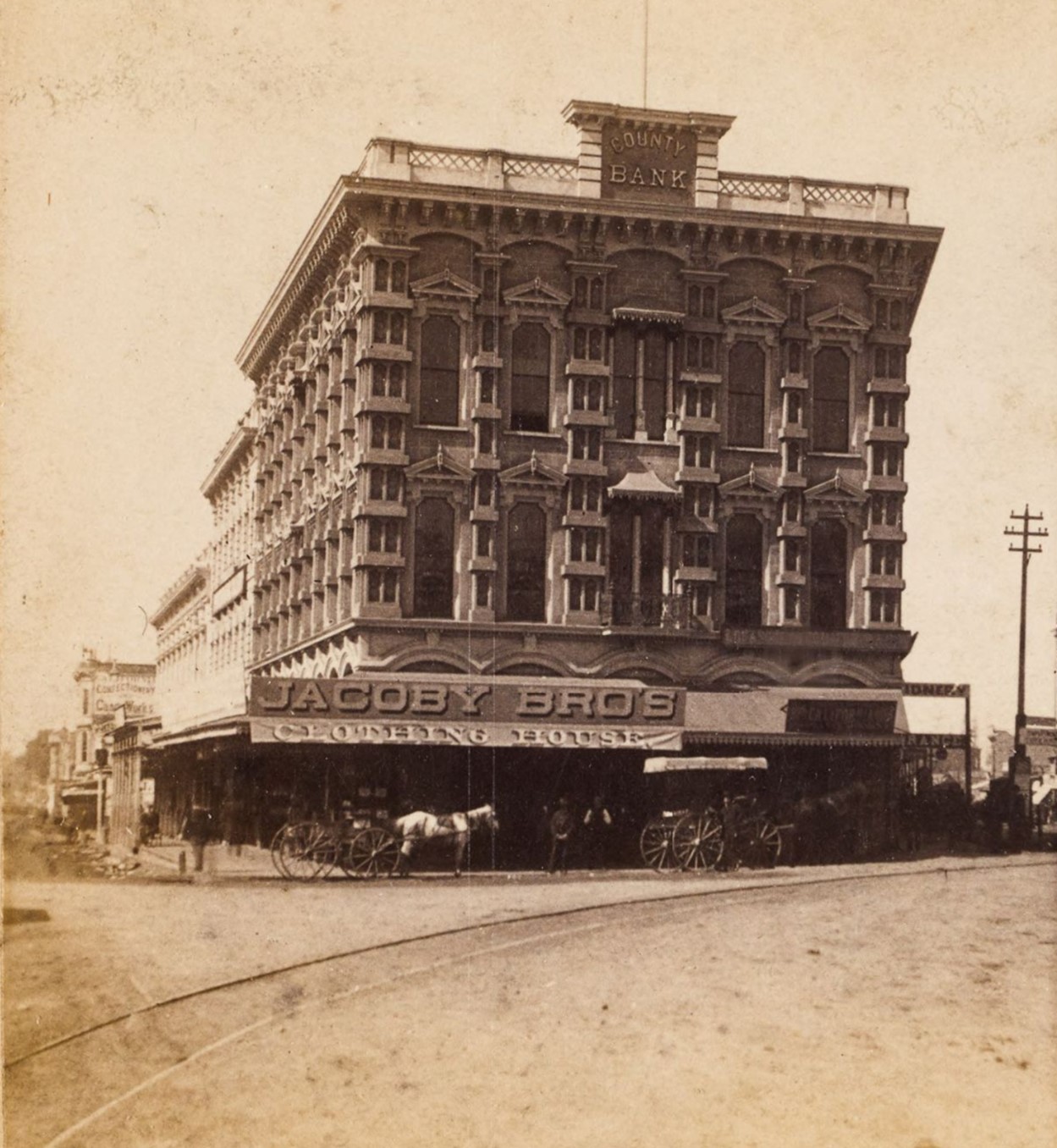 |
|
| (ca. 1881)* - View of the three-story Italianate Temple Block building with horse-drawn carriages in front, at the intersection of Main Street and Spring Street in downtown Los Angeles, with visible signs on the building for "Jacoby Bro's Clothing House," "County Bank." "California Confectionary and Candy Works" can be seen on a building on Main Street in the background at left. Ernest Marquez Collection |
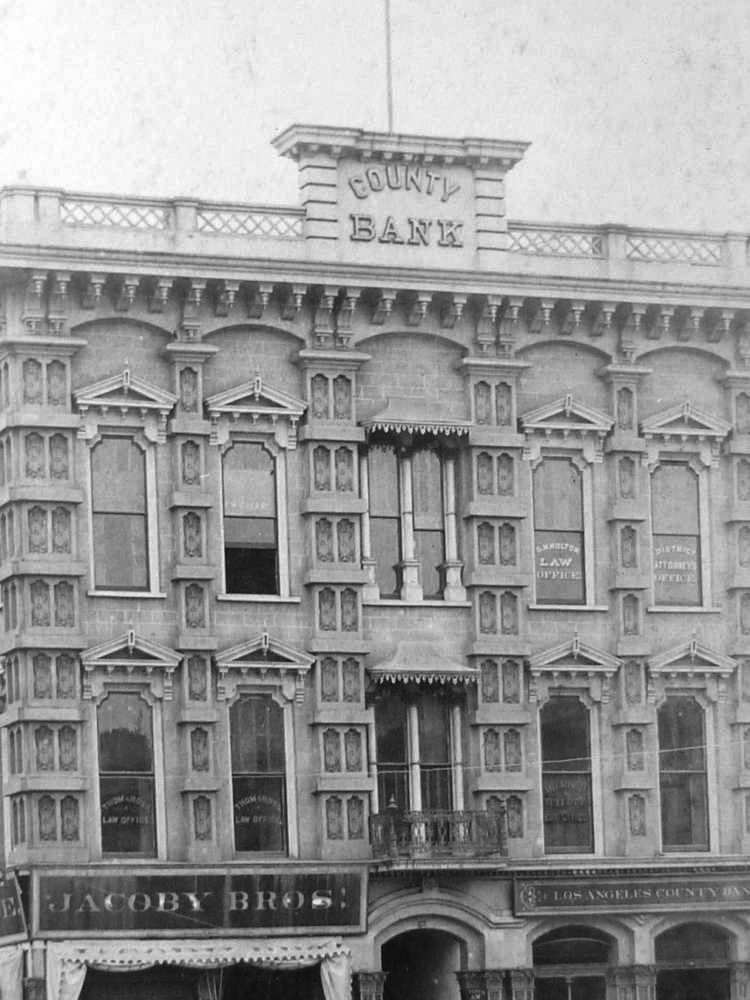 |
|
| (ca. 1885)* - Close-up view of the Temple Block showing its ornate Italianate architecture, including paired columns, bracketed cornices, and decorative window hoods. |
Historical Notes Francis Temple formed a bank with his English-born father-in-law, William Workman, The Temple & Workman Bank. The bank was in the space occupied by the Los Angeles County Bank in the photo above. The bank closed during the panic of 1875, brought on by the failure of the Bank of California in San Francisco. Temple managed to secure a loan to reopen the bank from the ruthless "Lucky" Baldwin, a San Francisco financier who had become interested in investing in Southern California. The terms of the loan were extremely harsh, Temple and Workman pledged everything they had, including their homes, ranches, downtown commercial property and Temple Block itself. However, the bank failed for a second time in 1876. Baldwin, refusing to renegotiate the loan, quickly closed in. Temple and Workman were ruined. Workman, then 76 and a former Mayor of Los Angeles, killed himself. Temple, under extreme stress following his losses, had a stroke, finally dying in 1880. He left his wife and seven children. The Temple & Workman family fortunes were restored in 1914 when Temple's nine-year-old grandson (Workman's great-grandson), Thomas Workman Temple II, discovered a natural gas deposit while playing on land his father owned. The families developed Montebello Oil Field there in 1917. With their renewed funds the families were able to recover their ranch, La Puente (City of Industry) including their private family cemetery, El Campo Santo. Temple and Workman are buried there along with their families and their friend, Pio Pico and his wife. |
 |
|
| (ca. 1885)* - View looking south with a good view of Main Street (left) and Spring (right). The old County Courthouse with its cupola and clock can be seen in the center of Temple Block. |
Historical Notes The old County Courthouse was originally built by John Temple in 1858 as a marketplace and theater. Its first floor was used for that purpose for a number of years, and the second floor was the first theater in Los Angeles. Between 1860s-1884, Los Angeles City Hall shared space with the County Courthouse in the Temple Block. |
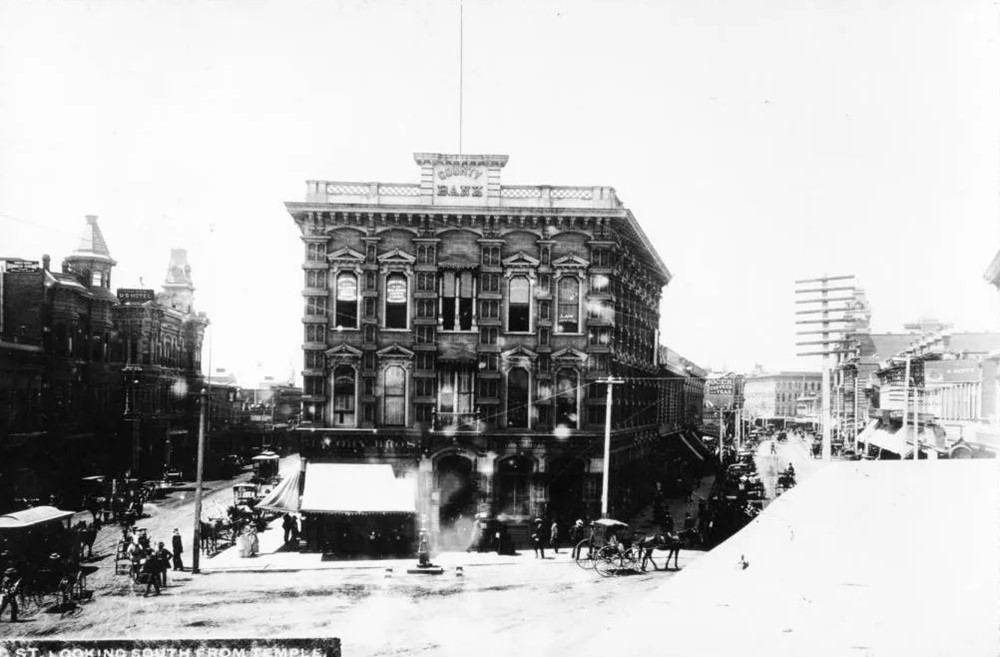 |
|
| (1887)* - View looking south from Temple toward Temple Block. Main Street is on the left and Spring Street on the right. Note the fountain in front of Temple Block. |
Historical Notes In 1882, the fountain in front of Temple Block was donated by Harris Newmark of Newmark & Co. and the water was provided free by the LA Water Company. The Newmark Fountain was a minor landmark in downtown Los Angeles between 1882 and 1892. The female figure atop it was nude, which made it an object of some interest at the time. Unfortunately, the fountain met a premature end when a team of runaway horses hit it in 1892. Harris Newmark was a successful businessman in early Los Angeles. He made many contributions to the economy and culture of Los Angeles, and gave his time and his money to causes he felt were worthy. He was one of the founders of the Los Angeles Public Library, was a charter member of the Los Angeles Chamber of Commerce, and was one of the organizers of the Board of Trade, which helped bring railroad service to California. He was the president of Congregation Congregation B'nai B'rith in 1887 and a founder of the Jewish Orphans Home. Newmark was also instrumental in the establishment of the Southwest Museum, which is now part of the Autry National Center. He and other Newmarks were leaders of the local Odd Fellows and were Masons. |
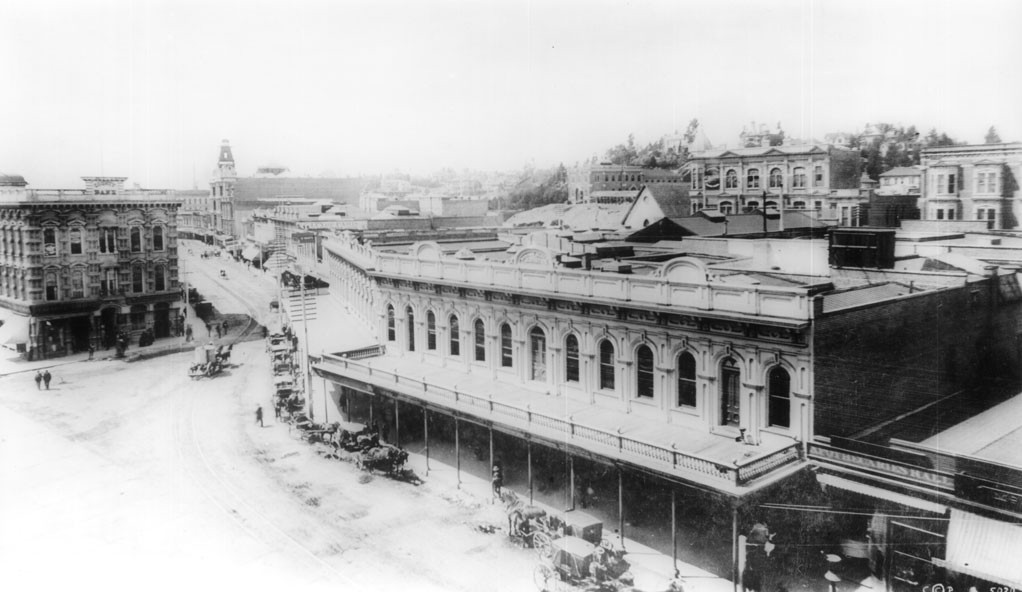 |
|
| (ca. 1887)* - View looking down Spring Street from near where Main, Spring, and Temple streets intersect. The Downey Block with horse-drawn carriges and wagons parked in front is seen on the right. At left is the Temple Block. Further down Spring Street can be seen a 4-story building with a unique copula. That is the Phillips Block. |
Historical Notes Construction on the Downey Block began in 1869. It was named for John Gately Downey, a pharmacist who served as the governor of California for two years (1860-1862) before becoming a real estate developer. Downey was also one of the founders and first president of Farmers and Merchants National Bank. The city of Downey was named in his honor after he subdivided his land holdings there and converted them into farms. |
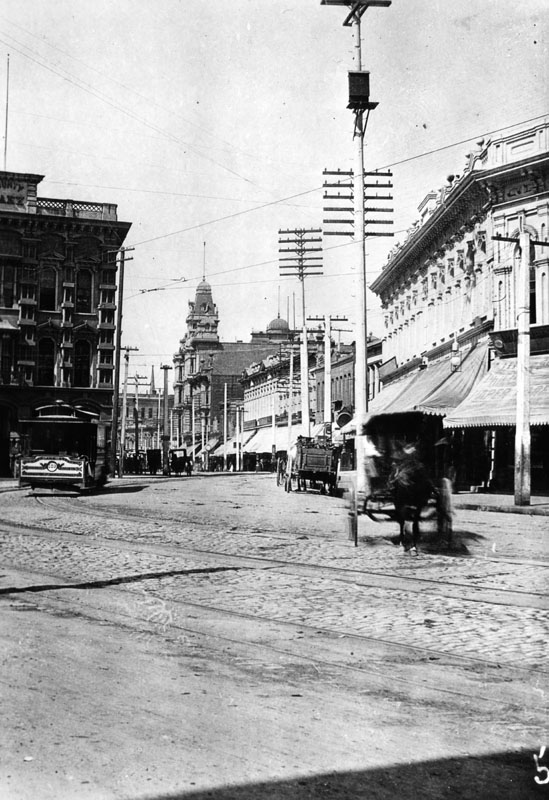 |
|
| (ca. 1887)* - View looking south on Spring Street with Temple Block seen on the left. The large 4-story building with the copula in the distance is the Phillips Block. The large, ornate four-story building housed one of the City's first department stores called Hamburger & Son's People's Store whch would evolve into May Company. The Downey Block is at right. A horse-drawn carriage crosses the tracks as a streetcar appears to be headed toward it. |
Historical Notes The Phillips Block, located at 25-37 N. Spring Street, was constructed in 1887 in the French Renaissance style popular at that time for secular buildings. It was the second four-story building erected in Los Angeles and was one of the most ornately decorated. A. Hamburger and Sons was one of the first department stores to operate in Los Angeles. Originally known as A. Hamburger & Son's People's Store, the name later changed to Hamburger's Store. In 1908 the company relocated their store from Spring Street to a newer building located at Broadway and Eighth Street. May Department Stores acquired Hamburger's in 1923 and renamed it the May Company. Much later in the century, the May Company and Robinsons chains of department stores would affiliate under the name Robinsons-May; and this entity would be bought out by Macy's in 2005. |
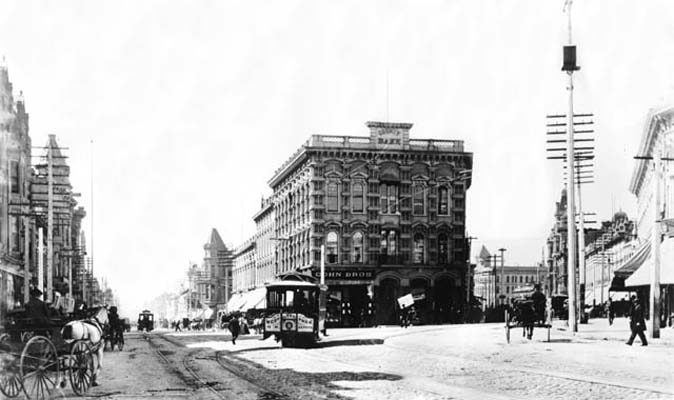 |
|
| (ca. 1887)* - Photo shows the Temple Block (center) with Main Street to the left and Spring Street to the right. |
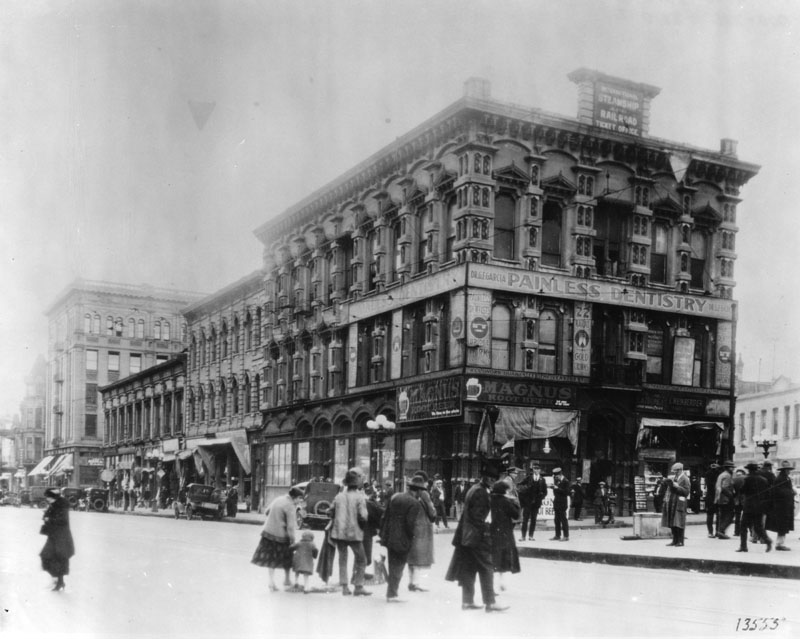 |
|
| (ca. 1926)* - Temple Block as it appeared just one year before construction of today's City Hall. |
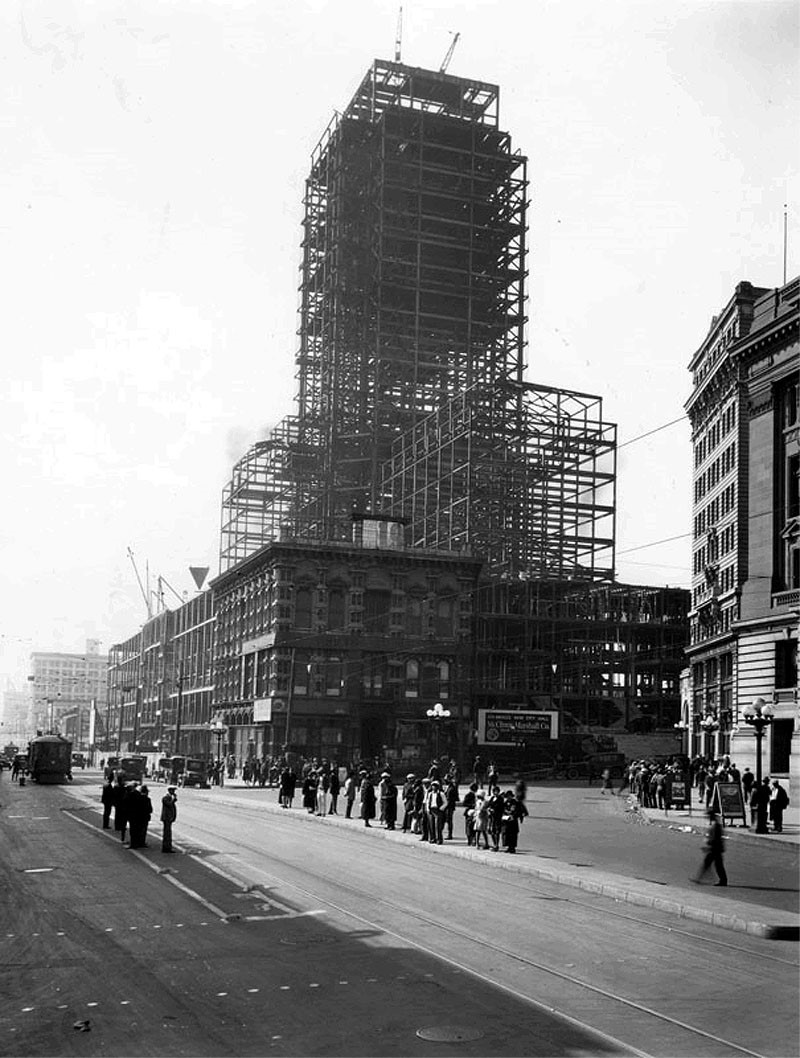 |
|
| (1927)* - The last stand of the historic Temple Block. As the steel frame of the new City Hall neared completion the proud building, once dominant in the business and professional life of the city, was razed. |
Historical Notes Realignment and Demolition (1920s) 1925-1927: The Temple Block and surrounding areas were demolished to make way for the new Los Angeles City Hall. This marked a significant transformation in the urban landscape, shifting from a vibrant commercial hub to a more government-centered area. Spring Street Realignment (1927) 1927: During the construction of the new City Hall, Spring Street was realigned to run parallel to Main Street, altering the historic junction’s layout and further integrating it into the city's evolving infrastructure. Click HERE to see more of Construction of Today's City Hall |
Then and Now
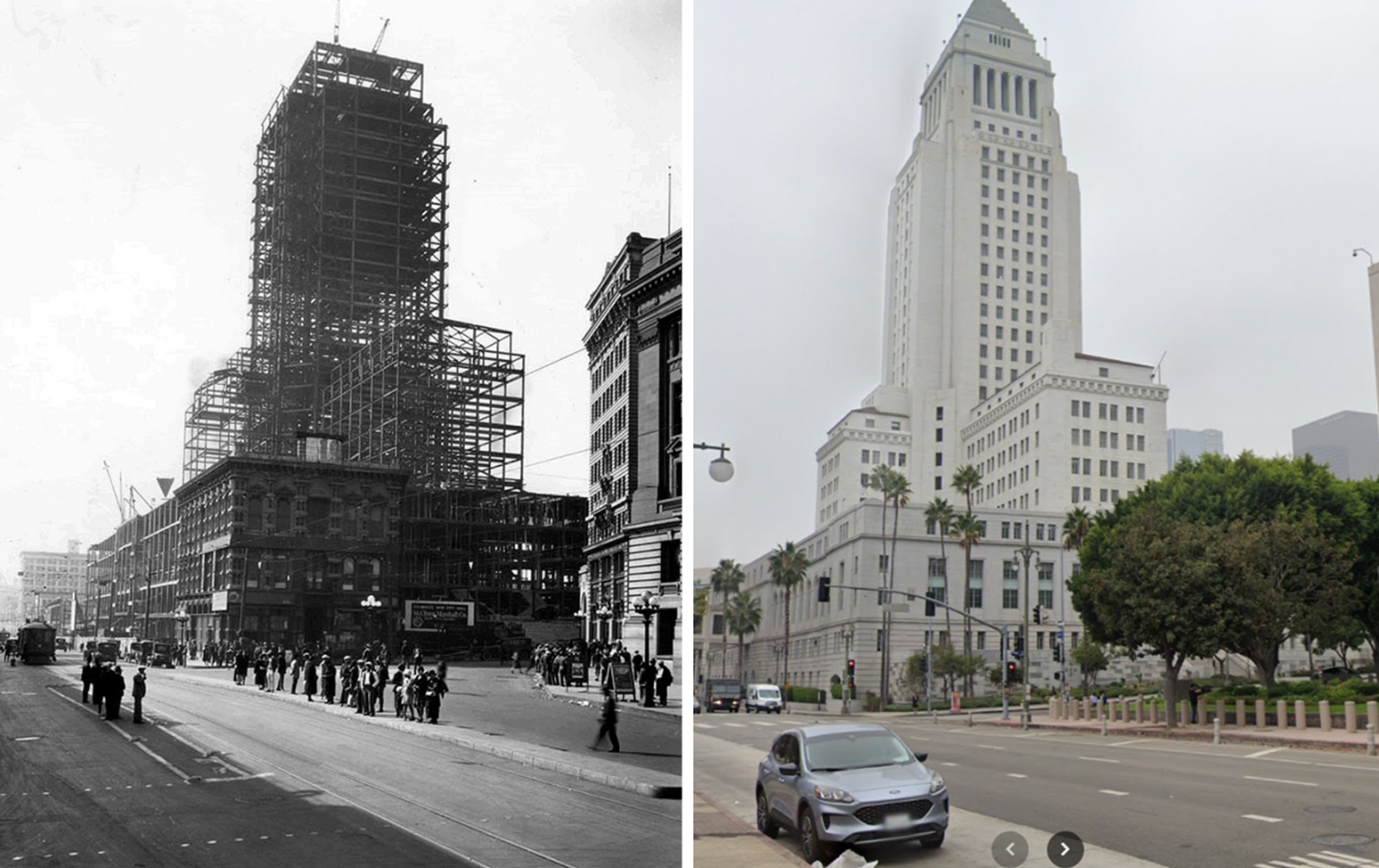 |
|
| (1927 vs. 2024)* – Los Angeles City Hall, Then and Now - On the left: City Hall under construction, rising from the cleared site of the historic Temple Block. On the right: the same view today, nearly a century later, with the completed 454-foot landmark still presiding over downtown. This rare 1927 image is one of the final glimpses of Temple Block before it vanished into history. Photo comparison by Jack Feldman. |
Then and Now
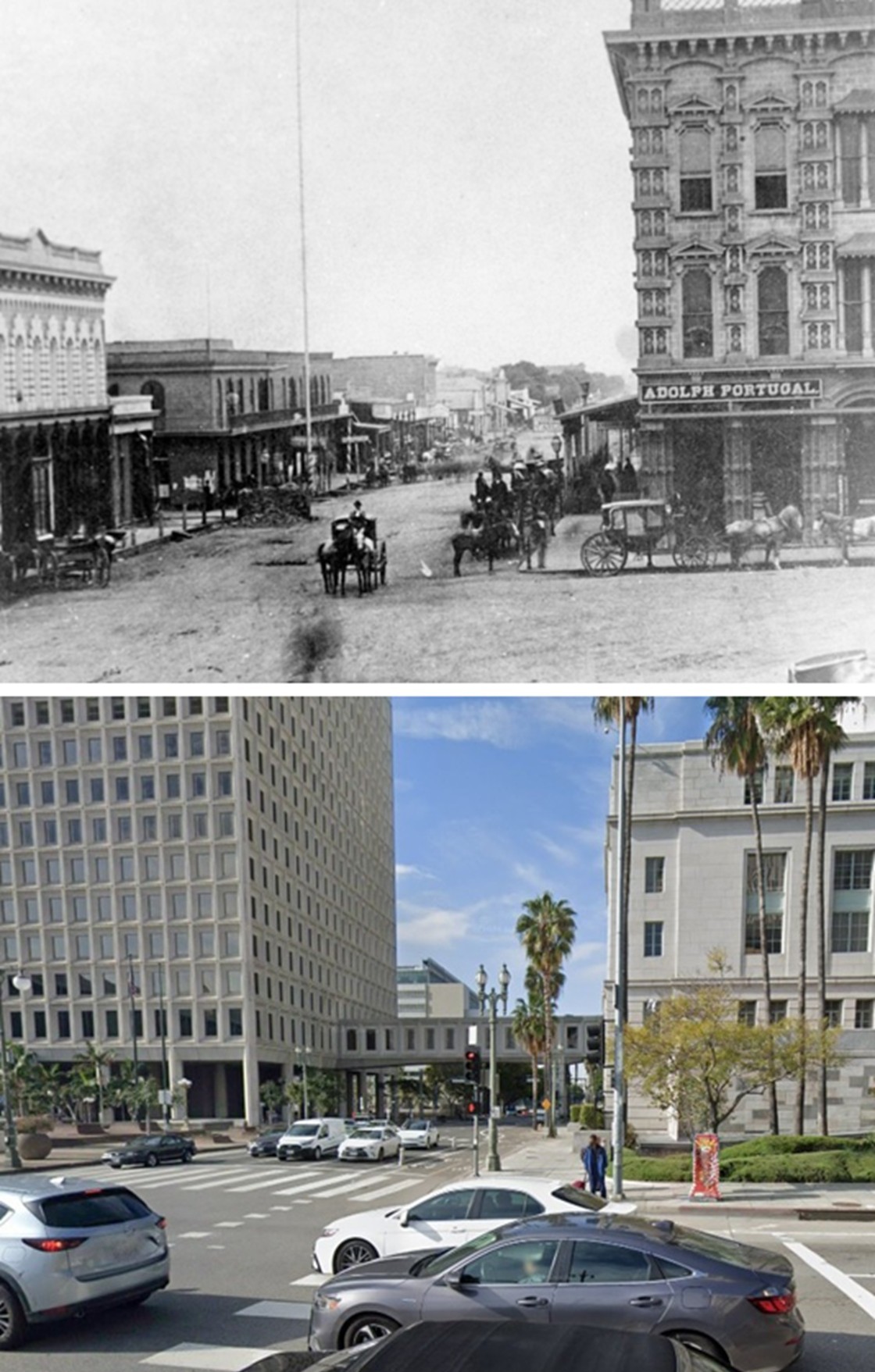 |
|
| (1882 vs. 2024)* – Looking south on Main Street at Temple Street. Photo comparison by Jack Feldman. |
Historical Notes The 1882 photo captures daily life in early Los Angeles, with dirt roads, horse-drawn carriages, and the ornate Temple Block on the right—home to the Adolph Portugal store and a key commercial hub. Today, the view shows Los Angeles City Hall standing on the former site of the Temple Block. City Hall East appears on the left, connected by a pedestrian bridge across Main Street. |
* * * * * |
Temple and Hill Streets
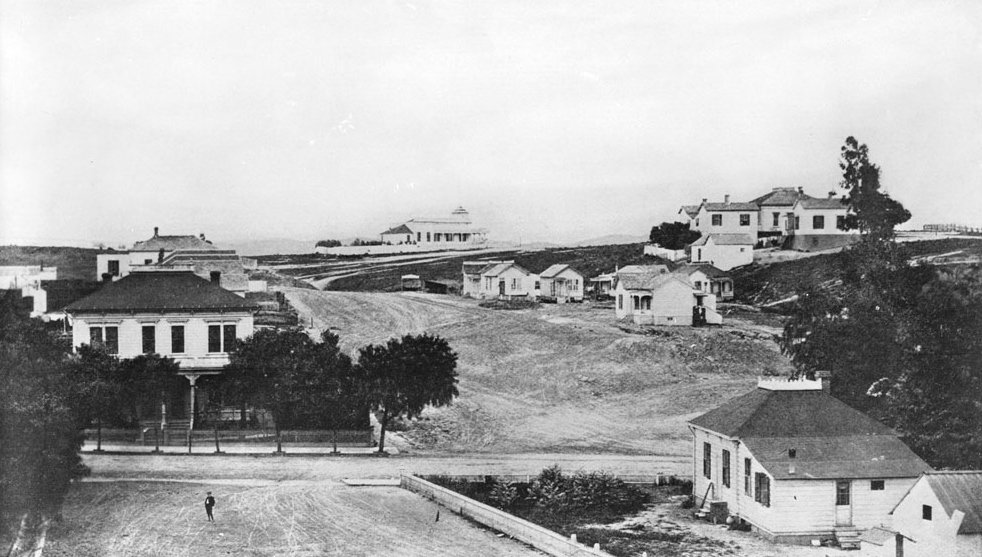 |
|
| (ca. 1884)* - View looking north at the intersection of Hill and Temple streets in downtown Los Angeles. Past Temple St. stands Fort Moore Hill, one of downtown L.A.’s “lost hills.” The Banning Mansion near the summit of Fort Moore Hill can be seen in the distance. |
Historical Notes Originally housing Fort Moore, one of two historic U.S. Military forts in Los Angeles during the Mexican-American War, the site was constructed in 1847, abandoned in 1849, and decommissioned in 1853. In 1882, Jacob Philippi purchased land on Fort Moore Hill, establishing a beer garden which became a popular local attraction. He later sold the property to Mary Banning, who converted it into the impressive 21-room Banning Mansion, a focal point of high society. The mansion, offering sweeping views of Los Angeles, eventually fell out of prominence as the city expanded. It was later converted into a rooming house before being demolished. Reflecting the city's rapid growth and changing social landscape, the site also became home to Los Angeles High School in 1891 and later the Los Angeles Unified School District headquarters. |
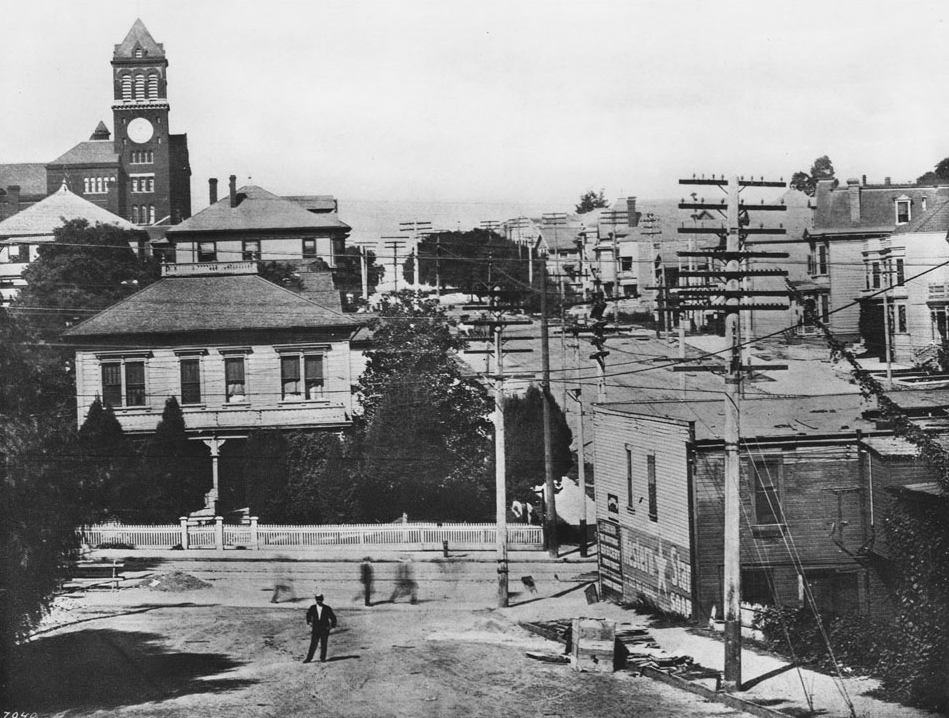 |
|
| (1906)* - View looking north at the intersection of Hill Street and Temple twenty-two years later in 1906. The tall tower to the upper left is that of Los Angeles High School (2nd location) which was built in 1890. |
Historical Notes Los Angeles High School moved to Fort Moore Hill in 1891, occupying a site on North Hill Street between San Street and Bellevue Avenue. The high school remained there until 1917, after which the location became the headquarters for the Los Angeles Unified School District until 2001. In the early 20th century, much of Fort Moore Hill was removed for urban development, including the construction of the 101 Freeway. |
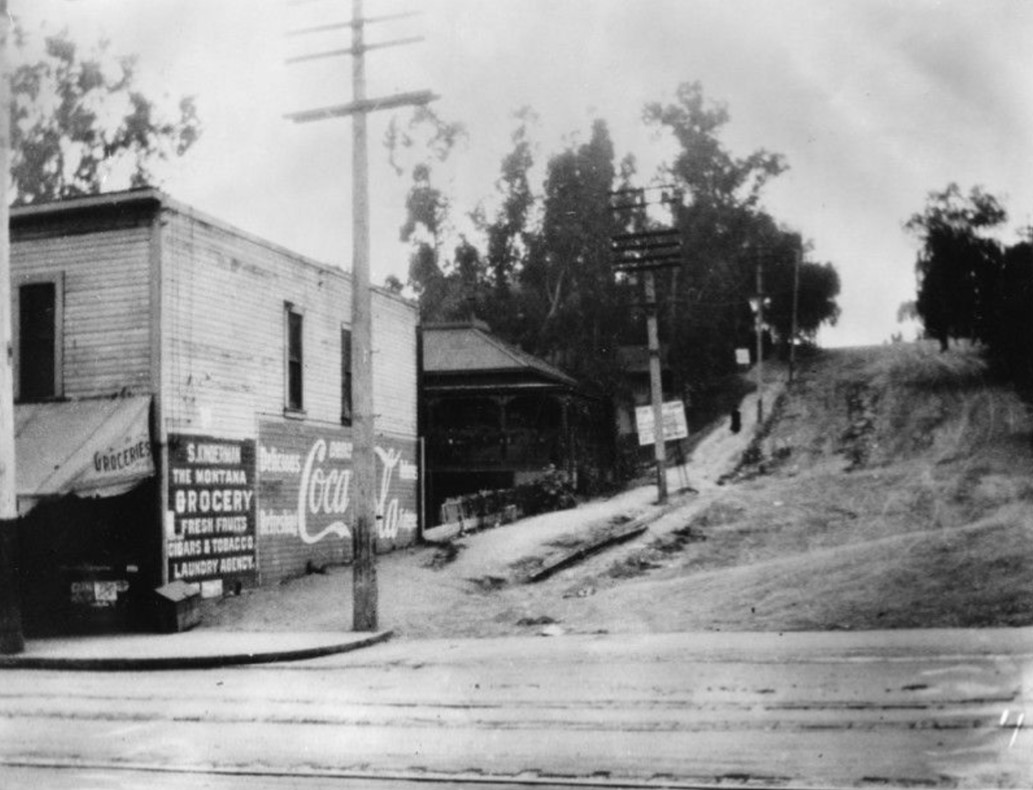 |
|
| (1908)* - Looking south at Hill Street from Temple before the Hill Street Tunnel was bored. The Montana Grocery (S. Kinderman, grocer) advertises fresh fruit, cigars & tobacco, laundry and "Delicious Coca-Cola." Streetcar tracks are visible in the foreground. |
Historical Notes The first Hill Street Tunnel, built by the Los Angeles-Pacific Railway and completed in 1909, served interurban rail cars and reduced travel times by 15 minutes. The second tunnel, built by the city for pedestrians and vehicles, opened in 1913. These 550-foot-long tunnels provided direct access to Sunset Boulevard, bypassing the steep grades of Bunker Hill and Fort Moore Hill. The northern portal of the Hill Street Tunnels was near Temple Street, while the southern portal was at First Street. |
Before and After
 |
|
| (1884 vs 1906) - Looking north at the intersection of Temple and Hill Street before and after the construction of Los Angeles High School. Photo comparison by Jack Feldman. |
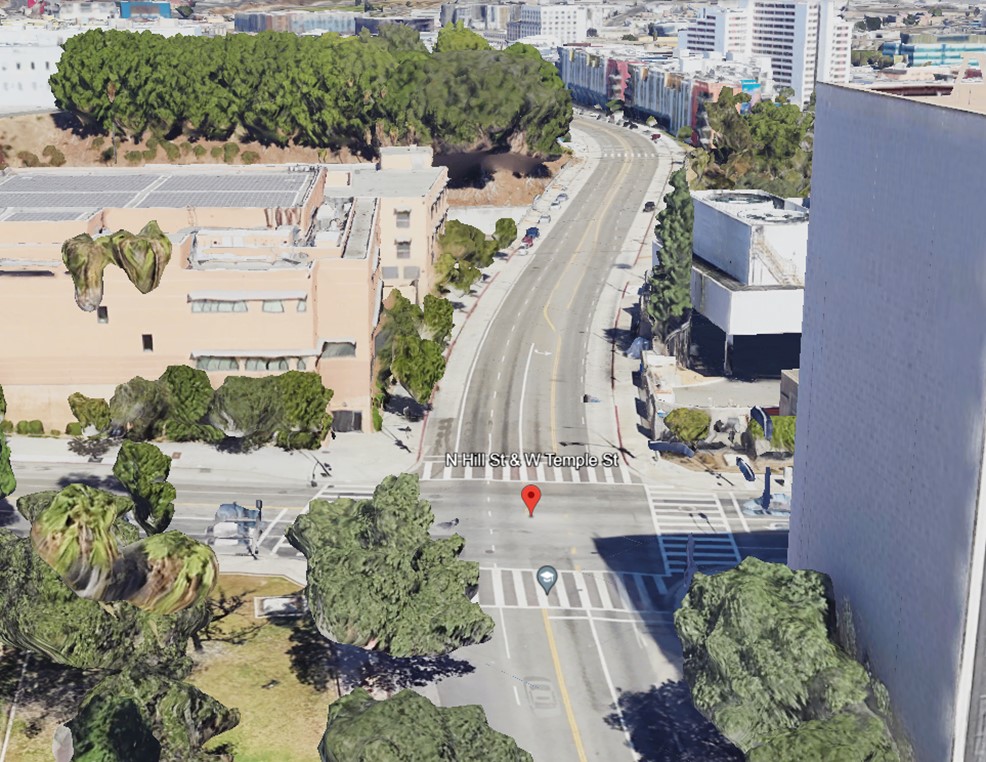 |
|
| (2022)* - Google Earth view looking north toward the intersection of North Hill and West Temple Street. Today, the 101 Freeway runs beneath Hill Street, visible at the center-top of the photo. |
Historical Notes Work on removing Fort Moore Hill began in 1949 to make way for the Hollywood Freeway, a major excavation project that reshaped the downtown landscape. As part of a larger freeway construction effort from 1947 to 1954, this project effectively obliterated most of the historic hill between Sunset Boulevard and Temple Street. The freeway was built in a trench through downtown Los Angeles, allowing it to pass under existing streets like Hill Street, thus preserving the street grid above. |
Then and Now
 |
|
| (1884 vs 2022) - A 'Then and Now' view using Google Earth, showing Hill Street looking north at Temple Street from a slightly different angle. Photo comparison by Jack Feldman. |
 |
|
| (2022)* - Contemporary view of Hill Street looking north at Temple Street. |
Then and Now
 |
|
| (1884 vs. 2022)* - A 'Then and Now' view of Hill Street looking north at Temple Street. This comparison gives a clearer picture of how Hill Street was partially straightened, and how both Fort Moore Hill (north of Temple) and Bunker Hill (south of Temple) were largely flattened. Photo comparison by Jack Feldman. |
* * * * * |
Temple and Justicia Street (Originally Buena Vista Street)
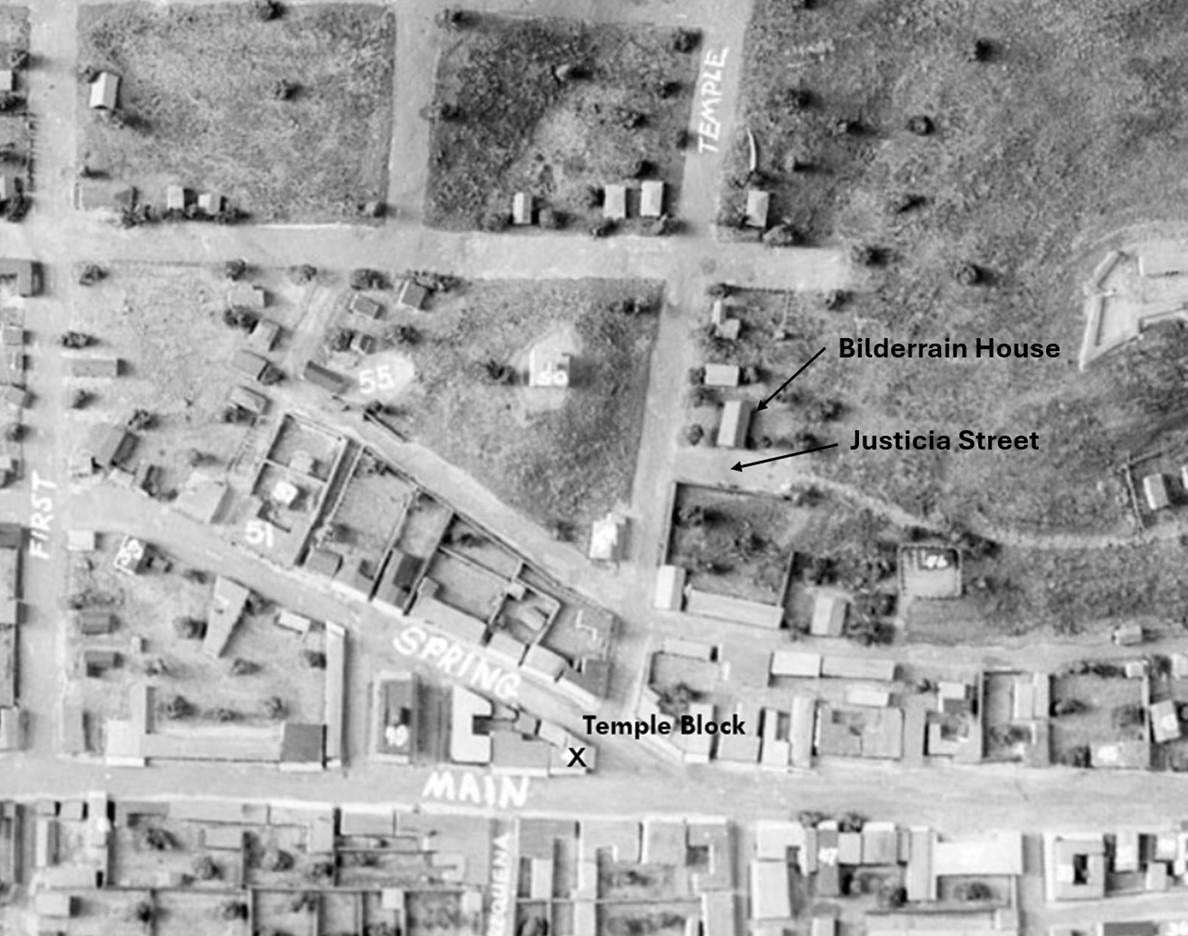 |
|
| (ca.1870s)*- Model image depicting how downtown Los Angeles appeared in the mid to late 1800s. The T-intersection of Temple Street and Judicia Street is visible near the center, with the Bilderrain Adobe situated on the northwest corner. |
Historical Notes Justicia Street, an early north-south dirt road and thoroughfare in Los Angeles, underwent significant changes as the city developed. Originally running parallel to New High Street and ending near Temple Street, it served a modest residential area in the late 19th century. |
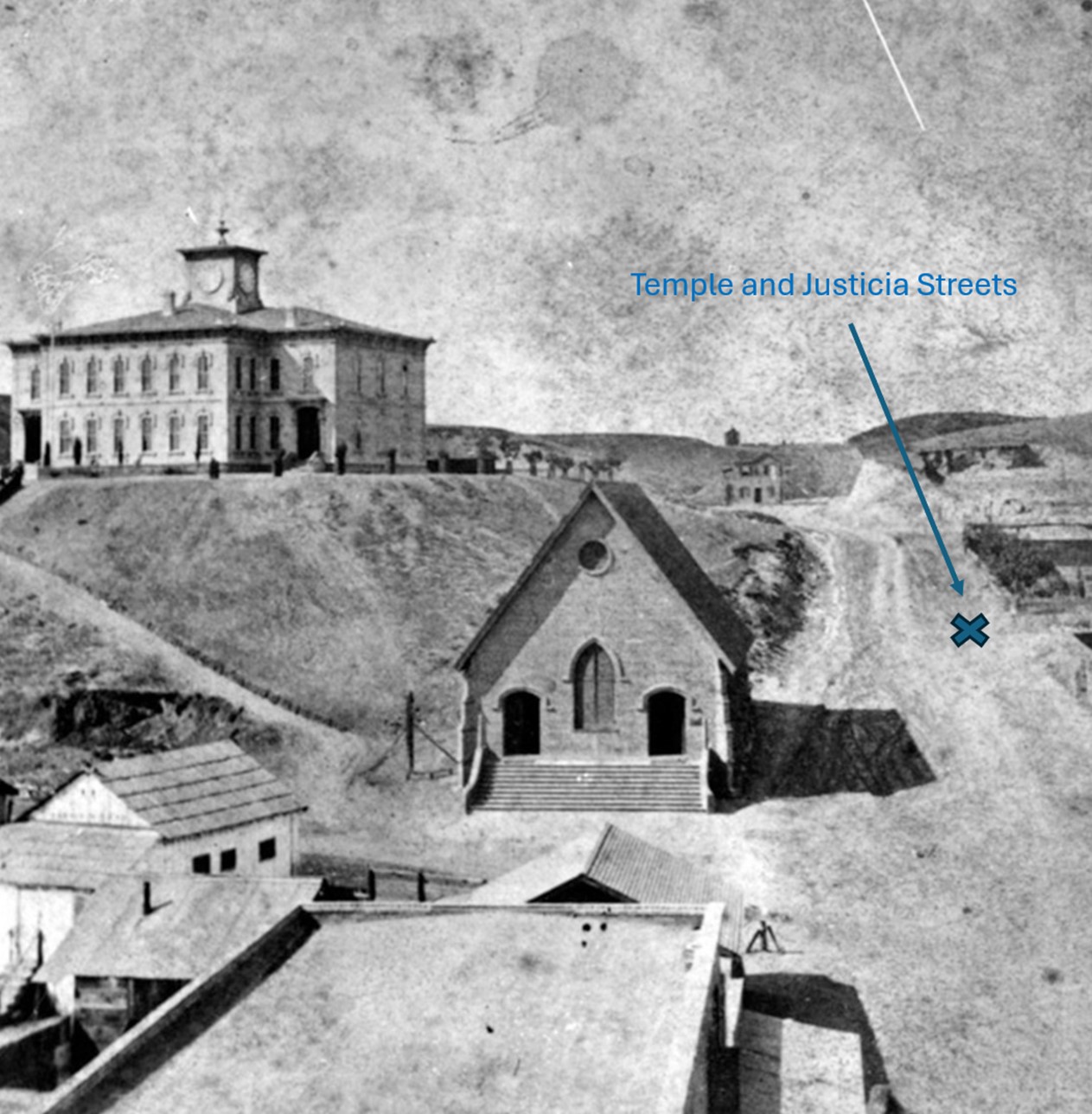 |
|
| (ca. 1874)* - Looking west on Temple Street, with Los Angeles High School atop Poundcake Hill and St. Athanasius Episcopal Church visible in the center of the photo. The street that ends at Temple Street on the center-right is Justicia Street. The street in front of St. Athansius is New High Street (later Spring Street). The street behind the high school was Fort Street (later Broadway). |
Historical Notes Built in 1864, St. Athanasius was the first Episcopal church in the City of Los Angeles. It was situated on the northeast corner of Poundcake Hill at Temple and New High Streets (later Spring Street). Pouncake Hill will later be home to the Los Angeles Country Courthouse, completed in 1891. |
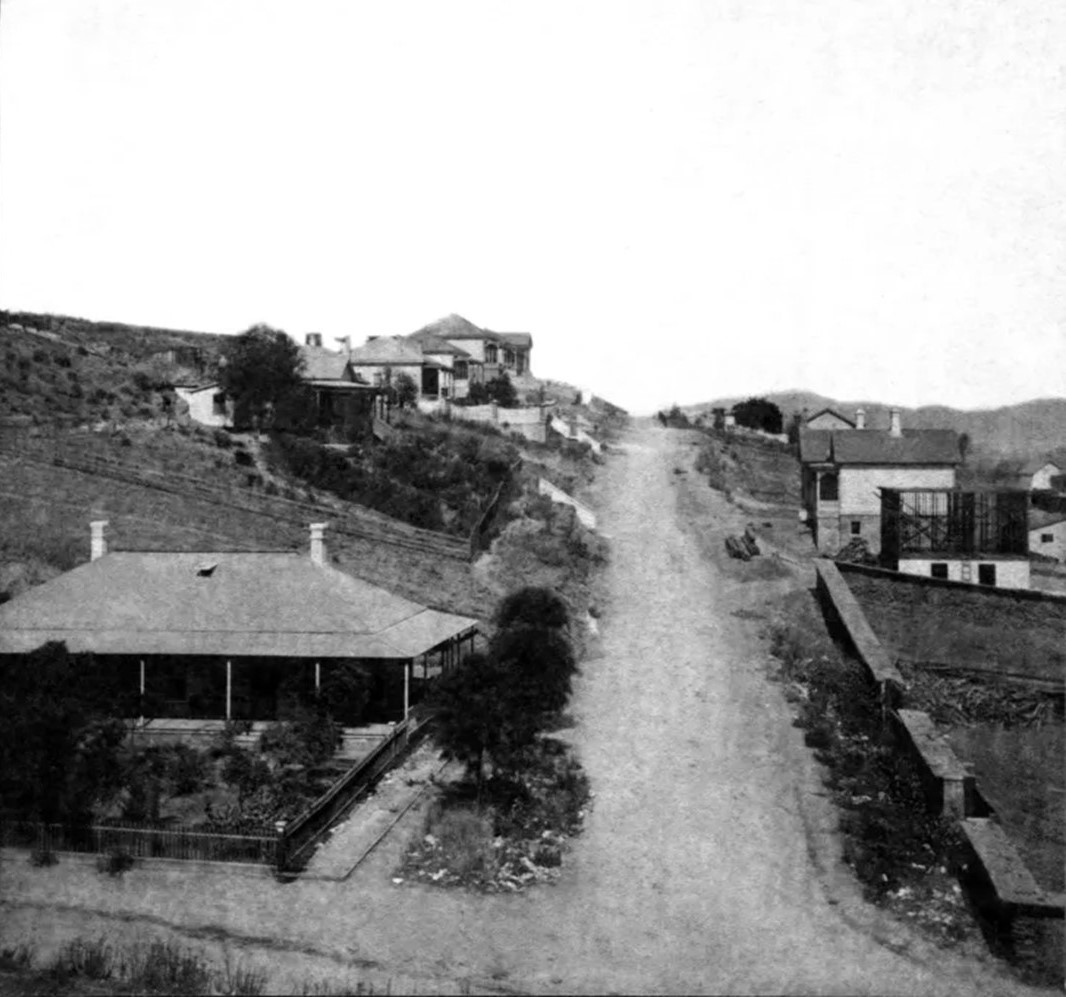 |
|
| (1880s)* – Looking north on Justicia Street (originall Buena Vista Street) at its intersection with Temple Street, with the Bilderrain Adobe visible on the northwest corner. |
Historical Notes The suburban-looking residence in the foreground is at the northwest corner of Temple and Justicia Streets. It served as the longtime family home of the Bilderrain family, whose presence in Los Angeles was established by Jose Ygnacio Bilderrain. He likely settled in L.A. between 1847—when he married in San Juan Capistrano—and 1850, as he appears in the 1850 L.A. census. His grandson, also named Jose Ygnacio Bilderrain, was wounded during the conflict that immediately preceded and sparked the Chinese Massacre of 1871. Several of the unfortunate Chinese victims were lynched on the gatepost of the lumber yard across Justicia Street from the Bilderrain home (the site is out of frame to the right and later hosted the Los Angeles County Jail). |
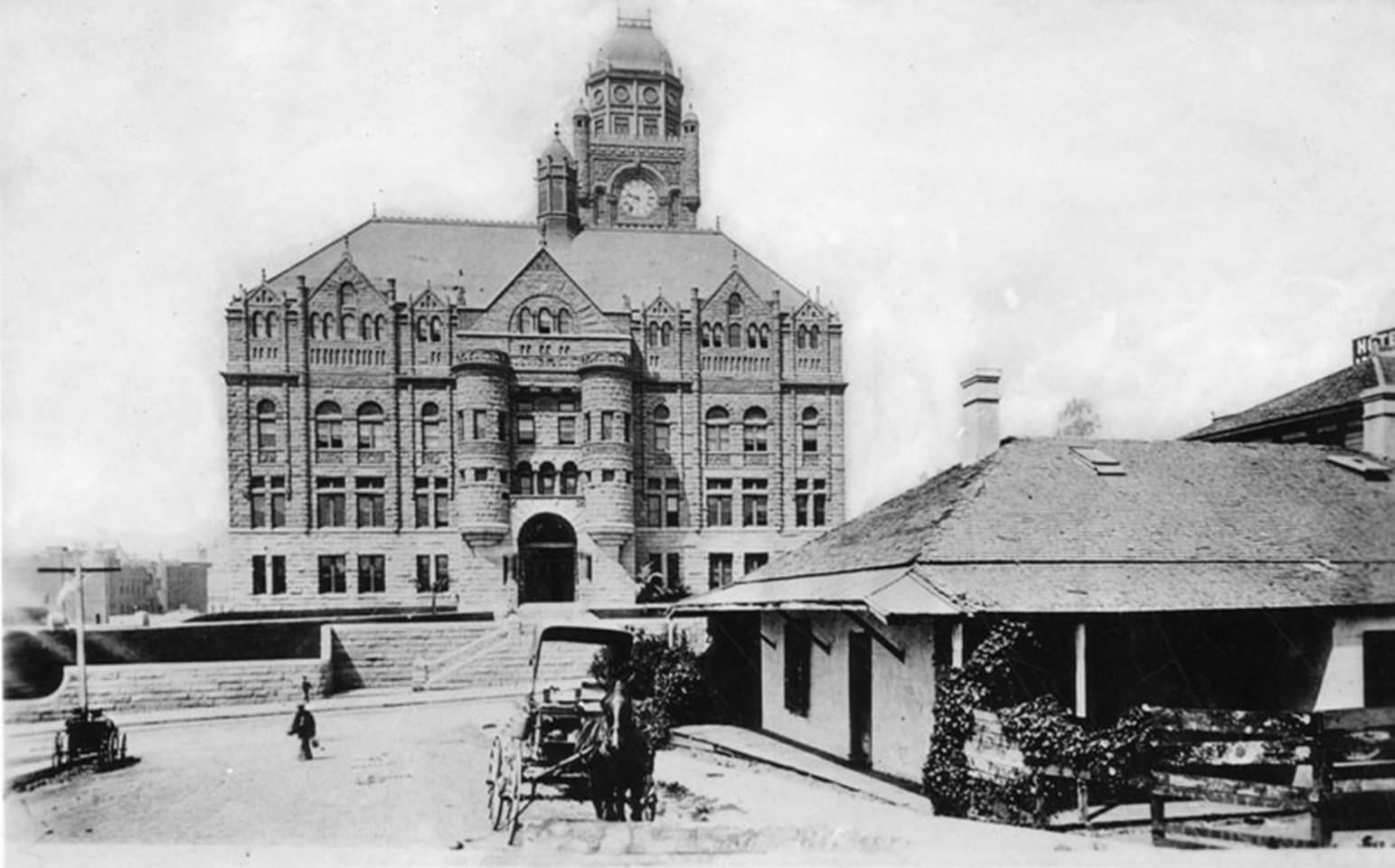 |
|
| (ca. 1891)* - Looking south on Justicia Street toward its terminus at Temple Street, where the 1891-built Los Angeles County Courthouse stands. A horse-drawn carriage is parked in front of the Belderrain Adobe, located on the northwest corner. |
Historical Notes As late as 1928, Justicia Street was still a dirt road north of the section adjacent to the County Jail. |
 |
|
| (ca. 1889)* – Panoramic view looking northeast from the top of the Los Angeles County Courthouse, with Justicia Street (originally Buena Vista Street) visible on the left and New High Street on the right. The Los Angeles River can be seen in the distance. |
Historical Notes Note how full the Los Angeles River is—it’s rare to see it like this unless right after a storm. |
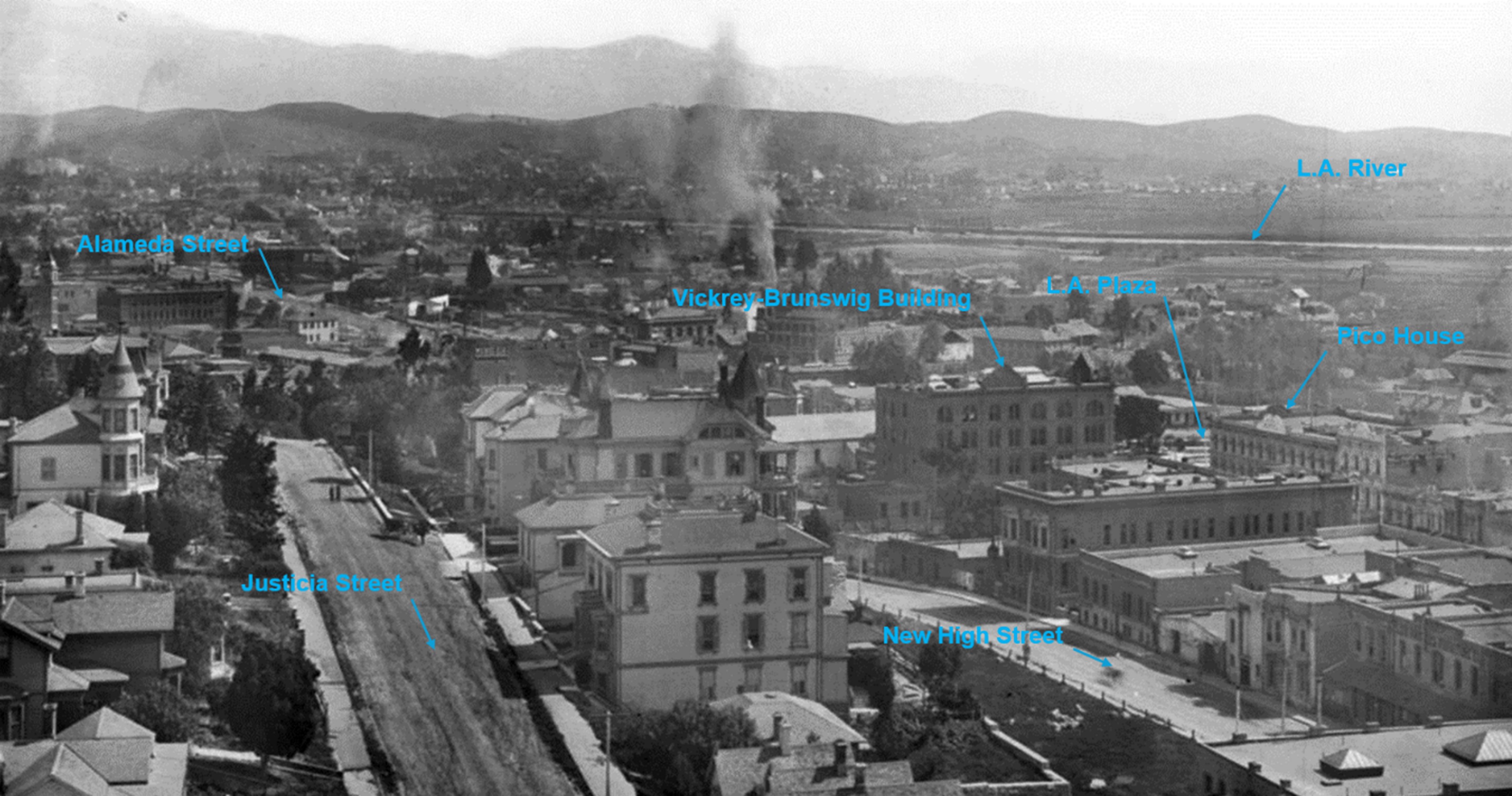 |
|
| (ca. 1889)* - Panoramic view looking northeast from the top of the Los Angeles County Courthouse, annotated to provide better reference points. Justicia Street is visible on the left, and New High Street is on the right. The L.A. Plaza area is also on the right, with a fairly full Los Angeles River visible further back in the distance. |
Historical Notes Justicia Street played a significant role in early Los Angeles history, hosting prominent families like the Bilderrains who settled there around 1850. The street was also the site of tragic events, including part of the Chinese Massacre of 1871. Despite its importance, parts of Justicia Street remained unpaved as late as 1928, particularly north of the County Jail. The street's eventual fate was likely sealed by the extensive redevelopment of downtown Los Angeles in the early to mid-20th century. During this period of urban transformation, many older streets and buildings were demolished or altered to accommodate newer developments, especially government buildings in the emerging Civic Center area. This redevelopment led to the disappearance of Justicia Street. New High Street was significantly altered during the 1920s redevelopment of downtown Los Angeles. The construction of City Hall in 1928 and the realignment of Spring Street led to the removal of New High Street's southern portion, particularly around Temple Street. This resulted in a much shorter New High Street, with its southern end effectively pruned back. These changes were part of the broader transformation of downtown Los Angeles, which included the development of the Civic Center district and alterations to the existing street grid. |
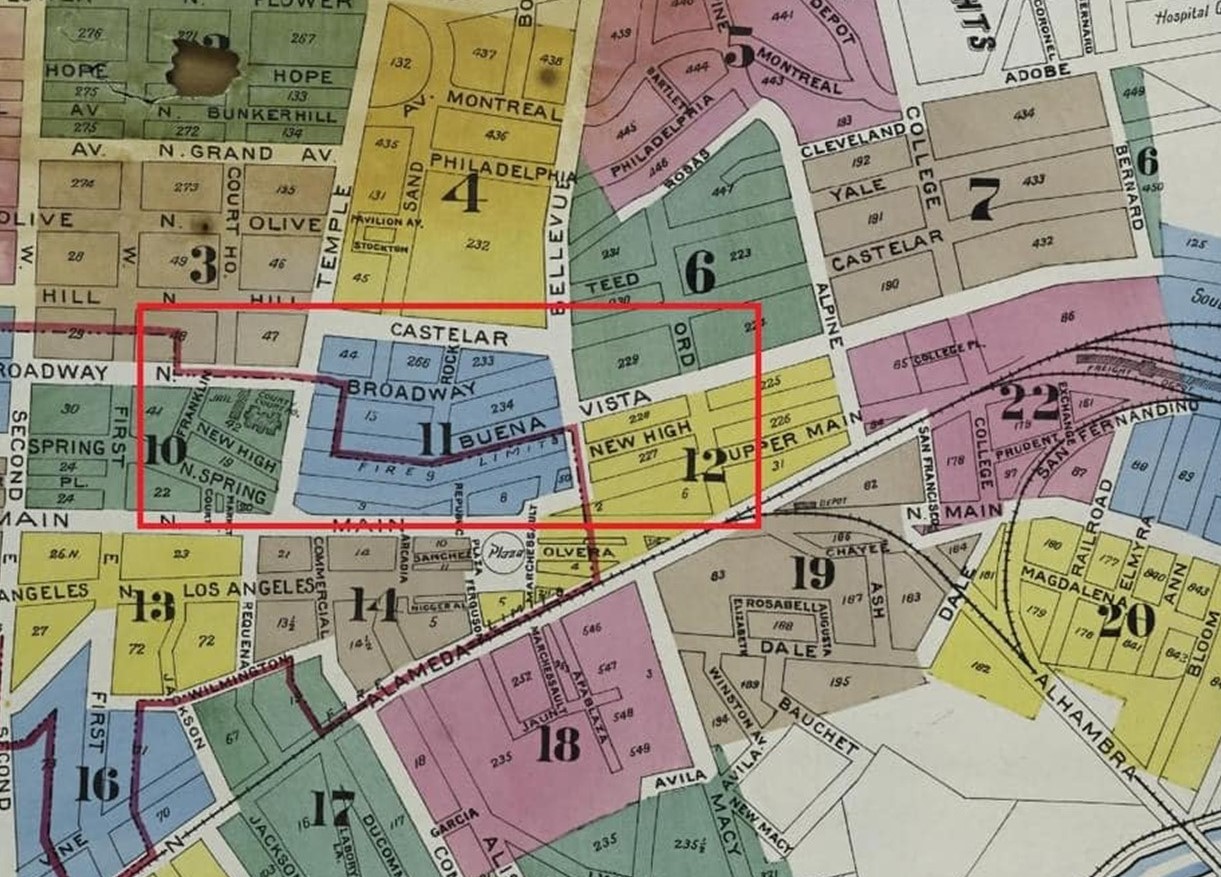 |
|
| (ca. 1886)* - Early map showing Buena Vista Street, where Justicia Street was previously identified. This map suggests that Justicia Street was originally named Buena Vista Street. The exact year of the name change remains undetermined. |
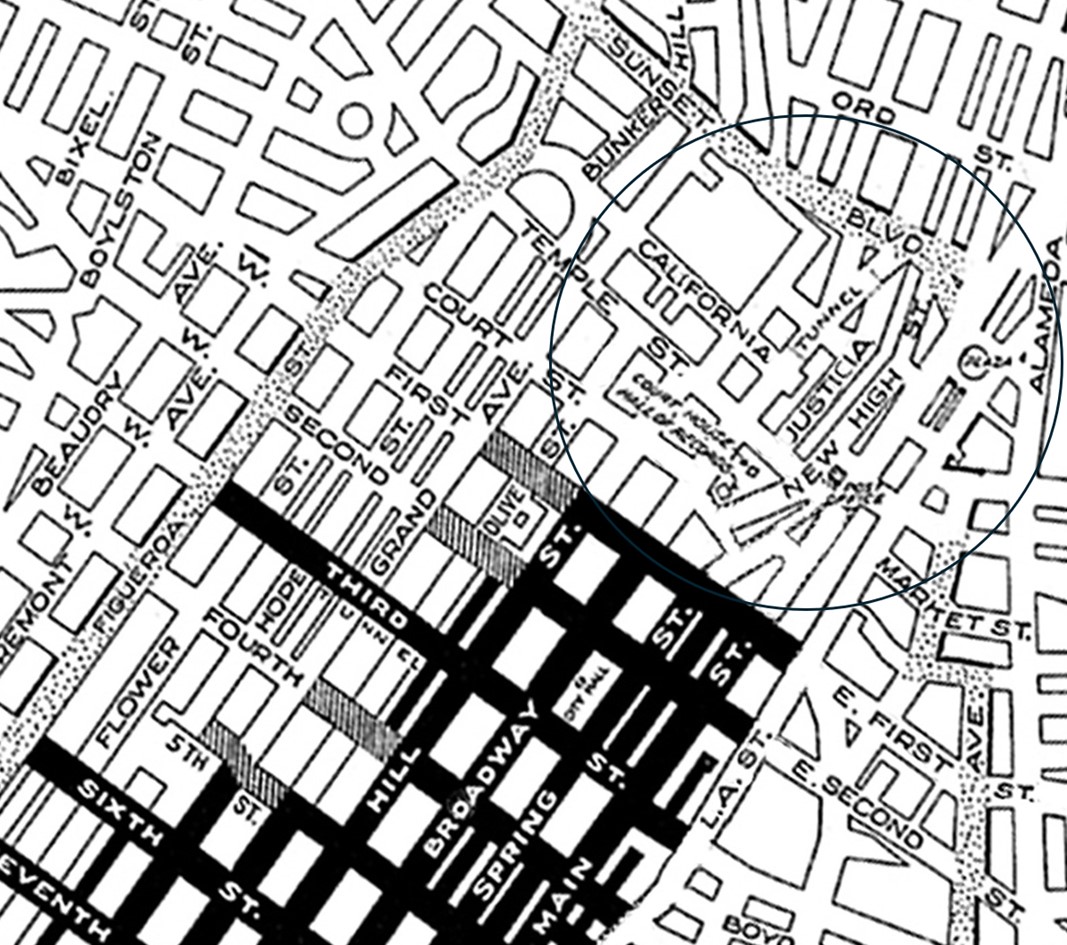 |
|
| (1920s)* - Map showing the fragmented configuration of streets near Temple and Justicia Streets. |
Historical Notes The area bordered by Main St., Broadway, Temple St., and First St. has a complex street layout due to the original, somewhat disorganized design and the renaming and removal of some streets in the late 1920s. As a result, even longtime residents may not recognize older names like “Jail St.” or “Pound Cake Hill” when looking at maps from 1900 to 1920. |
 |
|
| (1930)* - View looking north, showing the proposed Spring Street extension that will cut through from Temple Street to Sunset Boulevard, creating a new traffic artery. The dotted lines indicate the path of the extension, which will eliminate Justicia Street as it ascends the hill on the left. The first building intersected by the dotted lines is the old county jail, with the old Hall of Justice just behind it. The building on the left is the Old County Courthouse. |
Historical Notes Justicia Street was eliminated during the extensive redevelopment of downtown Los Angeles in the early to mid-20th century, which coincided with the construction of the current City Hall completed in 1928. This period also saw the realignment and extension of Spring Street, along with the demolition and alteration of many older streets and buildings to accommodate new government structures in the Civic Center district. |
* * * * * |
Bellevue Avenue and Buena Vista Street (later Sunset Boulevard and Justicia Street)
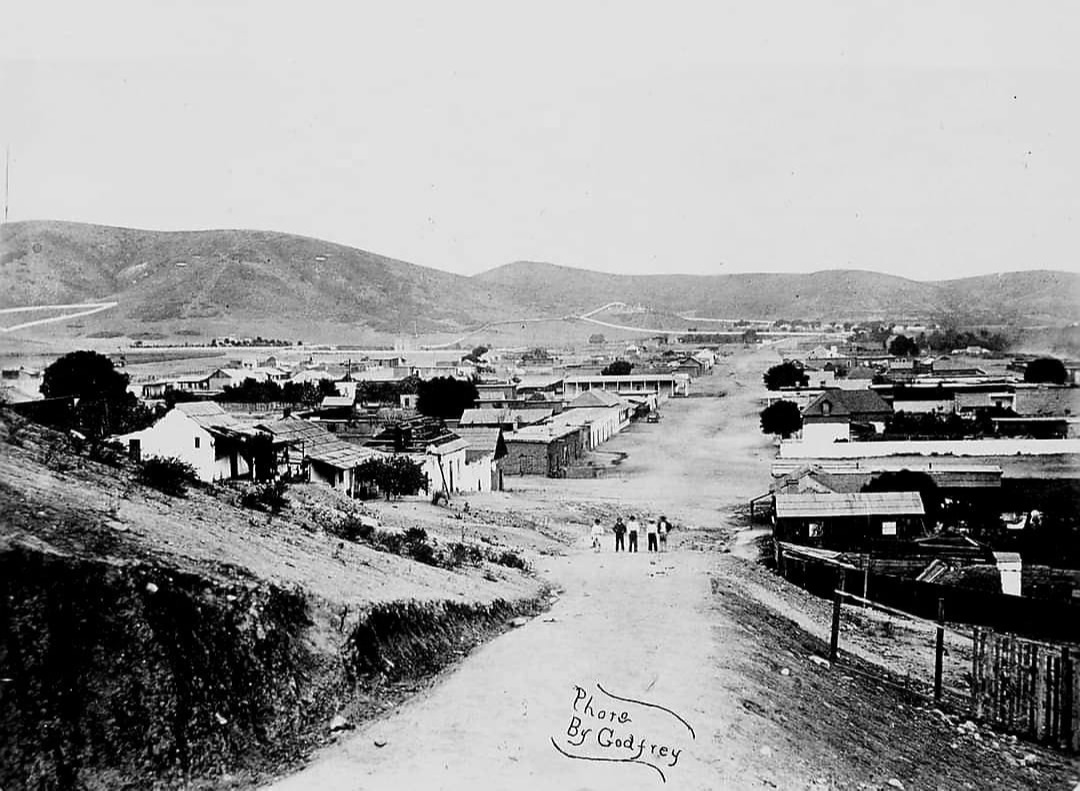 |
|
| (1870s)* - View looking north from the edge of Fort Moore Hill along Buena Vista Street (later Justicia Street) toward Bellevue Avenue (later Sunset Boulevard), where it continues as Eternity Street (now North Broadway) in Sonora Town. |
Historical Notes In 1884, Eternity Street was renamed Buena Vista Street. In 1909, Buena Vista Street became North Broadway. Bellevue Avenue became Sunset Boulevard in the ealy 1900s (before 1924). Sunset Boulevard was officially renamed Cesar Chavez Avenue in 1994. |
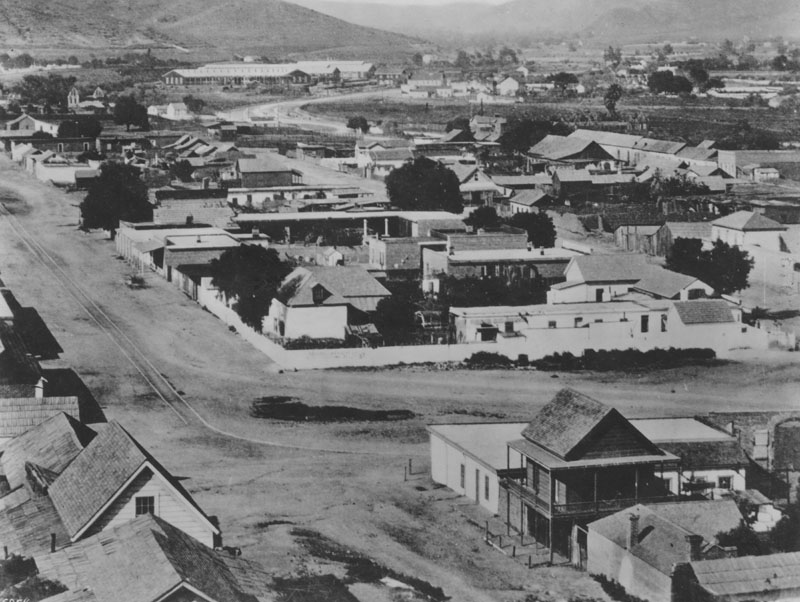 |
|
| (1871)^ - View looking northeast from General Phineas Banning's residence on Fort Hill toward the intersection of Buena Vista Street and Bellevue Avenue (later Sunset). North of Bellevue, Buena Vista would later become North Broadway, while south of Bellevue, it would be named Justicia Street. Beyond the intersection lies Sonora Town, with the Southern Pacific Railroad shops visible in the distance. |
Historical Notes Buena Vista Street, south of Bellevue Avenue (later Sunset Boulevard), was renamed Justicia Street. After the Broadway Tunnel was built in 1901, Broadway extended under Fort Hill and merged with Justicia Street near Sunset Boulevard, continuing north as North Broadway. Justicia Street ran from Temple Street—located one block east of Broadway—over Fort Hill and merged with Broadway as it exited the tunnel at Sunset. |
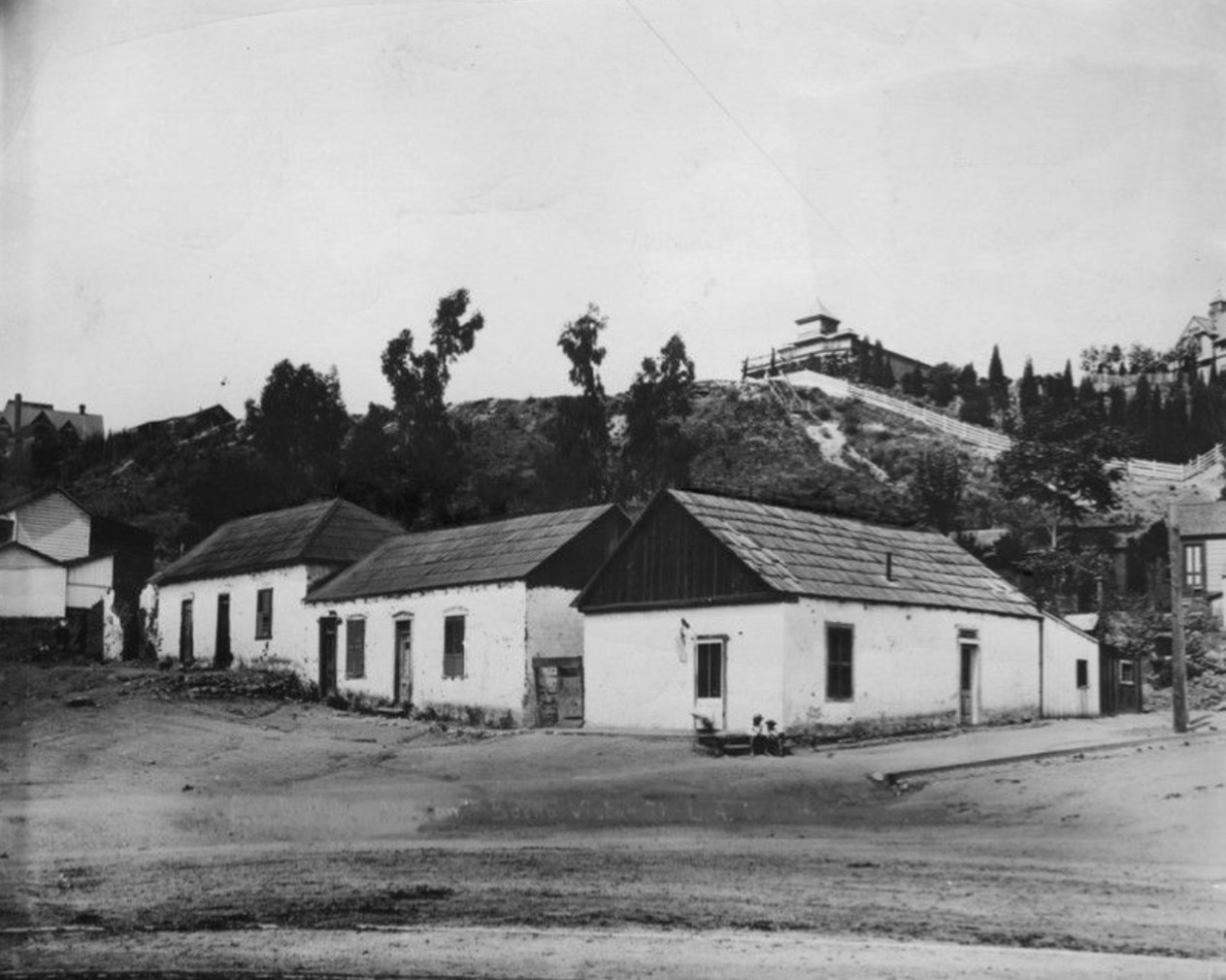 |
|
| (1885)* - Looking southwest toward Fort Hill from the intersection of Bellevue Avenue and Buena Vista Street (later Sunset Boulevard and Justicia Street). The Banning House can be seen at the top of the hill. |
Historical Notes Buena Vista, south of Bellevue Avenue (later Sunset Boulevard), was renamed Justicia Street. When the Broadway Tunnel was built in 1901, the road split: one branch continued east over Fort Hill as Justicia Street, while the tunnel route was renamed North Broadway. |
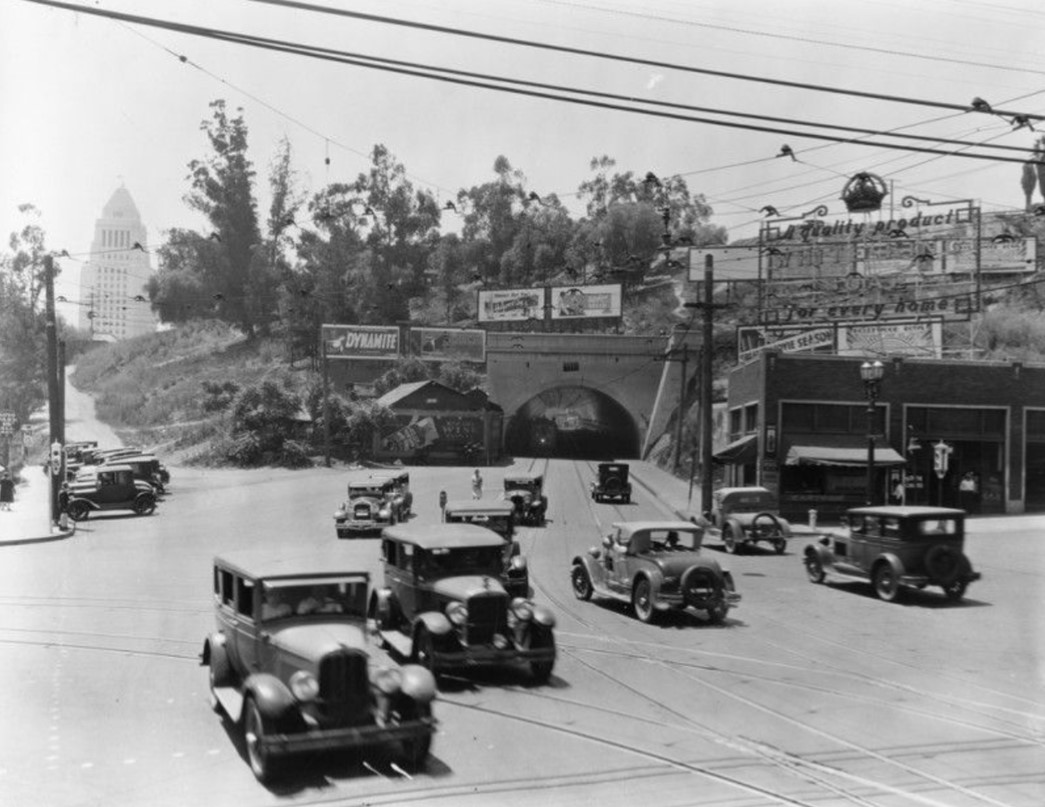 |
|
| (1929)* - Southwest corner of North Broadway and Sunset Boulevard, showing the north portal of the Broadway Tunnel, which later was demolished, the hill removed and the street widened. The newly constructed City Hall (1928) can be seen in the background. |
Historical Notes The road running up the hill on the left is Justicia Street, which extended south to Temple Street, ending in front of the Los Angeles County Courthouse between Broadway and Spring Streets. It was one of the last dirt roads in downtown Los Angeles. Click HERE to see more of the intersection of Justica Street and Sunset Boulevard. |
* * * * * |
Temple Block
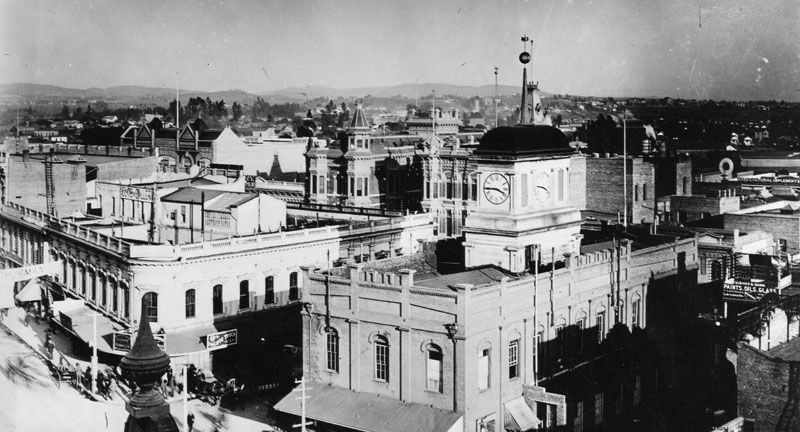 |
|
| (1885)^ - View showing the Temple Block with clock-tower, home of the Los Angeles County Courthouse. Further back are two three-story Victorian-style buildings: the Amestoy Building and the United States Hotel located at the intersection of Main Street and Requena Street (later Market Street). The intersection of Market and Spring streets is at lower left. |
Historical Notes Jonathan Temple, a merchant from Massachusetts, played a crucial role in shaping Los Angeles by establishing the Temple Block in 1828. He started with a general store at Main and Spring Streets, turning the area, known as Temple Square, into the city's commercial hub. In 1848, Temple built a two-story adobe building on the block, and over the following decade, he expanded it with additional structures, including a two-story brick building in 1857, marking a shift from adobe to brick construction. As a pioneer in urban development, Temple introduced paved sidewalks and street trees to improve the area's attractiveness. In 1871, he replaced the adobe building with a three-story Italianate structure called the New Temple Block, which accommodated retailers and offices. Although the Temple Block faced economic difficulties due to the end of the Gold Rush and a national depression in the late 1850s, it remained a significant business center until the early 20th century. By the mid-1920s, the area was redeveloped for a new Civic Center, leading to the demolition of the Temple Block and the completion of the Los Angeles City Hall on the site in 1928. |
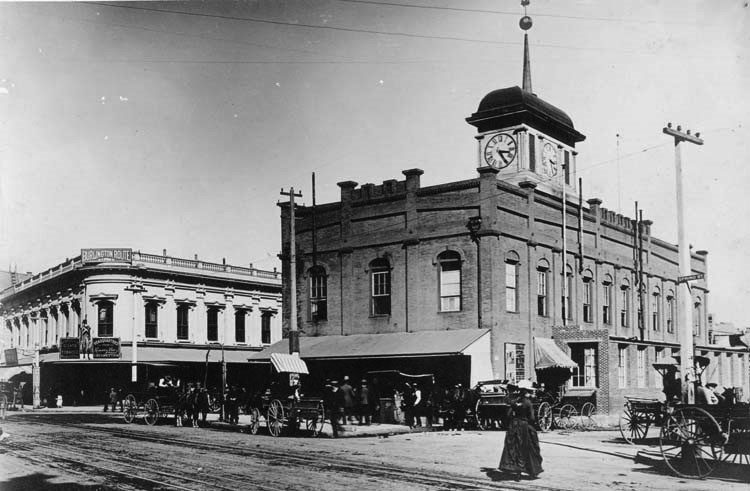 |
|
| (1880s)* – View looking northeast showing the Los Angeles County Courthouse with its clock tower. The corner of the courthouse closest to the camera is on the southwest corner of Spring and Court streets. |
Historical Notes Los Angeles County Courthouse was originally located at the Plaza in the old pueblo, but later it moved to the Temple Building, part of the Temple Block complex constructed by Jonathan Temple. This building, one of the earliest significant structures in the growing city, served as the courthouse around 1880. This period was crucial for Los Angeles as it transitioned from a small pueblo to a burgeoning American city. The Temple Building thus played an important role in the city's legal and civic development during this transformative era. |
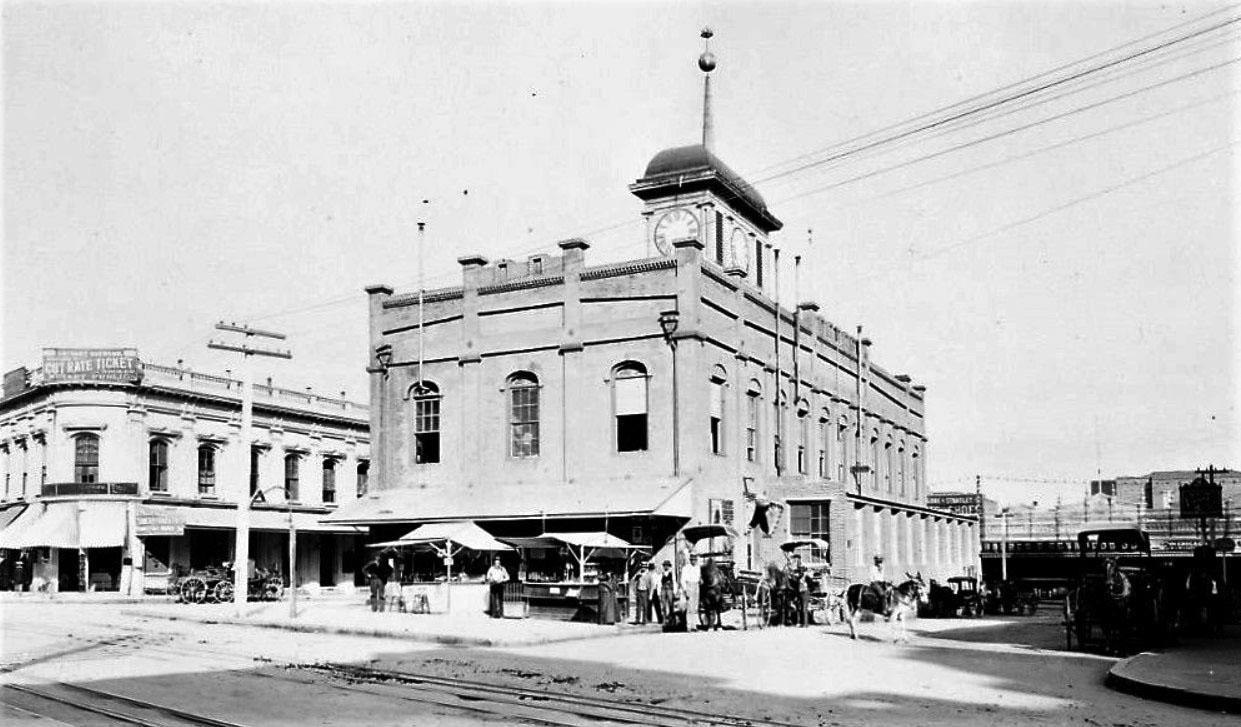 |
|
| (1891)* – View looking toward the Temple Block from Spring Street with Court Street on the right and Market Street at left. Main Street can be seen in the distance on the right. |
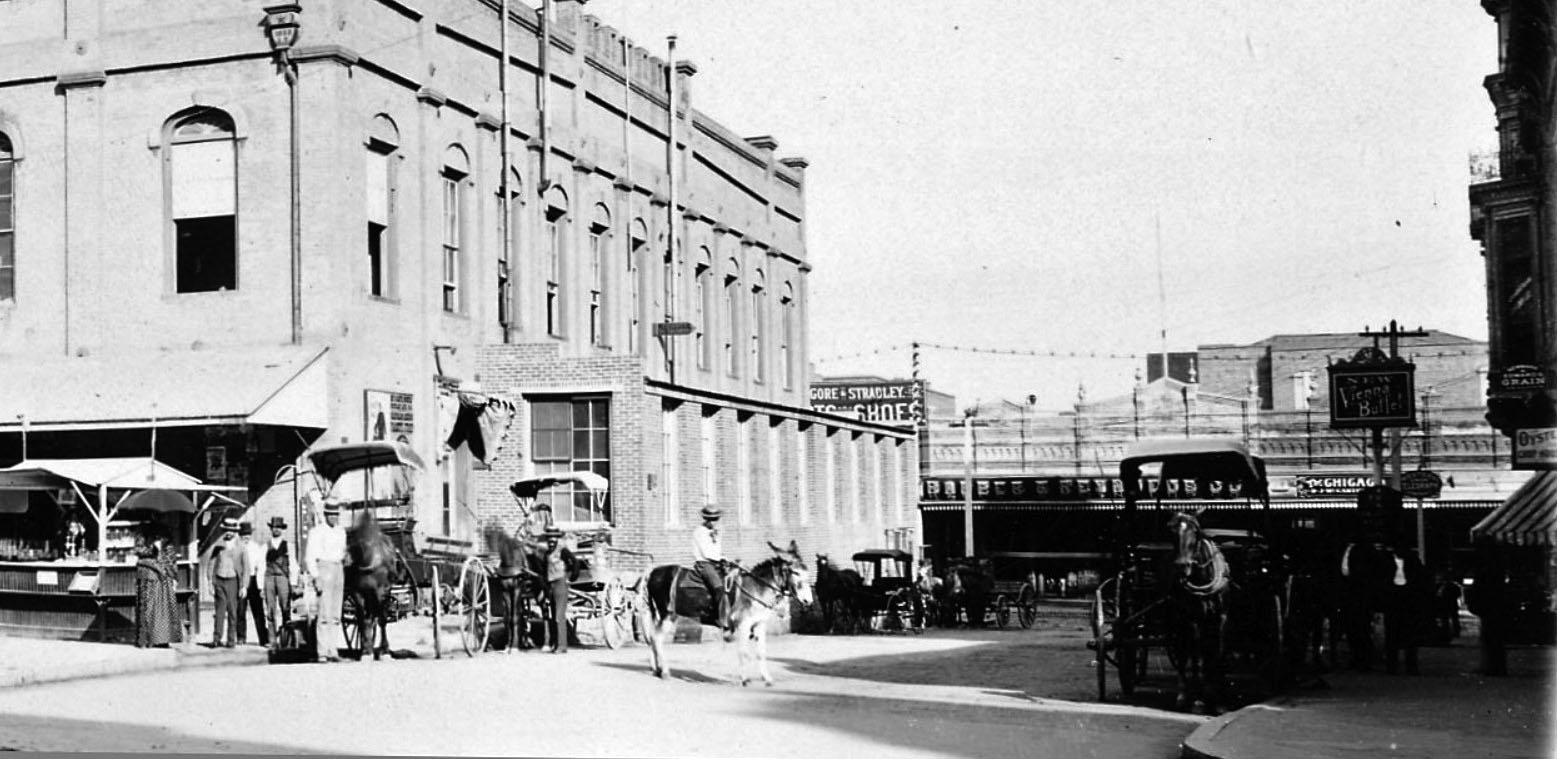 |
|
| (1891)* – Blow-up view of previous photo showing Court Street looking east toward Main Street as seen from Spring Street. A young man is seen on a donkey in the middle of the street while several horse-drawn wagons are parked along the curb. |
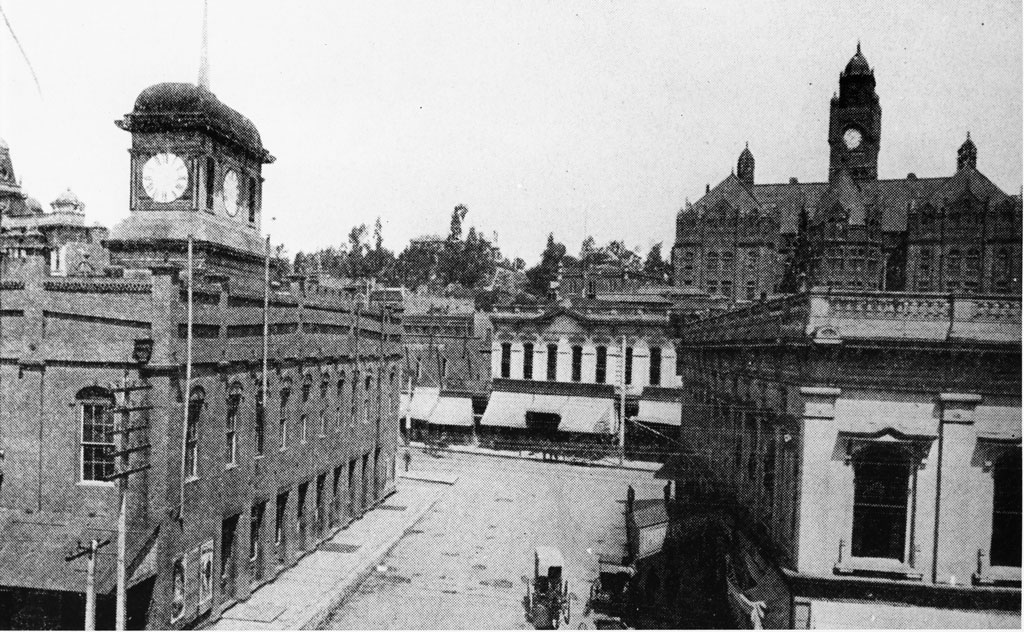 |
|
| (ca. 1891)* - View of Market Street looking west from the cupola of the United States Hotel, soon after the construction of the New Courthouse on Poundcake Hill (background). The old market and Courthouse of Temple Block can be seen at left. |
Historical Notes On the north side of Market was the south portion of the Temple Block; on the south side was the original market building erected in 1859 by John Temple, which later became a County Courthouse (LA's 5th). The Bullard Block (Building) would replace the old Clocktower County Courthouse (NE corner of Spring and Court streets) in the late 1890s. Today, City Hall stands at this location. |
Click HERE to see 'From Temple Block to City Hall' |
* * * * * |
Spring and 1st Street
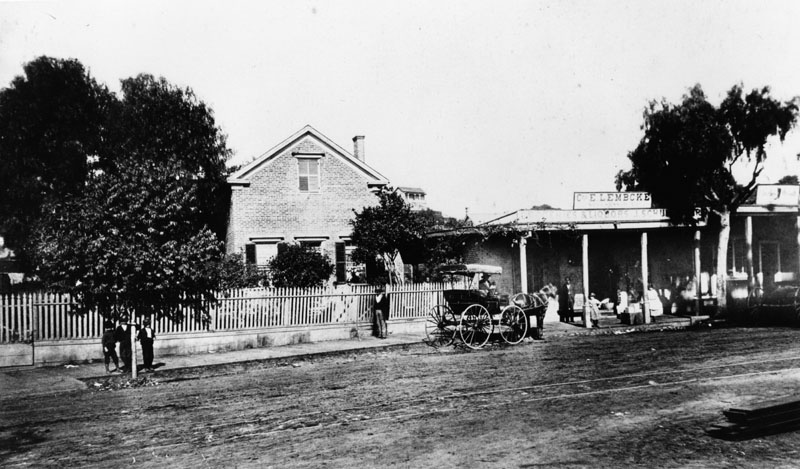 |
|
| (ca. 1885)^ - Showing what was primarily a residential area at the time is the Schumacher residence located on Spring and 1st Streets. This would later be the site of the current LA Times Building. |
Historical Notes John Schumacher was a German immigrant who became a wealthy landowner in Los Angeles and was a member of the city's governing council. He settled in Los Angeles in 1847, but in 1849 Schumacher went to Sutter's Creek, where he found a nugget of gold worth eight hundred dollars. He then bought nearly the whole block bounded by Spring and First streets and Franklin Alley for the value of his famous gold nugget. |
* * * * * |
Fort Street (later Broadway) and 3rd Street
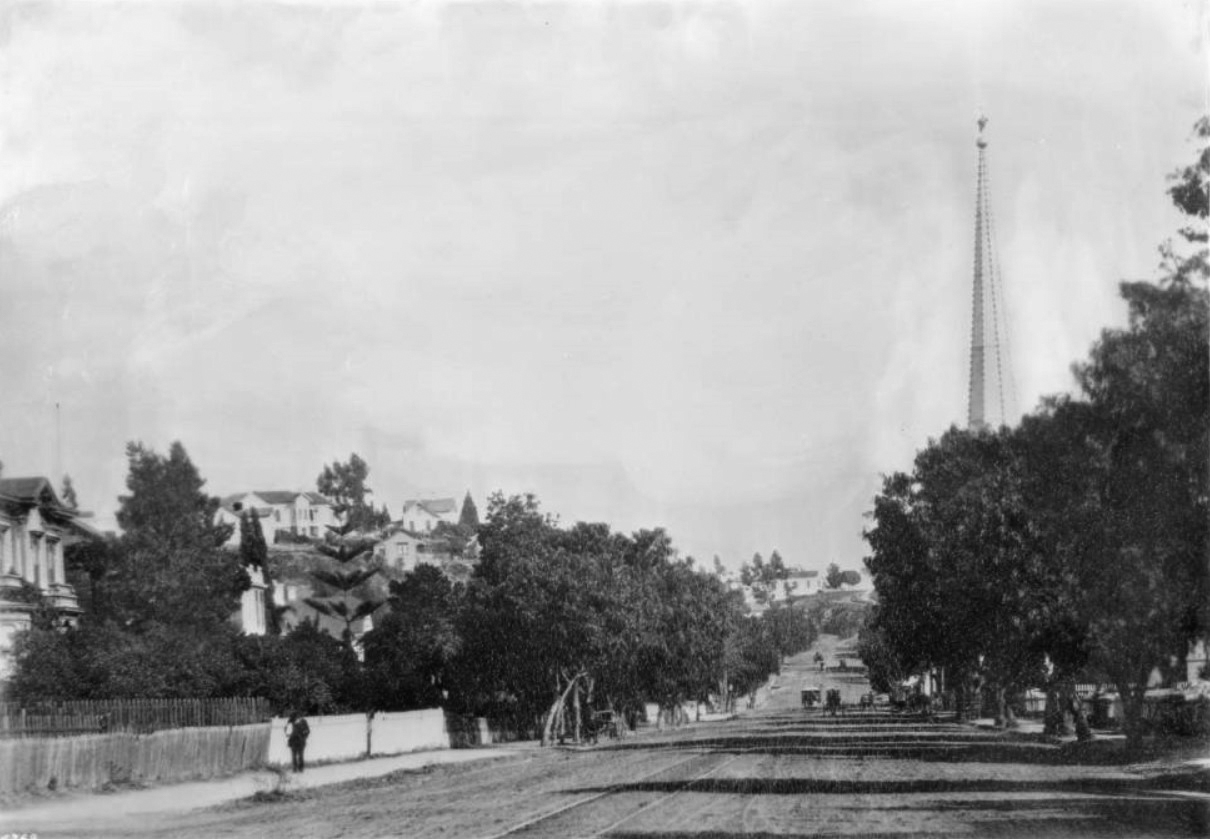 |
|
| (ca. 1882)* - View looking north on Fort Street (later Broadway) from Third Street. The spire of the First Presbyterian Church can be seen above the trees at right. |
Historical Notes Fort Street in Los Angeles, laid out by surveyor Edward O. C. Ord in 1849, was named after Fort Moore, a strategic military site from the Mexican-American War that overlooked the city. By the late 1880s, the city's increasing population of German immigrants found it difficult to distinguish between "Fort Street" and "Fourth Street," causing confusion, particularly with the primitive telephone systems of the time. As Fort Street transitioned from a residential area to a retail district, this confusion became a significant issue. To address this, a group of residents and merchants, led by printer Fred Lind Alles, petitioned for a name change. They chose "Broadway" to project a sense of future growth and emulate the prestige of New York City's famous thoroughfare. The Los Angeles City Council approved the name change on February 17, 1890, and it was signed into ordinance by Mayor Henry Hazard two days later. |
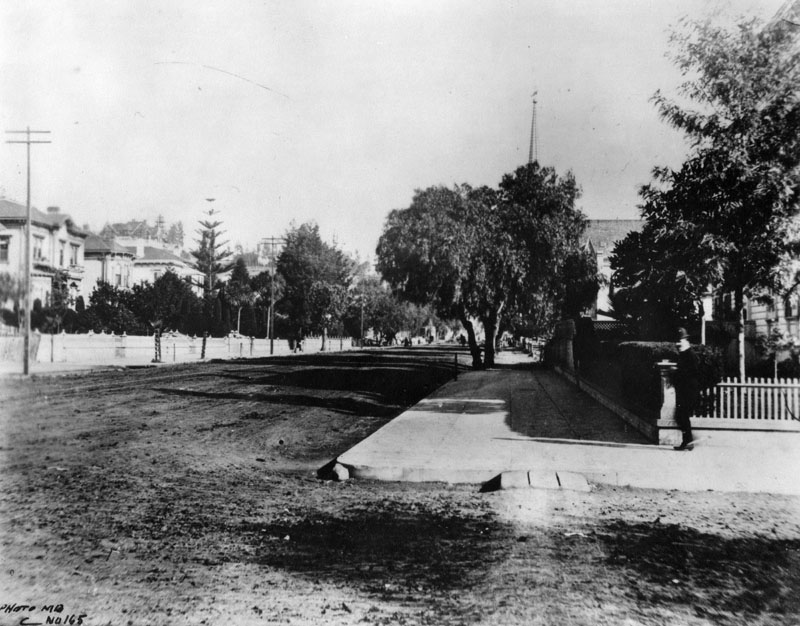 |
|
| (1886)^ - View looking north on Fort Street (later Broadway) from 3rd Street. The streets are unpaved and appear to be residential. The tall spire in the distance is the First Presbyterian Church on the southeast corner of Fort and 2nd Streets. LA's 3rd City Hall would be built on this block in 1888 on the east side of Broadway between 2nd and 3rd streets. Over the course of the next several years the west side of the street would also be built up with commercial buildings. |
Historical Notes Following the renaming, Broadway swiftly emerged as the epicenter of Los Angeles' commercial and entertainment scenes. The segment between 3rd and 9th Streets became particularly renowned for its dense array of theaters and commercial establishments. This area, recognized as the Broadway Theater and Commercial District, is listed on the National Register of Historic Places and boasts the largest collection of historic movie palaces in the United States. |
Then and Now
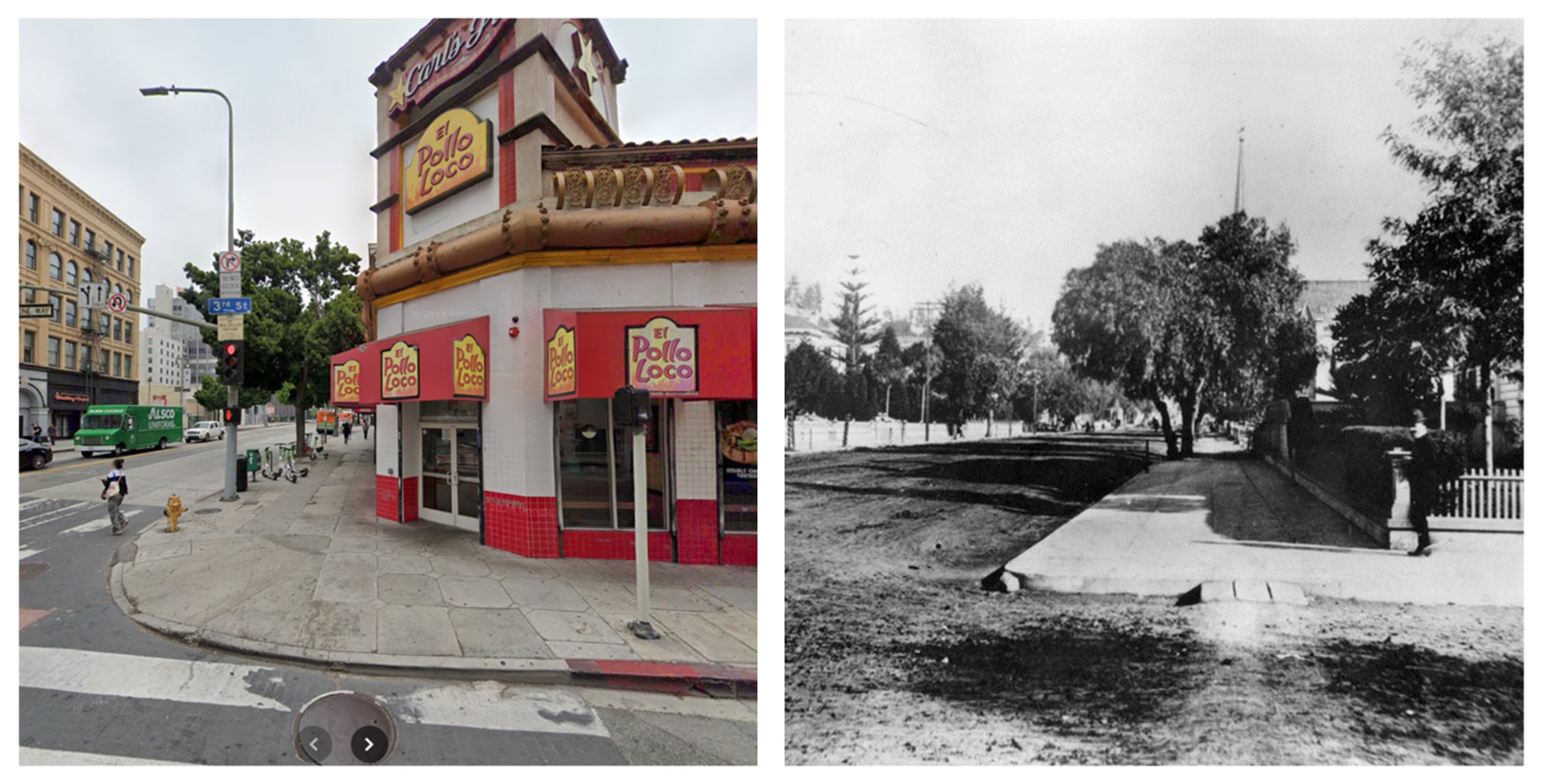 |
|
| (1886 vs 2024)* - Looking north on Fort Street (today Broadway) at 3rd Street. Photo comparison by Jack Feldman. |
* * * * * |
Broadway and 2nd Street
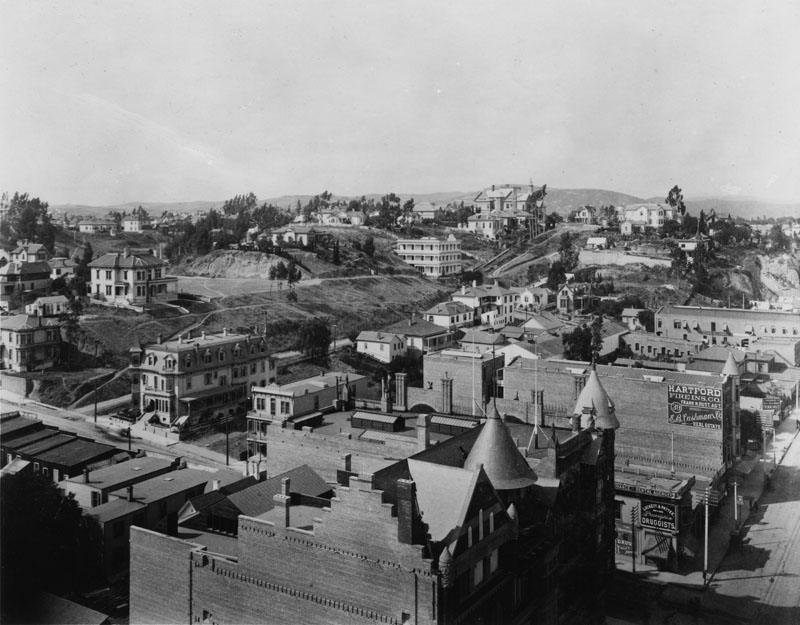 |
|
| (ca. 1887)^ - View looking northwest from the top of City Hall (under construction - completed in 1888) on Broadway. The intersection of 2nd and Broadway is at lower-right where the California Bank Building stands on the southwest corner. The 3-story white building with the balconies (top-center) is the Highland Villa (n/w corner of 1st and Hill). |
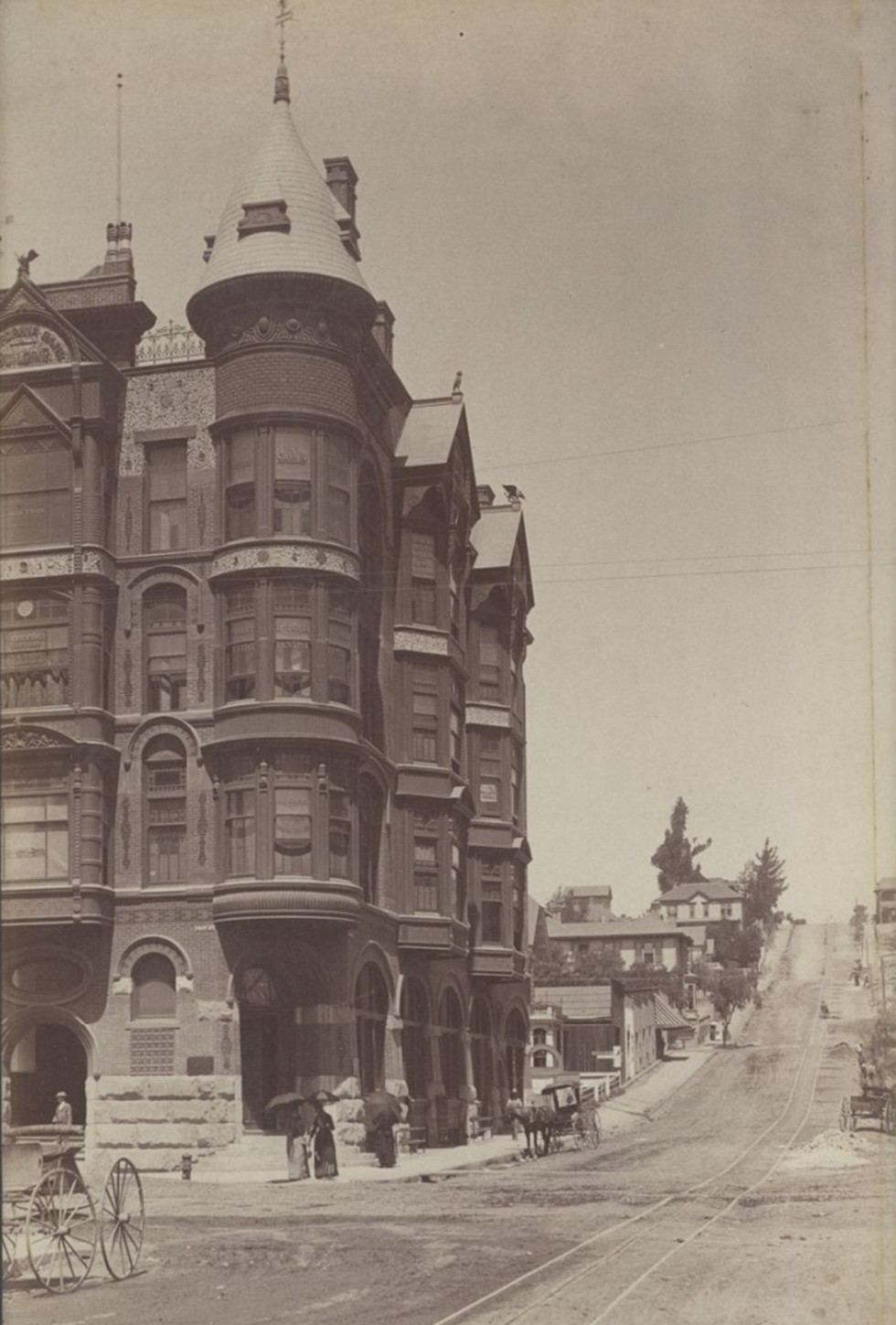 |
|
| (ca. 1890)* - View looking west on 2nd Street at Broadway. Three women are seen walking by the front of the California Bank Building on the southwest corner with horse-drawn carriages parked at the curb. Photo by William H. Feltcher. |
Historical Notes The tracks running down second streets belong to the Second Street Cable Railway, first cable car system to open in Los Angeles (1885). |
Then and Now
.jpg) |
|
| (1890 vs 2022)* - Looking west on 2nd Street at Broadway toward Bunker Hill. In early photo, the ornate building on the SW corner with horse-drawn wagon parked in front is the 1887-built California Bank Building. You can see the tracks of the Second Street Cable Railway, first cable car system to open in Los Angeles (1885), that took passengers up and over Bunker Hill. The current phot shows the Second Street Tunnel that was bored under Bunker Hill between 1916 and 1921. Photo comparison by Jack Feldman. |
Historical Notes Click HERE to see more Early Views of the intersection of Broadway and 2nd Street. |
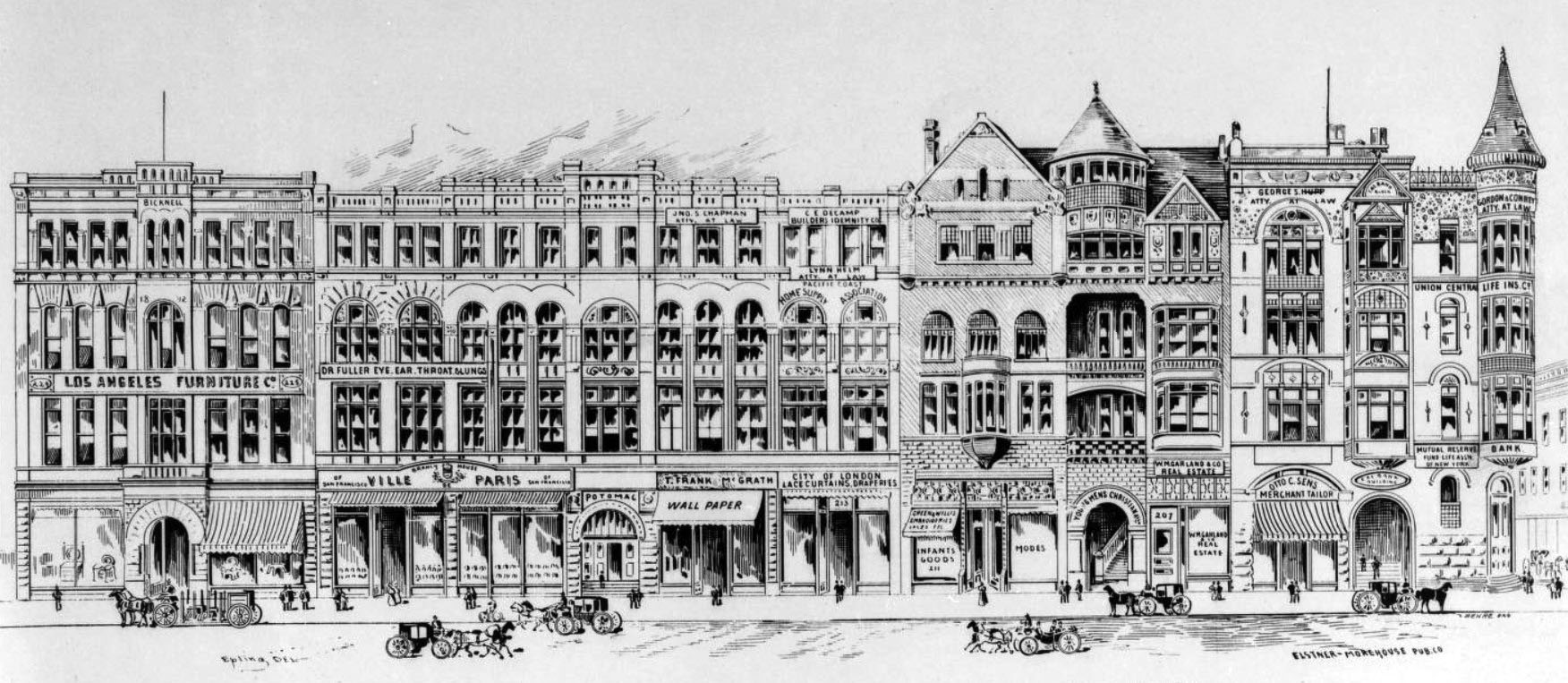 |
|
| (ca. 1890s)^^*- Photograph of an artist's rendering of a portion of a block on the west side of Broadway, between Second and Third Streets, showing commerical buildings and pedestrian traffic. The YMCA Building is the second building from the right. On the southwest corner of Broadway and 2nd Street, next to the YMCA, stands the California Bank Building. On the other side of Broadway are: City Hall , B'nai B'rith Temple, and the First Presbyterian Church. |
Historical Notes A block of commercial buildings, designed in the Second Empire style of architecture, is depicted in detail, with the row of buildings crossing the center of the image. Each building is four stories tall and its front contains many windows; the building at the right edge of the picture is more ornate, with gabled windows and a turret at its outer edge. The bulidings are fronted by a paved sidewalk, which is occupied by pedestrian traffic. The edge of another block can be seen at the rightmost edge of the image, while horse-drawn carriages line Broadway. Legible signs, from left to right, include: "Los Angeles Furniture Co", "Dr. Fuller Eye, Ear, Throat & Lungs", "Ville de Paris", "Jno.S Chapman. Atty. At Law", "T. Frank McGrath Wallpaper", "C.E. Decamp Builders Indemnity Co", "Lynn Helm Atty. At Law", "Pacific Coast Home Supply Association", "City of London Lace Curtains, Draperies", "Green & Willis Embroideries Laces Etc. Infant Goods. Modes", "Young Mens Christian Assn", "W.M.Gar & Co. Real Estate", "George S. Hupp Atty At Law", "Otto C. Sens Merchant Tailor", "Cal-Bank Building", "Gordon & Conrey Atty At Law", "Union Central Life Ins. Co", "Mutual Reserve Fund Life Assn of New York", and "Bank". |
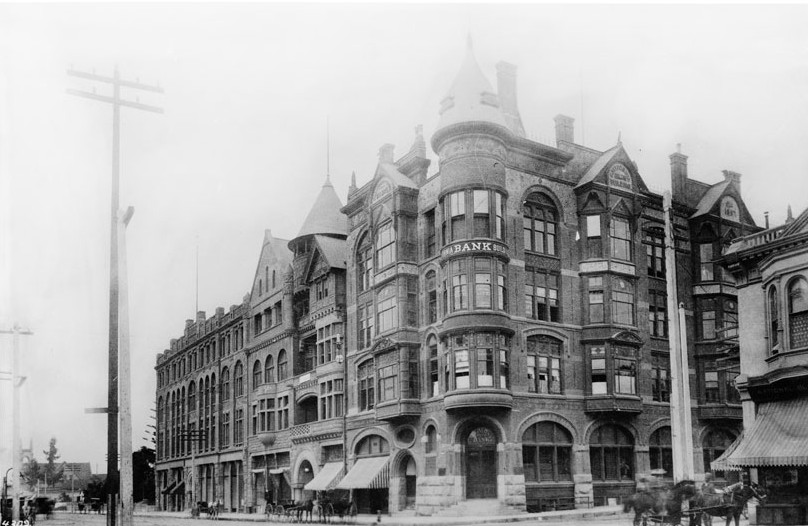 |
|
| (ca. 1889)^^- View looking at the SW corner of Broadway and 2nd Street showing the California Bank, the YMCA and in the distance (lower-left) can be seen the Fort Street Methodist Episcopal Church. Note: Broadway was known as 'Fort Street' until 1890. |
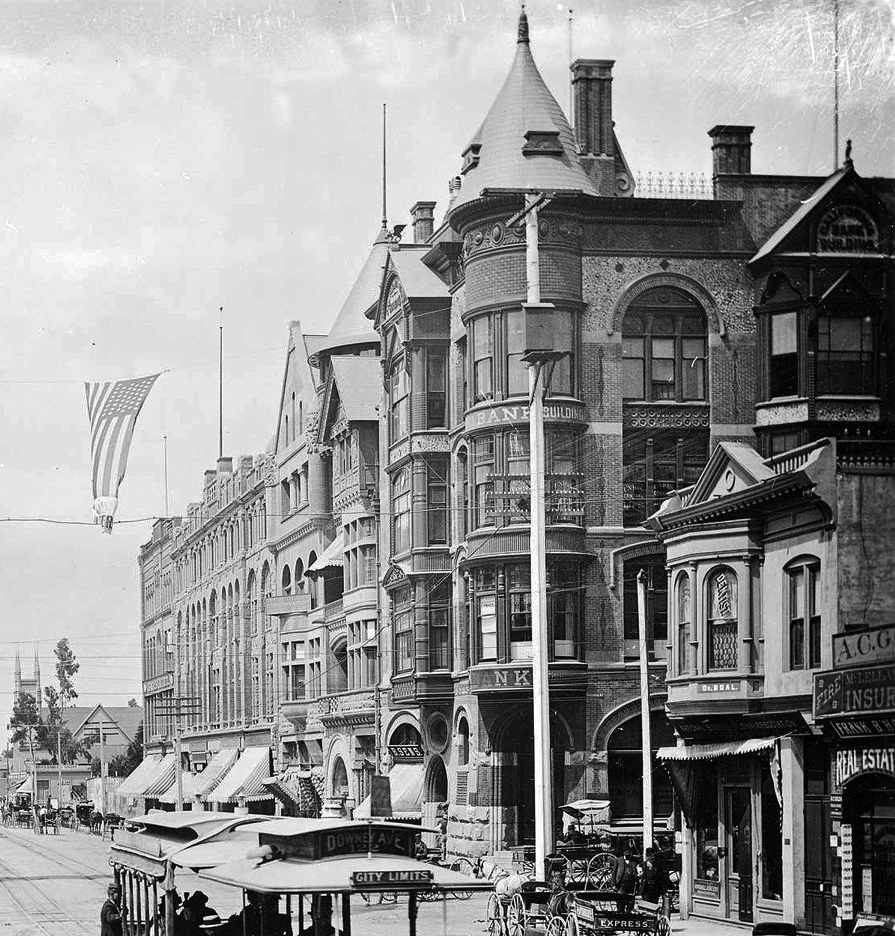 |
|
| (1889)* – View looking south on Broadway at 2nd Street showing the California Bank Building on the southwest corner. City Hall (built in 1888) is across Broadway out of view on the left. In the distance (on the left) can be seen the Fort Street Methodist Episcopal Church |
* * * * * |
Bunker Hill
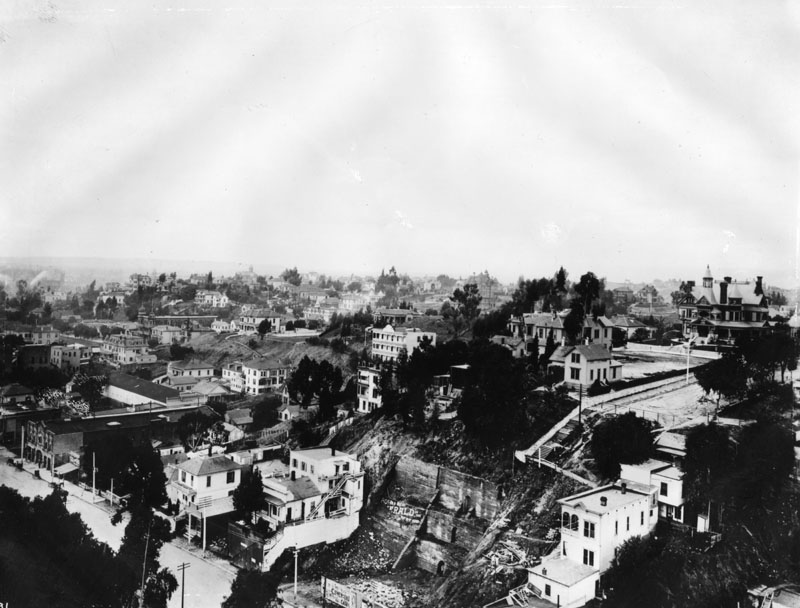 |
|
| (ca. 1886)^ - Panoramic view of Bunker Hill, showing various public buildings and private residences, including the Bradbury Mansion on the far right. The three-story Highland Villa is seen at center (white building). Broadway runs diagonally south(left)/north in the lower left quadrant of the photo. The steep slope with the stairs next to it is the future site of Court Flight, Angels Flight's sister funicular railway. Court St. dead ends at the top of the slope. The Bradbury mansion (built 1886, demolished 1928) is the large house on top of the hill, facing east on to N. Hill St. The house directly across from it (partially hidden by trees), at 138 N. Hill, is the third Los Angeles home (built circa 1881, demolished 1955) of Sarah Bixby Smith, author of "Adobe Days" (1931). The Hill Street Tunnel was put through in 1908 after 1st St. was extended to the west. Court Hill (between Bunker Hill and Poundcake Hill) was removed entirely in the mid- to late 1950s. |
Historical Notes In 1867, a wealthy developer, Prudent Beaudry, purchased a majority of the hill's land. Because of the hill's excellent views of the Los Angeles Basin and the Los Angeles River, he knew that it would make for an opulent subdivision. He developed the peak of Bunker Hill with lavish two-story Victorian houses that became famous as homes for the upper-class residents of Los Angeles. Angels Flight (built in 1901), now dubbed "The World's Shortest Railway", took residents homeward from the bottom of the 33% grade and down again. Prudent Beaudry served as the 13th Mayor of Los Angeles, California from 1874 to 1876. Beaudry Avenue was named after him. |
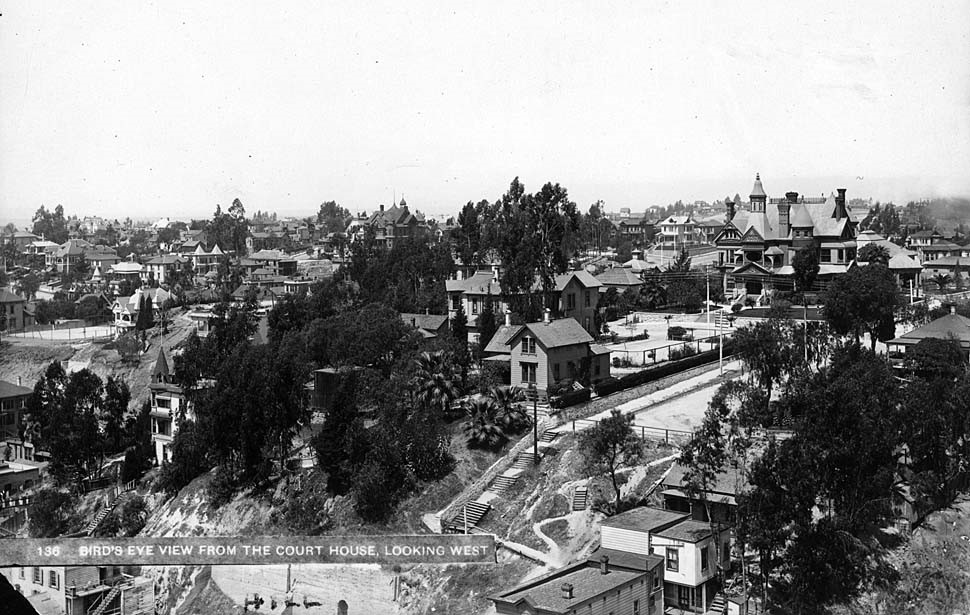 |
|
| (ca. 1895)^^ - View of Bunker Hill from the Court House roof. The Court Street cul de sac is seen (before the installation of Court Flight). Bradbury Mansion is shown at the intersection of Hill and Court Streets. The Bixby house (two story directly across Hill St. from Bradbury) appears at the center of frame. |
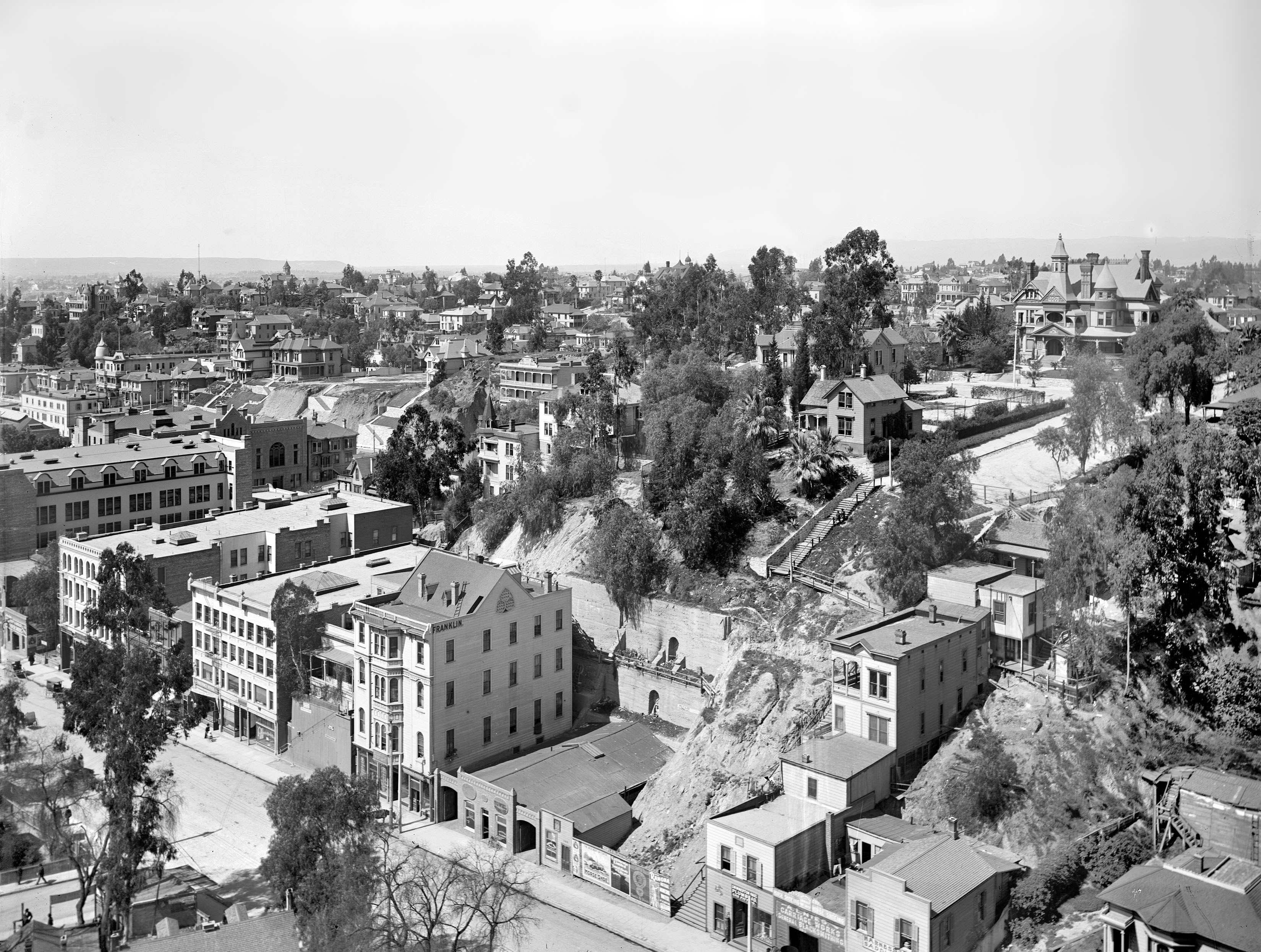 |
|
| (1899)* - Similar view of Bunker Hill as previous two photos but several years later. Note the new buildings on Broadway in the foreground. |
Historical Notes The steep slope with the stairs next to it is the future site of Court Flight (1905), Angels Flight's sister funicular railway. Court St. dead ends at the top of the slope. |
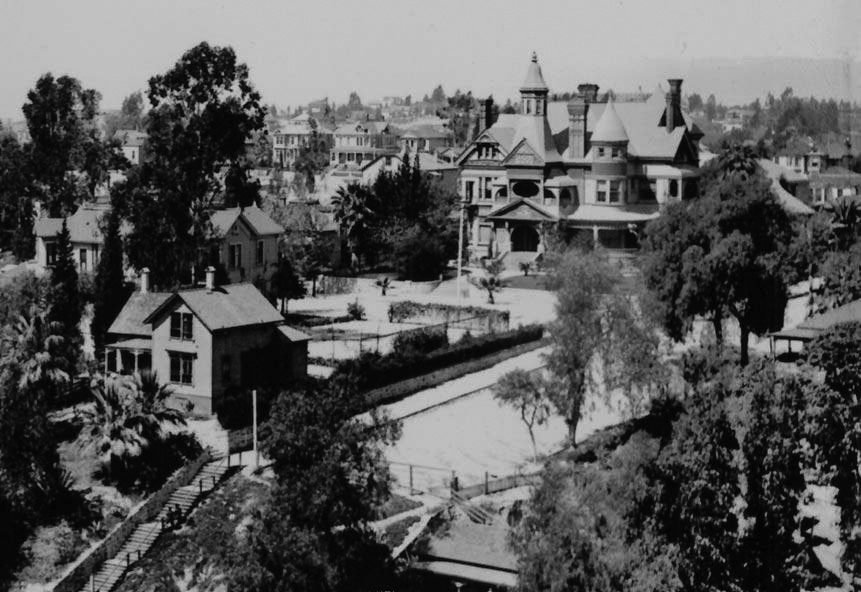 |
|
| (ca. 1900)^^ - Closer view of Bunker Hill showing the staricase leading up to the end of Court Street. The magnificent Bradbury Mansion sits on top of the hill as well as Sarah BixbySmith's home across the street (left of photo). |
Historical Notes After Lewis Bradbury's widow moved out of the Bradbury Mansion, it was used as a club for judges, then as the Rollin Film Studio and finally, as a rooming house before being demolished in 1928. |
* * * * * |
3rd Street and Broadway
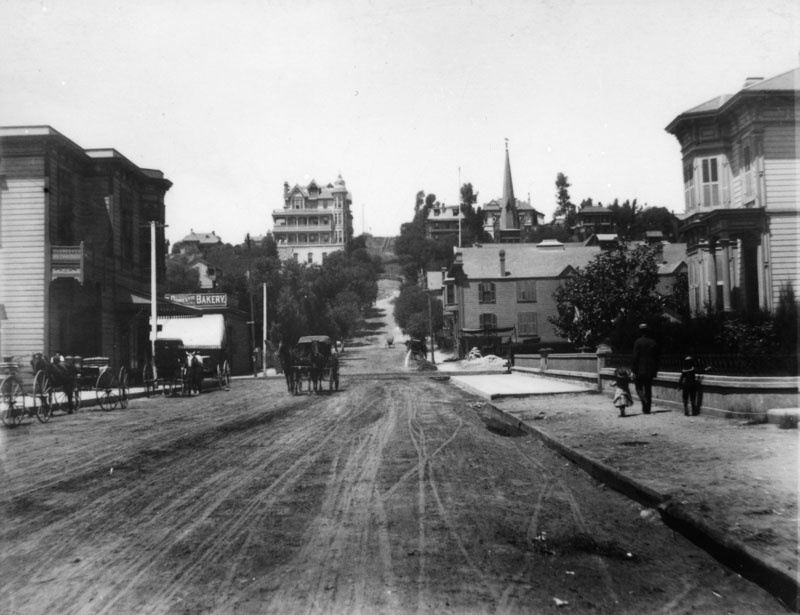 |
|
| (1888)* - Looking west on an unpaved 3rd Street toward Broadway, you can see the Crocker Mansion atop Bunker Hill in the distance. The steeple of the First Congregational Church on the northeast corner of 3rd and Hill Street is also visible. The Bradbury Building would later be constructed on the southeast corner of 3rd and Broadway in 1893. Photo by C.C. Pierce |
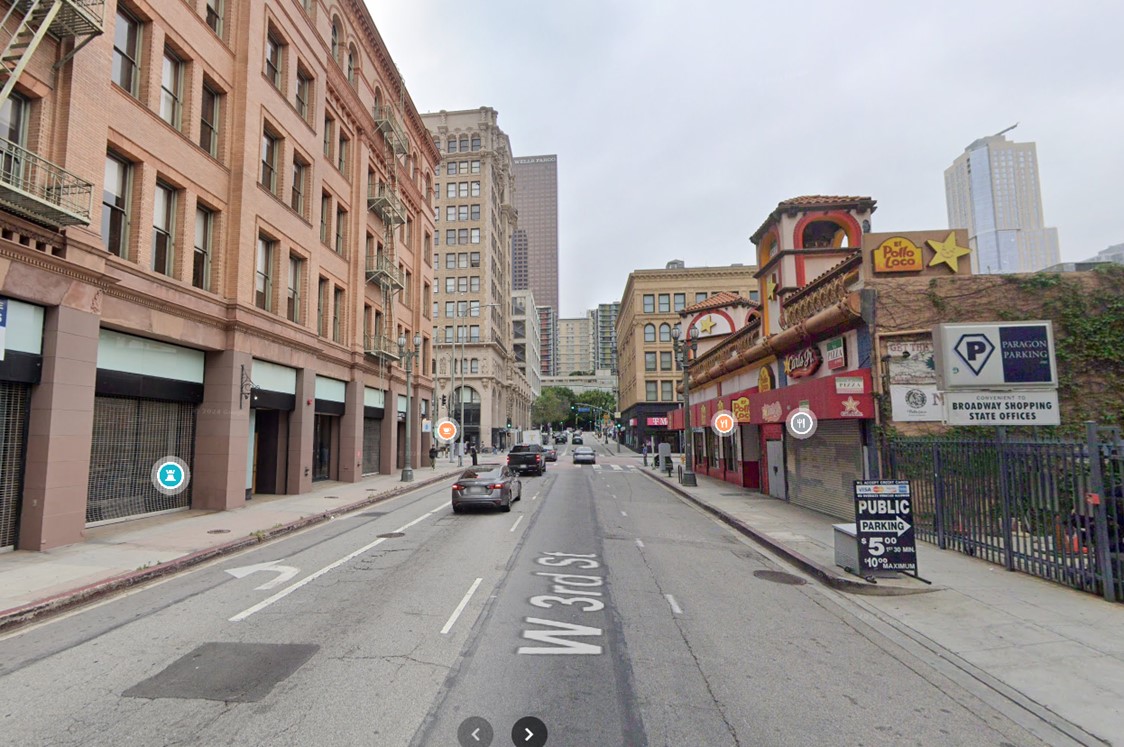 |
|
| (2024)* - Looking west on 3rd Street toward Broadway with the Bradbury Building seen on the left (Southeast corner). |
Then and Now
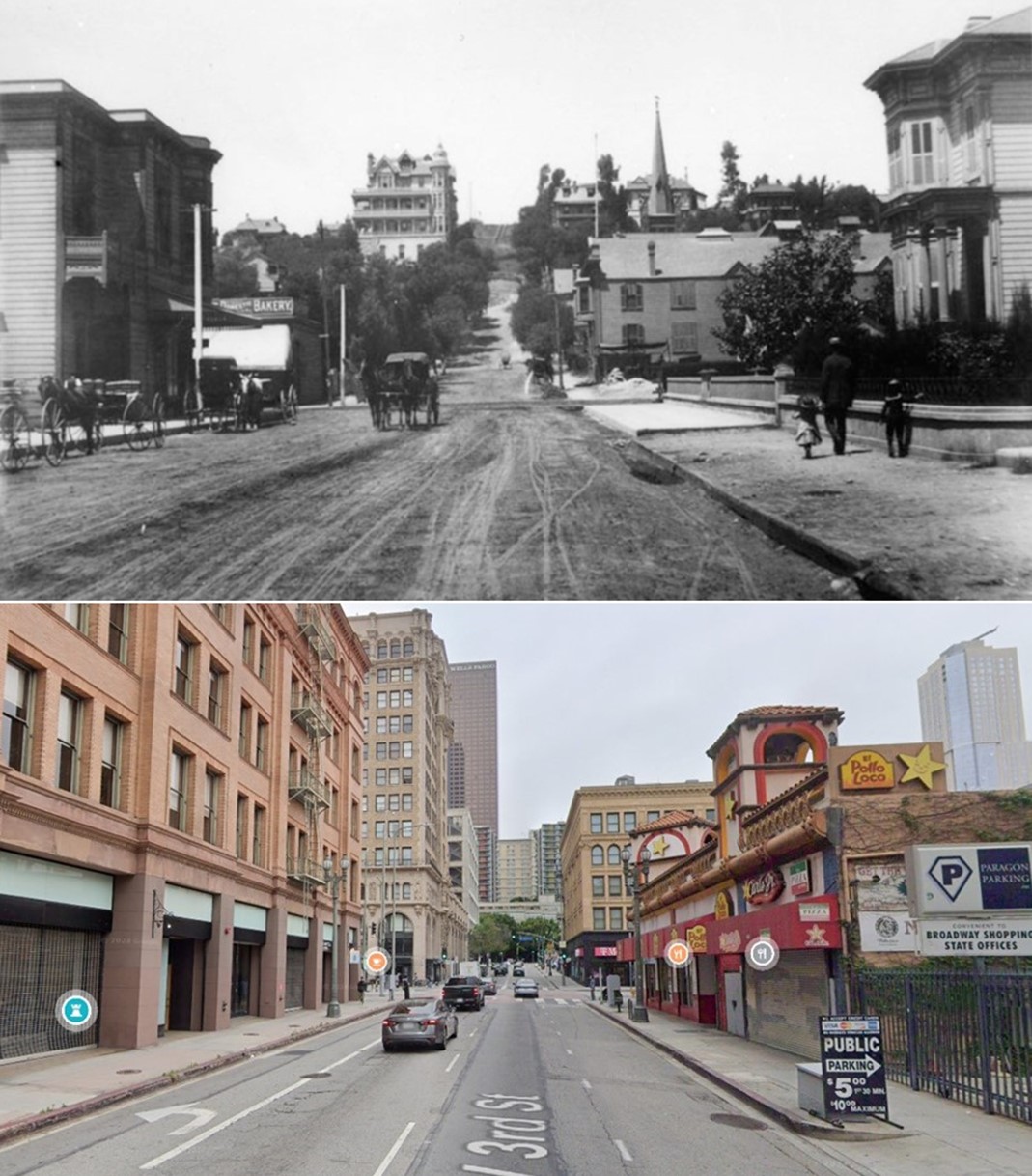 |
|
| (1888 vs 2024)* - Looking west on 3rd Street toward Broadway in downtown Los Angeles. In the older image, you can see the Crocker Mansion atop Bunker Hill in the distance, and the steeple of the First Congregational Church on the northeast corner of 3rd and Hill Street. In the contemporary photo, the Bradbury Building, built in 1893, is visible on the left (southeast corner). Photo comparison by Jack Feldman. |
* * * * * |
Hill and 3rd Streets
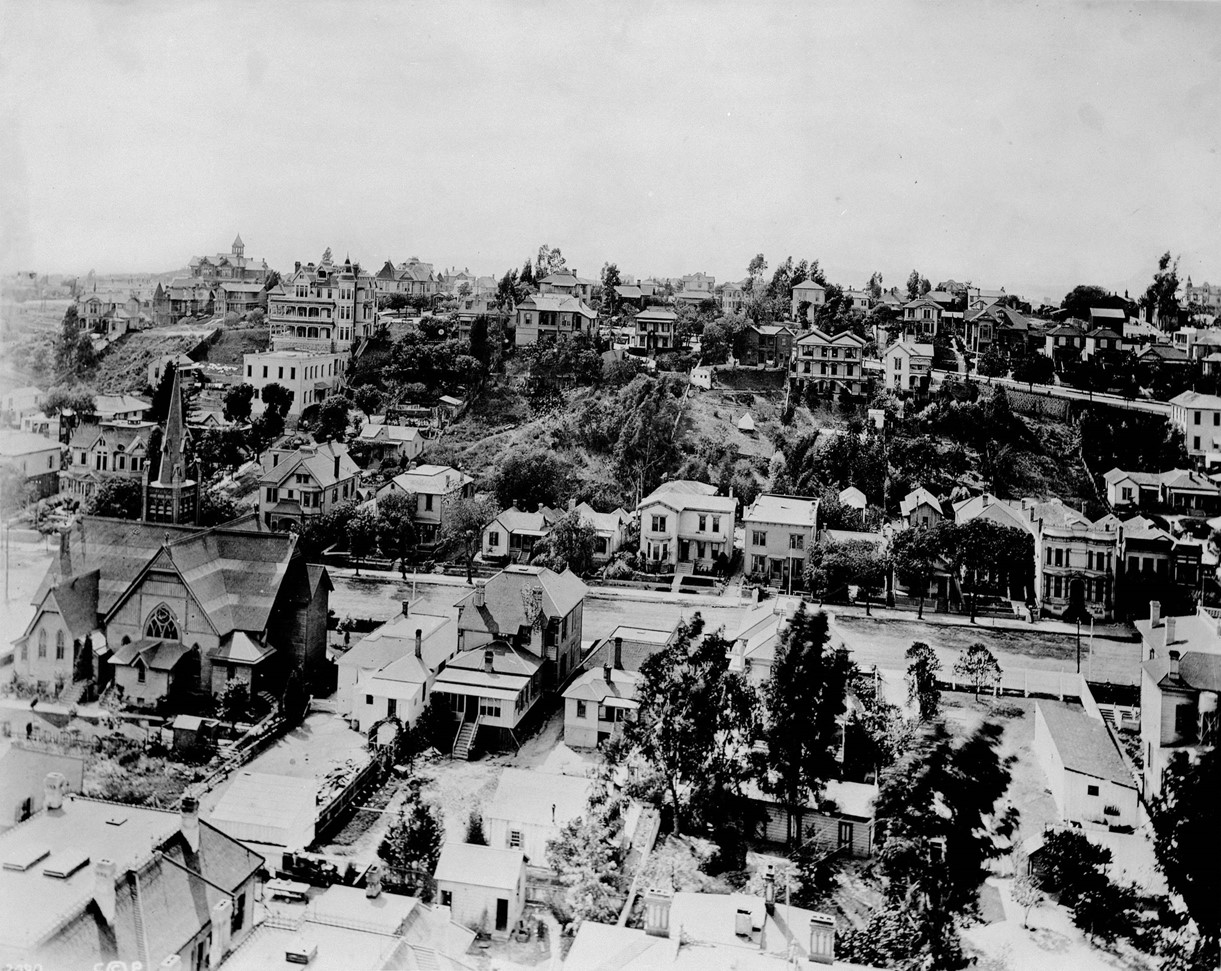 |
|
| (ca. 1888)* - Panoramic view looking west toward Bunker Hill, showing Hill Street between 2nd and 3rd Streets as seen from the tower of the 1888 Los Angeles City Hall at 228 S. Broadway. Visible landmarks include the First Congregational Church on the northeast corner of Hill and 3rd, and the 3-story Victorian Crocker Mansion perched atop Bunker Hill, both seen on the left. Photo by C. C. Pierce. |
Historical Notes In 1888, the intersection of Hill and 3rd Street in downtown Los Angeles was part of the prestigious Bunker Hill neighborhood. This area, developed in the 1870s by Prudent Beaudry, had become an upscale residential district featuring grand Victorian mansions and luxury hotels. The south side of 3rd Street and the west side of Hill Street were lined with impressive Queen Anne-style houses, offering panoramic views of the rapidly expanding city below. At this time, 3rd Street steeply ascended Bunker Hill, as the 3rd Street Tunnel had not yet been constructed. |
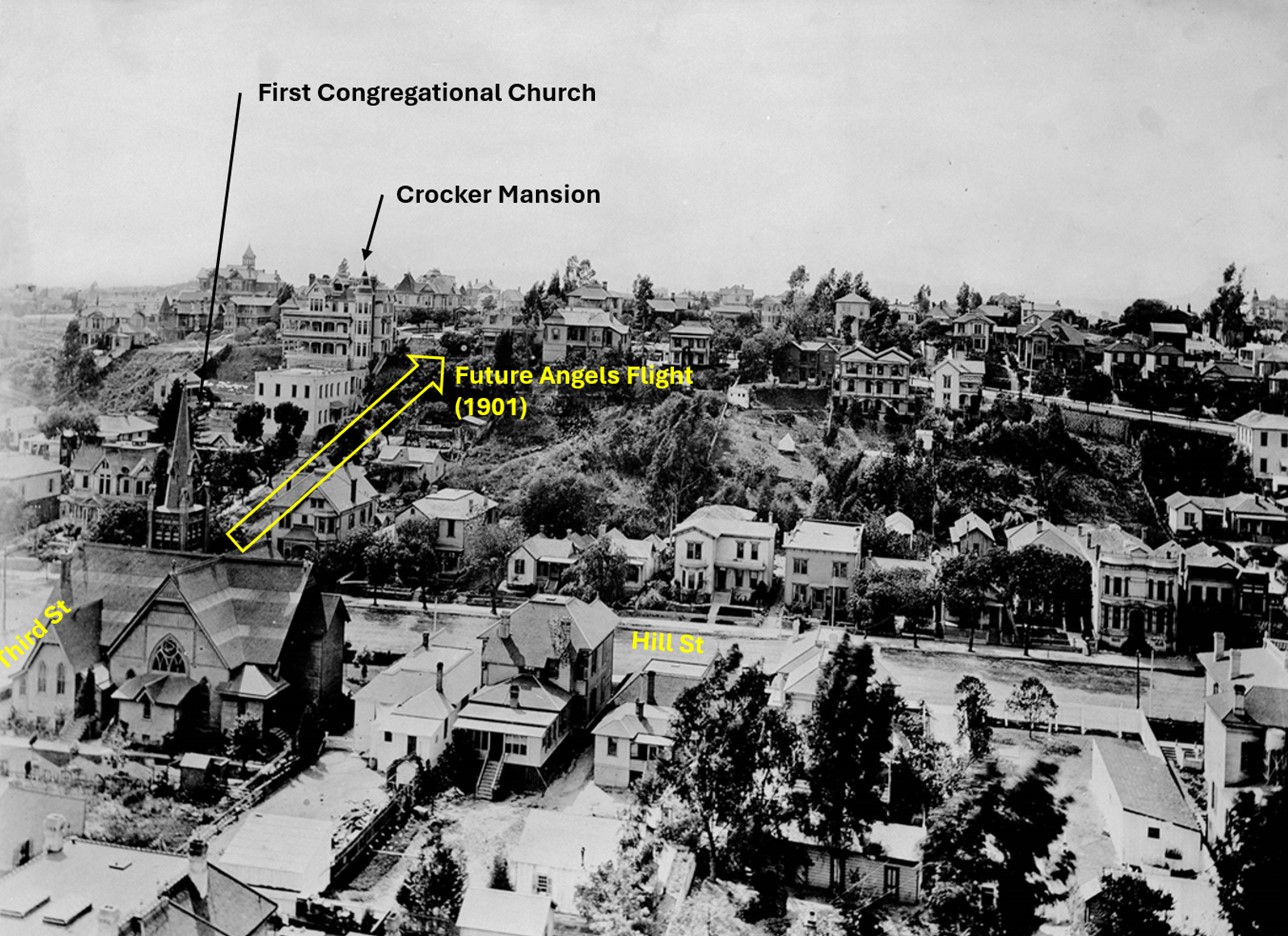 |
|
| (ca. 1888)* - Panoramic view looking west toward Bunker Hill, showing Hill Street between 2nd and 3rd Streets as seen from the tower of the 1888 Los Angeles City Hall at 228 S. Broadway. Visible landmarks include the First Congregational Church on the northeast corner of Hill and 3rd and the 3-story Victorian Crocker Mansion perched atop Bunker Hill. Also highlighted is the future site of Angels Flight, built in 1901, with the adjacent Third Street Tunnel completed beneath Bunker Hill that same year. Photo by C. C. Pierce. Annotated by Jack Feldman. |
Historical Notes The Third Street Tunnel and Angels Flight were two pivotal transportation features that would transform downtown Los Angeles. The Third Street Tunnel, constructed between 1899 and 1901, stretched 1,240 feet through Bunker Hill, connecting downtown to the developing western areas of the city. Despite facing numerous challenges during construction, including cave-ins and water seepage, the tunnel opened to the public in March 1901. That same year, Angels Flight, a funicular railway, began operation nearby, linking the downtown commercial district with the upscale residential area atop Bunker Hill. |
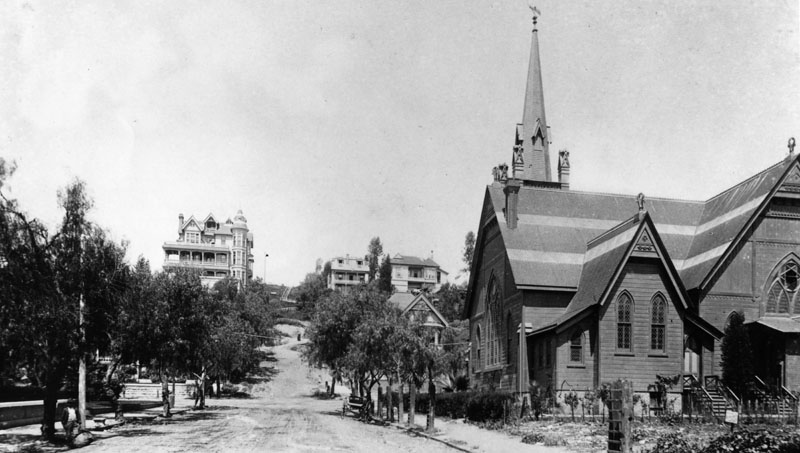 |
|
| (ca. 1885)^ - View looking west on 3rd Street toward Hill Street with Bunker Hill and Crocker Mansion in the background. On the right is the First Congregational Church on the northeast corner. It later became the Central Baptist Church and then the Unitarian Church. |
Historical Notes At the turn of the 20th Century, no building dominated Bunker Hill like the Crocker Mansion. Perched high at the corner of Third and Olive, the imposing 3-story Victorian structure overlooked the emerging metropolis for more than 22 years. |
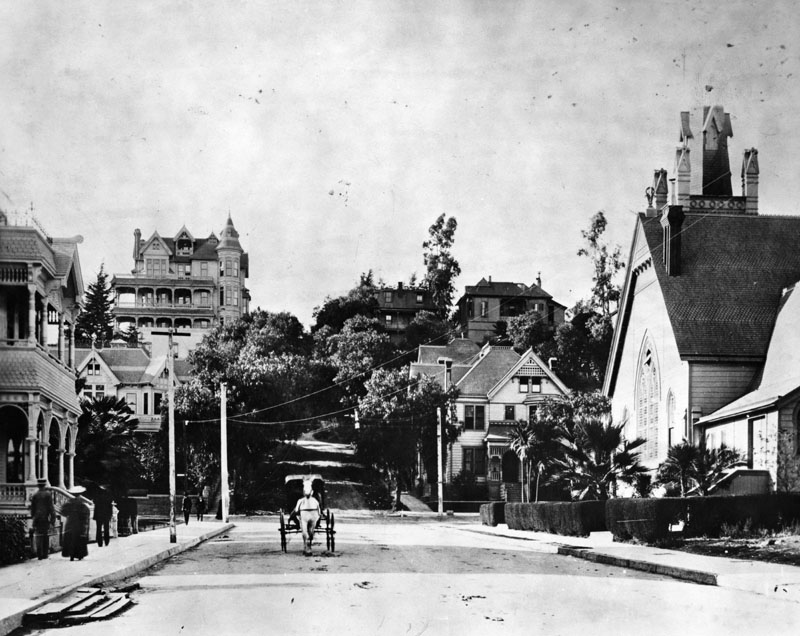 |
|
| (ca. 1885)* - View of Bunker Hill, looking west on 3rd St. toward Hill St. On the right is a closer look at the First Congregational Church, built in 1883. The Crocker Mansion, located at 3rd and Olive, was later called the Crocker Mansion Rooming House became the site of the Elks Club (later the Moose Lodge). |
Historical Notes By 1901, city and private engineers would come up with two different ways to traverse the steep hill...they built an 1080-foot long tunnel and a 33-percent grade funicular at the intersection seen above. |
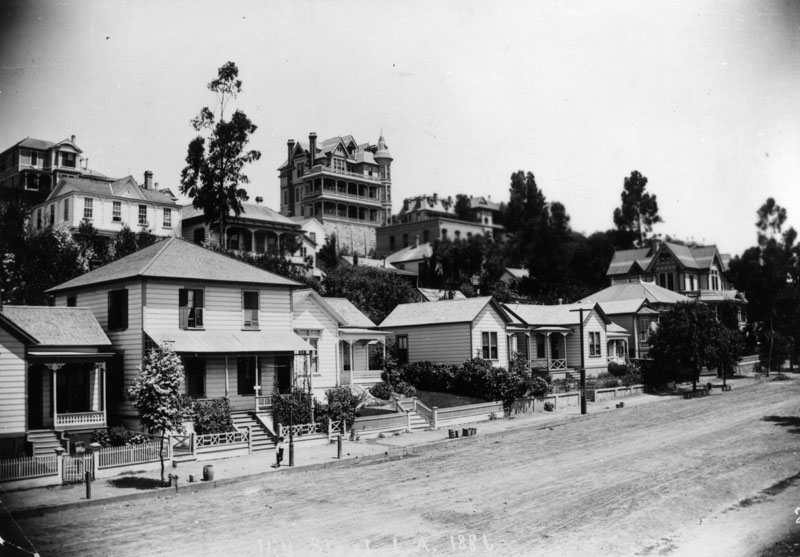 |
|
| (1886)^ - View of Bunker Hill from Hill and 3rd looking northwest. The Crocker Mansion, located at 3rd and Olive, can clearly be seen at the top of the hill. |
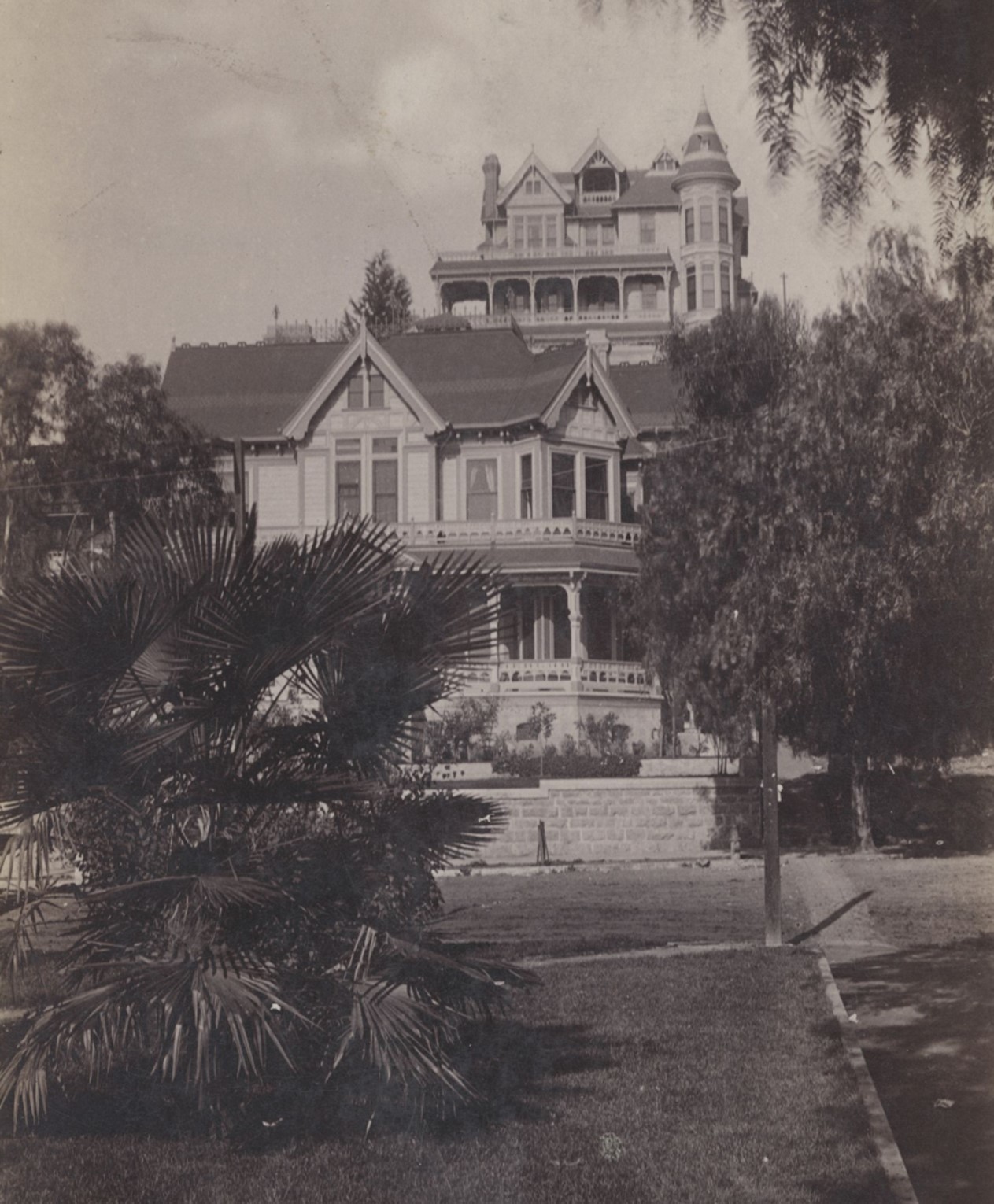 |
|
| (ca. 1990)* - The Crocker Mansion (upper center, 300 South Olive Street, later BPOE Temple), viewed from the corner of Third Street and Hill Street in Bunker Hill. The image showcases the Queen Anne style house on the upper part of the hill, featuring a multi-windowed corner tower, verandas, a balcony set into the roof, and an English chimney. In the foreground, there is a lawn with a Fan Palm tree and an unidentified Victorian house. Photo by C. C. Pierce. |
Historical Notes The Crocker Mansion, located at 300 South Olive Street, was one of the most notable residences in Bunker Hill. Built in 1886 by Margaret E. Crocker, the widow of California Supreme Court Justice Edwin Bryant Crocker, the mansion was an imposing three-story Victorian structure designed by architect John Hall. Margaret Crocker was a prominent social and civic leader, known for her philanthropy, including the donation of the family's art collection to the city of Sacramento. The mansion's history is marked by both grandeur and scandal. In 1887, it became the center of a high-profile kidnapping case when Margaret Crocker's granddaughter, Alma Ashe, was taken by her father, Robert Porter Ashe, amidst a contentious divorce. Despite such dramatic events, the mansion remained a symbol of elite society in Los Angeles. In 1891, the Crocker Mansion was converted into a boarding house, which was still considered more luxurious than the typical rooming houses on Bunker Hill at the time. However, the construction of the Third Street Tunnel in 1900 compromised the mansion's structural integrity, leading to its eventual demolition in 1908 to make way for new development. |
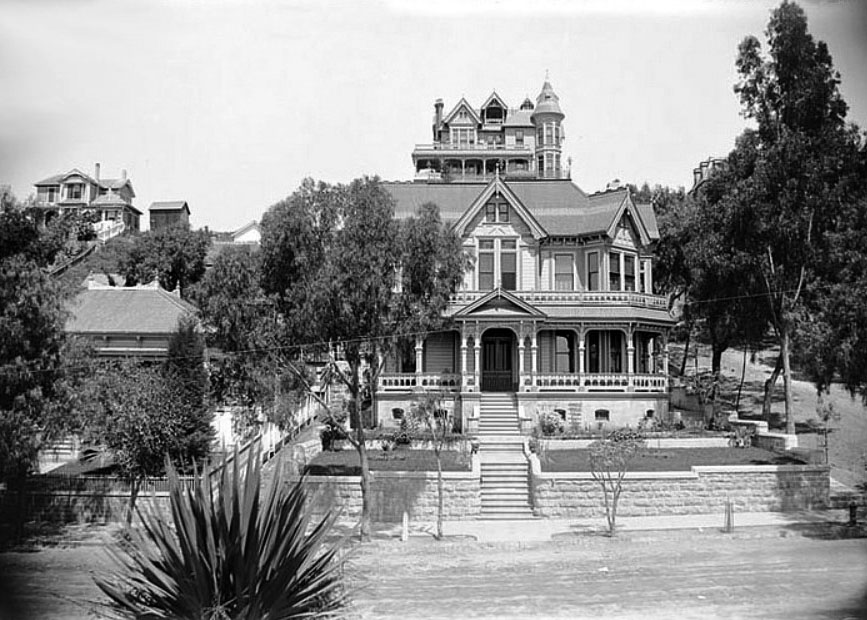 |
|
| (1895)* – View looking west at 3rd and Hill Streets with the Crocker Mansion seen at the top of Bunker Hill. The southwest corner of 3rd and Hill (lower-right) would become the lower station terminal of Angels Flight. |
* * * * * |
Angels Flight and the 3rd Street Tunnel
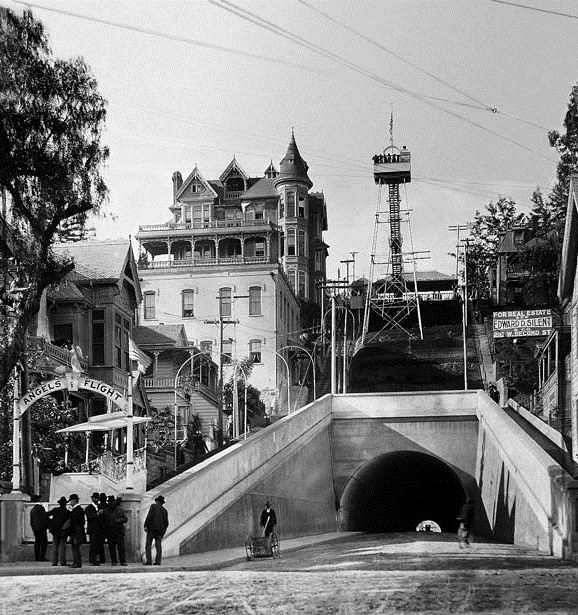 |
|
| (1901)^*# - Photo of Angels Flight at the grand opening of the railway, December 31st, 1901. An observation tower was also constructed on top of the hill adjacent to the Crocker Mansion. Third Street Tunnel was also opened in 1901. |
Historical Notes Built in 1901 with financing from Colonel J.W. Eddy, as the Los Angeles Incline Railway, Angels Flight began at the west corner of Hill Street at Third and ran for two blocks uphill (northwestward) to its Olive Street terminus.^* Click HERE to see more Early Views of Angels Flight. On July 3, 1893, residents and taxpayers presented a petition to the Los Angeles City Council asking that a tunnel be created to connect those who lived in the Crown Hill neighborhood with the business district located on this side of Bunker Hill. Their plans called for a tunnel 1080 feet long, with a twenty-six foot roadway and eight foot sidewalks. Nothing happened for five years. But work finally started and by March of 1901 the tunnel was opened to the public. It was unpaved and unlit. Gutters weren’t installed until 1902. Click HERE to see more Early Views of the Third Street Tunnel. |
Before and After
 |
||
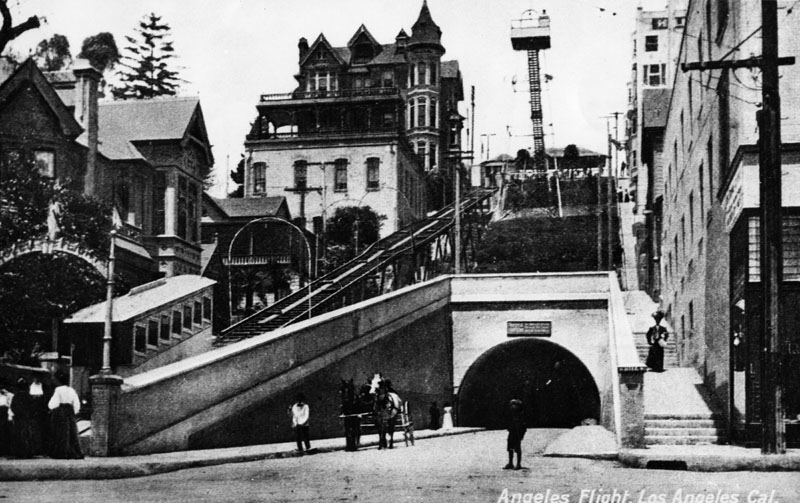 |
||
| (1885 vs 1903) - View looking west on 3rd Street near Hill Street. Photo comparison by Jack Feldman. |
Then and Now
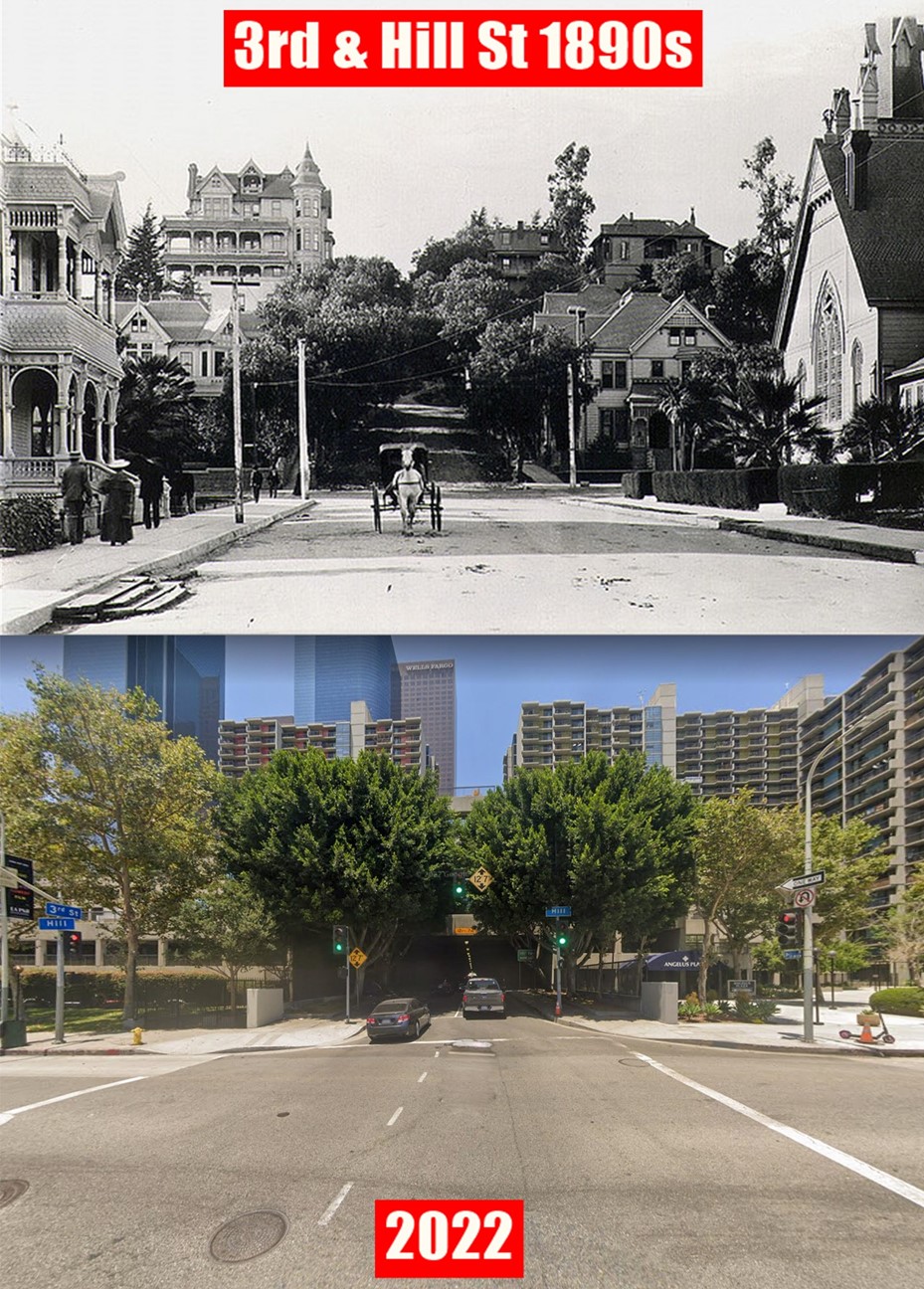 |
|
| (Then and Now)* – View looking west at 3rd Street at Hill Street. |
* * * * * |
Temple Street (w/o Bunker Hill)
.jpg) |
|
| (1876)^ - View of an unpaved Temple Street looking west from Bunker Hill, with various houses visible there and on the hill in the background. Court Circle, as laid out, is at the left. Temple Street curves, following the contour of the land. |
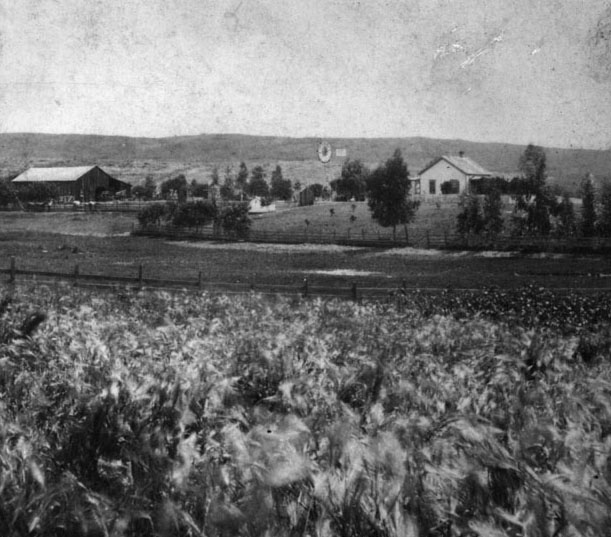 |
|
| (1870s)^ - View of a field of wheat growing on a ranch in the vicinity of Temple Street and north Vermont Avenue. A house, farm buildings and a windmill are seen. |
* * * * * |
Victor Heights
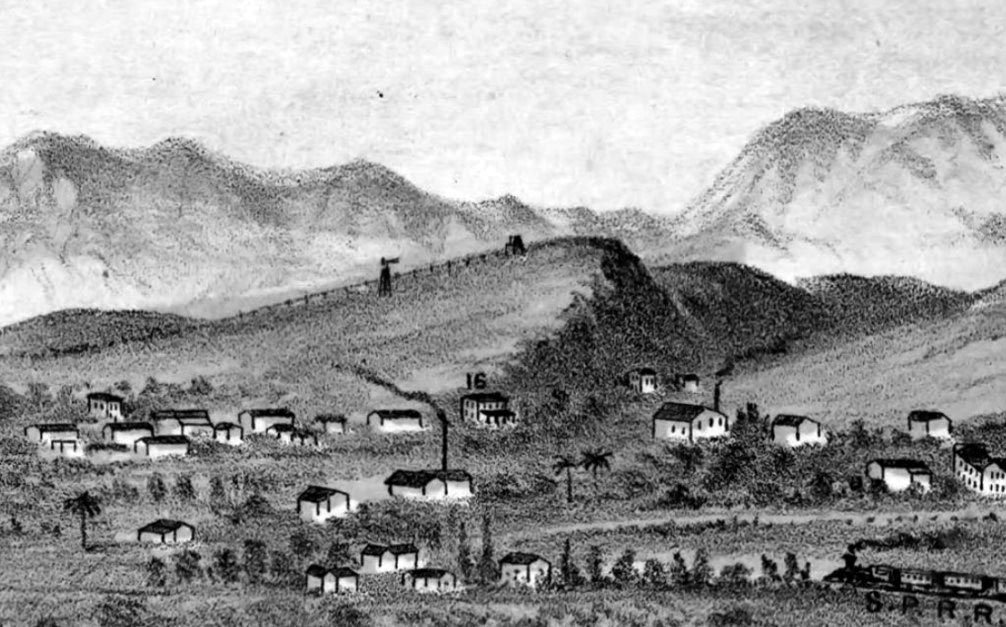 |
|
| (1877)^^ - Detail of E.S. Glover’s View of Los Angeles from the East showing what was to become Victor Heights. |
Historical Notes Canadian brothers Prudent and Victor Beaudry first increased their fortunes (having been born wealthy) in Northern California with a variety of business pursuits before moving to Los Angeles where Prudent entered politics (from 1874 to 1876 he served as Los Angeles’s thirteenth mayor). Victor mined, developed water works, and worked in real estate before moving to Los Angeles in 1855. He and his mining partner (and fellow Quebecois) Damien Marchessault built an ice house in Los Angeles in 1859 — the year Marchessault became mayor — and sold ice to saloon keepers and others. In the 1860s, the Beaudrys bought land in and around the French Town section — an historic neighborhood centered around Alameda and Aliso streets whose existence today is mainly seen in street names like Bauchet, Ducommun, and Vignes. Beaudry went on to increase his fortunes in silver mines and simultaneously earned the nickname the “water king” as he developed water transportation systems for both mines and in town. After the mines began to prove less profitable, Victor moved to Montreal in 1876 where he married Angelica Le Blanc. The couple and their family moved back to Los Angeles in 1881 where he remained until 1886. In Los Angeles, the Beaudry brothers built a water reservoir in the Elysian Hills and used it to hydrate their properties there including Bunker Hill (subdivided in 1876), and what would become Angeleno Heights and Victor Heights. To make their properties more appealing to potential homebuyers, the Beaudrys created two parks, Bellevue Terrace and Beaudry Park. Beaudry Park was a 7.4 acre oval property designed by landscape architect/gardener Francis Tamiet and included many Mexican limes, gums, cypresses, oranges, and Monterey pines.* Ultimately, the Beaudrys placed their two gardens on the market soon after they liquidated the surrounding real estate tracts. In 1881 the state purchased Bellevue Terrace for the site of the California Branch State Normal School, a teaching college that eventually became UCLA. When the Los Angeles Central Library replaced the college in 1926, construction crews graded the hill out of existence. Beaudry's Park, meanwhile, was purchased in 1883 by the Sisters of Charity. On that site (now occupied by The Elysian apartment building and Holy Hill Community Church) the sisters placed their new infirmary, repurposing Beaudry's fruit trees and cypresses into a soothing backdrop for their patients. |
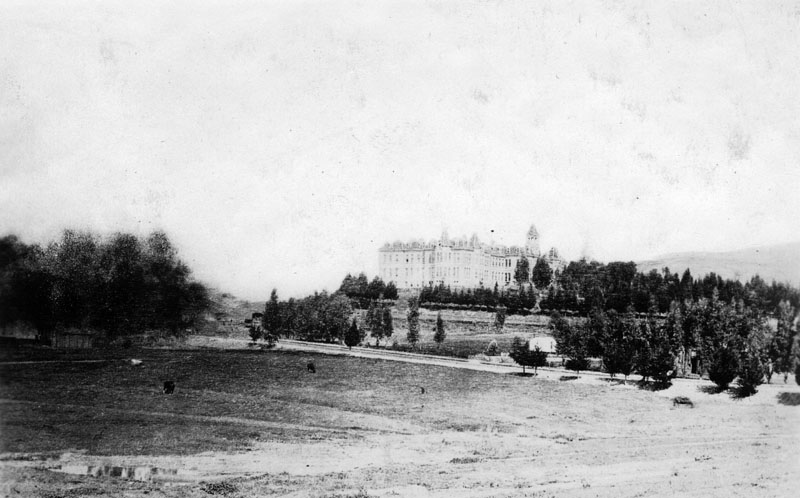 |
|
| (ca. 1887)* - View looking northwest showing St. Vincent's Infirmary (aka Sisters Hospital) located near Sunset Blvd and Beaudry Ave as seen from across a sparse field. Several trees can be seen to the right of the grand hospital, which boasts of numerous windows, dormers, an irregular roof, a cupola or tower, and several chimneys. |
Historical Notes In 1883 the Daughters of Charity of St. Vincent de Paul purchased six and a half acres of land at Beaudry Park at a cost of $10,000, and a new hospital building was erected a year later near Beaudry and Sunset, on a hillside overlooking Sonora Town. By 1898, Los Angeles Infirmary had come to be known as Sisters Hospital, but both names were used interchangeably in reference to the same hospital. |
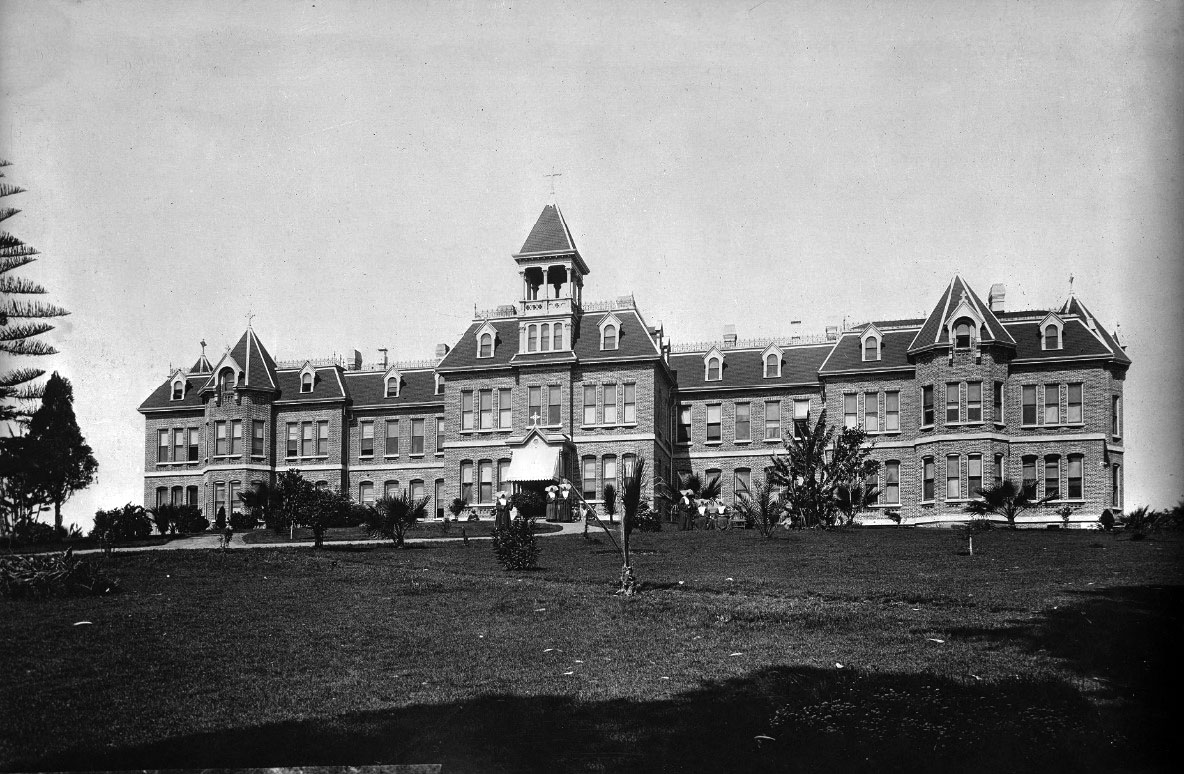 |
|
| (ca. 1887)* - Photograph of St. Vincent's Infirmary (aka Sisters Hospital) as seen from across the lawn. Several trees, most of them palms, are planted in front of the grand hospital that shows numerous windows, dormers, an irregular roof, a cupola or tower, and several chimneys. Six nuns can be seen walking and/or sitting around the front lawn. |
Historical Notes The Daughters of Charity of St. Vincent de Paul established the first hospital in Los Angeles - the Los Angeles Infirmary, in 1856. It was located in the Sonora Town adobe owned by then-Mayor of Los Angeles, Don Cristo´bal Aguilar. Four years later, in 1860, the hospital relocated to 1416 Naud Street, between Ann (named for Sister Ann) and Sotillo Street (though other data indicates the location was 1414 Naud Street, between N. Main and San Fernando Road). In 1869, Daughters incorporated the Los Angeles Infirmary under their own ownership, the first women in the region to do so. In 1883 they purchased six and a half acres of land at Beaudry Park at a cost of $10,000, and a new hospital building was erected a year later at Beaudry and Sunset, on a hillside overlooking Sonora Town. By 1898, Los Angeles Infirmary had come to be known as Sisters Hospital, but both names were used interchangeably in reference to the same hospital; in 1918, the name was officially changed to St. Vincent's Hospital. In 1924 a new building was erected on 3rd and Alvarado, which was built by John C. Austin and Frederick M. Ashley. For 47 years, the hospital had such a steady growth that they were forced to expand yet again, and groundbreaking for a newer, larger building took place in 1971 - this time, located at 2131 W. 3rd Street. With a "new" hospital came a new name, and in 1974, it changed again, this time becoming St. Vincent Medical Center. |
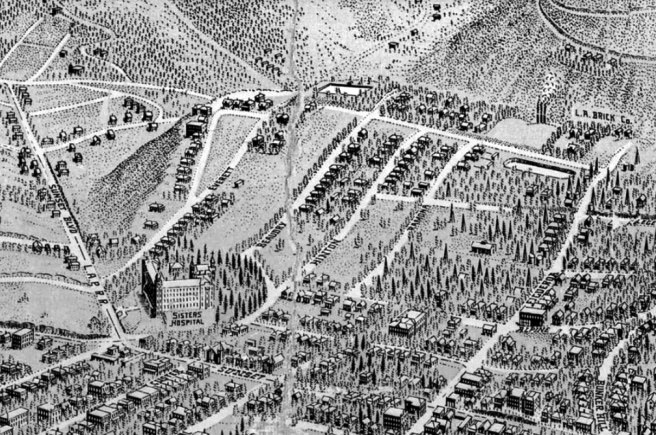 |
|
| (1909)* - Detail of Worthington Gates’s birdseye map of Los Angeles, showing Victor Heights. The Sisters Hospital is seen at lower center-left at Sunset and Beaudry. |
Historical Notes Beaudry Park was located near the intersection of Beaudry Ave. and Sunset Blvd. When acquired for a hospital by the Daughters of Charity of St. Vincent de Paul, the park was an oval-shaped parcel of open land. Sisters Hospital (originally St. Vincent's Infirmary) was built in 1884 on six and half acres of what was then known as Beuadry Park (developed by brothers Prudent and Victor Beaudry in 1876). |
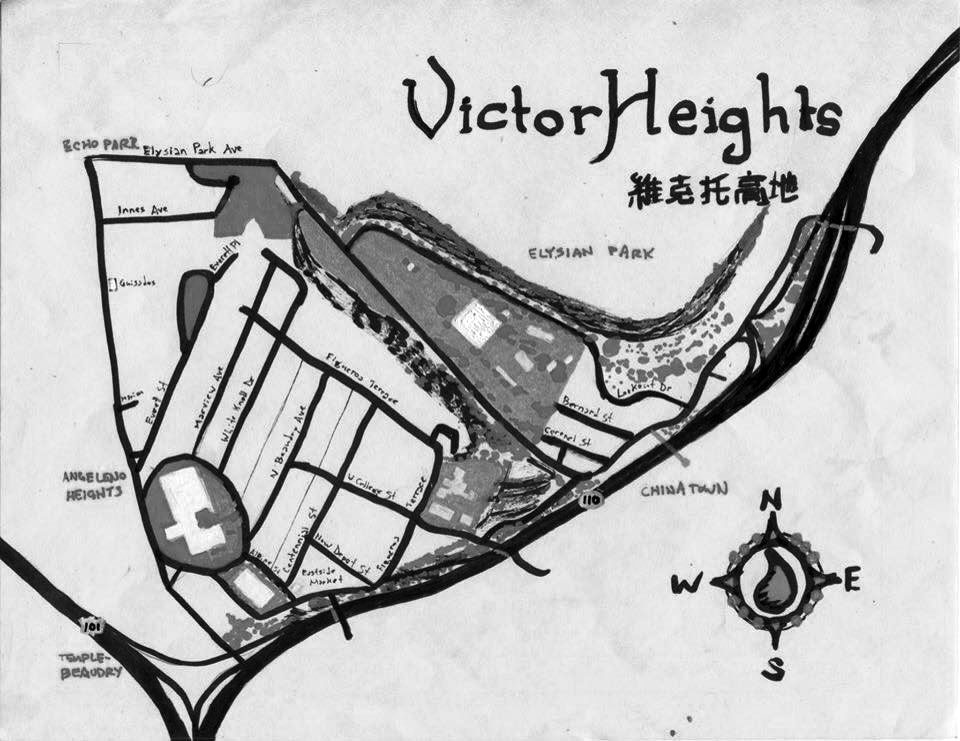 |
|
| (2010s)* - Pendersleigh & Sons Cartography‘s Map of Victor Heights. Photo Courtesy of Eric Brightwell |
Historical Notes In Victor Heights the most visible reminder of the neighborhood’s once strongly-Italian character is Eastside Market and Deli. It was opened in the 1920s by Puglia-born Domenic Pontrelli across the river in the Eastside (Lincoln Heights) before moving to its current location (1013 Alpine Street) in 1929. Back then Alpine Street was home to three other Italian Markets. It was from within Eastside Deli that Pontrelli’s son-in-law launched Pontrelli & Laricchia Sausage Company which moved out of the neighborhood in 1973. Shortly after, a former clean-up boy for the sausage company, Johnny Angiuli, took over the market with his brother, a former delivery driver, and they reorganized the establishment around a new deli counter, which is its focus today Also located within the Victor Heights is the Art Deco-style Navy and Marine Corps Reserve Center Building, designed to be the largest enclosed structure without walls in the world by architects Robert Clements and Associates. It was constructed by the WPA between 1938 and 1941 as one of the country’s largest naval armories, its secluded location chosen to shield it in the event of an air attack. During World War II, more than 20,000 sailors passed through the training center. In 1980, an electrical fire heavily damaged the interior, which reopened in 1986 after a renovation. It was designated California State Historic Landmark #972 in 1989. The military left in 1995 and it’s now home to the LAFD’s Frank Hotchkin Memorial Training Center, named after the firefighter who died fighting the 1980 conflagration. |
* * * * * |
City Garden
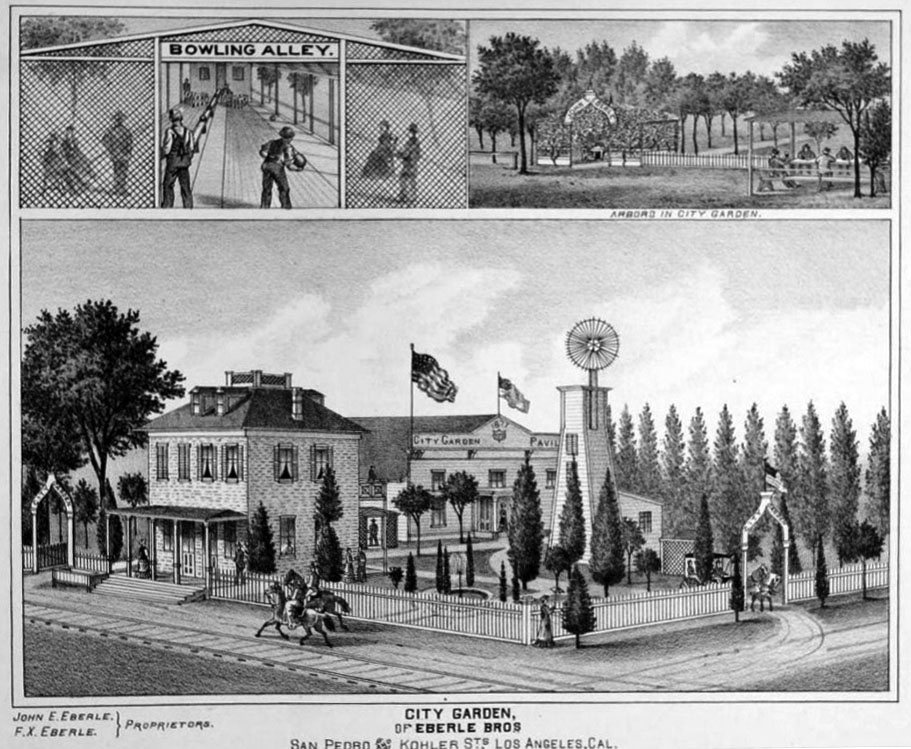 |
|
| (1880s)* - Photo of an illustration showing the City Garden of Eberle Bros. located at San Pedro St. & Kohler (later 8th Street). The scene in the upper left corner shows an outdoor bowling alley. Source: The History of Los Angeles County - 1880 |
Historical Notes The 1888 Sanborn Map shows: The tracks in front of the property on San Pedro Street as Southern Pacific R.R. (Wilmington Branch); the large bulding in the rear as the 'Dancing Pavilion'; and the garden on the right as the 'Beer Garden'. |
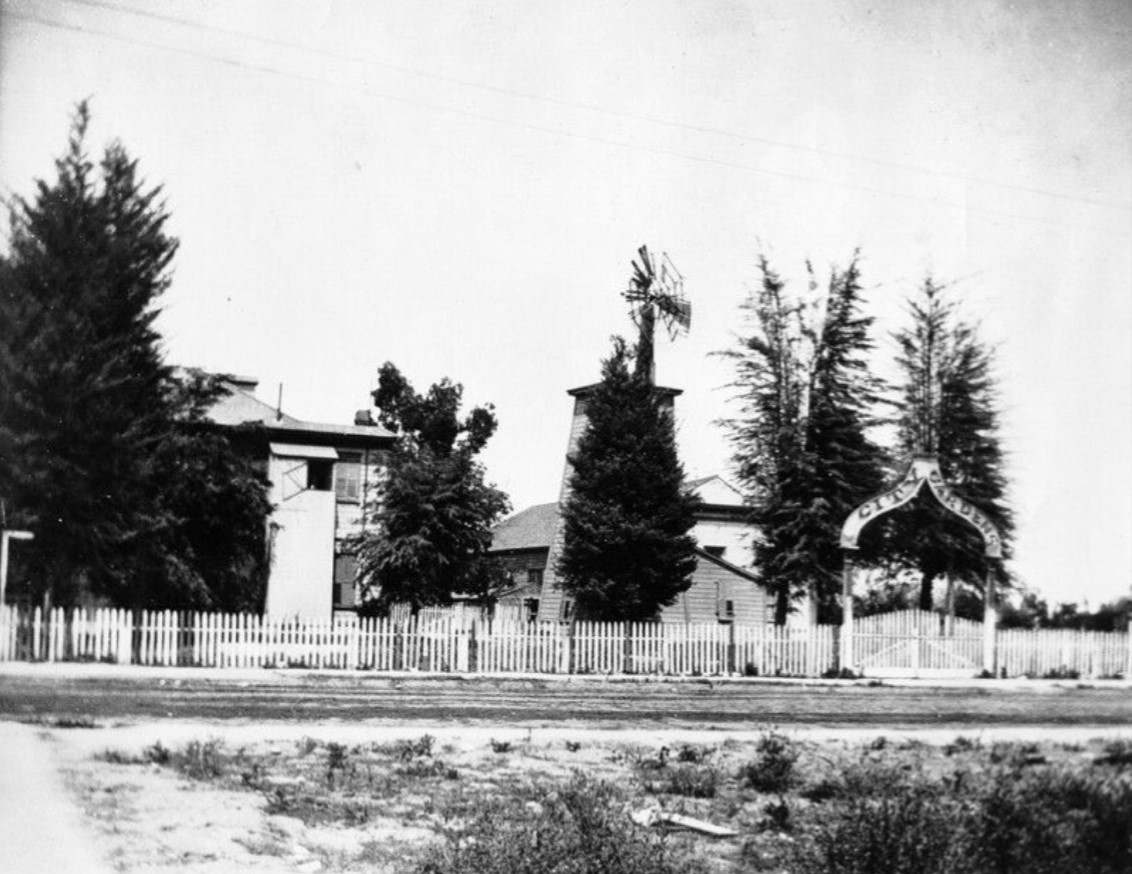 |
|
| (1896)* - View showing the City Gardens with windmill and surrounded by a white picket fence, located on the northeast corner of San Pedro and 8th streets. |
Historical Notes The garden covered about six acres and was notable for being the first stop the Santa Monica Railroad made out of the city. |
jpg.jpg) |
|
| (1880s)* – Detail view showing City Garden of Eberle Bros. located on the corner of San Pedro Street and Kohler (now 8th Street). Each arched entryway says City Garden. The large building in the rear has a sign reading: City Garden Pavilion - 1877. |
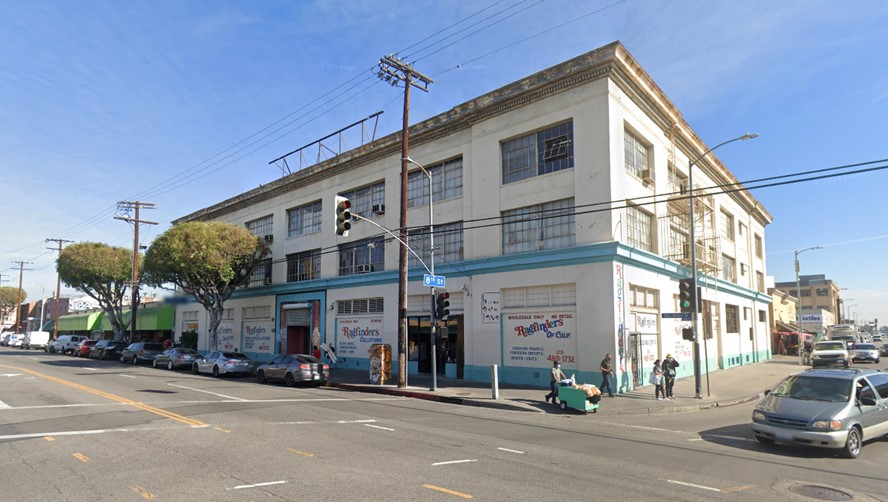 |
|
| (2021)* - Contemporary view of the northeast corner of San Pedro and 8th Street where the City Garden once was located. |
Historical Notes Although the building seen here sells garments, this intersection is part of the Los Angeles Flower District, an area known for its concentration of flower markets and floral businesses. It is a hub for both wholesale and retail flower purchases. Key points about the Los Angeles Flower District: Location: The main area is centered around Wall Street, between 7th and 8th streets in downtown Los Angeles. Size and significance: It is considered the largest wholesale flower market in the United States. Composition: The district spans approximately six blocks and includes several notable flower markets: The Original Los Angeles Flower Market (754 & 755 Wall St) Southern California Flower Market (742 Maple Ave) California Flower Mall (825 S. San Pedro St) |
Then and Now
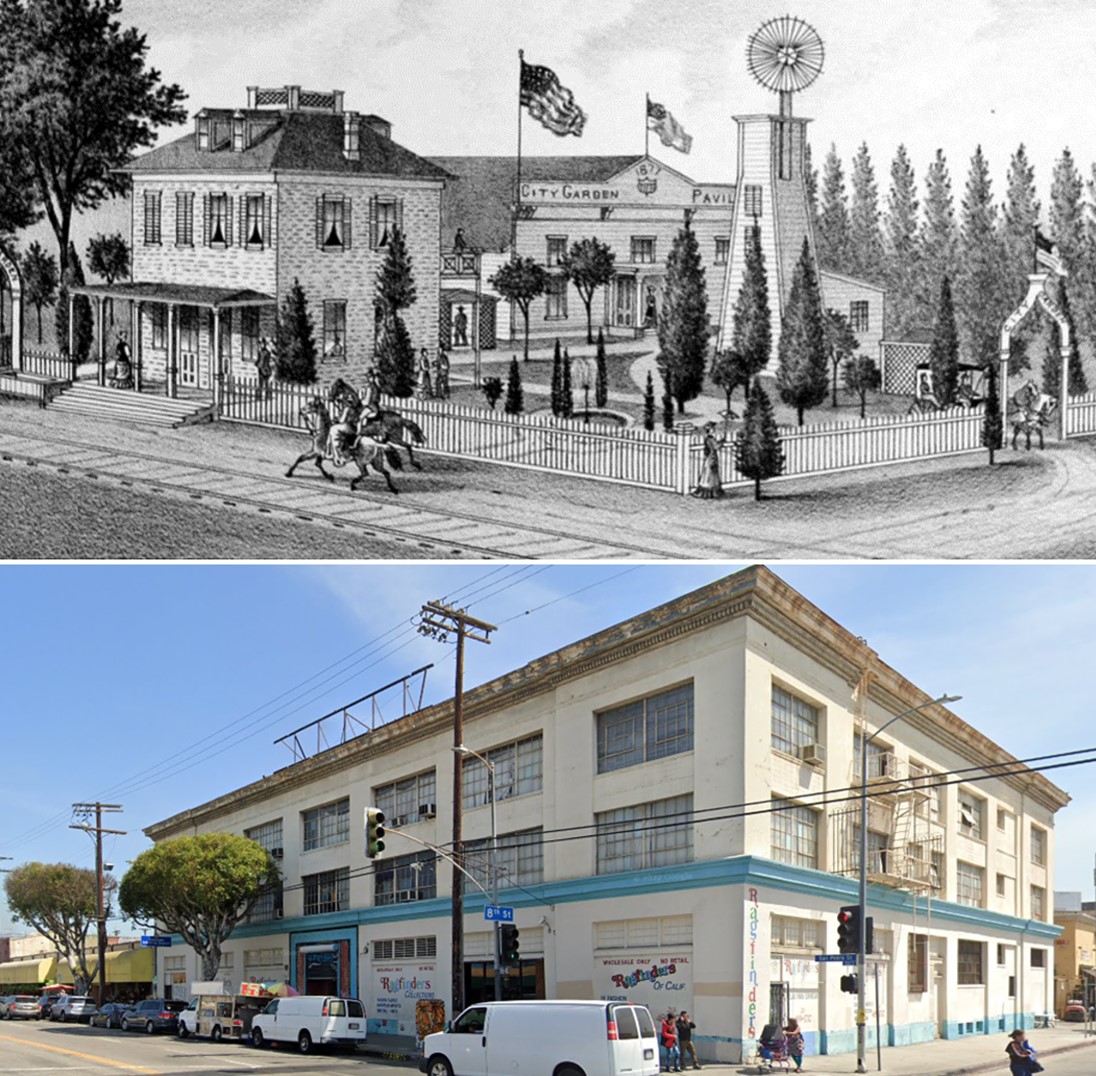 |
|
| (1880s vs 2021)* - Northeast corner of San Pedro and 8th Street, where the City Garden once existed, is now part of the Los Angeles Flower District. The City Garden covered about six acres and included a dancing pavilion, an outdoor beer garden, and one of Los Angeles' first bowling alleys. It was also notable for being the first stop of the Southern Pacific Railway line to Santa Monica out of the city. Photo comparison by Jack Feldman. |
* * * * * |
The Longstreet Mansion and the Longstreet Palms
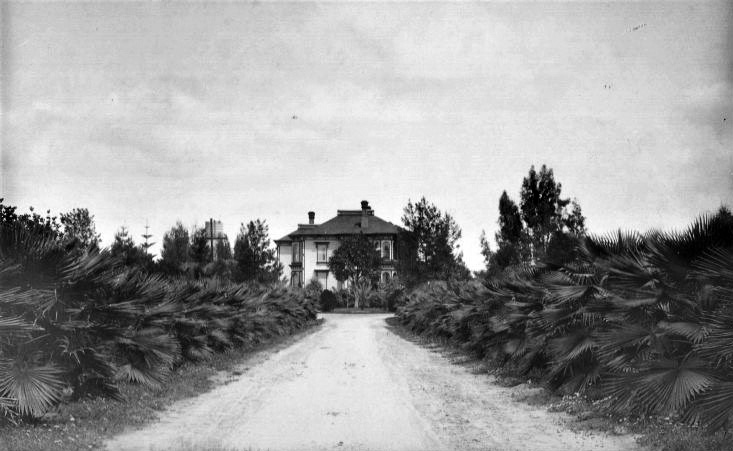 |
|
| (1870s)* - View looking north showing the Longstreet Mansion at the end of a palm-tree lined drive (later known as Palm Drive) . Amazingly the Longstreet Palms seen above are still alive today. Along with the Arcade Depot Palm, they are considered to be the oldest trees in Los Angeles. |
Historical Notes Charles A. Longstreet arrived in Los Angeles in late 1873, likely for his health. Soon after he reached the city he bought a 35 acre tract bordered by Figueroa Street, Grand Avenue, Adams Street and 23rd Street. He built a large Italianate mansion on a graded rise at the north end of a straight drive. Young fan palms were planted along both sides of the driveway. These palms grew into the line of trees seen in this early view, and many of them still survive today. |
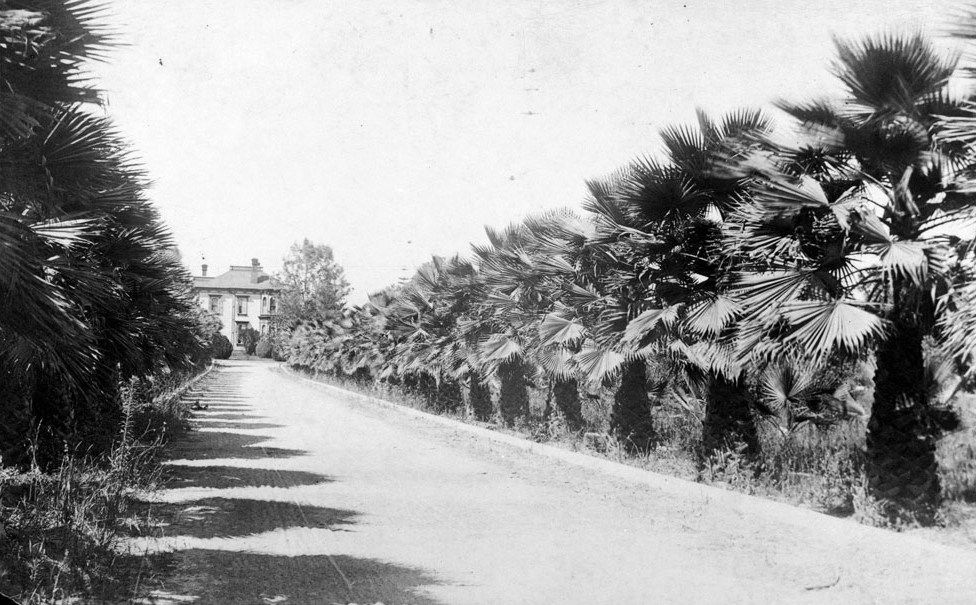 |
|
| (ca. 1880s)* - View of Palm Drive north from Adams Boulevard, showing the residence of Charles A. Longstreet (not to be confused with Confederate General James Longstreet, a distant relative of Charles). |
Historical Notes By the 1880s the Longstreet Place was known as one of the most attractive estates in Southern California. Newspapers described the graded slope, the palms, the trimmed hedges, and the flower beds as a garden of delight. At this time it was the closest thing Los Angeles had to a southern style avenue leading to a country house. The house belonged to Charles A. Longstreet, a distant relative of Confederate General James Longstreet, but the two men should not be confused with one another. |
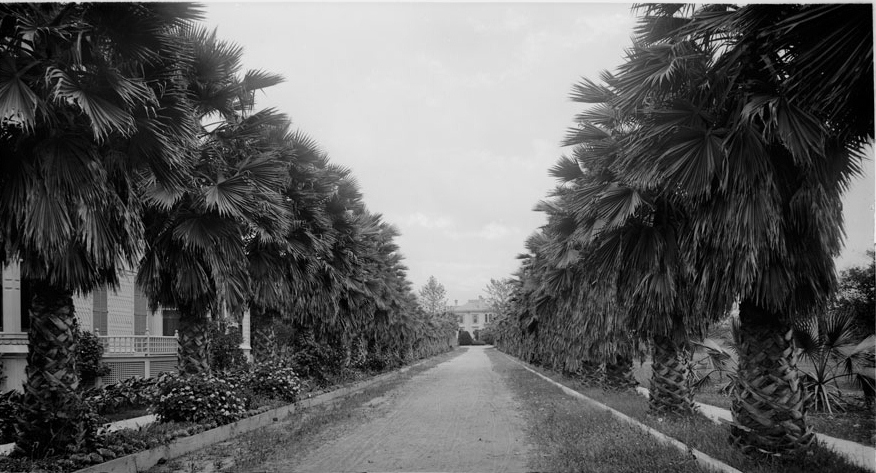 |
|
| (ca. 1886)* - Path through Charles Longstreet's homestead on Palm Drive north of Adams Boulevard. |
Historical Notes One of the hottest areas of the city for development was to the south and west of downtown, an area that first became known when Agricultural Park (now Exposition Park) was established there by 1870. A decade later, the Methodist-affiliated University of Southern California opened its doors. However, with the completion of the Santa Fe Transcontinental Railroad Line directly to Los Angeles, the floodgates were opened for the great Boom of the Eighties that rose up in 1886 and peaked the following two years. Large estates and mansions lined Figueroa Avenue, Adams Boulevard and other nearby streets and some of these had very impressive landscaping.^ Charles Longstreet had died in 1877 and his widow and 3 sons lived in the mansion until 1884, when the land was subdivided. |
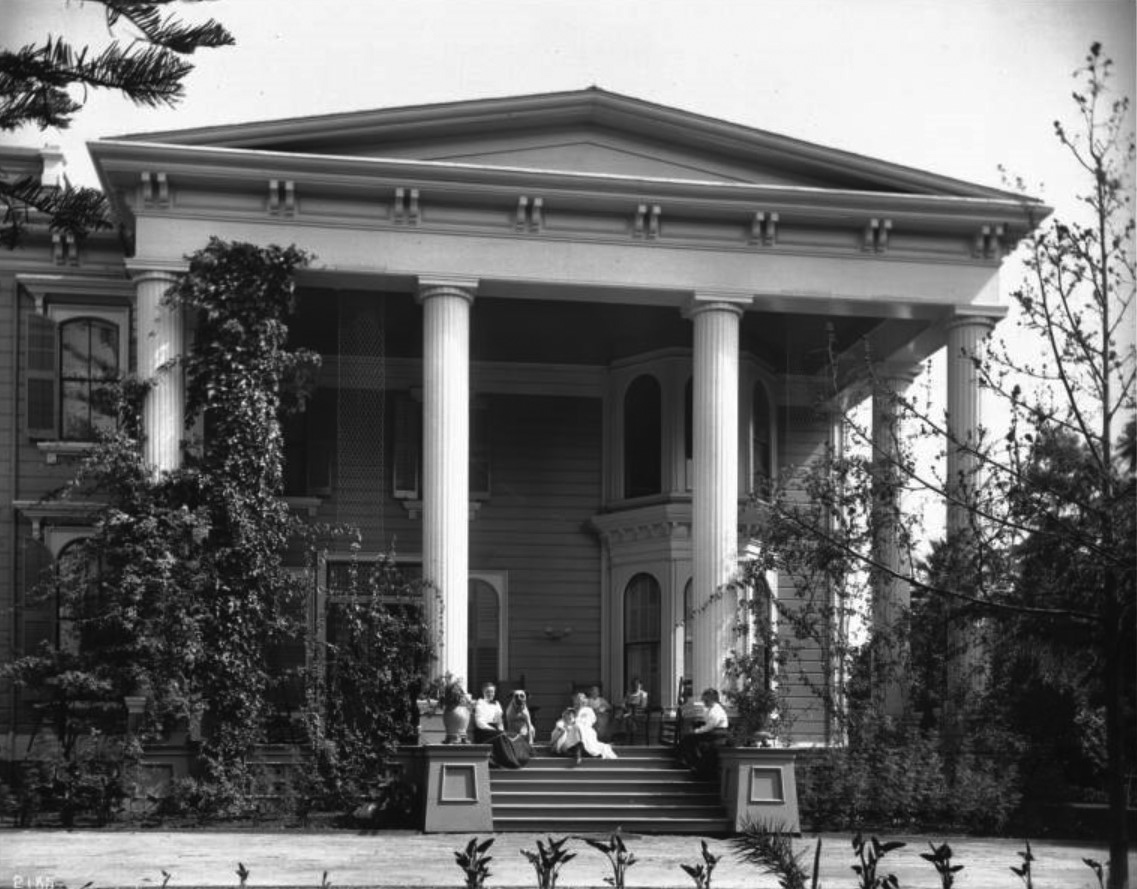 |
|
| (ca. 1895)* - View showing women sitting on the porch of the north side of the Longstreet Mansion. The home, whose column at left is overgrown with vines, was built circa 1874. The area later became Singleton Court and then Orthopedic Hospital. |
Historical Notes By the mid-1890s the Longstreet mansion was about 20 years old. Parts of the original 35 acre tract had already been sold, and new houses stood along Adams Street and the palm lined drive. The property later passed through several owners. Juana Neal, a well known businesswoman, lived in the old mansion for a time and helped sell lots from what had become known as the Longstreet Tract. The house sat on land that would later be called Singleton Court and eventually became the site of the Los Angeles Orthopaedic Hospital. |
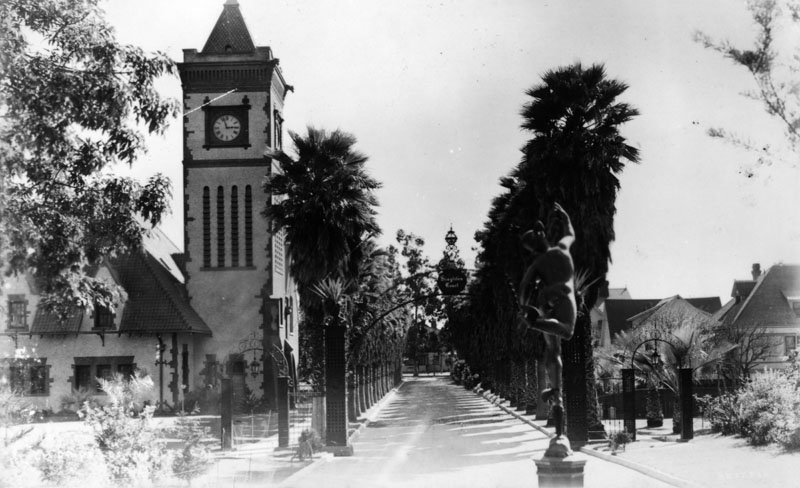 |
|
| (ca. 1910)^ - View looking south on Palm Drive toward Adams Boulevard through the Singleton Court entrance gate. |
Historical Notes Around 1899 the old Longstreet house and the remaining grounds were purchased by mining man John Singleton. He added a clock tower, made improvements to the buildings, and renamed the property Singleton Court. The main entrance was on Adams Street, marked by iron gates. This view looks south from within Singleton Court toward Adams Street. The estate then covered about 3.5 acres. Sometime before 1918 the main house was destroyed by fire, leaving only the brick stable building and the clock tower. The clock tower was later moved to the Brockman estate in Glendale. |
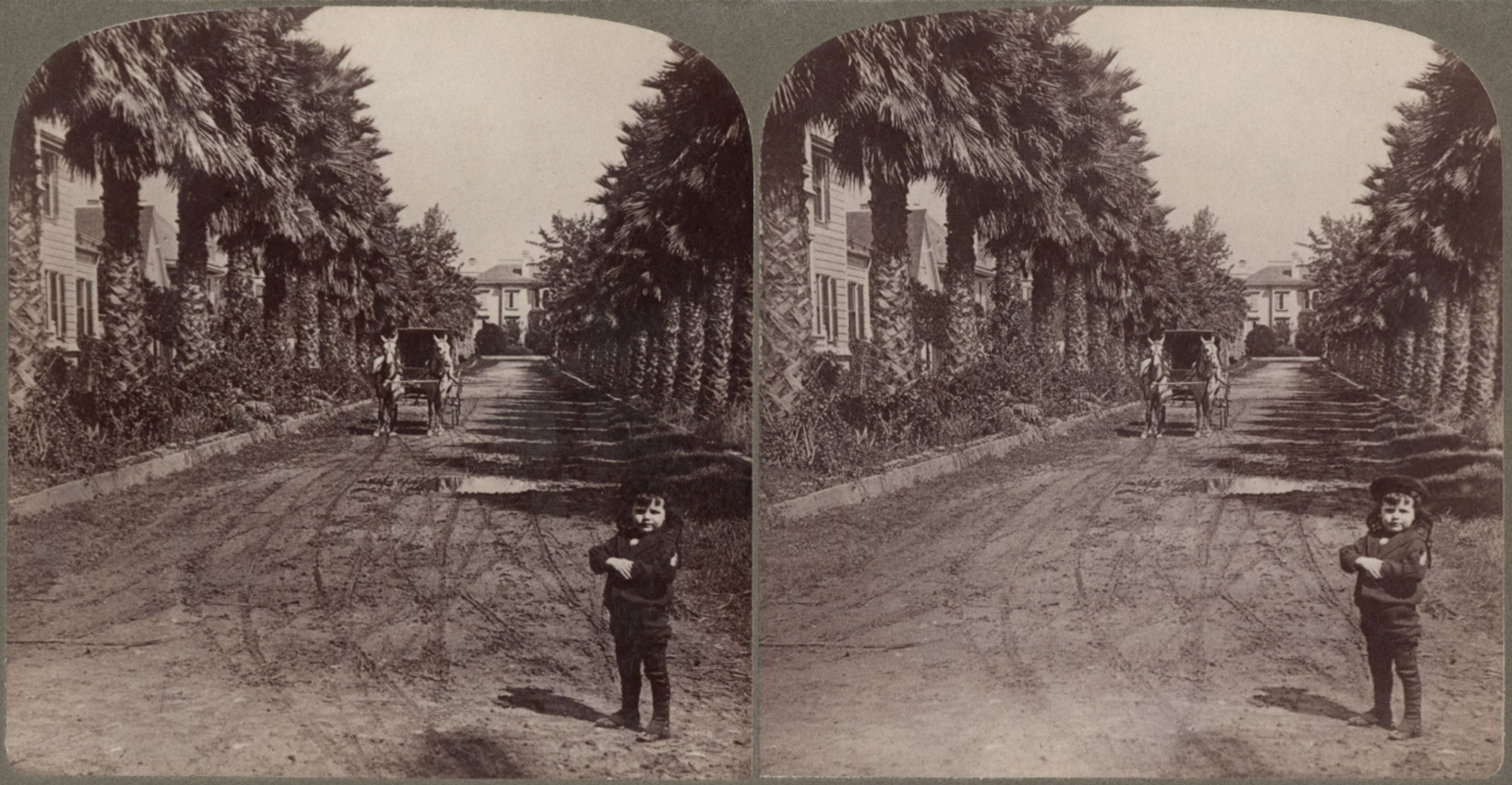 |
|
| (1909)* – Stereoscopic view looking north on Palm Drive from just above Adams Boulevard. A young child stands in the foreground while a horse-drawn carriage waits in the distance. At the end of the palm-lined street is the mansion built for Charles Longstreet, later known as the Singleton Mansion. |
Historical Notes This photo shows Palm Drive more than 30 years after Charles Longstreet planted the young fan palms along his driveway. By 1909 many of the original palms had grown into tall, mature trees. New houses and sidewalks lined the street, showing how the earlier private drive had become a public city street. A child stands in the foreground and a carriage drawn by a pair of horses waits farther up the drive. At the end of the palms stands the mansion first built for Charles A. Longstreet. By this date it was better known as John Singleton’s residence at Singleton Court. |
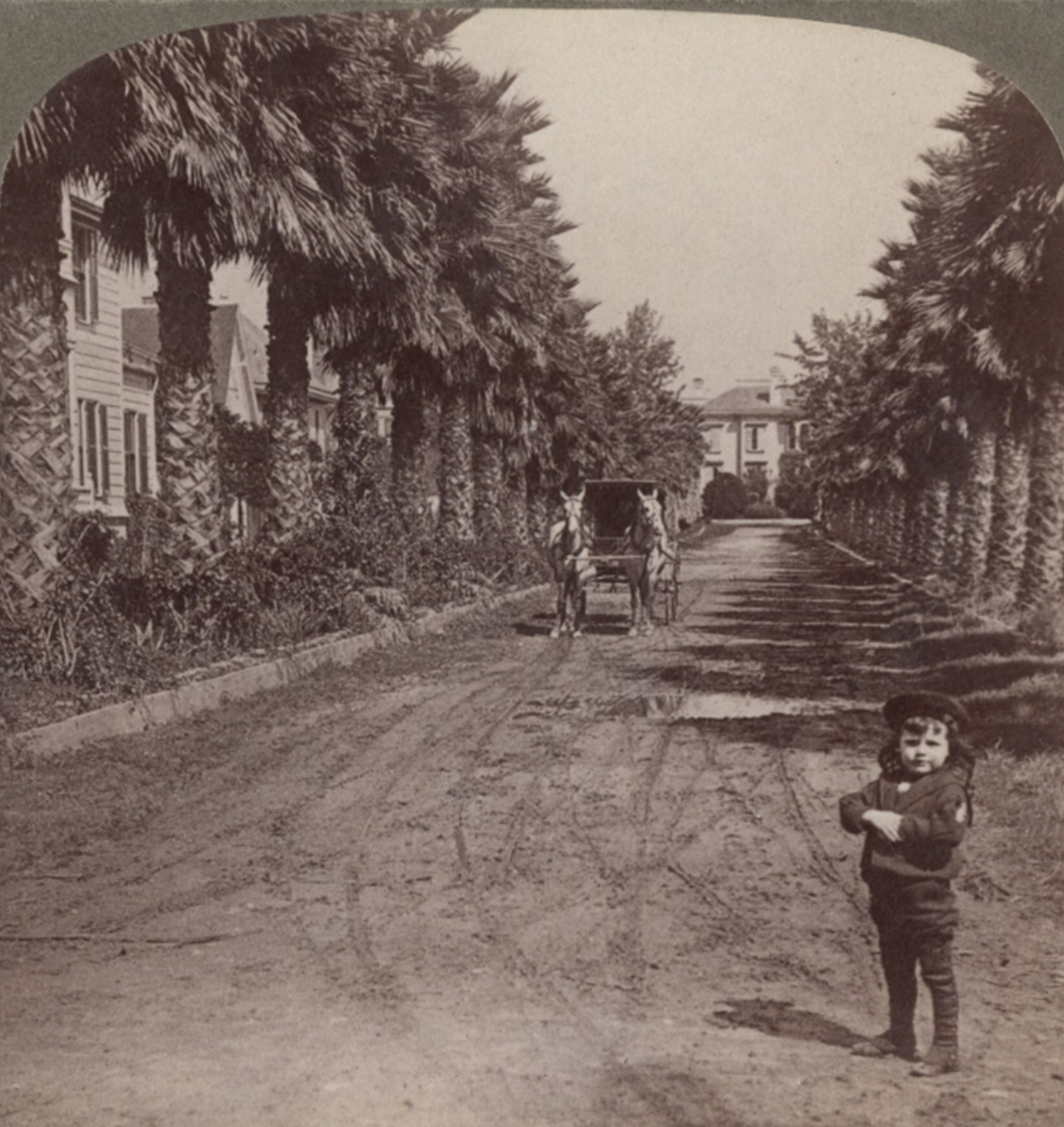 |
|
| (1909)* – Right panel of the stereoscopic view looking north on Palm Drive from just above Adams Boulevard. The tall line of Longstreet’s original fan palms frames the approach to the mansion first built for Charles A. Longstreet, later known as the Singleton Mansion. |
Historical Notes This right panel forms the second half of the 1909 stereoscopic pair. Together, the two images show how Palm Drive looked more than 30 years after Charles Longstreet planted the young fan palms along his private driveway. By this time Palm Drive had become a public street lined with new homes and sidewalks, but the tall palms still gave it the appearance of a long formal approach to the old estate. At the far north end stood the mansion first built for Charles A. Longstreet and later owned by John Singleton as part of his property called Singleton Court. |
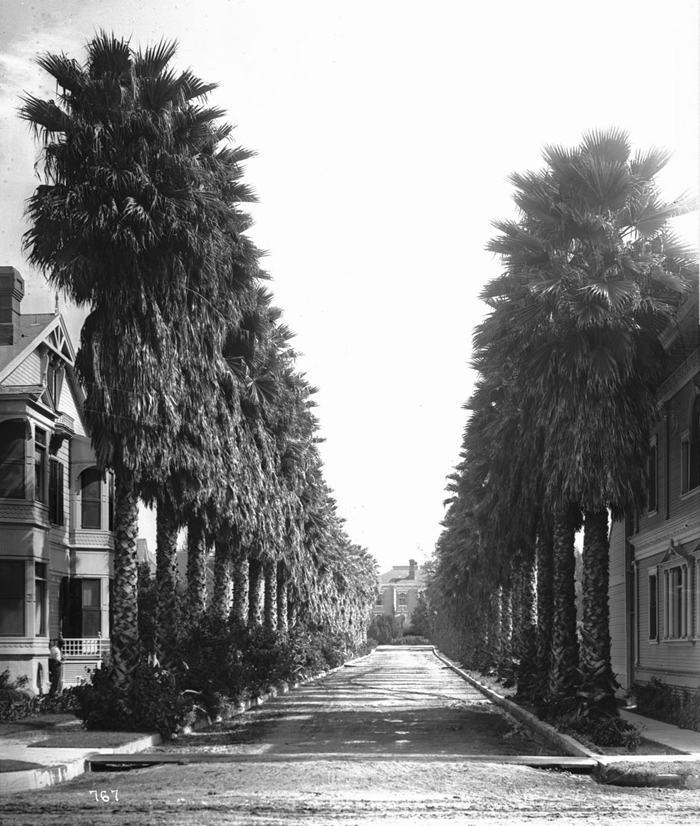 |
|
| (ca. 1920)* - Palm Drive after the turn of the century. View looking north from Adams Boulevard. |
Historical Notes By the early 1920s the palms were already known as the tallest in the city, and many believed they were also the oldest. The palm lined streets of Beverly Hills were only then being planted, while the Longstreet palms were already about 40 to 50 years old. This view looks north from Adams Street. Even as the surrounding blocks filled with houses and the old estate buildings changed hands, the palms remained the most visible reminder of the original Longstreet Place. |
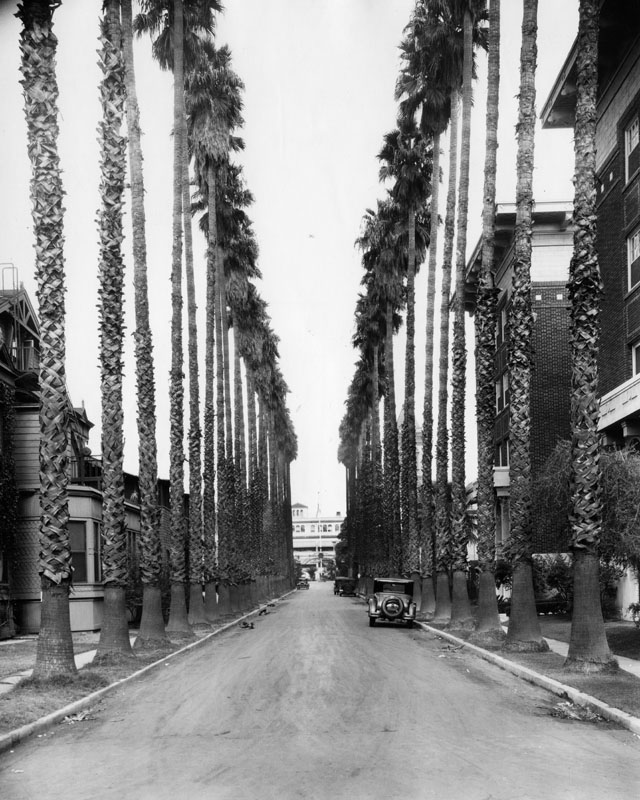 |
|
| (ca. 1930)^ - A view of Palm Drive north from Adams Boulevard, with two-story houses on either side and cars parked on the street. The building at the end of the street is the Los Angeles Orthopaedic Hospital located on the site of Charles Longstreet's former home. |
Historical Notes By 1930 the mansion was gone, and the Los Angeles Orthopaedic Hospital now stood at the north end of Palm Drive on the former Longstreet property. The hospital was founded in 1911 by Dr Charles LeRoy Lowman and expanded steadily after the first building opened in 1922. Many of the original palms still stood and became part of the hospital grounds. Together with the old Arcade Depot Palm downtown, they are often considered the oldest trees in Los Angeles. |
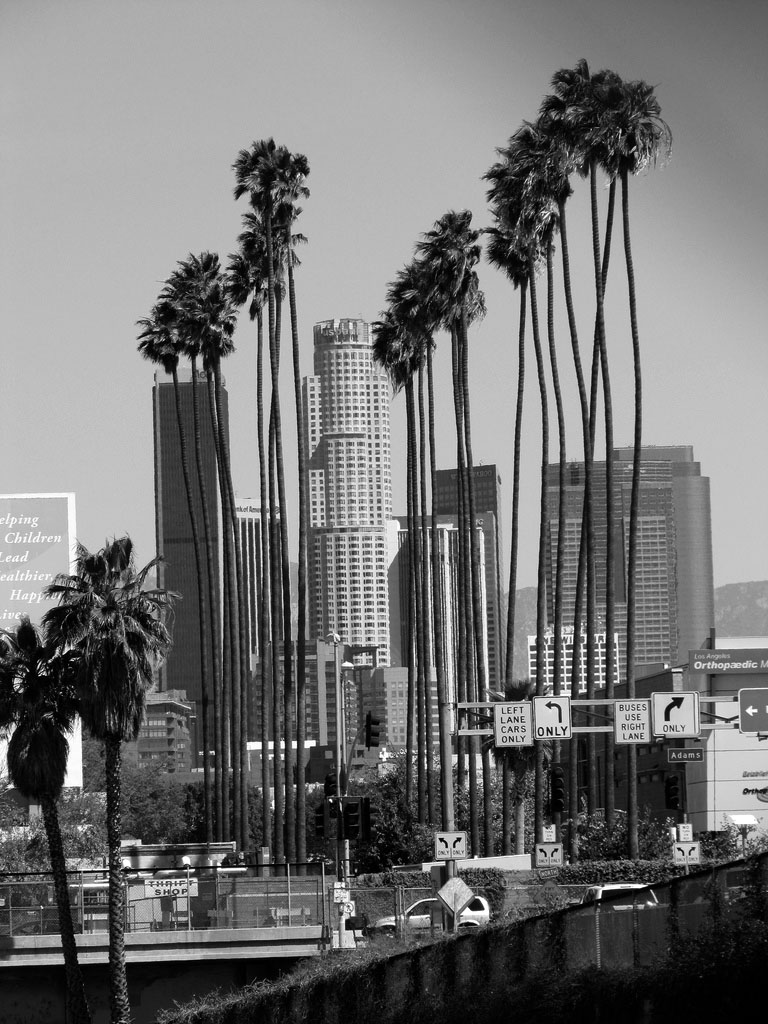 |
|
| (2010)* - The oldest Mexican Fan Palms (Washingtonia robusta) in Los Angeles. Located on what was Palm Avenue at Adams Boulevard (now on grounds of the Los Angeles Orthopaedic Hospital). Planted circa 1875. Along with the Arcade Depot Palm, they are considered to be the oldest trees in Los Angeles. Photo by Waltarrrr / Wikipedia |
Historical Notes Only about 23 of the original Longstreet palms remain today. They stand on the campus at Flower Street and Adams Boulevard. The trees are Washingtonia robusta, often called Mexican Fan Palms. They were planted in the early 1870s and are among the oldest living trees in the city. A children’s park now stands beside them, and the curved sign at the park entrance recalls the curve of the old iron gates that once marked the entrance to Singleton Court. |
* * * * * |
Please Support Our CauseWater and Power Associates, Inc. is a non-profit, public service organization dedicated to preserving historical records and photos. Your generosity allows us to continue to disseminate knowledge of the rich and diverse multicultural history of the greater Los Angeles area; to serve as a resource of historical information; and to assist in the preservation of the city's historic records.
|
More Historical Early Views
Newest Additions
Early LA Buildings and City Views
History of Water and Electricity in Los Angeles
* * * * * |
References and Credits
* DWP - LA Public Library Image Archive
^ LA Public Library Image Archive
*# Historical Society of Southern California: Eternity Street; Phineas Banning
+# A Visit to Old Los Angeles - CSULB.edu
+^ Old Los Angeles and Environs blogspot
#^ Huntington Digital Library Archive
***Los Angeles Historic - Cultural Monuments Listing
*^*California Historical Landmarks Listing (Los Angeles)
*^#Public Art in LA: Campo Santo
*##Metro.net - Los Angeles Transit History
^##California State Library Image Archive
**#The Cable-Car-Guy.com: The Los Angeles Railway
*#*KCET - When the Cahuenga Pass Was Rustic
^*#Noirish Los Angeles - forum.skyscraperpage.com; 2nd and Broadway
^^#CSULB - A Visit to Old LA: Hamburger Dept. Store; Main Street
**^History Matters: Calle de los Negros, 1880s
^^*LA Fire Department Historical Archive
^***Homestead Museum: Workman and Temple Family
^^*#Jewish Museum of the American West: Jacoby Brothers
*^^^Los Angeles Orthopaedic Hospital
*^^*Los Angeles Past: Temple and Main Streets, Los Angeles - Then and Now; Longstreet Palms; Palm Drive Then and Now
*#^#Los Angeles Athletic Club History
**## Mojave Desert.net: Remi Nadeau
#***Photos of Vintage Los Angeles - Facebook.com: 1899 Bunker Hill
#^^#Cal State Pomona Archive: Lichtenberger's Carriage Factory
*^ Wikipedia: Arcadia Bandini de Stearns Baker; Bunker Hill; Prudent Beaudry; Jonathan Temple; Los Angeles High School; Joseph Widney; Pershing Square; Port of Los Angeles; Belmont High School; Hollenbeck Park; Ducommun; Isaias W. Hellman; Abel Stearns; Sawtelle Veterans Home; Arcade Station; Alhambra; Fort Moore; History of Santa Monica; History of Los Angeles; Burbank; John Schumacher; History of Los Angeles Population Growth; Telegraphy; Felix Signoret; Helen Hunt Jackson; Hill Street; Cahuenga Peak; Angelino Heights; LA's Oldest Palm Trees; Cathedral of Saint Vibiana; Harris Newmark
< Back
Menu
- Home
- Mission
- Museum
- Major Efforts
- Recent Newsletters
- Historical Op Ed Pieces
- Board Officers and Directors
- Mulholland/McCarthy Service Awards
- Positions on Owens Valley and the City of Los Angeles Issues
- Legislative Positions on
Water Issues
- Legislative Positions on
Energy Issues
- Membership
- Contact Us
- Search Index